Doclegal.AI blog for business professionals. Your go to resource for legal updates, AI news and contract insights.
Is DocLegal.ai better than other AI tools? Google AI Overview Responds


Is DocLegal.ai better than other legal AI tool?
AI Trends
The legal industry is rapidly embracing AI technologies.
Law firms and corporate legal teams are exploring AI solutions to reduce costs, improve efficiency, and mitigate risk. However, choosing the right AI solution is crucial. Not all platforms deliver the same value, especially when it comes to legal document drafting, privacy, and compliance.
Enter DocLegal.ai, a purpose-built AI platform designed to streamline contract drafting, compliance policies, and legal documentation. Unlike general AI tools like Google AI or Microsoft Copilot, DocLegal.ai is specialized for legal teams, offering unparalleled advantages in accuracy, privacy, and cost efficiency.
Why Specialized Legal AI Tool Matters
Legal AI tool refers to artificial intelligence platforms trained on legal specific databases, enabling them to draft contracts, analyze agreements, and assist with contract generation and review workflows.
Challenges with general AI tools:
- Limited knowledge of legal terminology and nuances
- Generic contract language that may not meet compliance standards
- Potential privacy risks when sensitive client or corporate data is used to train AI models
Specialized platforms like DocLegal.ai bridge this gap, providing AI contract generation and review as legal automation tools.
Evaluation Criteria for Legal AI Tool
Before choosing an AI platform, consider:
- Legal expertise: Does the AI have access to verified legal databases?
- Privacy & security: Are sensitive documents protected?
- Integration: Can it work with existing workflows and software?
- Cost efficiency: Does it scale without excessive costs?
Red flags: Generic contract outputs, no privacy assurances, lack of customization, or unverified data sources.
DocLegal.ai - Best AI Tool for Legal Work
1. Fast, Accurate AI Legal Contract Generation and Contract Analysis
- Use case: Access to 2800+ Contract templates including NDAs, vendor agreements, employment contracts, compliance policies.
- Benefit: AI outputs are suitable for all common law jurisdictions
- Example: A mid-sized company can draft contracts in 30 minutes instead of 5–7 hours, increasing efficiency by up to 80%
2. Enhanced Data Privacy
- Unique advantage: DocLegal.ai does not use user data for AI training, protecting sensitive corporate and client information
- Impact: Lower risk of data breaches and compliance violations
3. Cost-Effective Solutions
- Pricing advantage: Legal document generation at a fraction of the cost of traditional legal services
- Example: Small firms can generate 100 contracts per month for less than one full-time associate, saving thousands annually
4. Workflow Efficiency Across Teams
- In-house counsel: Faster review and approval of contracts
- Procurement teams: Streamlined vendor agreements
- Compliance officers: Quick updates to internal policies and risk assessments
But is DocLegal.ai truly better than other Legal AI tools? According to Google AI Overview, the answer depends on your specific needs.
Why DocLegal.ai Stands Out as a legal AI tool? Google AI Overview
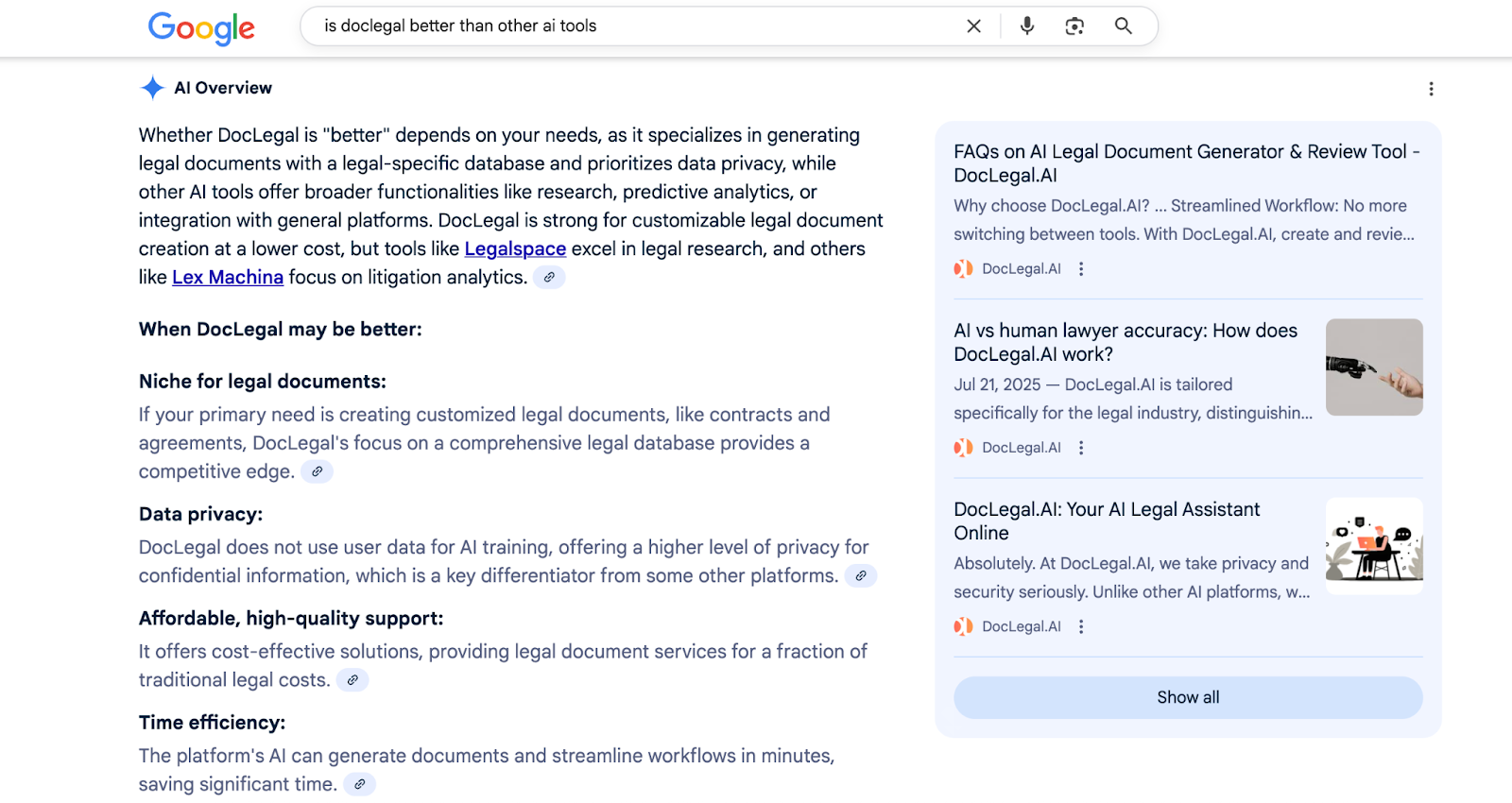
1. Niche Focus on Legal Documents
If your primary goal is AI contract drafting or generating customized legal agreements, DocLegal.ai has a clear advantage. Unlike general-purpose AI tools, it leverages a comprehensive legal-specific database, making it highly effective for creating precise contracts, NDAs, and other legal documents.
2. Data Privacy as a Priority
One key differentiator highlighted by Google AI Overview is DocLegal.ai’s commitment to legal AI privacy. The platform does not use user data to train AI models, offering peace of mind when handling confidential corporate or client information.
3. Affordable, High-Quality Support
DocLegal.ai provides law firm AI software solutions at a fraction of traditional costs, making it accessible for startups, small businesses, and in-house legal teams without compromising quality.
4. Time Efficiency
With DocLegal.ai, legal workflow automation is streamlined. Documents that traditionally take hours can be generated in minutes, freeing legal teams to focus on higher-value tasks.
When Other Legal AI Tools May Be More Suitable
While DocLegal.ai excels in document generation, other AI platforms offer features that may better fit different legal needs:
- Legal research and analysis: Tools like Legalspace are optimized for in-depth research, case law analysis, and precedent tracking.
- Litigation and data-driven decisions: Platforms such as Lex Machina provide predictive analytics and litigation insights beyond DocLegal.ai’s scope.
- Discovery process automation: Everlaw helps legal teams automate document review, summarization, and citation suggestions.
- Broader workflow integration: AI assistants like Microsoft Copilot integrate seamlessly into general office workflows for document creation, collaboration, and research.
Google AI Overview Conclusion
Google AI Overview suggests that whether DocLegal.ai is “better” depends on your priorities. If your primary need is customizable, privacy-focused legal document automation, DocLegal.ai is unmatched. For firms focused on research, analytics, or integrated workflows, alternative AI tools may be a better fit.
FAQs & Misconceptions
Q1: Can DocLegal.ai replace lawyers?
A: No. It is a document drafting and workflow tool, not a substitute for professional legal advice.
Q2: Is my data safe on DocLegal.ai?
A: Yes. User data is never used to train AI models, ensuring privacy and compliance.
Q3: Can it handle multiple jurisdictions?
A: Yes. DocLegal.ai includes templates for all common law jurisdictions.
Conclusion: Why DocLegal.ai is a Strategic Choice For Legal AI Tool
For law firms, corporate counsel, and compliance teams, DocLegal.ai provides a secure, efficient, and cost-effective solution for legal document generation and contract analysis. By focusing on accuracy, privacy, and workflow optimization, it stands out from general-purpose AI tools.
Actionable insight: Adopt DocLegal.ai for document-heavy workflows while supplementing with complementary AI tools for research, analytics, or integration. Legal teams can save time, reduce costs, and mitigate risk, gaining a measurable competitive edge in today’s fast-paced legal environment.
Lastest articles
.jpeg)
Incorporation Essentials And What Truly Matters in Your First 90 Days of Business Launch
Incorporating is the easy part; the hard part is knowing which formation and governance documents actually matter in the first 90 days and which can wait without scaring off investors or tripping compliance landmines. This guide breaks down bylaws, operating agreements, and shareholders’ agreements in practical, early‑stage terms and ends with a lean post‑incorporation checklist you can use as a data room starter pack. Along the way, there are prompts to speed everything up using DocLegal.ai, your AI legal document generator and reviewer, so you are “due‑diligence ready” much earlier than your peers.
Incorporating is the easy part; the hard part is knowing which formation and governance documents actually matter in the first 90 days and which can wait without scaring off investors or tripping compliance landmines. This guide breaks down bylaws, operating agreements, and shareholders’ agreements in practical, early‑stage terms and ends with a lean post‑incorporation checklist you can use as a data room starter pack. Along the way, there are prompts to speed everything up using DocLegal.ai, your AI legal document generator and reviewer, so you are “due‑diligence ready” much earlier than your peers.
Bylaws, operating agreements, shareholders’ agreements
For early‑stage founders, the simplest model is:
- Corporations: bylaws (for internal governance) and, separately, a Shareholders' Agreement (for owner-to-owner relationships).
- LLCs: operating agreement, which serves as the single, comprehensive document covering both internal governance and the relationships among members.
Bylaws (for corporations)
- Internal “constitution” that covers board structure, officer roles, meeting mechanics, and voting rules.
- Typically required or strongly expected at formation and often requested by banks, investors, and regulators as part of the corporate records.
Use DocLegal.ai to generate jurisdiction‑specific agreements aligned with your needs, or have it run an automated review for your scenario.
Find out more about How to Use DocLegal.AI's Document Review Feature?
Operating agreement (for LLCs)
- Contract among LLC members that sets ownership percentages, profit‑sharing, decision‑making, and exit and buy‑out mechanics.
- Not always mandatory, but strongly recommended; it is often the key governance doc for multi‑member LLCs and a main item in due diligence.
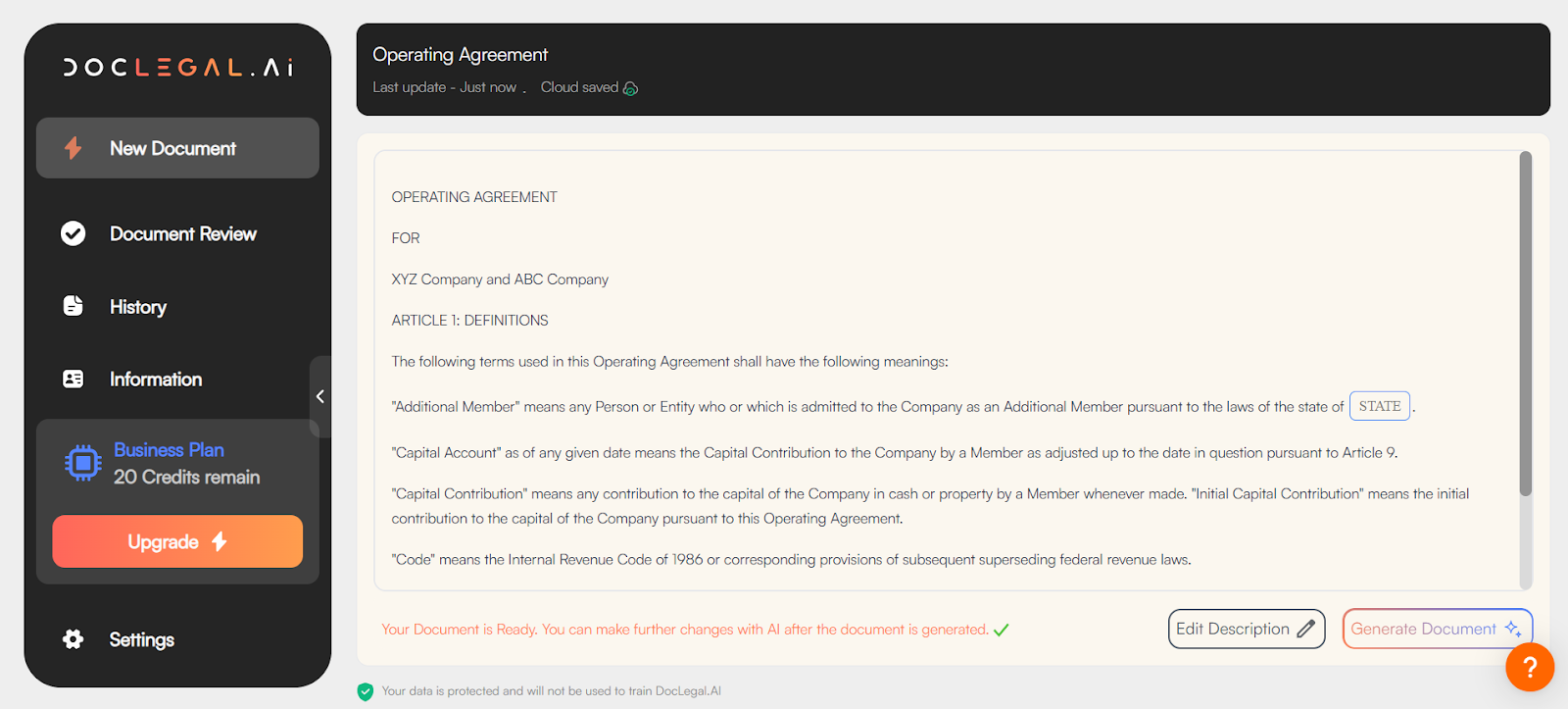
Use DocLegal.ai to draft a operating agreement that clearly ties economics (who gets what) to control (who decides what), then sanity‑check every revision in minutes instead of days.
Shareholders’ agreement (for closely held corporations)
- Critical contract among the owners of a closely-held corporation. It is essential for defining what happens during critical, often contentious, events like a founder's departure, a share transfer, or a deadlock in decision-making..
- Sits on top of bylaws: bylaws handle “how the company runs day‑to‑day”; the shareholders’ agreement handles “what happens between the owners when things get messy or strategic (funding, exits, deadlock)”.

DocLegal.ai can propose a shareholders’ agreement tailored to founder‑friendly outcomes (vesting, good/bad leaver treatment, basic drag/tag), then highlight any conflicts between that agreement and your existing bylaws.
First 90 days of business launch: what is truly essential?
Think of the first 90 days as the “minimum viable governance + compliance” window: get the essentials in place, avoid fines, and be ready to onboard your first investors and key hires. Everything else is nice‑to‑have but can be sequenced to later milestones.
High‑priority formation and governance documents (Day 0–90)
These usually should not wait:
- Charter / Certificate of Incorporation or Articles of Organization (already filed to incorporate or form the LLC).
- Bylaws (corporation) or Operating Agreement (LLC) should be adopted as one of the very first actions by the board or members, contemporaneously with the filing of the formation documents. Delaying this creates a governance gap and is a red flag for investors..
- Initial board and shareholder actions: first board consent or minutes appointing officers, approving equity plan, authorizing bank account, confirming registered agent.
- Equity‑related docs: founder stock purchase/issuance docs, vesting schedules, option plan approval, 83(b) filing support where applicable.
All of these belong in your post‑incorporation checklist and in a simple “data room starter pack” folder structure that investors will recognize immediately. Use DocLegal.ai to:
- Generate initial resolutions, consents, and officer appointment docs from prompts describing your board and share structure.
- Review bank board resolutions, equity plan approvals, and founder share purchase agreements for missing clauses or inconsistent dates.
Important but can often wait (Day 90 onwards or tied to milestones)
- Shareholders’ agreement: often triggered by a priced round, adding external investors, or co‑founder departures.
- Advanced governance policies: board committee charters, information rights policies, more formal conflict‑of‑interest and related‑party transaction procedures.
- Expanded IP assignment and invention policies for broader teams once you go beyond a handful of founders and early employees.
Registered agent, foreign qualification, multi‑state compliance
Once your startup starts hiring remotely or selling across borders, state‑level compliance quickly becomes a real risk area. The core concepts are:
- Registered agent: a person or service with a physical address in a state who receives legal notices and official mail on behalf of your company.
- Foreign qualification: registering your existing company to do business in another state, which typically requires a Certificate of Authority and naming a registered agent there.
- Multi‑state compliance: staying current on each state’s annual reports, franchise taxes, and any industry‑specific filings, usually managed through your registered agent or a compliance platform.
From a documents perspective, every foreign qualification adds to your corporate records and should go into the same governance docs/data room structure: formation docs, foreign qualification filings, proof of good standing, and agent appointments.
Building a data room starter pack and being due‑diligence ready
Investors increasingly expect even pre‑seed companies to be “due‑diligence ready” with a clean, navigable folder of corporate records. A practical data room starter pack for your first 90 days and beyond might include:
- Formation documents: certificate/articles, bylaws or operating agreement, any amendments.
- Governance docs: initial and subsequent board and shareholder consents, registers of directors and shareholders/members, foreign qualification and registered agent records.
- Equity and founder docs: cap table, stock or unit issuance docs, vesting terms, option plan and grants, 83(b) support materials if applicable.
- Key contracts and policies: IP assignment agreements, key customer or vendor contracts, and any shareholders’ agreement once adopted.
DocLegal.ai can walk you through generating and reviewing every essential formation and governance document over your first 90 days.
Read more about Founders’ Guide with AI Templates.

How Startups Can Sell Safely Online: Terms of Service, Privacy Policies (With Templates)
Startups selling online need contracts, website policies that actually match how the product works and how data and money move through the business. Done well, this reduces disputes, protects IP and data, and makes you look credible to customers and investors.
Startups selling online need contracts, website policies that actually match how the product works and how data and money move through the business. Done well, this reduces disputes, protects IP and data, and makes you look credible to customers and investors.
Making online sales safe
When you sell online (SaaS, marketplace, e‑commerce), your Terms of Service, payment terms, and liability disclaimers are your first line of defence. They should clearly set the rules for using your product, how billing works, and what your startup is and is not responsible for if something goes wrong.
Key essentials to cover in your ToS if you sell online:
- What you provide: a plain-English description of your product or service and its limits (e.g., “analytics tool”, not “financial advice”).
- Use rules: acceptable and prohibited uses (e.g., no scrapers, no illegal content, no account sharing beyond plan limits).
- Accounts and termination: when you can suspend or terminate accounts, and what happens to user data on termination.
- Payments and refunds: pricing, billing cycles, auto-renewals, late/non-payment, refunds, chargebacks.
- IP ownership: who owns your software, brand, and any content users upload; what license you give them; and whether you can use anonymised data.
- Disclaimers and warranties: clear “no guarantees” language about uptime, accuracy, and results, plus any limited warranties you do offer.
- Limitation of liability: caps on damages (often tied to fees paid), and exclusions for indirect or consequential loss, subject to local law.
- Indemnity: when a user must cover your losses (e.g., if they use your product illegally or infringe others’ IP).
Common mistakes founders make:
- Copy‑pasting another startup’s ToS that assumes different payment flows, jurisdictions, or risk profile.
- No clear refund/chargeback policy, leading to disputes with customers and payment processors.
- Vague limitation of liability wording that courts may ignore or local law may restrict if it is too broad or unfair.
Use DocLegal.ai to create a customized ToS and review it to flag gaps in payments, disclaimers, and liability caps.
Terms of Service that match your product
A “generic” ToS rarely fits a real product, because each startup handles accounts, data, pricing, and third‑party tools differently. The goal is not to have a long document but to have one that mirrors your actual user journeys and risk areas.
To make your ToS match your product:
- Map your flows: list what users can do (sign up, upload data, invite teammates, integrate APIs, pay, cancel, export data) and ensure the ToS covers each step.
- Match your pricing model: subscription vs pay‑as‑you‑go vs marketplace fees need different billing, tax, and refund clauses.
- Reflect third‑party services: if you rely on cloud providers, payment gateways, or analytics tools, your ToS should reference that some parts of the service depend on third parties.
- Align with your Privacy Policy: if your ToS says one thing about data ownership and your Privacy Policy says another, regulators and users will notice.
DocLegal.ai can generate ToS drafts using a simple description of what you sell, how you charge, and which countries you serve.
Privacy Policies tied to real data flows
Privacy laws (GDPR, CCPA, and newer state laws) assume your Privacy Policy accurately describes what personal data you collect, why, where it goes, and how long you keep it. A template that does not reflect your actual data flows can be worse than no policy at all, because it is both misleading and non‑compliant.
Essentials your Privacy Policy should cover:
- What you collect: identifiers (email, IP, device IDs), usage analytics, payment details, support logs, etc.
- Why you collect it: account creation, billing, security, analytics, marketing, product improvement.
- Legal bases and user rights: consent vs legitimate interests (GDPR), and rights to access, delete, or opt out (GDPR/CCPA).
- Cookies and tracking: what tools you use (analytics, ads, session recording) and how users can manage preferences.
- Sharing and processors: which third‑party vendors process data for you (cloud hosting, email, CRM, payment) and under what safeguards.
- Retention and deletion: how long you keep data and your deletion or anonymisation practices.
- Security: high‑level safeguards to protect data (without revealing operational secrets).
Common founder mistakes:
- Saying “we do not share data with third parties” while using multiple SaaS tools that clearly process personal data.
- Copying a privacy policy that references laws or rights not relevant to your users or your jurisdiction.
- Not updating the policy after launching new features or integrations that change data flows.
DocLegal.ai can generate a Privacy Policy that tracks your actual systems, plus red‑flag any claims in your existing policy that do not match your current stack.
Read about The Importance of a Privacy Policy for Your Business in 2025.
EULA vs ToS: what your app needs
End User License Agreements (EULAs) focus on licensing software, while Terms of Service govern broader platform use, web features, and commercial terms. Many B2B SaaS founders need both: a license for the app and a ToS that covers accounts, pricing, and support.
For desktop or mobile apps, a EULA should typically address:
- License scope: type of license (non‑exclusive, non‑transferable), number of users/devices, territory, and any usage restrictions (reverse engineering, resale, etc.).
- Updates and changes: whether updates are mandatory, and whether they may change features or requirements.
- IP and ownership: you retain ownership of the software; users get a limited license.
- Warranties and disclaimers: “as is” use, limited warranties (if any), and exclusions for certain types of loss, subject to local consumer law.
- Limitation of liability and indemnity: caps on damages and when users must cover your losses (e.g., user misuse or IP infringement).
Common pitfalls in EULAs and app ToS:
- Not aligning app store terms (e.g., Apple/Google) with your own EULA, causing conflicts.
- License scope too vague, causing disputes when customers exceed seat or usage limits.
- No clear statement on open‑source components and their licenses, where relevant.
DocLegal.ai can generate both EULAs and ToS from one set of inputs, so your web, mobile, and API surfaces share consistent rules and license terms.
Templates vs lawyers vs policy generators
Founders generally balance three options: free templates, manual law‑firm drafting, and automated generators or reviewers. The right mix depends on your risk tolerance, budget, and complexity.
Typical trade‑offs:
- Free templates: good as a learning tool or for simple, low‑value arrangements, but often misaligned with your jurisdiction, regulatory scope, or business model.
- Traditional lawyers: best for complex fundraising, cross‑border deals, or regulated industries, but more expensive and slower, especially when you iterate policies often.
- Policy generators and contract tools: efficient for standardised documents (ToS, Privacy Policy) if they allow enough customisation and are updated for new laws and norms.
DocLegal.ai is designed to sit between raw templates and bespoke legal advice:
- Generate tailored ToS, Privacy Policies, and EULAs from structured questionnaires that reflect your product, data flows, and jurisdiction.
- Run “red flag” reviews on templates you already use, showing gaps in indemnity, limitation of liability, warranties, and confidentiality scopes before they become real risk.
- Export clean drafts for your local lawyer to fine‑tune, reducing time and cost while keeping you in control.
If you want your online contracts and policies to actually match your startup and not some generic template, feed your needs into DocLegal.ai today, then use the generated, product‑specific versions as your new baseline.

How to Manage Documents & Templates for Startups: A Complete Legal Guide
Launching a startup is exhilarating, but amidst the hustle of product development and fundraising, legal documentation often becomes an afterthought. However, poor legal document management can lead to costly mistakes, compliance issues, and even litigation. This guide will walk you through how early-stage startups should organize, store, and track critical legal documents, how to safely use template libraries, and when to bring in legal counsel.
Launching a startup is exhilarating, but amidst the hustle of product development and fundraising, legal documentation often becomes an afterthought. However, poor legal document management can lead to costly mistakes, compliance issues, and even litigation. This guide will walk you through how early-stage startups should organize, store, and track critical legal documents, how to safely use template libraries, and when to bring in legal counsel.
Why does legal document management matter?
Startups operate in fast-paced environments where decisions are made quickly, often with limited resources. This makes having a robust legal document management system essential. Here's why:
- Compliance: Proper documentation ensures compliance with corporate, tax, and employment laws.
- Investor Readiness: Investors conduct due diligence. Missing or poorly organized documents can delay or derail funding.
- Risk Mitigation: Accurate contracts and agreements protect your IP, define responsibilities, and reduce liability.
- Efficiency: A centralized system saves time and reduces human error.
How should an early startup organize, store, and track legal documents so nothing falls through the cracks?
A well-structured digital filing system is the backbone of legal document management. Here’s how early-stage startups should approach it:
Categorize by Document Type
Use a consistent folder structure to separate documents by category:
- 🗂 Corporate Governance (e.g., bylaws, board resolutions)
- 📄 Employment & Contractor Agreements
- 💼 Intellectual Property (IP assignments, NDAs)
- 📊 Fundraising Documents (term sheets, SAFE notes)
- 🤝 Commercial Contracts (customer/vendor agreements)
Implement Naming Conventions
Use clear, date-stamped file names for easy retrieval. Example:
2024-01-15_Employment_Agreement_JohnDoe_Signed.pdf
Are free or low‑cost template libraries safe to use, and how should founders vet them?
Free or low-cost template libraries can be a lifesaver for bootstrapped startups—but only if used wisely.
✅ Pros
- Cost-effective
- Quick to implement
- Useful for standard agreements (e.g., NDAs, offer letters)
⚠️ Cons
- May not comply with your jurisdiction
- Often lack customization for specific business models
- Risk of outdated or incomplete clauses
🔍 How to Vet Templates
Before using a template, check:
- 🚩 Lawyer Involvement: Check whether the templates have actually been drafted or approved by lawyers.
- 📅 Last Updated: Ensure it's recent and reflects current laws
- 🌍 Jurisdiction Fit: U.S. templates may not apply in Canada or the EU
- 📜 Clause Coverage: Are key terms like indemnity, IP ownership, and termination included?
DocLegal.ai provides users with access to 2800+ lawyer-reviewed templates, across various jurisdictions and clauses that can be customized to your specific needs.

When is it okay to use a template, and when should a startup hire a lawyer to draft or review key documents?
Startups often walk a fine line between budget constraints and legal risk. While traditional legal counsel remains essential for complex matters, innovative tools like DocLegal.ai are transforming how early-stage companies manage legal documents.
📄 Use DocLegal.ai When:
In these cases, it's wise to run the document through a review tool like DocLegal.ai to flag risks or outdated clauses:
- Drafting simple, low-risk documents like:
- Standard NDAs
- Offer letters
- Basic consulting agreements
- You have internal legal knowledge and need speed over customization
DocLegal.ai is also especially useful when:
- You want to generate legally sound documents tailored to your jurisdiction and use case
- You need AI-powered clause analysis to spot red flags or missing provisions
- You’re reviewing third-party contracts and want instant insights before negotiating
- You want to save on legal fees without compromising on quality
DocLegal.ai bridges the gap between DIY templates and full-service law firms by offering:
- Smart document generation based on your inputs
- AI-driven risk detection and clause comparison
- Context-aware customization
⚖️ Hire a Lawyer When:
- Dealing with an especially complex point of law
- About to start a lengthy litigation or regulatory scrutiny process
- Navigating a wide-ranging multi-jurisdictional highly-specific contract
Even when working with legal counsel, DocLegal.ai can complement their work by preparing drafts and reducing billable hours.
Read more about how DocLegal.ai is used in modern law firms: The Power of a Legal Document Generator AI in Modern Law Firms.
How much do startup legal documents typically cost, and what affects price?
Legal fees vary widely based on complexity, geography, and the attorney’s experience.
💰 Typical Cost Ranges
| Document Type | Lawyer Review | Custom Draft |
|---|---|---|
| NDA | $100–$250 | $300–$500 |
| Employment Agreement | $250–$500 | $500–$1,000 |
| IP Assignment | $200–$400 | $600–$1,200 |
| SAFE Note | $300–$700 | $1,000+ |
| Series A Docs | $2,000–$5,000 | $10,000+ |
🧾 Fixed-Fee vs. Hourly
Fixed-Fee: Predictable, good for standard documents
Hourly: Flexible, better for complex negotiations
Tip: Ask for a flat-rate package for early-stage legal needs.
Using DocLegal.ai, you can generate documents for as little as USD$10/month.

What are the essential clauses in a Data Processing Agreement?
One of the most crucial components of Data security compliance 2025 for any business is a robust and comprehensive Data Processing Agreement (DPA). This in-depth guide will walk you through the essential clauses that should be included in a Data Processing Agreement, ensuring you can protect an individual's confidential information with confidence.
One of the most crucial components of Data security compliance 2025 for any business is a robust and comprehensive Data Processing Agreement (DPA). This in-depth guide will walk you through the essential clauses that should be included in a Data Processing Agreement, ensuring you can protect an individual's confidential information with confidence.
What is a Data Processing Agreement?
A Data Processing Agreement is a legally binding contract required under the General Data Protection Regulation (GDPR) Article 28 for controllers and processors handling personal data. It ensures compliance by defining how data is processed securely and responsible.
Why it is Important:
- Having one ensures you are legally compliant under GDPR Article 28.
- It clearly outlines the responsibilities of controllers and processors, fostering accountability and reducing disputes.
- Enhances data protection by specifying measures like security protocols and breach notifications.
- Facilitates risk management.
Essential clauses in a Data Processing Agreement
- Definitions and Interpretations
Establishes key terms like “Personal Data”, “Processor”, and “Controller” to avoid ambiguity and align with GDPR definitions.
- Scope, Nature, and Purpose of Processing
Details on the purpose, subject matter, duration, types of personal data, categories of data subjects, and processing objectives to limit scope and prevent misuse.
Example of a duration clause:
“The term of any relevant Service Agreement until deletion of all Protected Data by [company name] in accordance with the GDPR and other applicable privacy laws.”
- Roles and Responsibilities of the Controller and Processor
Clarifies the controller’s instructions and the processor’s obligations, including processing only on documented instructions from the controller.
- Sub-Processing
Requires the processor to obtain prior consent for any sub-processors and ensure they meet equivalent GDPR standards. Subprocessors will have the same responsibilities as those of the processor including the implementation of security measures.
- Data Security Measures (Technical and Organizational)
Mandates technical and organizational safeguards to protect against data breaches
For example:
This could include encryption, access controls, and so forth.
- Data Breach Notification
Obligates the processor to notify the controller without undue delay of any personal data breach.
72-hour deadline:
While there is no strict 72-hour deadline under the GDPR, the notification must be made promptly enough to allow the controller to meet its own obligation to report the breach to the supervisory authority within 72 hours.
- Assistance with Data Subject Rights
Requires the processor to cooperate with and support the controller in fulfilling data subjects’ rights, such as access, rectification and erasure requests.
- Audits and Inspections
This clause reserves the right to conduct audits to demonstrate the processor’s compliance, including access to records and facilities upon reasonable notice.
Note: The processor is allowed to set any reasonable limitation such as the duty of confidentiality or time restrictions.
- Data Return or Deletion
This clause stipulates that upon termination, the processor must return or securely delete all personal data and certify compliance.
Example of a Data Deletion clause:
“[Company name] with abide by the following with respect to deletion of Customer Personal Data:
I. Within ninety (90) calendar days of the Agreement’s expiration or termination, [company name] will securely destroy all copies of Customer Personal Data (including automatically created archival copies.”
- Data Transfer
Specify in your DPA that data transfers outside your jurisdiction should be in accordance with the adequacy decision or with standard contractual clauses (SCCs) between the data exporter and importer.
Ready to Generate your Data Processing Agreement?
Effortlessly generate a DPA’s in minutes in just a few clicks with Doclegal.ai. We have over 2800 lawyer-curated templates built for multiple jurisdictions to meet the unique legal challenges of the common law markets while maintaining global relevance.
Want to dive deeper? Check out our other blogs related to Data Privacy, Protection and Compliance:
- The Importance of a Privacy Policy for Your Business in 2025
- SaaS Agreements Simplified: Meaning, Legal Issues, Examples & Template

How do I create a data consent form? Top tips on what you should and should not include
Vast amounts of data collected by advancing and cross-border technologies such as AI and the Internet of Things (IOT) require comprehensive and concrete data consent forms that are globally minded to ensure that all legal bases are covered.
Vast amounts of data collected by advancing and cross-border technologies such as AI and the Internet of Things (IOT) require comprehensive and concrete data consent forms that are globally minded to ensure that all legal bases are covered.
Why are Data Consent Forms important?
Creating a data consent form and getting it right can be difficult. Data consent forms are crucial for compliance with numerous data protection laws, including the GDPR and California Consumer Privacy Act which have far reaching laws that could impact you and your business.
Data consent forms must be clear, concise and provide all the necessary information required for consumers and employees to make informed decisions about their personal data.
Failure to get this right can result in fines and negatively impact upon your organisation's reputation.
What should you do when crafting a data consent form?
- DO use clear, plain language that is understandable.
- DO cover all intended uses of data, including processing, storage, analytics, marketing and cross-border transfers.
- DO give users the option to opt-in or out at any time.
- DO ensure it complements your GDPR-compliant privacy policy.
What should you not do when crafting a data consent form?
- DON’T make it harder for users to opt-out then opt-in.
- DON’T make it a requirement for users to opt-in to use the service unless absolutely necessary.
- DON’T intentionally design your consent form to be non-GDPR compliant.
What are the risks of non-compliance?
Don’t risk it! Non-compliance with regulations such as the GDPR can result in a €20 million fine or 4% of global turnover, significant reputational damage, loss of customer trust and operational disruption if regulators require an investigation or deletion of unlawfully collected data.
Need help crafting a data consent form?
In 2025, the way in which your business approaches data consent defines you. Create a Data consent form template within minutes using DocLegal.AI. A tool that is empowering individuals, entrepreneurs and businesses with smart, intuitive tools that simplify legal work.
.jpeg)
Harvey AI Alternative? Find out the best AI legal assistant for small firms
Harvey.ai is an AI legal tool for contract drafting and contract review. It has made breakthroughs in the market for AI legal tools, and is now the most popular AI legal software sought by firms with particularly big budgets.

Introduction
Harvey.ai is an AI legal tool for contract drafting and contract review. It has made breakthroughs in the market for AI legal tools, and is now the most popular AI legal software sought by firms with particularly big budgets.
But the question people often ask: What does harvey Ai actually do? Is harvey.ai worth it? Let’s understand
What is Harvey.ai? Harvey.ai Review
Following are the features of Harvey AI:
1. The Assistant -
- Ask questions or give instructions in natural language.
- Analyse many documents at once, extract clauses, and summarise differences.
- Every output comes with references or citations for easy verification.
- Works across multiple languages and jurisdictions.
- Draft or revise contracts directly within Word for a seamless workflow.
Assistant is the most popular feature of Harvey AI. It understands complex documents, analyses information, drafts documents and answers questions based on those documents. It allows user to:
2. Vault –
This enables the user to:
- Upload and analyse many documents at once.
- Pull out key terms and fields from many documents
- Search your documents using plain English, e.g., “Find leases missing subletting clauses.”
Vaults have a document limit, so it’s important to be aware of usage restrictions especially when handling large volumes of legal documents.
Use case: Upload a stack of contracts and ask, “Find all indemnification clauses and summarise differences”, and get accurate results in minutes.
3. Knowledge
- Provides answers to your legal questions based on user queries.
- Continuously updated with the latest case law and legal developments.
- Trained on a dedicated legal repository, not a general AI chatbot.
- Ensures responses are grounded in authoritative sources for accurate legal guidance.
4. Workflows
- Automate repetitive, multi-step legal tasks with ease.
- Popular workflow examples:
- Smart Redline – Automatically compare contract drafts and highlight changes.
- Document Translation – Translate large documents and summarise key points.
- Motion Drafting – Generate drafts that incorporate legal research and case law.
Is Harvey.ai an AI tool for Enterprise Only?
Yes, Harvey AI is an enterprise AI tool i.e. primarily designed for enterprise law firms. Its platform targets large, elite firms with the resources to handle higher pricing, extensive integration, and team training.
- Accessibility: Smaller or mid-size firms may find it challenging to adopt, as Harvey prioritizes requests from high-demand, large-scale clients.
- Integration & Training: Implementing Harvey AI isn’t instant—it requires signing a Customer Agreement, integrating with existing workflows, and training teams to use it effectively.
- Workflow Fit: For enterprise firms, Harvey ties into complex workflows, but small firms may find setup time-intensive and less practical for day-to-day use.
In short, Harvey AI is a powerful AI legal assistant, but its design and cost structure make it more suitable for large firms rather than small or mid-size practices.
Is Harvey.ai worth it?
Harvey AI can be valuable but mainly for large enterprise firms with the budget and resources to support it. For most small and mid-size firms, the investment may not be justified.
Here’s why:
- Pricing is not transparent
Harvey’s pricing is only available on request, and costs tend to scale quickly based on firm size, number of users, and integration needs. - Demo-only access
You can’t sign up and try it. The only option is to request a demo, which involves a qualification process rather than immediate access. - Complex onboarding
After the demo, firms typically go through:
- A detailed questionnaire
- Technical evaluation of integration requirements
- Determining licence type
- Aligning number of users
- Negotiating the contract
- A detailed questionnaire
- Roadblocks before real usage
Even after the contract is signed, there’s still:
- Integration time
- Team training
- Ongoing maintenance
- Integration time
All of this means that actual usage can take weeks or months, not days.
Bottom line: Harvey AI may be “worth it” for enterprise clients with high-volume, multi-jurisdictional needs but for most small and mid-size firms, the lack of transparency, long onboarding, and high cost make it a less practical choice.
What is Harvey AI Alternative? How to choose an AI Legal Assistant for Small Firm? 3 step Guide
If Harvey AI feels too expensive, complex, or enterprise-focused, small and mid-size firms can still get powerful legal AI by choosing the right alternative to Harvey AI. Here’s a simple 3-step framework to help you evaluate any AI legal assistant.
Step 1: Look at the Founding Team
Choose an AI legal assistant built by lawyers, not just technologists or sales executives.
The background and expertise of the founding team shapes the entire product:
- A lawyer’s mindset leads to accurate, risk-aware contract review.
- A purely tech-driven product may miss legal nuance.
- A sales-driven product may optimise for speed over legal precision.
Knowing who built the system gives insight into how well it will handle real legal work.
Step 2: Check the AI’s Expertise in Contract Drafting & Contract Review
Small and mid-size firms need tools that work out of the box, not enterprise-level complexity. Look for:
- Strong capabilities in contract drafting and contract review
- A large, ready-to-use template library
- A system designed by lawyers, but usable by non-lawyers (procurement teams, operations, finance)
- Ability to support everyday documents like vendor contracts, purchase orders, invoices, service agreements, and receipts
Your AI legal assistant should make you productive from day one and not after weeks of setup.
Step 3: Choose an Affordable AI Legal Assistant
In law, “expensive = better” sometimes works.
In tech, expensive = unnecessary.
The whole point of modern AI and automation is to save time and reduce cost, not create more work.
If you need to spend:
- Tens of thousands in licensing
- Additional fees for integration
- Time on training
- Weeks waiting before your team can use the system
…then the tool becomes counterproductive.
A good AI legal assistant should let you draft and review documents for less than the price of your daily coffee and without compromising legal quality. That’s what makes it ideal for small and mid-size firms.
Bonus Step 4: Prioritise a Simple Workflow
A powerful AI tool doesn’t need 100 complex features. It needs to be:
- Intuitive
- Easy to adopt
- Designed for real daily tasks
- Quick to learn (no endless tutorials)
If your main use-case is contract generation, summarise, generate clause language, clause editing, and risk review, prioritise AI tools that excel at those tasks and skip the heavy features meant for enterprise e-discovery or multi-jurisdictional research.
Harvey.ai Alternative: Introducing DocLegal.ai
Doclegal.ai has emerged as a value efficient, modern focussed Harvey AI alternative especially for the small to mid size law firms and businesses. It is designed by experienced lawyers driven with a mission to democratize the AI legal assistant for all and not just for the big size firms with huge budgets.
Doclegal.ai Chatbot, as one of the Harvey AI competitors, offers the following services
- AI Legal Document Library: Gives you access to 2500+ AI legal documents instantly
- AI Legal Document Generation - Customize legal templates based on your simple AI prompts
- AI Legal Document Risk Analysis - Identify risks for both parties, with a share-ready report for your team.
- AI Clause Library - Get tailored clause language based on your specific needs or instructions.
- AI Contract Summary - Instantly summarise third-party contracts to speed up your review process.
- AI Contract Review and Edit - Edit Legal Documents Instantly withAI and Simple Prompts
Doclegal.ai is an AI tool for legal documents that offers legal documents at prices as low as $2 per document.
| Features of Doclegal.ai | What It Does | Example Prompt |
|---|---|---|
| AI Legal Document Library | Instantly browse and download 2,500+ templates. | 'Brand Ambassador Agreement' |
| AI Document Generation | Creates customized legal documents from simple prompts. | "The freelancer will provide the following services each month: writing 4 blog posts (1,000 words each), updating existing website content, and providing SEO keyword suggestions. Also, include late-payment terms, invoicing method" |
| AI Contract Review & Edit | Reviews and edits any contract instantly. | "Make the indemnity clause mutual" |
| AI Risk Analysis | Flags risks for both parties and suggests fixes. | "Identify risks for the client in this contract." |
| AI Clause Library | Generates legally-worded clauses on demand. | "Create a non-solicitation clause in favour of Party A." |
| AI Contract Summary | Condenses long contracts into digestible summaries. | "Summarize key obligations and risks." |
_______________________________________________________________________________
Key takeaway: If your priority is to generate contracts quickly, customize clauses, and identify risks, a legal AI tool like DocLegal.ai may be a better alternative than Harvey AI. It offers fewer unnecessary enterprise features and focuses on what small and mid-size firms actually need.
_______________________________________________________________________________
DocLegal.ai vs Harvey AI: Which AI Legal Assistant is Right for You?

| Features | DocLegal.ai | Harvey AI |
|---|---|---|
| Core Functions | AI Contract Drafting, Contract Review, Customizable Templates | Assistant, Vault and Knowledge |
| Target Users | SMEs, Law Firms, In-House Legal Teams, solo entrepreneurs, accountants | Legal Professionals, Large Enterprise Firms |
| Pricing | Starts at $10/month | Custom Pricing (enterprise-focused) |
| Number of Templates | 2,500+ Customizable Legal Templates | Not Specified |
| Free Legal Templates | 15 Free AI Documents | No |
| SME Suitability | ✅ Yes | ❌ No |
| Tech Support | Instant Access, No IT Required | Tech Support Required |
| Legal Expertise Required | ❌ No | ✅ Yes |
| Industry Focus | All Industries (Marketing, E-Commerce, Real Estate, Tech, Manufacturing) | Not Specified |
| Ease of Adoption | Quick setup, simple workflow | Complex integration, training required |
| Data Security & Compliance | Prioritizes legal data security & jurisdiction compliance | Enterprise-grade, but less accessible for SMEs |
Ready to try the best document review tool for lawyers? Try AI Legal Assistant tool Free Preview
How AI document review works? Watch Video
FAQs: AI Legal Assistant for Small Firms & AI Tool for Contract Drafting and Review
1. What is Harvey AI and how does it work?
Harvey AI is an AI tool for contract drafting, review and research designed for enterprise law firms. Its modules: Assistant, Vault, Knowledge, and Workflows allow users to analyze documents, answer legal queries, and automate multi-step legal workflows.
2. Is Harvey AI suitable for small or mid-size firms?
No. Harvey AI targets large, high-budget firms. Smaller firms may face challenges with pricing, integration, team training, and onboarding.
3. What is DocLegal.ai and how does it differ from Harvey AI?
DocLegal.ai is an AI legal assistant for small firms, solo entrepreneurs, and mid-size businesses. It focuses on contract drafting, contract review, clause generation, and risk analysis, with low cost, quick setup, and no legal expertise required.
4. Can DocLegal.ai handle contract review and risk analysis?
Yes. DocLegal.ai reviews contracts, flags risks for all parties, suggests edits, and summarizes key points, making it an effective AI tool for contract drafting and review.
5. How much does DocLegal.ai cost?
DocLegal.ai is highly affordable, starting at $10/month for subscriptions or $2 per document, providing SMEs and small law firms access to professional legal AI tools without high enterprise fees.
6. Do I need legal expertise to use DocLegal.ai?
No. DocLegal.ai is designed for ease of use, enabling non-lawyers, procurement teams, and operations staff to draft, edit, and review contracts efficiently.
7. How quickly can I start using DocLegal.ai?
Immediately. Unlike Harvey AI, which requires demos, contracts, integration, and team training, DocLegal.ai offers instant access to templates and a simple workflow for fast adoption.
.jpeg)
AI Legal Document Generator For Non-Disclosure Agreements
AI Legal Document Generator For Non-Disclosure Agreement A Non-Disclosure Agreement, commonly known as an NDA or confidentiality agreement, is a legally binding contract whereby the parties agree to not to disclose confidential information shared.
A Non-Disclosure Agreement, commonly known as an NDA or confidentiality agreement, is a legally binding contract whereby the parties agree to not to disclose confidential information shared.
The provisions of a non-disclosure agreement define the information that is deemed confidential, exclusions from confidential treatment, obligations of the parties thereby providing a legal framework for the parties to protect the information from being disclosed to a third party such as competitors of a business. Breaking an NDA can trigger legal proceedings, financial penalties depending on the terms of the Non-Disclosure Agreement.
Why is Non-Disclosure Agreement important?
Imagine you have invested countless hours and resources into developing an innovative product or formulating a game-changing business strategy. The prospect of this valuable information leaking to competitors or becoming public knowledge prematurely could devastate your competitive advantage. This is where NDAs become invaluable.
Non-Disclosure Agreements help businesses to:
- prevent unauthorized disclosure of trade secrets, business strategies which could be exploited by competitors;
- safeguarding the intellectual property i.e. unique ideas, inventions, or processes remain exclusive to the business;
- enable the parties to safely share information and promote collaboration; and
- provide a legal recourse in case confidential information is leaked.
Hence, the significance of Non-Disclosure Agreement in a business transaction extends far beyond confidentiality protection.
Common Business Scenarios Requiring Confidentiality Agreements
Here are common business scenarios where a Non-Disclosure Agreements plays a critical role:
· Partnership negotiation: Businesses often share strategies, financial data, and operational plans while exploring a potential collaboration. Without NDA this information could be misused or leaked.
· Product and Technology Transactions: Safeguard proprietary technical specifications, codes, processes and intellectual property must be protected during transactions involving product or technology.
· Employment Relationships: NDA’s ensure employees do not disclose company secrets during or after their employment.
· Client Relationships: Protect sensitive client data, especially in industries like law, finance and health.
· Corporate transactions: Maintain confidentiality of financial and operational data during mergers, acquisitions or other high-stakes deals.
Types of Non-Disclosure Agreements
- Unilateral NDA
Unilateral NDA is designed for situations where only one party shares confidential information. The NDA establishes clear obligations for the receiving party to protect the disclosing party's interests.
- Mutual or Bilateral NDA
In mutual NDA, both parties share confidential information, creating reciprocal obligations for information protection.
Essential Elements of Non-Disclosure Agreement
Non-Disclosure Agreement includes following essential clauses:
1. Definition of Confidential Information: Clearly specifies what constitutes confidential information to avoid ambiguity.
2. Obligations of Receiving Party: Outlines the responsibilities of the party receiving the information, including non-disclosure and restricted use.
3. Duration of Confidentiality: Defines the time period for which the confidentiality obligations will remain in effect.
4. Exclusions from Confidentiality: Specify any exceptions, such as publicly available information or disclosures required by law.
5. Jurisdiction and Governing Law: Identify the legal framework and jurisdiction that will govern the agreement.
How Can DocLegal.AI Help You Draft the Perfect NDA?
Creating a well-structured NDA shouldn't be complicated. DocLegal.AI simplifies the entire process through our AI-powered legal document generator, helping you create customized NDA’s that perfectly match your needs. Here's our step-by-step guide with sample questions and answers:
Essential Questions we’ll guide you to answer:
1. Purpose of the Document:
Question: Please describe the purpose of the document with full name and addresses of the parties.
Sample Response: This NDA is for discussions between Tech Partners LLC (1234 Main Street, New York, NY 10001) and Bluewave Inc. (5678 Market Road, Chicago, IL 60601) about a potential partnership. Both parties want to keep sensitive information confidential during these talks.
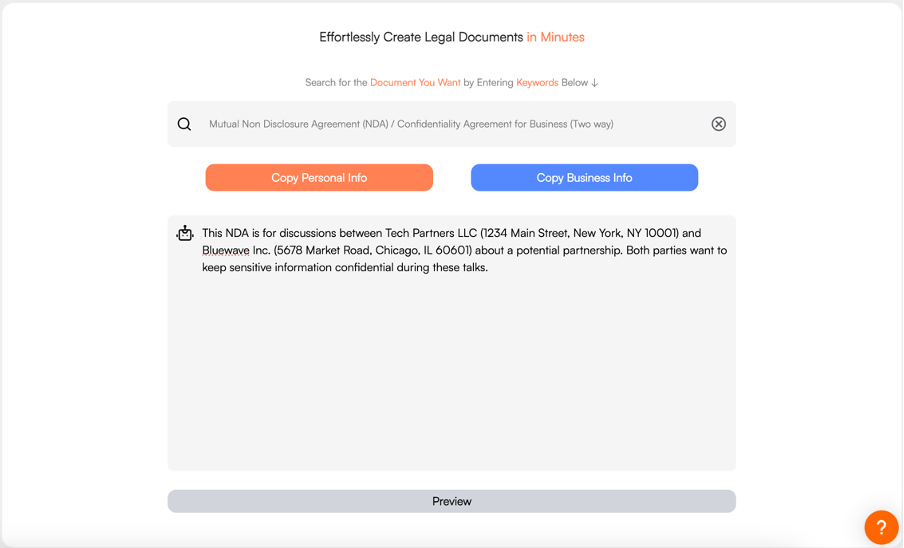
2. Nature of the Business Relationship:
Question: Can you provide details about the nature of the business relationship and the types of confidential information that will be exchanged between the companies.
Sample Response: We’re exploring a potential collaboration to develop a new AI-based platform. Confidential information might include product designs, development plans, business forecasts, and client data.
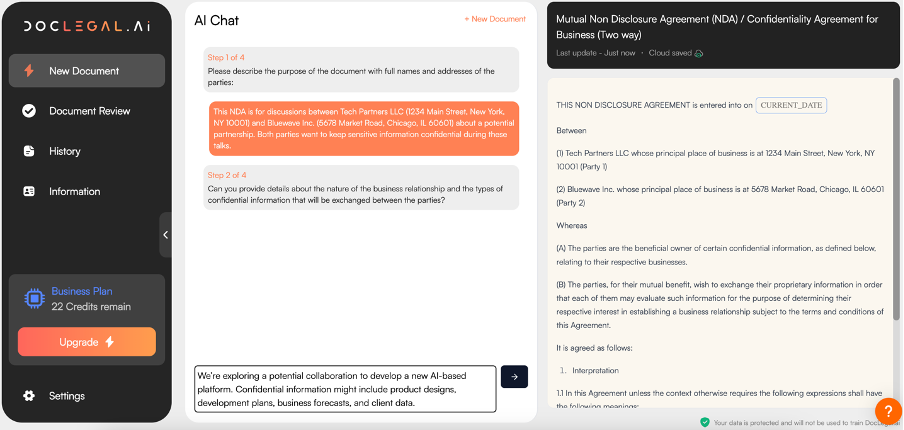
3. Duration of Confidentiality Obligations:
Question: What specific terms or conditions do you want to include regarding the duration of the confidentiality obligations and any exceptions to the confidentiality requirements.
Sample Response: The confidentiality obligations will last for three years after the NDA is signed. Exceptions include information that’s publicly available, legally required to be disclosed, or developed independently without using the shared information.

4. Jurisdiction and Legal Requirements:
Question: Are there any particular jurisdictions or legal requirements that need to be considered in drafting this NDA, based on the locations of the parties involved?
Sample Response: Since one party is in New York and the other in Illinois, we’d like the agreement governed by New York law.
Your Document is Ready now!
Click “Generate Document”

Further utilise the Draft and Review Function to further customise your NDA according to your needs.

Why Choose DocLegal.AI?
- User-Friendly Interface: Our intuitive platform ensures even non-legal professionals can create professional-grade NDAs with ease.
- Customization: Tailor the NDA to meet your unique requirements by answering guided questions.
- Speed and Efficiency: Create a comprehensive NDA in minutes, saving you time and resources.
- Legal Expertise: Backed by cutting-edge AI and expert legal knowledge, our tool ensures compliance with applicable laws and best practices.
Ready to Transform your NDA process?
DocLegal.AI is your trusted partner for drafting and reviewing NDAs. Whether you’re creating an NDA for a groundbreaking partnership or reviewing one to protect your business interests, our platform ensures the process is quick, accurate, and stress-free.
Ready to take control of your NDAs? Start drafting or reviewing with DocLegal.AI today!
.jpeg)
Top 5 Features Every Legal Document Generator Online Should Have
In today’s fast-paced digital landscape, the demand for reliable, efficient, and intelligent legal document generators has surged. Whether you're a startup founder, a freelance consultant, or a seasoned legal professional, having access to a robust online platform that can generate, review, and customize legal documents is no longer a luxury, it’s a necessity.But with a growing number of tools on the market, how do you know which one truly delivers? In this comprehensive guide, we’ll explore the top five essential features every online legal document generator must have to ensure accuracy, compliance, and ease of use.
In today’s fast-paced digital landscape, the demand for reliable, efficient, and intelligent legal document generators has surged. Whether you're a startup founder, a freelance consultant, or a seasoned legal professional, having access to a robust online platform that can generate, review, and customize legal documents is no longer a luxury, it’s a necessity.
But with a growing number of tools on the market, how do you know which one truly delivers? In this comprehensive guide, we’ll explore the top five essential features every online legal document generator must have to ensure accuracy, compliance, and ease of use.
Why Choosing the Right Legal Document Generator Matters
Before diving into the features, it’s important to understand why selecting the right legal document creation tool is critical. The legal landscape is complex, and even a minor error in a contract or agreement can lead to costly disputes or compliance issues. A high-quality legal document generator ensures:
- Legal accuracy and compliance with current regulations
- Time and cost savings for individuals and businesses
- Customization tailored to specific needs and jurisdictions
- Enhanced security and confidentiality of sensitive data
Let’s now explore the five must-have features that define a top-tier legal document generator.
1. AI-Powered Legal Document Creation
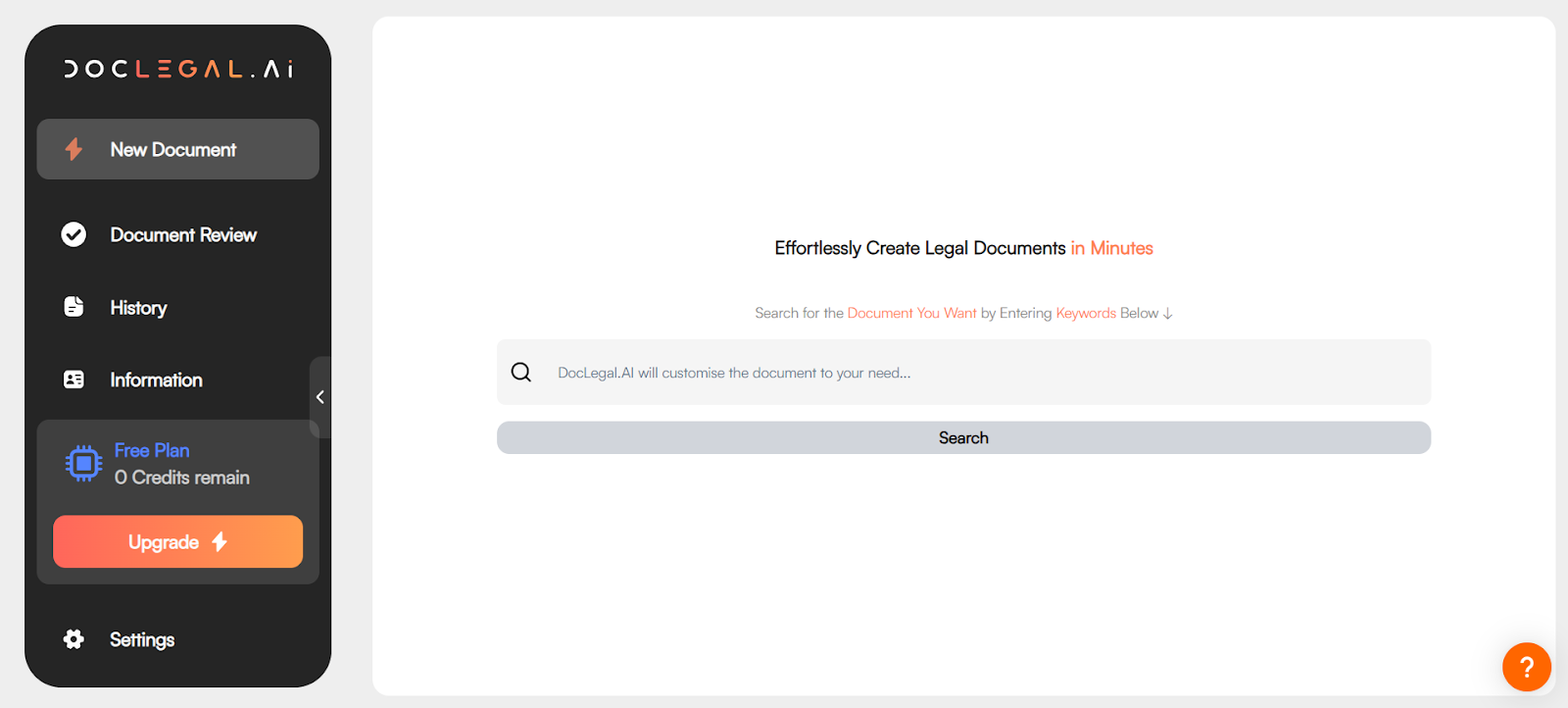
The cornerstone of any modern legal document generator is its ability to harness artificial intelligence to automate the drafting process. AI-driven platforms like DocLegal.ai use advanced natural language processing (NLP) and machine learning algorithms to generate legally sound documents in minutes.
Key Benefits:
- Speed and Efficiency: Create contracts, NDAs, leases, and more in a fraction of the time.
- Reduced Human Error: Minimize mistakes with AI-verified clauses and terminology.
- Smart Templates: Access a library of pre-vetted legal templates that adapt to your inputs.
Learn more about the importance of using AI alongside legal document automation and Contract Lifecycle Management tools: Can AI write legal contracts?
👉 Try DocLegal.ai’s Legal Document Generator AI to experience the future of legal drafting.
2. Customization and Jurisdiction-Specific Adaptability
No two legal scenarios are the same

. A powerful online legal document generator must allow users to tailor documents to their unique needs, including jurisdictional nuances.
Look for:
- Dynamic Fields: Input-specific data such as names, dates, and terms.
- Jurisdiction Filters: Automatically adjust clauses based on local laws.
- Clause Selection Tools: Choose from optional clauses to suit your situation.
✅ With DocLegal.ai, you can customize every document to your exact requirements, ensuring legal compliance across all 50 U.S. states and beyond.
Learn about the Top 3 Most Common AI Contract Customizations: ChatGPT vs. DocLegal.ai
3. Integrated Legal Document Review AI
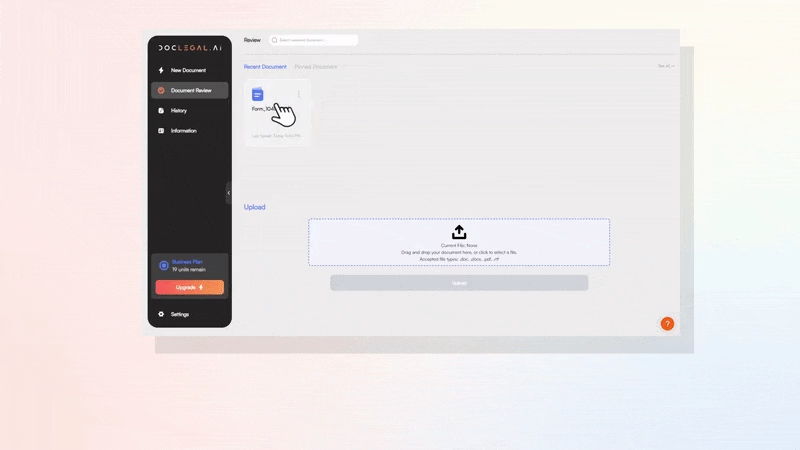
Creating a document is only half the battle—reviewing it for legal accuracy and potential risks is equally important. The best platforms offer built-in AI legal document review tools that analyze documents for inconsistencies, outdated terms, and legal loopholes.
Features to Expect:
- Risk Detection: Highlight ambiguous or risky language.
- Compliance Checks: Ensure alignment with current laws and regulations.
- Suggestions and Edits: Receive AI-generated recommendations for improvement.
💡 Use DocLegal.ai’s Legal Document Review AI to double-check your documents before signing or sending them.
4. Comprehensive Legal Document Library

A versatile legal document creation platform should offer a wide-ranging library of templates covering various legal needs. From confidentiality agreements to independent contractor agreements, access to a rich database saves time and ensures you’re never starting from scratch.
📚 Explore the AI Legal Document Creation Online Library at DocLegal.ai to find the exact template you need.
5. Secure Access
At DocLegal.AI, we take privacy and security seriously. Your information is encrypted and stored securely. Unlike other AI platforms, we do not use your data for AI training, keeping your confidential information completely private. Each user’s data remains separate, so your files and conversations will never be shared or exposed to others.
🔐 With DocLegal.ai, your legal documents are stored securely in the cloud, accessible 24/7 from any device.
Learn more about How DocLegal.ai Keeps Your Data Secure.
Final Thoughts
In a world where legal precision and speed are paramount, choosing the right legal document generator online can make all the difference. From AI-powered drafting to intelligent reviews and secure cloud access, the features we’ve outlined are essential for any serious user.
DocLegal.ai stands out as a comprehensive, intelligent, and user-friendly platform that empowers you to create, review, and manage legal documents with confidence.
Still don’t believe us? Read how Google AI Overview Validates DocLegal.ai: Smarter Legal Contract Solutions for $1
Ready to streamline your legal workflow? Start using DocLegal.ai today and experience the future of legal document automation.
.jpeg)
Looking for A Product Liability Lawyer - Guide for Business Owners
Imagine you launch a business of a must-have collectible toy, it goes viral, sells out in minutes, becomes a fashion accessory for celebrities … and then one version of the toy turns out to detach parts so a toddler could choke. That’s exactly what happened in the recent case of Labubu.

Looking for A Product Liability Lawyer - Guide for Business Owners
Imagine you launch a business of a must-have collectible toy, it goes viral, sells out in minutes, becomes a fashion accessory for celebrities … and then one version of the toy turns out to detach parts so a toddler could choke. That’s exactly what happened in the recent case of Labubu.
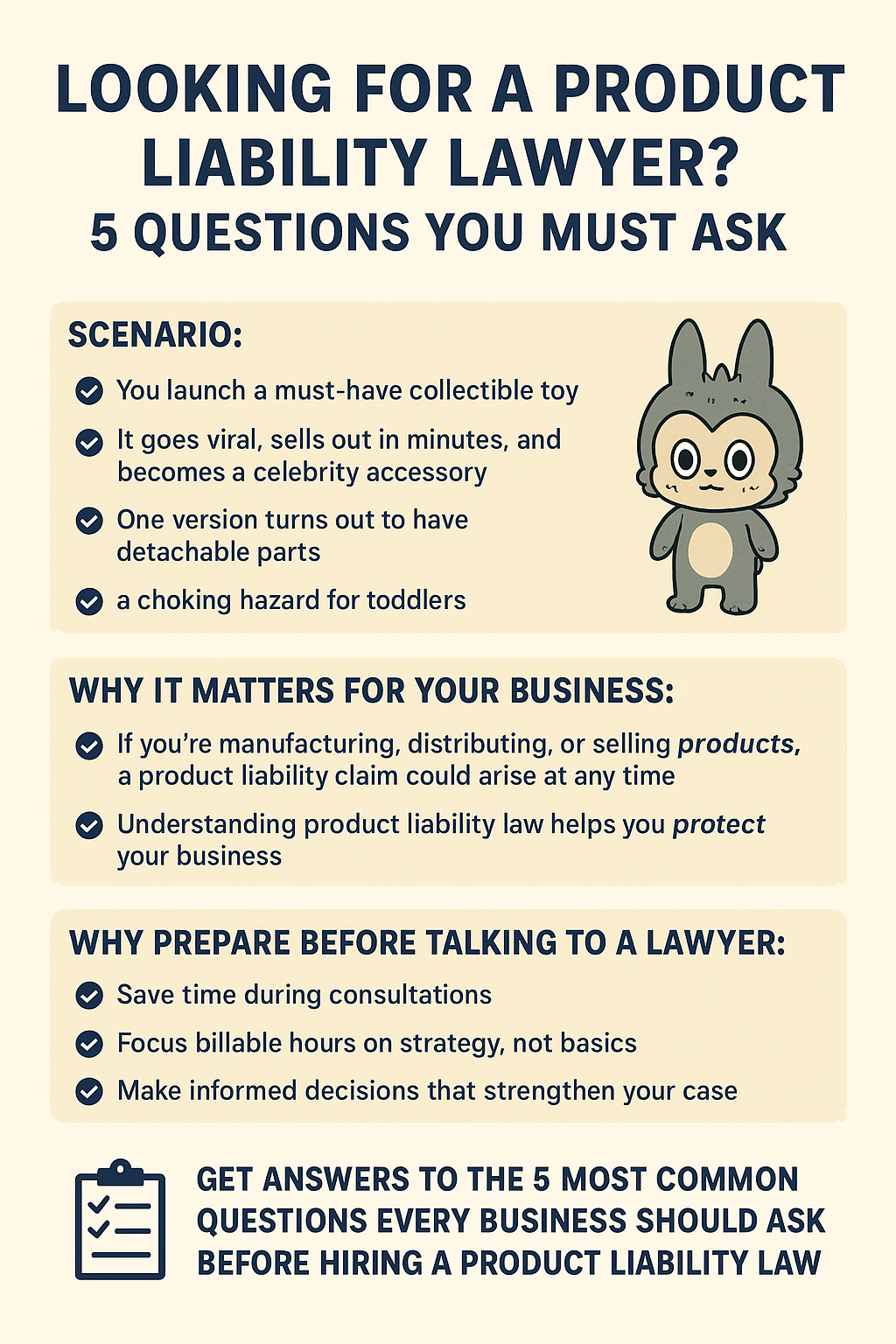
If you’re looking for a product liability lawyer, this scenario highlights why understanding product liability matters for anyone involved in manufacturing, distributing, or selling products.
Before you reach out to a product liability lawyer, getting answers to the most commonly asked product liability questions can help you:
- Save time during legal consultations
- Focus your lawyer’s billable hours on strategy for the product liability lawsuit
In this guide, we’ll walk you through the top questions to ask so you’re prepared, strategic, and ready to act.
1. What is Product Liability?
Product liability law holds the manufacturer, distributor, and seller accountable when a defective product causes harm to a consumer. It protects consumers by ensuring that those involved in

Product Liability also provides a legal framework for retailers to seek protection or indemnity for damages resulting from defects beyond their control. For instance, when the defect arises during manufacturing rather than at the point of sale.
Product Liability also provides a legal framework for retailers to seek protection or indemnity for damages resulting from defects beyond their control. For instance, when the defect arises during manufacturing rather than at the point of sale.
2. What type of lawyer practices product liability?
A product liability lawyer is typically a civil litigation attorney who specializes in tort law and commercial law relating to defective products.
Does a business owner defending a product liability suit require a personal injury lawyer? Not necessarily. A Personal Injury Lawyer primarily focuses on representing consumers or individuals who were harmed by defective products (the plaintiff side). They handle claims for compensation for injury, medical bills, or damages.
So, a business owner must look for a lawyer with product liability defense and commercial litigation experience, not necessarily a personal injury lawyer.
Businesses must proactively seek the expertise of a product liability defense lawyer to protect themselves and reactively if sued by a consumer.
Before a claim arises, a product liability lawyer can help:
- Draft contracts to ensure indemnity provisions cover liability arising from product defects.
- Advise on compliance, warnings, and internal quality control processes to reduce risk.
If sued, a product liability lawyer can help:
- Assess potential defective product liability and risk.
- Defend against claims.
- Navigate product recalls or product liability settlements.
3. Is the product liability applicable only to physical products?
Product Liability is applicable not only to tangible physical products but also to intangible products, for example digital products.
4. How to win a product liability lawsuit?
Identify the type of product liability lawsuit: There can be various types of product liability lawsuits. For instance, defect in the product was due to the manufacturing process; or the lack of warning given by the manufacturer or the distributor to consumers led to the injury/harm etc. It is pivotal to the lawsuit to understand the type of product liability lawsuit and develop your internal strategy and investigation from there.
Review Indemnification RightsIf you are a retailer and the injury is a result of a manufacturing defect then review the contract between the manufacturer and the retailer to understand who bears the responsibility to defend such third party legal claims for product liability and whether you, as a retailer, are entitled to be indemnified for third party product liability claim from consumers.
Develop Your Defense: Once you have identified the type of product liability lawsuit, then device a strategy to build your legal documentation for the matter, do an internal testing, see if you have received similar complaints, assess the complaint and decipher if the user failed to comply with instructions for using the product, whether warnings were given and not complied with by the user. It is important to take steps to show that your business has taken due care in ensuring protection to the consumer.
The strategy for defence generally involves:
- Building your legal documentation for the matter.
- Doing an internal testing of the product.
- Assessing any similar complaints or user feedback.
- Deciphering if the user failed to comply with instructions or ignored warnings.
5. Who can be sued in a product liability case?
It is one of the most common product liability question: Who bears responsibility for the product defect?
Potentially Liable Parties in Product Liability Cases: Liability can extend to any party in the product’s chain of distribution, including:
- The product manufacturer: the company that created the final product.
- Component part manufacturers: those who produce parts used in the product.
- Assemblers or installers: parties responsible for putting the product together or installing it.
- Distributors: entities that distribute the product to retailers.
- Retailers: stores or platforms that sell the product directly to consumers.
6. How do you defend a product liability claim against your business?
To defend a product liability claim, a business must focus on proving:
- The injury is not directly linked to product usage (lack of causation).
- The product was modified by the user, and hence such misuse resulted in the injury.
- Warnings accompanied with the product were ignored by the consumer.
- The consumer failed to follow the instructions for using the product.
- The product was used in a way that was not in compliance with the intended use of the product (misuse).
Steps to take:
- Document Everything & Institute a Legal Hold: Preserve all documentation, including design specs, manufacturing records, quality control logs, and internal communications. Immediately implement a legal hold to prevent any document destruction.
- Conduct an Internal Investigation: Initiate an internal review to isolate the defect, if one exists.
- Contact Your Insurer: Notify your commercial general liability insurer immediately, as delays can jeopardize your coverage for the potential product liability lawsuit cost.
- Identify Indemnification Rights: Review vendor/supplier contracts for clauses that may require them to defend or indemnify your business.
7. How much can I be sued for product liability?
The amount your business can be sued for in case of a product liability case varies depending on various circumstances. It is not a fixed number and the type of damage, factors determining the amount of damage varies by jurisdiction.
Generally, the type of damages claimed in a product liability lawsuit are as follows::
- Economic Damages i.e. quantifiable financial losses, such as lost wages, current and future medical bills, property damage, and the cost of replacing the defective product.
- Non-Economic Damages i.e. subjective, non-monetary losses, including pain and suffering, emotional distress, disfigurement, and loss of consortium.
- Punitive Damages i.e. damages awarded to punish the defendant for extreme negligence or willful misconduct, often reserved for cases where a company knowingly endangered consumers. These damages can be substantial and are a primary concern for business owners.
Factors that influence the damages claimed in a product liability case:
- Severity of injury
- Adequacy of warnings given to the customer
- Level of negligence or misconduct on the part of the business against which damage is claims
8. How long does it take to settle a product liability lawsuit?
The product liability lawsuit timeline is highly variable, ranging from a few months to several years.
For instance, the longest phase is often discovery, where both sides exchange documents and take depositions. This only can take 1 to 2 years or more, especially in complex cases involving multiple plaintiffs or sophisticated products.
Therefore, the average time to settle a product liability case depends heavily on the jurisdiction, the complexity of the product, the severity of the injury, and the willingness of both parties to negotiate.
9. How Doclegal.ai can assist a business owner and their product liability defense lawyer?
| Stage | Product Liability Document Need | How doclegal.ai Can Help |
|---|---|---|
| Proactive (Risk Management) | Supplier/Manufacturer Contracts: Customize agreements with AI and reviewing existing contracts using Doclegal.ai for risk-shifting provisions. | AI Contract Review & Template Integration: Use AI to rapidly review existing supplier and manufacturer contracts to flag missing or weak indemnity clauses, insurance requirements, and warranties. It can then generate and integrate strong, enforceable risk-transfer provisions into all future agreements. |
| Reactive (Immediate Defense) | Legal Hold Notice: A formal, immediate document required to stop the destruction of all relevant files, emails, and data once a lawsuit is anticipated. | Rapid Legal Hold Generation: Quickly generate and distribute a formal, legally sound Litigation Hold Notice to all relevant employees and departments, ensuring compliance and preventing spoliation of evidence, which is crucial for your defense. |
| Operational Defense | Internal Investigation Records & QC Documentation: Standardizing the documentation process for product testing and customer complaint handling. | Standardized Defense Templates: Provide templates for documenting the internal investigation and collating essential Quality Control (QC) and manufacturing records that your defense lawyer will rely on to prove due care. |
By automating the generation and standardization of these essential legal documents, and by providing powerful AI review of your current contractual obligations, doclegal.ai can significantly reduce your initial legal response time, lower early billable hours, and ensure your business has a defensible, organized record from the moment a claim is made.

Free NDA Playbook For Contract Review and Negotiation

Free NDA Playbook For Contract Review and Negotiation
In today’s business landscape, protecting your ideas begins with a clear, enforceable Non-Disclosure Agreement (NDA).
This Confidentiality Agreement Playbook Template from DocLegal.ai gives you everything you need to draft, review, and negotiate an NDA that actually protects your business.
Who is this NDA playbook for?
This Confidentiality Agreement Playbook Template is designed for entrepreneurs, startups, and professionals with no legal background providing an easy, step-by-step approach to creating a valid Non-Disclosure Agreement (NDA).
Do I need legal knowledge to use the NDA playbook?
No, You don’t need legal expertise. Simply follow the playbook and let DocLegal.ai implement it. Within minutes, you’ll have a valid NDA tailored to your needs, ensuring your confidential information stays secure during every discussion or partnership.
Steps to Take Before You Review the NDA:
Reviewing and redlining agreements are more about understanding the business and the commercial aspects of the transaction and less about the legal aspects of a contract.
Hence, before you even begin to review and redline a NDA it is important to collect information from the business teams to understand the commercial aspects of the transaction. Use this checklist to gather information from the business team to equip you with the information you need and then start with the NDA review process.
Review Any NDA with - Playbook Template Confidentiality Agreement
- Is the NDA Mutual or Unilateral?
Mutual NDA is where both parties are disclosing and receiving confidential information. Hence, the confidentiality obligations apply to the both parties
Unilateral NDA is where one of the parties is disclosing information to the other party. Hence the confidentiality obligations apply only to the party receiving the information.
| Issue | Preferred Position | Why does it matter? | What to do? |
|---|---|---|---|
| Identify if the NDA is Mutual | Mutual NDA | A mutual NDA ensures all the information shared by the parties is treated confidential. Reciprocal obligations at the outset mitigates risk in case of any change in the circumstances later. | Sample Comment for Client: We recommend adopting a mutual NDA. Even where it appears that only one party will disclose confidential information initially, a mutual agreement ensures reciprocal protection, mitigates risk for our client, and avoids the need to revisit negotiations should circumstances change. |
- Definition of Confidential Information
| Issue | Preferred Position | Why does it matter? | What to do |
|---|---|---|---|
| Sample Clause | Identify the type of information that needs to be kept confidential. The definition can be broad but should be clear and unambiguous. | A well-drafted definition determines the scope of protection under the NDA. Both parties should easily understand what information is covered. | Clearly define the categories of information (technical, commercial, financial, etc.) and avoid vague terms. Ensure the clause covers all relevant forms (written, oral, electronic). Sample NDA Clause Example: "Information means any and all information which is now or at any time after the date of this Agreement in the possession of either party, including, but not limited to discoveries, ideas, concepts, know-how, techniques, designs, specifications, drawings, blueprints, tracings, diagrams, models, samples, the products, flow charts, data, computer programs, drives, disks, diskettes, tapes, patents, patent applications, copyrighted materials, marketing plans, customer names and other technical, financial or commercial information and intellectual properties, whether in writing, oral or other tangible or intangible forms and is disclosed to the other pursuant to this Agreement, including without limitation any information or analysis derived from that Information." |
| Has the information been disclosed already or will be disclosed after the execution of the NDA? | Confidential information should ideally be disclosed after execution of the NDA. | Information disclosed before the NDA is signed may not be protected unless it is expressly included within the scope of "Confidential Information." | If information was shared before signing, specify in the agreement that such information is also treated as confidential. Otherwise, the disclosing party may lose protection for previously shared information. |
| Should the confidential information be marked or not marked? |
Big teams: Use 'the reasonable standard' i.e. information that a reasonable person would understand to be confidential will still be covered. Small teams: Use 'Marked Confidential Information' i.e. clearly state that only marked information is protected |
Marking information as confidential brings clarity and avoids disputes about which information is protected. However, relying solely on markings can be impractical for large teams handling high volumes of data. |
If marked: Sample NDA Clause Example: "All information expressly designated or marked as 'Confidential' by the Disclosing Party shall be treated as confidential. Only information that is clearly marked as Confidential shall be subject to the obligations of this Agreement." If unmarked: Sample NDA Clause Example: "Information that is not explicitly marked as confidential shall still be treated as confidential if, under the circumstances, a reasonable person would understand the information to be confidential. The Receiving Party shall exercise reasonable care to protect such information from unauthorized disclosure" |
- Definition of Purpose
| Issue | Preferred Position | Why does it matter? | What to do / Sample Clause |
|---|---|---|---|
| Should the purpose be general or specific? | Specific, not unnecessarily restrictive. Purpose should not be vague, ambiguous or so broad that it falls outside the scope of the transaction contemplated by the parties | It ensures the confidential information is used by the parties receiving only for the purpose as agreed in the NDA. | Use precise language describing the business context, project, or transaction. Sample NDA Clause Example: The Receiving Party shall use the Confidential Information solely for the purpose of evaluating and negotiating a potential business transaction between the Parties and for no other purpose. |
- Obligations of Confidentiality
| Issue | Preferred Position | Why does it matter? | What to do Sample Clause |
|---|---|---|---|
| Are these obligations included | Include the following 5 standard confidentiality obligations: Confidentiality – Keep all disclosed information strictly confidential. Non-Use – Use confidential information only for the agreed purpose. Limited Disclosure – Disclose confidential information only to employees, contractors, or agents who need it and who are bound by similar confidentiality obligations. Protection Measures – Take reasonable measures to protect the information from unauthorized use or disclosure. Return or Destruction – Upon termination or request, return or destroy confidential information, including all copies. | Without clearly defined obligations, the disclosing party risks misuse or accidental disclosure of sensitive information, weakening legal protection. | Explicitly include these five obligations in the NDA. Sample NDA Clause Example: "The Receiving Party agrees to: (i) maintain all Confidential Information in strict confidence; (ii) use Confidential Information solely for the Purpose defined in this Agreement; (iii) disclose Confidential Information only to employees, contractors, or agents who need access and who are bound by confidentiality obligations at least as strict as those in this Agreement; (iv) take all reasonable measures to prevent unauthorized use or disclosure of the Confidential Information; and (v) promptly return or destroy all Confidential Information upon termination of this Agreement or upon request by the Disclosing Party." |
| Which obligations survive termination of NDA? | The receiving party must continue to protect retained confidential information and trade secrets even after the NDA expires or is terminated. | Without specifying survival obligations, the disclosing party risks that sensitive information could be disclosed or misused after the NDA ends, undermining the purpose of confidentiality protections. | Explicitly state which obligations survive termination.Include different treatment for general confidential information vs. trade secrets, as trade secrets may have perpetual protection under law.Sample NDA Clause Example:(i) with respect to any retained Confidential Information, the obligation to comply with the confidentiality and non-use provisions of this Agreement will survive any such termination for so long as such Confidential Information is retained, and (ii) with respect to trade secrets, the obligation to comply with the confidentiality and non-use provisions of this Agreement will survive for so long as they qualify as trade secrets under applicable law. |
| What is the Term of NDA? | Define the initial duration of the NDA (e.g., 1, 2, or 5 years).Clarify that survival obligations apply beyond this term for retained confidential information and trade secrets. | Without a defined term, parties may dispute when obligations begin or end. | State the initial duration of the NDA Explicitly include a survival clause covering retained confidential information and trade secrets. Sample NDA Clause Example: "This Agreement shall commence on the Effective Date and continue in effect for [X] years unless earlier terminated in accordance with its terms. Notwithstanding the foregoing, the obligations with respect to retained Confidential Information and trade secrets shall survive termination or expiration as provided herein" |
- Confidentiality measures
| Issue | Preferred Position | Why does it matter? | What to do? Sample Clause language? |
|---|---|---|---|
| Who should have access to confidential information? |
Options:
|
Limits unauthorized access; reduces risk of leaks |
Sample NDA Clause Example: "The Receiving Party shall only disclose Confidential Information to its Representatives on a strict need-to-know basis, and solely for the Purpose defined in this Agreement, ensuring such Representatives are bound by confidentiality obligations no less restrictive than those contained herein"
|
| Is the Receiving Party liable for breach if a representative improperly discloses confidential information? | Yes - the receiving party should be liable for breach of NDA by its representatives | This enables the disclosing party to take legal action against the receiving party for the breach, regardless of whether the representative was the direct cause |
The receiving party has a duty to take reasonable steps to ensure its representatives comply with the NDA's terms
Sample NDA Clause Example: "The Receiving Party will be responsible for any unauthorized access, use, or disclosure of the Confidential Information by its Representatives."
|
- Excepted information
| Issue | Preferred Position | What to do / Sample Clause |
|---|---|---|
| Does the NDA include the standard carve-outs from the confidential information? | Should include the standard carve-outs in NDAs:
|
Sample NDA Clause Example: Confidential Information shall not include information that: (a) is or becomes publicly available through no breach of this Agreement by the Receiving Party; (b) was already known to the Receiving Party prior to disclosure by the Disclosing Party without restriction on use or disclosure; (c) is independently developed by the Receiving Party without use of or reference to the Disclosing Party's Confidential Information; (d) is rightfully obtained by the Receiving Party from a third party without restriction on use or disclosure; or (e) is required to be disclosed by law, regulation, or court order, provided that the Receiving Party gives the Disclosing Party prompt written notice of such requirement and cooperates, at the Disclosing Party's expense, in seeking a protective order or other appropriate remedy. |
- Return of information
| Issue | Preferred Position | Why does it matter? | Sample NDA Clause Example |
|---|---|---|---|
| What is the process for the return or destruction of Confidential Information? | Upon termination or expiration of the NDA, the Recipient must either destroy or return all Confidential Information to the Discloser and provide a certificate of destruction or written confirmation of return. | Always include a certificate of destruction or return requirement. This ensures the Discloser has formal evidence that confidential materials have been properly handled. If your business uses automated backup systems, make sure IT policies are aligned with the 180-day retention limit so the NDA obligations continue to apply even to retained backups. |
Return or Destruction of Confidential Information: Within 30 days of the Discloser's written request or the termination or expiration of this Agreement (whichever occurs first), the Recipient shall: (a) Return or Destroy: Promptly return to the Discloser all tangible and electronic copies of Confidential Information in its possession or control, including all copies, summaries, extracts, and derivatives; or, at the Discloser's option, permanently destroy such Confidential Information. (b) Certification: Provide the Discloser with a written certification signed by an authorized officer confirming that all Confidential Information has been returned or destroyed in accordance with this clause. |
| Can a party retain the confidential information as backup? | The Recipient may retain confidential information only to the extent required by law, regulatory obligations, or standard backup. It must be deleted within a specified period. Most importantly, all retained information must remain subject to the confidentiality obligations of the NDA. | Ensures the Discloser's sensitive information is not kept indefinitely, reducing risk of accidental disclosure. | Backup Retention Exception: Notwithstanding the foregoing, the Recipient may retain Confidential Information solely to the extent required by applicable law, regulatory obligations, or standard backup and disaster recovery procedures, provided that such retained information remains subject to the confidentiality obligations of this Agreement and is permanently deleted within 180 days. |
| Do the confidentiality obligations apply to retained confidential information? | Confidentiality obligations should survive the termination or expiration of the NDA for all retained confidential information. | Protects the Discloser's sensitive information beyond the active term of the NDA. | Continued Confidentiality Obligation: All confidentiality obligations under this Agreement shall continue to apply to any retained Confidential Information until it is properly destroyed or returned. |
- Remedies
| Issue | Preferred Position | Why does it matter? | What to do? Sample clause language |
|---|---|---|---|
| What is the relief in case of breach? | Damages vs. Injunction Injunction: This is the primary and most important remedy in an NDA breach. Injunction allows the Discloser to stop further disclosure or use immediately. Monetary Damages: This is a secondary relief as it can compensate for losses. This can be used in addition to an injunction. |
Injunction empowers Discloser to stop the breach beyond just claiming money. |
Sample NDA Clause Example: Remedies for Breach The Recipient acknowledges that any unauthorized use or disclosure of Confidential Information may cause irreparable harm to the Discloser for which monetary damages may be insufficient. Accordingly, the Discloser shall be entitled, in addition to any other rights or remedies available at law or in equity, to seek injunctive or other equitable relief to prevent or curtail any actual or threatened breach of this Agreement. The Discloser may also seek monetary damages for any losses incurred as a result of such breach. The rights to equitable relief and damages are cumulative and not exclusive of any other remedies. Do you want to make this clause mutual? Just enter the AI prompt on Doclegal.ai 'Make the Remedies for breach clause mutual' and it will generate instantly. |
9. Trending AI Clauses in NDA
| Issue | Preferred Position | Why does it matter? | What to do? Sample clause language |
|---|---|---|---|
| AI Training Prohibition | Explicitly prohibits the use of Confidential Information for the purpose of training, developing, testing, or improving any AI model, Large Language Model (LLM), or machine learning algorithm, whether private or public | A clear exclusion allowing the use of Confidential Information (CI) for internal machine learning or AI models, but not for training external/public models |
Sample NDA Clause language: AI Training Prohibition: "The Recipient shall not use, input, upload, or otherwise disclose any of the Client's Confidential Information to any artificial intelligence system, machine learning model, or similar automated data processing technology for the purposes of training, fine-tuning, or enhancing such systems, unless expressly authorized in writing by the Client. This prohibition applies during the term of this Agreement and indefinitely thereafter. The Recipient may, however, use internal AI powered systems to analyze the Confidential Information solely for the purposes of this Agreement, provided that such systems do not retain, learn from, or incorporate the Confidential Information into any model or dataset, and that the Confidential Information is not disclosed to or accessed by any external AI service or platform." |
| AI-Derived IP Ownership | It clearly states that any intellectual property (IP) or derivative works developed using the CI, even if generated by an AI platform, remains the sole property of the Disclosing Party. | Ensure the receiving party has a clear right to use/own outputs from its internal AI analysis of the CI, or that the NDA specifies who owns any derivative works |
Sample NDA Clause Language: AI-Derived Intellectual Property Ownership "Any intellectual property, invention, or derivative work developed, generated, or derived from the Discloser's Confidential Information, including through the use of any Artificial Intelligence (AI) system, Large Language Model (LLM), or machine learning algorithm, shall be and remain the exclusive property of the Discloser, unless otherwise agreed in writing. The Recipient may use its internal AI models to analyze the Confidential Information solely for the purposes of this Agreement. However, any insights, outputs, or materials generated from such analysis that are based on or incorporate the Confidential Information shall not be used or commercialized by the Recipient except as expressly permitted by the Discloser in writing." |
| Confidential Information Definition | Keep the definition specific, focusing on proprietary business information. | Expand the definition of "Confidential Information" to explicitly include datasets generated or provided by AI |
Sample Clause Language: Confidential Information includes: (a) Data and datasets provided to or generated by AI models; (b) Generative AI prompts, queries, and instructions that contain or disclose Confidential Information; (c) Any output, analysis, or derivative work generated by an AI model using the Confidential Information. |
Can I use this playbook for AI Contract Review on DocLegal.ai?
Yes, you can use this Free NDA Playbook Template for AI Contract Review.. Here is how you can use NDA playbook template for AI contract Review:
- Ask Doclegal.ai to ‘Add Clause’ for AI Training Prohibition for Confidential Information in the Consulting Agreement. The customized clause will be generated and incorporated in your contract within seconds!
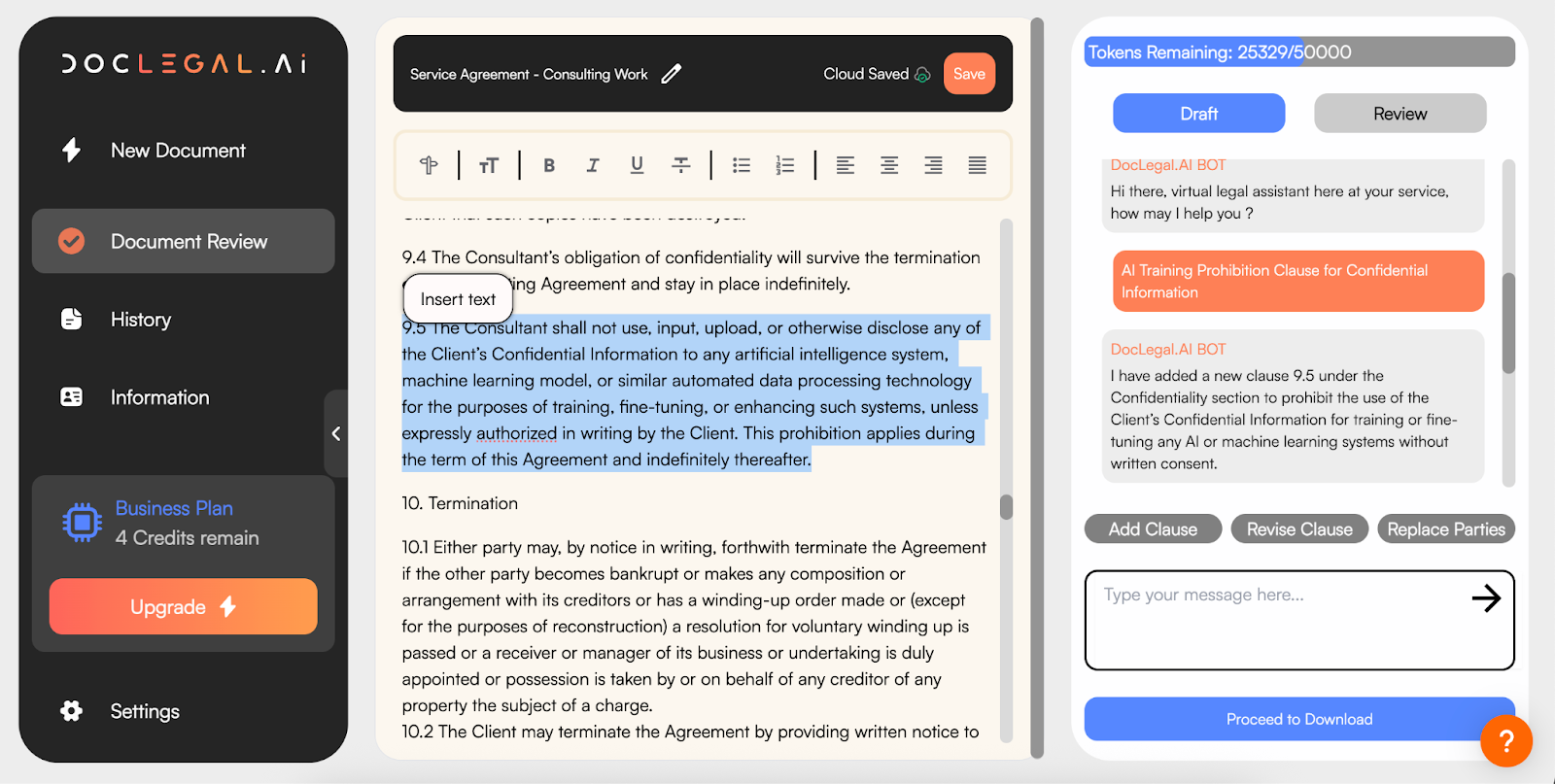
- Ask Doclegal.ai chatbot to make the Remedies for Breach clause in the NDA mutual. The chatbot will make the necessary changes within seconds!

Pooja Batra has over 10 years of in-house legal experience at large multinational companies. She has advised on a wide range of corporate and commercial matters, including drafting, reviewing, and negotiating contracts and agreements across various business lines. At DocLegal.ai, she applies her expertise to help small businesses and professionals navigate legal documents efficiently and confidently.

Can I Write an NDA For My Business?
Why People Want to Write Their Own NDA If you’re about to share a new idea with an investor, hire a freelancer, or bring in a new partner, one of the first things you’ll hear about is a Non-Disclosure Agreement (NDA). It’s the simplest way to protect confidential information yet hiring a lawyer to draft one can be expensive. That’s why many business owners and freelancers wonder: Can I write my own NDA? The short answer is yes but it’s easy to get wrong. An NDA is only effective if it’s legally binding and clearly worded. A vague or incomplete NDA could leave your ideas unprotected. In this guide, we’ll explain how you can confidently write your own NDA, what clauses you must include to make it enforceable, and the common mistakes to avoid. If you’d like a faster and safer route, DocLegal.ai lets you generate a legally sound NDA in minutes, tailored to your business and jurisdiction.

Why People Want to Write Their Own NDA
If you’re about to share a new idea with an investor, hire a freelancer, or bring in a new partner, one of the first things you’ll hear about is a Non-Disclosure Agreement (NDA). It’s the simplest way to protect confidential information yet hiring a lawyer to draft one can be expensive.
That’s why many business owners and freelancers wonder: Can I write my own NDA?
The short answer is yes but it’s easy to get wrong. An NDA is only effective if it’s legally binding and clearly worded. A vague or incomplete NDA could leave your ideas unprotected.
In this guide, we’ll explain how you can confidently write your own NDA, what clauses you must include to make it enforceable, and the common mistakes to avoid. If you’d like a faster and safer route, DocLegal.ai lets you generate a legally sound NDA in minutes, tailored to your business and jurisdiction.
1. What Is a Non-Disclosure Agreement (NDA)?
A Non-Disclosure Agreement (NDA) is a legal contract between two or more parties that sets out what information must remain confidential. It’s designed to protect trade secrets,protect ideas, strategies, or any sensitive data shared during discussions or collaborations.
In simple terms, an NDA ensures that information shared is protected by the parties.
Common uses of NDA include:
- When a startup shares business ideas with potential investors
- When a company hires freelancers or consultants
- When two businesses explore a potential partnership
- When employees have access to proprietary information
There are two main types of NDAs:
- One-way NDA: Only one party shares confidential information.
- Mutual NDA: Both parties share and agree to keep each other’s information confidential.
(Tip: You can instantly generate either type of NDA using DocLegal.ai’s smart AI legal templates — just select the purpose and customize the legal templates to your situation.)
2. Can You Write Your Own NDA? (Short Answer: Yes, But...)
You don’t need to be a lawyer to draft an NDA. Anyone can write one — the key is to include the right clauses and use clear, enforceable language.
However, a poorly drafted NDA can do more harm than good. Courts may reject NDAs that are too broad, confusing, or missing essential terms like the governing law or signature.
When writing your own NDA, make sure you:
- Clearly define what “confidential information” includes
- Specify how and why the information will be shared
- State how long the confidentiality obligation lasts
- Include the governing law (the country or state whose laws apply)
- Ensure it’s signed and dated by all parties
Pro Tip: Save time and avoid legal guesswork — DocLegal.ai automatically includes all the essential clauses in NDA ensuring a valid and enforceable NDA in your chosen jurisdiction.
3. Key Clauses in NDA
For a legally binding NDA, it should cover these essential clauses:
- Definition of Confidential Information
- Clearly describe what information is confidential (e.g. business plans, designs, client lists).
- Avoid vague phrases like “all company information.”
- Clearly describe what information is confidential (e.g. business plans, designs, client lists).
- Purpose of Disclosure
- State why the information is being shared (e.g. evaluating a potential partnership).
- State why the information is being shared (e.g. evaluating a potential partnership).
- Obligations of the Receiving Party
- Specify how the receiving party must protect the information — e.g. no sharing, copying, or misuse.
- Specify how the receiving party must protect the information — e.g. no sharing, copying, or misuse.
- Exclusions from Confidentiality
- Mention what information is not confidential, such as publicly available information or details already known before signing NDA.
- Mention what information is not confidential, such as publicly available information or details already known before signing NDA.
- Term and Duration
- Define how long the confidentiality obligation will continue — typically 2 to 5 years after disclosure of confidential information.
- Define how long the confidentiality obligation will continue — typically 2 to 5 years after disclosure of confidential information.
- Jurisdiction and Governing Law
- Choose which country or state’s law governs the agreement. This ensures clarity in case of disputes.
Example: “Each party acknowledges and agrees that this Agreement shall be governed by the laws of [Jurisdiction].”
- Signatures
- Make sure all parties sign and date the NDA — digital signatures are acceptable in most jurisdictions.
- Make sure all parties sign and date the NDA — digital signatures are acceptable in most jurisdictions.
4. Common Mistakes in DIY NDAs (and How to Avoid Them)
Even small drafting errors can make an NDA unenforceable. Here are the most common pitfalls:
Vague definitions: Using unclear terms like “confidential material” without examples.
Fix: List specific types of information you want protected.
Missing expiration date: An NDA without a time limit may be seen as unreasonable.
Fix: Set a realistic duration — e.g., “for three years from the date of signing of NDA.”
No governing law: Without jurisdiction, it’s unclear which court handles disputes.
Fix: Always specify governing law.
No signature or witness: Unsigned NDAs have no legal effect.
Fix: Get both parties to sign; use digital signatures if needed.
Not distinguishing NDA type: Using a one-way NDA when information flows both ways.
Fix: Decide upfront whether you need a one-way or mutual NDA.
5. When to Get Professional or use AI legal document generator for NDA
While you can write a NDA, there are times when professional help is worth it. For example:
(a) Detailed Definition of Confidential Information
- Covers not only written and verbal info, but also trade secrets, technical data, business plans, customer lists, financials, and intellectual property.
- Often includes exceptions (e.g., information already public, independently developed, or legally required to disclose).
Why it matters: A poorly defined scope can make the NDA unenforceable or allow disputes over ‘what is confidential information’.
(b) Multi-party or cross-border considerations
- Involves more than two parties, subsidiaries, or affiliates.
- May involve international laws
Why it matters: Simple NDAs usually assume one-to-one relationships; complex arrangements can trigger regulatory compliance issues.
3. Explicit Use Restrictions
- Limits not only disclosure, but also use of the confidential information.
- May specify project-specific use, prohibition on reverse engineering, or restrictions on copying or storing data.
Why it matters: Incorrectly drafting these clauses can leave loopholes that allow misuse or unintended liability.
4. Term and Survival Provisions
- Specifies how long confidentiality lasts, often beyond the termination of the agreement.
- Includes survival clauses for obligations even after termination.
Why it matters: Misstating these periods can render the NDA ineffective after the collaboration ends.
5. Remedies and Liability
- Includes injunctive relief, equitable remedies, or liquidated damages.
- Sometimes addresses limitations on liability or indemnification obligations.
Why it matters: If drafted incorrectly, you may not be able to enforce the NDA or protect sensitive information in court.
6. Intellectual Property Clauses
- Clarifies ownership of pre-existing IP and any derivative works created during the engagement.
- Often includes license grants or restrictions.
Why it matters: Mismanagement here can lead to inadvertent IP transfers or loss of rights.
7. Governing Law and Jurisdiction
- Specifies which laws and courts govern disputes.
- May include arbitration clauses or venue-specific provisions.
Why it matters: NDAs without this can create uncertainty if disputes arise in multiple jurisdictions.
8. Complex Exceptions and Carve-outs
- Certain disclosures are allowed for legal, regulatory, or internal purposes.
- May include “need-to-know” access rules.
Why it matters: These exceptions must be carefully drafted to avoid undermining confidentiality.
So, Red Flag Indicators You Shouldn’t DIY NDA
- NDA involves multiple parties or cross-border collaboration.
- IP, software, or proprietary technology is part of the discussion.
- You anticipate long-term relationships or ongoing disclosure.
- You need remedies beyond simple damages, like injunctive relief.
In short: if your NDA goes beyond a simple one-to-one confidentiality for a short period, it’s safer to have use DocLegal.ai to write NDA or review NDA. DIY NDAs often fail because they leave gaps in definition, scope, enforcement, or legal compliance.
AI assistance can transform your workflow, With DocLegal.ai, you can:
- Generate NDA tailored to your situation
- Review your draft for missing clauses
- Get suggestions to make it legally sound
(That’s less than the cost of a single coffee — and far less than hiring a lawyer.)
Generate your NDA now on DocLegal.ai — less than the price of your daily coffee.
Bonus: Quick FAQ
1. Is a handwritten NDA legal?
Yes, as long as it contains all key clauses and signatures. Though digital or typed NDAs are preferred for clarity.
2. Can you make an NDA without a lawyer?
Absolutely. AI tools like DocLegal.ai let you draft NDA and review NDAs without needing a lawyer.
3. How long should an NDA last?
Generally 2 years after the information is shared, unless it involves long-term trade secrets.
Pooja Batra has over 10 years of in-house legal experience at large multinational companies. She has advised on a wide range of corporate and commercial matters, including drafting, reviewing, and negotiating contracts and agreements across various business lines. At DocLegal.ai, she applies her expertise to help small businesses and professionals navigate legal documents efficiently and confidently.

Relationship Contracts: Answers to All Your Commonly Asked Questions
Relationship Contract is the new norm for setting out expectations, boundaries, rules that build the foundation of a relationship between an unmarried couple. From communication and trust to finances and quality time, it helps couples align their values and avoid unnecessary conflict. In this blog, we answer all the commonly asked questions about relationship contracts: what they are, who they’re for, whether they’re legally binding, and how to create one. By the end, you’ll have a clear roadmap for drafting a relationship agreement that strengthens your bond and supports a healthy, happy partnership.

Relationship Contract is the new norm for setting out expectations, boundaries, rules that build the foundation of a relationship between an unmarried couple. From communication and trust to finances and quality time, it helps couples align their values and avoid unnecessary conflict.
In this blog, we answer all the commonly asked questions about relationship contracts: what they are, who they’re for, whether they’re legally binding, and how to create one.
By the end, you’ll have a clear roadmap for drafting a relationship agreement that strengthens your bond and supports a healthy, happy partnership.
1. Who are the parties to a relationship contract? A relationship contract is between two people who are unmarried and in a committed relationship.
2. What is the purpose of a relationship contract? The purpose is to set out clear expectations and relationship rules like ‘we will spend the weekends together’ ‘we will communicate our needs clearly’.
3. Are relationship agreements legally binding? No, unless it sets out certain financial terms and conditions which show an intention of entering into a contractual relationship then such financial terms can be binding and enforceable in the court. For example ‘party A shall not be responsible for the payment of monthly rent. Party A is solely responsible for payment of utility bills’
4. Why is a relationship contract popular when not legally binding? A relationship contract ensures couples talk about topics and agree on matters that are difficult to discuss. It brings out an understanding about the core values of the parties involved in a relationship.
5. Is a relationship contract the same as a prenuptial agreement? No, relationship contracts relate to emotional matters in a relationship more than financial matters. Pre-nuptial agreement is entered between couples intending to marry and agree on terms and conditions relating to property, child care and maintenance as an insurance in case of a divorce in future.
6. Can I draft my own relationship contract? Yes, you don’t need a lawyer to draft a relationship contract. This agreement template represent your and your partner’s core values and can be written in plain English. However, with a pre-written comprehensive template, it is easier to discuss what is written already, agree and customize. With AI legal generator tools you can further expand on these terms and conditions easily. Your relationship contract will be ready in less than 5 min. Just provide your scenario and have an AI legal tool provide the language and insert where required in the contract.
7. What to include in a relationship contract? Here’s what you can include in a relationship agreement:
(a) Trust and Transparency
Honesty is the foundation of any strong relationship. Couples can explicitly agree on the importance of being truthful and open with each other. This might include sharing geolocation data, with exceptions for surprises or personal safety.
Example clause: “We agree to tell the full truth to each other and not avoid delicate topics unnecessarily. We will make our geolocation available via smartphone at all times, except when revealing it would compromise a surprise or put either party at risk.”
(b) Communication
A thriving relationship requires regular, meaningful communication. Agree on a frequency and duration for check-ins to ensure that both partners feel heard and understood.
Example clause: “We will talk at least [FREQUENCY] times per week for a minimum of [DURATION] minutes per conversation, listening and expressing our feelings openly and honestly.”
(c) Fulfilling Needs
Being clear about each other’s emotional, spiritual needs helps couples grow together. Transparency about these needs fosters deeper connection and understanding.
(d) Intentions and Acknowledgements
No one is perfect, and growth takes time. Couples can acknowledge their imperfections, remain patient, and maintain flexible boundaries while pursuing personal and shared growth.
Example clause: “We recognize that neither of us is perfect and accept each other as we are. We agree to stay growth-oriented while remaining patient, keeping our minds open, and respecting each other’s boundaries.”
(e) Responsibilities
Sharing household and life responsibilities reduces conflict and promotes teamwork. Define who handles which tasks to avoid misunderstandings.
Example clause: “We will each take responsibility for agreed-upon household tasks to ensure a balanced partnership.”
(f) Interactions and Quality Time
Scheduled quality time strengthens the relationship. Agree on regular, distraction-free date nights or shared activities.
Example clause: “We agree to maintain distraction-free date nights on [DATE] to nurture our connection.”
(g) Respect and Personal Space
Respecting each other’s careers, hobbies, and personal time is essential. Both partners should support one another when professional or personal demands take priority.
(h) Finances and Property
Clarify ownership of gifts, property, and shared assets. Open discussion about financial matters prevents misunderstandings and promotes fairness.
Example clause: “Any gift or property given by one party to the other legally belongs to the recipient. Property given to both parties is co-owned. We will consult each other before making changes to our residence.”
(i). Dispute Resolution
Even the healthiest relationships encounter disagreements. Agree on ways to resolve conflicts, including counseling or third-party mediation if needed.
(j). Term of the Agreement
Define the duration of your agreement and any renewal terms.
Example clause: “This agreement is valid for [PERIOD] months and will automatically renew unless otherwise indicated by either party.”
8. What are the different types of relationship contracts?
DocLegal.ai offers various templates for relationship contracts including for short term and long term relationships.

A relationship contract is more than just a piece of paper - it’s a tool for clarity, communication, and mutual understanding. While it may not always be legally binding, it encourages couples to discuss topics that are often difficult to raise, from trust and transparency to finances and shared responsibilities. By setting clear expectations and boundaries, couples can navigate their relationship with greater confidence and harmony.
Whether you’re in a short-term romance or a long-term partnership, drafting a relationship contract helps align values, strengthen emotional connection, and prevent misunderstandings before they arise. With tools like AI-powered legal generators, creating a thoughtful, customized agreement has never been easier. It enables couples to focus on what really matters: building a healthy, happy relationship together.

Relationship Contract Template
Key Takeaways Relationship contracts clarify expectations in emotional, financial, and practical aspects of modern relationships Having a written relationship contract can foster mutual respect and set expectations from the relationship at the outset. Financial terms agreed by the parties in the relationship agreement can be legally binding and enforceable in certain circumstances. Emotional or behavioural promises in the relationship agreement are not enforceable.

______________________________________________________________________
Key Takeaways
- Relationship contracts clarify expectations in emotional, financial, and practical aspects of modern relationships
- Having a written relationship contract can foster mutual respect and set expectations from the relationship at the outset.
- Financial terms agreed by the parties in the relationship agreement can be legally binding and enforceable in certain circumstances.
- Emotional or behavioural promises in the relationship agreement are not enforceable.
______________________________________________________________________
What Is a Relationship Contract?
A relationship contract is a written agreement between two people in an intimate or committed relationship. It records mutual expectations about how the relationship will work day to day emotionally, practically, and sometimes financially.
While some couples treat it as a symbolic exercise, others create detailed agreements covering matters such as:
- Finances: How expenses will be shared or savings managed.
- Communication: Expectations for openness, boundaries, and privacy.
- Conflict resolution: How disagreements will be handled.
- Domestic life: Living arrangements, chores, and family planning.
- Digital behaviour: Guidelines for social media, texting, and online privacy.
The act of drafting the contract itself often matters more than the document that results. It forces honest conversation about topics that are easy to avoid such as money, time, personal space, and values.
Are Relationship Contracts Legally Enforceable?
Not Really. The closer a relationship contract resembles a cohabitation or financial agreement, the more likely it is to hold legal weight. Emotional or behavioural promises, however, remain symbolic.
Relationship Contracts in the US
Casual "relationship contracts" are generally not legally enforceable in the US, as they often contain non-financial provisions and lack the legal requirements of a binding contract. However, legally enforceable agreements like cohabitation agreements (for unmarried couples) and prenuptial agreements (for those planning to marry) are available to define financial and property matters and can be enforced by a court if they meet state-specific criteria.
Relationship Contracts in common law jurisdictions
Under common law principles, courts typically presume that domestic or romantic agreements lack an “intention to create legal relations.” In other words, promises made within intimate relationships are considered personal, not contractual.
However, if a contract covers financial or property-related matters — for example, how rent or mortgage payments are divided — it may be enforceable if it shows clear legal intent.
Relationship Contract vs. Prenuptial Agreement
- Relationship contracts: These are informal agreements between partners that are not legally enforceable.
- They are often used to outline expectations for daily life, such as chores or personal conduct, but these terms cannot be enforced in court.
- While they may be helpful for communication, they lack the legal structure to be taken to court if one party violates them.
- Prenuptial agreements: These are legally enforceable contracts made by couples before they get married.
- They can outline how assets will be divided in the event of a divorce.
- They are not the same as casual relationship contracts and cannot include personal rules about housework, sex, or raising children.
- They must meet specific state requirements to be considered valid and enforceable
Are the Relationship Contracts Commonly Accepted?
Yes. Relationship agreements can actually strengthen emotional intimacy by setting out shared goals, responsibilities, and boundaries. In fact, relationship contracts are one of the most popular sought out agreements on many contract template websites.
How To Write A Relationship Contract?
Common clauses in relationship contracts include:
1. Financial Responsibilities
Define how bills, rent, and joint purchases will be managed.
Example: “Each partner will contribute 50% of monthly rent and utilities. Joint purchases above USD 300 must be discussed in advance.”
2. Domestic and Lifestyle Arrangements
Outline practical matters — living schedules, shared duties, or family planning.
Example: “Both partners agree to alternate cooking and cleaning duties weekly.”
3. Personal Boundaries and Conduct
These are often symbolic but emotionally valuable.
Example: “We agree to communicate disagreements respectfully and avoid posting private matters online.”
4. Privacy and Digital Conduct
In the age of social media, boundaries here are increasingly relevant.
Example: “Photos of the relationship will only be shared publicly with mutual consent.”
5. Conflict Resolution
Agreements can include a dispute resolution mechanism such as mediation or counselling to encourage constructive communication.
Example: “In case of major disagreements, both partners agree to attend two joint counselling sessions before making decisions about separation.”
6. Exit and Post-Relationship Terms
If the relationship ends, clauses can set expectations around shared property, pets, or living arrangements.
Example: “If the relationship ends, Partner A will remain in the apartment and reimburse Partner B for 50% of the deposit.”
Why Do Relationship Contracts Matter?
Relationship contracts are not about distrust. They’re about clarity and accountability.
Couples who draft them report benefits beyond the document itself:
- Improved communication: Discussing the contract encourages openness about values, money, and boundaries.
- Conflict prevention: Setting expectations early avoids resentment later.
- Mutual respect: Partners show commitment to fairness and understanding.
- Emotional security: Both parties know where they stand, which builds confidence in the relationship.
A relationship contract can act as a mirror because it reflects what both partners value most.
Real-Life Scenarios: When Relationship Contract Agreement Help
Cohabiting Couples
Two partners decide to live together but keep separate finances. A written contract clarifies rent contributions and how to handle shared purchases and prevents disputes if one earns more than the other.
Long-Distance Partners
A couple in different countries agrees on visit schedules and communication expectations. The process reduces tension about perceived neglect or imbalance.
High-Net-Worth Couples
Partners outline how to handle lifestyle expectations. Though not legally binding like a prenup, it serves as a mutual understanding framework.
Common Pitfalls and Legal Cautions
- Emotional Clauses Are Not Enforceable
Promises about love, fidelity, or affection have moral weight but no legal force. - Ambiguity Leads to Conflict
Vague wording (“fair share,” “reasonable effort”) creates uncertainty so be clear and measurable. - Failure to Review Regularly
Relationships evolve. Contracts should be revisited yearly or during major life changes.
Emerging Trends: The Normalization of Contractual Relationships
Relationship contracts are part of a broader cultural shift toward intentional relationships. Younger generations, raised in an era of transparency and self-definition, view contracts not as constraints but as tools for equality and communication.
1. Technology and AI Tools
Platforms now allow couples to co-draft agreements using templates or guided questionnaires much like contract automation in business.These digital tools encourage thoughtful discussion and accessibility.
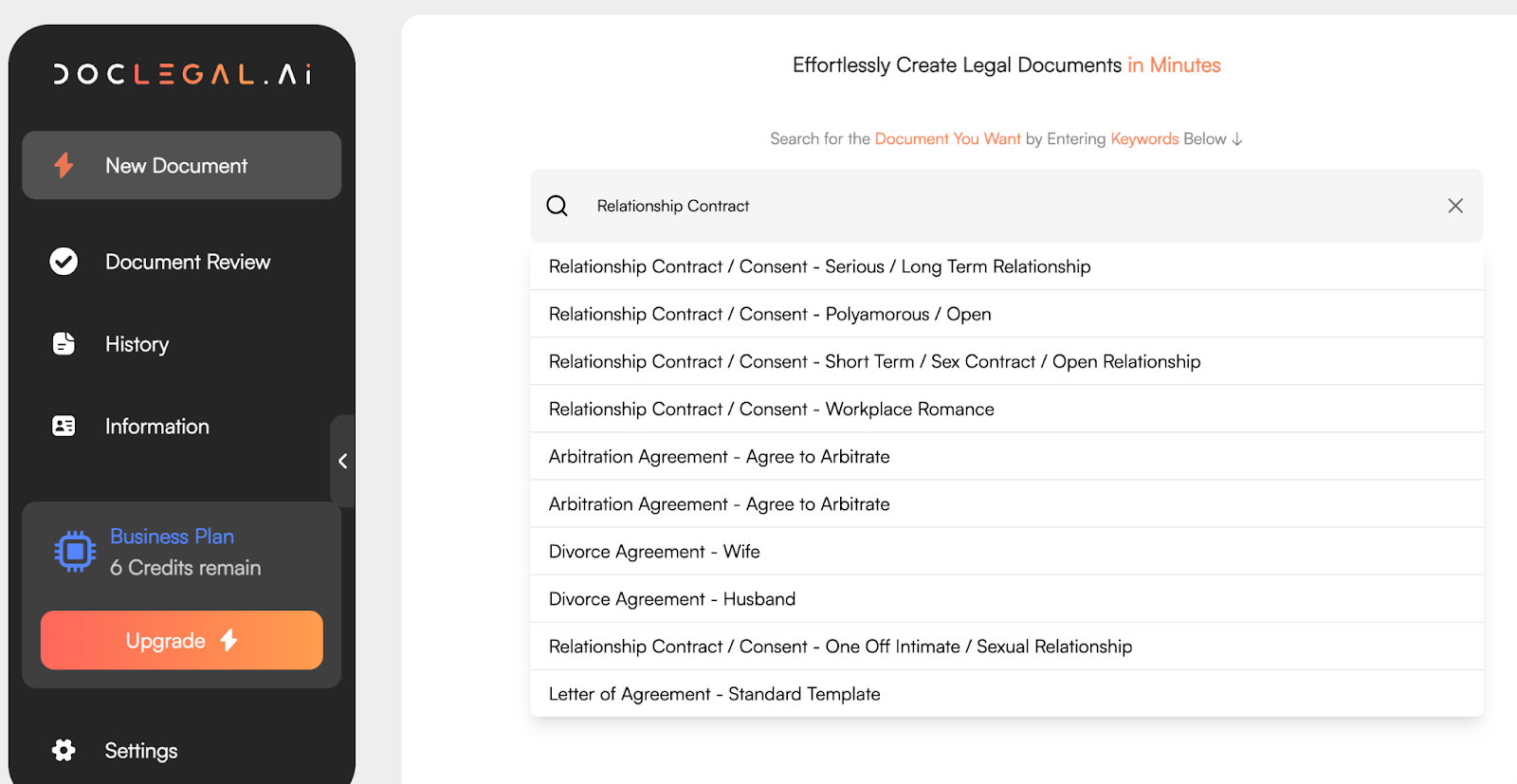
2. Psychological Backing
Therapists increasingly support relationship contracts as a communication exercise, helping couples express needs and boundaries clearly.
Relationship Contract on Doclegal.ai - Free Preview
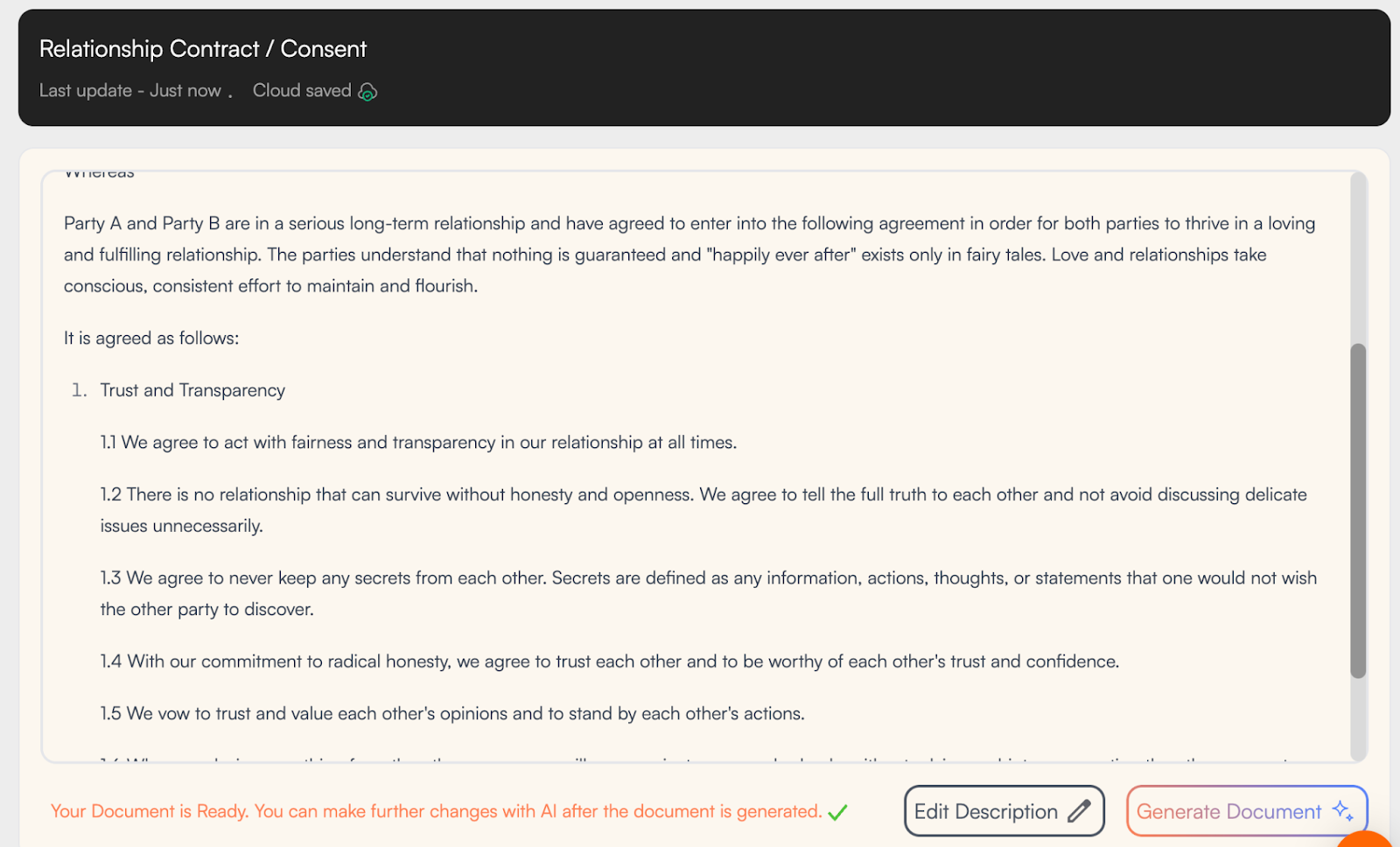
For couples ready to take a modern, mindful approach to partnership, a relationship contract offers more than legal structure. It offers emotional maturity. Whether you treat it as a symbolic declaration or a practical roadmap, the exercise itself builds trust and understanding.
While courts may not enforce every promise, the process of drafting a relationship contract remains valuable. It encourages couples to think deeply about what partnership truly means — emotionally, practically, and ethically.
Because when expectations are clear, communication is open, and both partners feel respected — the contract, in essence, is already being fulfilled.

The Power of a Legal Document Generator AI in Modern Law Firms
In the fast-evolving legal landscape, the integration of artificial intelligence has transformed how law firms operate. One of the most revolutionary innovations is the emergence of the Legal Document Generator AI, a tool that is reshaping the way legal professionals draft, review, and manage documents. With increasing pressure to deliver faster, more accurate legal services, modern law firms are turning to smart solutions like DocLegal.ai, our cutting-edge AI legal assistant, to stay ahead of the curve.This comprehensive guide explores the transformative power of AI in legal document automation, the benefits it brings to law firms, and how tools like DocLegal.ai are setting new standards in legal tech.

In the fast-evolving legal landscape, the integration of artificial intelligence has transformed how law firms operate. One of the most revolutionary innovations is the emergence of the Legal Document Generator AI, a tool that is reshaping the way legal professionals draft, review, and manage documents. With increasing pressure to deliver faster, more accurate legal services, modern law firms are turning to smart solutions like DocLegal.ai, our cutting-edge AI legal assistant, to stay ahead of the curve.
This comprehensive guide explores the transformative power of AI in legal document automation, the benefits it brings to law firms, and how tools like DocLegal.ai are setting new standards in legal tech.
Introduction to Legal Document Generator AI

Legal document automation is not a new concept, but the integration of artificial intelligence has elevated it to unprecedented levels. A Legal Document Generator AI uses machine learning and natural language processing to create, customize, and review legal documents with remarkable speed and precision.
Unlike traditional templates, AI-driven systems adapt to context, jurisdiction, and user intent, producing documents that are not only legally sound but also tailored to specific needs. With DocLegal.ai, legal professionals can now generate contracts, agreements, NDAs, wills, and more—within minutes.
🚀 Try DocLegal.ai now and experience the future of legal drafting: Start for Free
Why Traditional Legal Drafting Is No Longer Enough
The conventional method of drafting legal documents is time-consuming, prone to human error, and often inefficient. In an era where clients demand faster turnaround and greater transparency, law firms can no longer rely solely on manual processes.
Challenges of Traditional Drafting:
- Repetitive tasks reduce productivity
- High risk of inconsistencies and errors
- Time-intensive document review processes
- Limited scalability for growing firms
- Increased operational costs
Read More - The Problem: Contract Review Work Slows You Down
Modern firms need agile solutions. This is where AI-powered tools like DocLegal.ai step in to streamline operations and enhance accuracy.
Key Features of an AI-Powered Legal Assistant
An advanced AI legal assistant like DocLegal.ai brings a suite of intelligent features that transform how legal professionals handle documents.
Core Capabilities:
- 🧠 Contextual Drafting: Understands legal language and adapts to specific clauses
- 📄 Template Customization: Offers dynamic templates for various legal needs
- 🔍 Automated Review: Flags inconsistencies, missing clauses, and legal risks
- 🌐 Jurisdictional Adaptation: Adjusts content based on local laws and regulations
✅ Discover how DocLegal.ai can enhance your legal practice: Explore Features
Read more about AI Powered Legal Document Generator Explained: Faster, Smarter Contracts.

Benefits of Using DocLegal.ai in Your Law Firm
Implementing DocLegal.ai in your legal practice offers a wide array of advantages that go beyond just speed.
Strategic Advantages:
- ⏱️ Time Efficiency: Draft documents in minutes, not hours
- 💼 Professional Accuracy: Reduce errors and ensure legal compliance
- 📈 Scalability: Handle more clients without increasing overhead
- 💡 Smart Suggestions: Receive AI-driven recommendations for clauses and language
Still have doubts? Find out for yourself: “Is DocLegal.ai better than other AI tools? Google AI Overview Responds”
Real-World Applications in Legal Practice
AI document generators are not just theoretical tools—they are actively transforming legal workflows across various practice areas.
Use Cases:
- Corporate Law: Draft shareholder agreements, M&A documents, and board resolutions
- Real Estate: Generate lease agreements, purchase contracts, and disclosures
- Family Law: Create wills, divorce settlements, and custody agreements
- Employment Law: Automate employment contracts, NDAs, and HR policies
- Litigation: Prepare pleadings, motions, and discovery documents
📘 See how firms can use DocLegal.ai in real scenarios: Use Cases

Embrace the Future with DocLegal.ai
The legal profession is evolving, and those who adapt will thrive. With the power of AI-driven legal document generation, law firms can enhance efficiency, reduce errors, and deliver superior client service.
DocLegal.ai is more than a tool—it's your intelligent legal partner. Whether you're drafting a simple NDA or a complex merger agreement, DocLegal.ai empowers you to do it faster, smarter, and more securely.
🚀 Ready to revolutionize your legal workflow? Start Using DocLegal.ai Today

How an AI Legal Assistant Can Transform Your Daily Workflow
AI legal assistant, legal automation, DocLegal.ai, legal document creation, AI contract review, legal workflow optimization, legal tech tools, document compliance, legal AI software

How an AI Legal Assistant Can Transform Your Daily Workflow
In an era where efficiency, accuracy, and speed are paramount, the legal profession is undergoing a transformative shift. The integration of artificial intelligence (AI) into legal workflows is not just a trend, it's a revolution. Among the most impactful innovations is the rise of the AI legal assistant, a tool designed to streamline legal processes, reduce human error, and enhance productivity. One standout solution in this space is DocLegal.ai, an AI-powered legal assistant that empowers professionals to create, customize, and review legal documents with unprecedented ease.
Whether you're a solo practitioner, in-house counsel, or part of a large firm, understanding how an AI legal assistant like DocLegal.ai can reshape your workflow is essential to staying competitive in today’s legal landscape.

Read more - Google AI Overview Validates DocLegal.ai: Smarter Legal Contract Solutions for $1
What Is an AI Legal Assistant?
An AI legal assistant is a software application powered by machine learning and natural language processing (NLP) that automates and supports a range of legal tasks. These include:
- Drafting and reviewing contracts
- Conducting legal research
- Managing case files
- Ensuring compliance with legal standards
- Providing intelligent document suggestions
Unlike traditional legal software, AI assistants learn from vast amounts of legal data, enabling them to provide context-aware insights and real-time document enhancements.
The Rise of Smart Legal Automation
The legal sector has historically been slow to adopt new technologies. However, the increasing complexity of legal work and the demand for faster turnaround times have made automation not just beneficial, but necessary. AI tools like DocLegal.ai are at the forefront of this evolution, offering a seamless blend of automation and legal intelligence.
Key Benefits of Using an AI Legal Assistant
1. Time Efficiency
One of the most immediate benefits of an AI legal assistant is the time saved on routine tasks. With DocLegal.ai, users can:
- Generate contracts in minutes
- Auto-populate clauses based on context
- Instantly identify risks, inconsistencies, or missing elements
This means more time for strategic thinking and client interaction.
2. Enhanced Accuracy error in legal documentation can lead to costly consequences. AI tools minimize these risks by:
- Cross-referencing legal databases
- Identifying potential risks and unfavorable clauses
- Providing actionable insights and suggesting corrections in real-time
DocLegal.ai’s AI engine is trained on thousands of legal documents, ensuring high levels of precision.
3. Cost Reduction
By automating repetitive tasks, firms can reduce hours spent on low-value work. This translates into:
- Lower operational costs
- More competitive pricing for clients
- Increased profitability
Using DocLegal.ai, you can discover the answer to “What If Your Next Contract Cost Only $1?”
5. Customization and Scalability
Whether you're drafting a lease agreement or a complex merger contract, DocLegal.ai allows for:
- Effortless and full document customization
- Access to 2800+ lawyer-reviewed templates for various needs
- All-in-one legal solution
Use Cases: How Legal Professionals Are Using AI Today
For Legal Professionals
- Enhance efficiency by automating routine reviews and refining contracts faster.
- Drafting client agreements
- Automating NDA creation
- Offering faster turnaround to clients
Small Business Owners and Startups
- Save time and money with affordable legal solutions tailored to your business needs
- Quickly draft and finalize investor agreements, NDAs, and service contracts during critical growth phases
- Review contracts and service agreements using our legal document checker, tailored to protect your interests.
Find out more about How SMEs Can Use AI to Draft Sponsorship Contracts.
Enterprises and Real Estate Professionals
- Manage large volumes of contracts while maintaining accuracy and compliance.
- Review lease agreements, purchase contracts, and property management documents in minutes.
- Create employment contracts, offer letters, and policy documents swiftly and efficiently.
👉 Ready to streamline your legal operations? Try DocLegal.ai today and experience the future of legal work.
DocLegal.ai: Your AI-Powered Legal Assistant
DocLegal.ai is more than just a document editor, it's your intelligent legal partner. Built by legal experts and AI engineers, DocLegal.ai offers:
- 🔍 Contextual document analysis
- 🧠 Smart clause recommendations
- 📄 Real-time document generation
- 🔄 Seamless integration with your existing tools
Why Choose DocLegal.ai?
- ✅ 2800+ Lawyer-Curated Templates
- ✅ Built for Multiple Jurisdictions
- ✅ Effortless Automation
- ✅ Affordable Pricing
Don’t just keep up, get ahead. Start your free trial of DocLegal.ai now.
How to Integrate DocLegal.ai Into Your Workflow
Step 1: Sign Up
Create your account at DocLegal.ai and gain instant access to the platform.
Step 2: Search for the Document You Want

Select from a wide range of legal templates tailored to your practice area.
Step 3: Customize with AI
Use DocLegal.ai’s smart editor to modify clauses, add client-specific details, and ensure compliance.
Step 4: Review and Finalize

Let the AI assistant scan for inconsistencies, suggest improvements, and finalize your document.
Step 5: Export
Generate your document and share it securely with clients and colleagues.
Final Thoughts: Embrace the Legal Tech Revolution
The legal world is changing – and fast. As the demand for faster, more accurate legal services grows, tools like DocLegal.ai are becoming essential. By automating routine tasks, enhancing document accuracy, and ensuring compliance, AI legal assistants are not just tools, they’re strategic assets.
If you're ready to future-proof your legal practice, it's time to make the switch.
👉 Start your journey with DocLegal.ai today and transform the way you work.
.jpeg)
How do you handle a data access request form?
There comes a time in every company's lifespan when an email is received from a data subject asking for access to their personal data. The General Data Protection Regulation (GDPR) specifically empowers individuals to request their personal data and protect their rights. Knowing how to handle a data access request form is critical to remain compliant with the GDPR and other relevant legislation.

There comes a time in every company's lifespan when an email is received from a data subject asking for access to their personal data. The General Data Protection Regulation (GDPR) specifically empowers individuals to request their personal data and protect their rights. Knowing how to handle a data access request form is critical to remain compliant with the GDPR and other relevant legislation.
What is a data access request (“DAR”)?
In simple terms, a data access request in general is a request made by a data subject or “requestor” to request a data user to supply him with a copy of his personal data. This is usually done for the “requestor” to understand what data is held about them, how it is used, who it is shared with, and to ensure accuracy and lawful processing.
How do you comply with a DAR?
Upon receiving a DAR, a data user should follow the following steps:
- Ascertain the identity of the requestor;
- Assess whether it holds the relevant personal data.
According to the GDPR, if a data user holds the relevant personal data, it should supply a copy of the requested data in an intelligible form and within 40 calendar days after receiving the DAR.
Even if the data user does not hold the requested data, it is still required to inform the requestor within 40 days.
Charge for complying with a DAR
A data user may impose a fee for complying with a DAR which should not be excessive and not later than the time period under the applicable data privacy laws.
These are usually framed as administrative costs for the time, effort and out-of-pocket expenses that come along with compliance.
Refusing to comply with a DAR
A data user should refuse to comply with a DAR if:
- It is not supplied with sufficient information to identify the requestor;
- It cannot comply without disclosing personal data of a third party;
- Where compliance is prohibited under the GDPR or any other relevant ordinance.
A data user must give written notice and reasons for refusal to the requestor within 40 days from receiving the DAR and a log entry containing the particulars of the reasons must be kept for four years.
Ready to Generate your Data Access Request Form?
Effortlessly generate a DAR’s in minutes in just a few clicks with Doclegal.ai. We have over 2800 lawyer-curated templates built for multiple jurisdictions to meet the unique legal challenges of the common law markets while maintaining global relevance.
Want to dive deeper? Check out our other blogs related to Data Privacy, Protection and Compliance:
- The Importance of a Privacy Policy for Your Business in 2025
- SaaS Agreements Simplified: Meaning, Legal Issues, Examples & Template

Can AI write legal contracts?
AI can draft legal contracts, but its real power emerges when paired with legal document automation and Contract Lifecycle Management (CLM). Together, they transform contract workflows into a strategic advantage.

AI Contract Drafting
Key Takeaway: AI can draft legal contracts, but its real power emerges when paired with legal document automation and Contract Lifecycle Management (CLM). Together, they transform contract workflows into a strategic advantage.
The legal industry is undergoing a technological revolution. From multinational corporations to boutique law firms, legal teams are under pressure to manage large volumes of contracts while ensuring compliance, reducing risk, and speeding up business. Traditional drafting is slow and resource-intensive, but contracts remain the backbone of every business deal.
This is where AI contracts and legal document automation come in. By combining large language models (LLMs) with Contract Lifecycle Management (CLM) tools, AI is transforming how contracts are drafted, reviewed, and managed.
What Is AI Contract Drafting?
AI contract drafting uses artificial intelligence to generate, edit, and review contracts. Unlike manual drafting, which requires hours of lawyer input, AI leverages templates, pre-approved clauses, and automation to:
- Produce agreements in minutes
- Ensure compliance with company policies
- Reduce risks of human oversight
Lawyers can then focus on high-value work, speed up contract negotiation with AI, client advice, and risk strategy rather than routine drafting.
How AI Contract Drafting Work
AI legal contracts can be generated in two main ways:
- General AI models (LLMs): These can draft contracts from prompts, but accuracy depends on how well the prompt is written.
- Specialized legal automation tools: These platforms integrate legal expertise, compliance safeguards, and clause libraries to produce high-quality contracts regardless of prompt quality.
When combined with a CLM tool, AI drafting fits seamlessly into the entire contract lifecycle i.e. drafting, negotiation, execution, and renewal.
Benefits of AI Contract Drafting
Adopting AI contracts and legal contract AI tools brings tangible advantages:
- Speed & Efficiency: Generate drafts instantly for NDAs, vendor agreements, or employment contracts.
- Contract Templates & Clause Libraries: Standardized and compliant templates ensure consistency across the organization.
- Risk Highlighting: AI flags high-risk terms so legal teams can focus on the most critical issues.
- Instant Contract Summaries: Business teams can access plain-language updates without waiting for lengthy reviews.
- Faster Contract Negotiations: Balanced, AI-drafted agreements reduce redlines and shorten negotiation cycles.
- Third-Party Contract Review: Upload external agreements, and AI will analyze risks and generate reports in minutes. Manual Contract review task typically takes hours.
Everyday Use Cases for AI Legal Contracts
- NDAs & Employment Contracts: Drafted in minutes for onboarding and vendor relationships.
- Third-Party Review: Upload a counterparty contract, and AI produces a risk report instantly.
- Sales & Procurement Support: AI-generated summaries keep business teams aligned without legal bottlenecks.
- Scalable Legal Document Automation: For enterprises managing thousands of contracts, AI plus CLM ensures speed, compliance, and visibility.
Is there an AI tool for Contract Drafting?
Yes. DocLegal.ai, an AI legal document generation tool, helps you generate, review, and optimize legal contracts quickly and accurately. By leveraging pre-approved templates, clause libraries, and automation, it enables legal teams to produce high-quality agreements in minutes. This improves efficiency, reduces the risk of errors, and allows lawyers to focus on higher-value tasks like negotiation and risk strategy.
The Future of AI in Legal Contract Drafting
AI will not replace lawyers but will augment their expertise. By automating repetitive drafting and review, lawyers can focus on strategy, negotiation, and advising the business.
With AI contract drafting and legal document automation embedded in CLM tools, legal teams are evolving from reactive gatekeepers to proactive business enablers.
The stakes are high and poorly drafted contracts risk financial loss, regulatory scrutiny, and reputational damage. But with the right AI legal tools and governance, organizations can combine efficiency, accuracy, and compliance in their contract workflows.
FAQs / Myths / Misconceptions
Q1: Can AI replace lawyers in contract drafting?
A: No. AI assists but cannot replace human judgment, negotiation, or strategic advice.
Q2: Is AI legally compliant by default?
A: Only purpose-built AI trained on legal frameworks ensures compliance. Generic AI may introduce risks.
Q3: Does AI eliminate risk entirely?
A: No, but it significantly reduces errors and flags issues for human review.
Conclusion / Bottom Line
AI has proven to be a transformative tool for contract drafting and review, offering efficiency, accuracy, and scalability. Legal teams that adopt purpose-built AI solutions can reduce operational costs, improve compliance, and accelerate business cycles. However, successful adoption requires careful evaluation, human oversight, and integration into existing legal workflows.
Actionable Recommendation: Legal teams should start with high-volume, low-risk contracts, implement AI tools alongside existing compliance frameworks, and continuously refine AI outputs based on human feedback. The goal is not replacement but augmentation i.e. empowering lawyers to focus on high-value work while AI handles repetitive, time-consuming tasks.

Is DocLegal.ai better than other AI tools? Google AI Overview Responds
The legal industry is rapidly embracing AI technologies. Law firms and corporate legal teams are exploring AI solutions to reduce costs, improve efficiency, and mitigate risk. However, choosing the right AI solution is crucial. Not all platforms deliver the same value, especially when it comes to legal document drafting, privacy, and compliance. Enter DocLegal.ai, a purpose-built AI platform designed to streamline contract drafting, compliance policies, and legal documentation. Unlike general AI tools like Google AI or Microsoft Copilot, DocLegal.ai is specialized for legal teams, offering unparalleled advantages in accuracy, privacy, and cost efficiency.

Is DocLegal.ai better than other legal AI tool?
AI Trends
The legal industry is rapidly embracing AI technologies.
Law firms and corporate legal teams are exploring AI solutions to reduce costs, improve efficiency, and mitigate risk. However, choosing the right AI solution is crucial. Not all platforms deliver the same value, especially when it comes to legal document drafting, privacy, and compliance.
Enter DocLegal.ai, a purpose-built AI platform designed to streamline contract drafting, compliance policies, and legal documentation. Unlike general AI tools like Google AI or Microsoft Copilot, DocLegal.ai is specialized for legal teams, offering unparalleled advantages in accuracy, privacy, and cost efficiency.
Why Specialized Legal AI Tool Matters
Legal AI tool refers to artificial intelligence platforms trained on legal specific databases, enabling them to draft contracts, analyze agreements, and assist with contract generation and review workflows.
Challenges with general AI tools:
- Limited knowledge of legal terminology and nuances
- Generic contract language that may not meet compliance standards
- Potential privacy risks when sensitive client or corporate data is used to train AI models
Specialized platforms like DocLegal.ai bridge this gap, providing AI contract generation and review as legal automation tools.
Evaluation Criteria for Legal AI Tool
Before choosing an AI platform, consider:
- Legal expertise: Does the AI have access to verified legal databases?
- Privacy & security: Are sensitive documents protected?
- Integration: Can it work with existing workflows and software?
- Cost efficiency: Does it scale without excessive costs?
Red flags: Generic contract outputs, no privacy assurances, lack of customization, or unverified data sources.
DocLegal.ai - Best AI Tool for Legal Work
1. Fast, Accurate AI Legal Contract Generation and Contract Analysis
- Use case: Access to 2800+ Contract templates including NDAs, vendor agreements, employment contracts, compliance policies.
- Benefit: AI outputs are suitable for all common law jurisdictions
- Example: A mid-sized company can draft contracts in 30 minutes instead of 5–7 hours, increasing efficiency by up to 80%
2. Enhanced Data Privacy
- Unique advantage: DocLegal.ai does not use user data for AI training, protecting sensitive corporate and client information
- Impact: Lower risk of data breaches and compliance violations
3. Cost-Effective Solutions
- Pricing advantage: Legal document generation at a fraction of the cost of traditional legal services
- Example: Small firms can generate 100 contracts per month for less than one full-time associate, saving thousands annually
4. Workflow Efficiency Across Teams
- In-house counsel: Faster review and approval of contracts
- Procurement teams: Streamlined vendor agreements
- Compliance officers: Quick updates to internal policies and risk assessments
But is DocLegal.ai truly better than other Legal AI tools? According to Google AI Overview, the answer depends on your specific needs.
Why DocLegal.ai Stands Out as a legal AI tool? Google AI Overview

1. Niche Focus on Legal Documents
If your primary goal is AI contract drafting or generating customized legal agreements, DocLegal.ai has a clear advantage. Unlike general-purpose AI tools, it leverages a comprehensive legal-specific database, making it highly effective for creating precise contracts, NDAs, and other legal documents.
2. Data Privacy as a Priority
One key differentiator highlighted by Google AI Overview is DocLegal.ai’s commitment to legal AI privacy. The platform does not use user data to train AI models, offering peace of mind when handling confidential corporate or client information.
3. Affordable, High-Quality Support
DocLegal.ai provides law firm AI software solutions at a fraction of traditional costs, making it accessible for startups, small businesses, and in-house legal teams without compromising quality.
4. Time Efficiency
With DocLegal.ai, legal workflow automation is streamlined. Documents that traditionally take hours can be generated in minutes, freeing legal teams to focus on higher-value tasks.
When Other Legal AI Tools May Be More Suitable
While DocLegal.ai excels in document generation, other AI platforms offer features that may better fit different legal needs:
- Legal research and analysis: Tools like Legalspace are optimized for in-depth research, case law analysis, and precedent tracking.
- Litigation and data-driven decisions: Platforms such as Lex Machina provide predictive analytics and litigation insights beyond DocLegal.ai’s scope.
- Discovery process automation: Everlaw helps legal teams automate document review, summarization, and citation suggestions.
- Broader workflow integration: AI assistants like Microsoft Copilot integrate seamlessly into general office workflows for document creation, collaboration, and research.
Google AI Overview Conclusion
Google AI Overview suggests that whether DocLegal.ai is “better” depends on your priorities. If your primary need is customizable, privacy-focused legal document automation, DocLegal.ai is unmatched. For firms focused on research, analytics, or integrated workflows, alternative AI tools may be a better fit.
FAQs & Misconceptions
Q1: Can DocLegal.ai replace lawyers?
A: No. It is a document drafting and workflow tool, not a substitute for professional legal advice.
Q2: Is my data safe on DocLegal.ai?
A: Yes. User data is never used to train AI models, ensuring privacy and compliance.
Q3: Can it handle multiple jurisdictions?
A: Yes. DocLegal.ai includes templates for all common law jurisdictions.
Conclusion: Why DocLegal.ai is a Strategic Choice For Legal AI Tool
For law firms, corporate counsel, and compliance teams, DocLegal.ai provides a secure, efficient, and cost-effective solution for legal document generation and contract analysis. By focusing on accuracy, privacy, and workflow optimization, it stands out from general-purpose AI tools.
Actionable insight: Adopt DocLegal.ai for document-heavy workflows while supplementing with complementary AI tools for research, analytics, or integration. Legal teams can save time, reduce costs, and mitigate risk, gaining a measurable competitive edge in today’s fast-paced legal environment.

Google AI Overview Validates DocLegal.ai: Smarter Legal Contract Solutions for $1
At DocLegal.ai, we believe legal services should be accessible, reliable, and efficient. Recently, Google’s AI Overview highlighted our platform specifically our $1 contract AI legal tool as an innovative way to help businesses get started with professional legal documents.

Google AI Overview Validates DocLegal.ai: Smarter Legal Contract Solutions for $1
At DocLegal.ai, we believe legal services should be accessible, reliable, and efficient.
Recently, Google’s AI Overview highlighted our platform specifically our $1 contract AI legal tool as an innovative way to help businesses get started with professional legal documents.

As per the Google AI Overview:
“A $1 contract implies either a simplified agreement created with a template, like those from AI legal tools or free online contract makers, or a form of "promotional" contract where the actual cost of the service is handled through a different business model, rather than the contract's legal basis, which could be based on a flat fee or retainer agreement with a law firm. It can also refer to a situation where the real cost is a flat fee for the lawyer, or a contractual offer where you don't technically "pay" until you "do" the action requested in the unilateral contract.
When might a contract cost $1?
AI-Powered Legal Tools:
Services like DocLegal.AI offer contract drafting bundles starting at $1 for a limited time, making it easier and cheaper for startups and growing companies to access essential legal documents.
Free Contract Templates:
Online platforms such as Jotform offer free contract templates, allowing you to create various legally binding agreements without cost.
Promotional Offers:
A service might be offered for $1 as an introductory deal to attract new customers or provide a low-cost way to try a service.
Legal Services with Flat Fees:
Sometimes the $1 refers to the cost to draft, and the average cost for a lawyer is $760 on a flat fee basis.
Unilateral Contracts:
These are a one-sided agreement where you only pay if a specific action is completed. The contract itself would only cost you $1 to make, but there are costs for the action.
What are the alternatives?
Hiring a Lawyer:
You can hire a lawyer to draft or review contracts. A lawyer charges for their services, and the costs depend on how complex the agreement is.
Using Free Online Contract Makers:
These sites allow you to generate your own contracts using free templates, which can save you money but also require more work on your part.
So, Why does $1 Legal Contracts Matter?
For startups and small businesses, this low-cost entry point provides:
- Professional-grade AI drafting that goes beyond free templates
- Clarity and compliance, reducing the risk of errors
- A fast, efficient solution without the cost of traditional lawyers
How DocLegal.ai Stands Out as an affordable AI tool for Legal Templates
Businesses usually face a tough choice: hire a lawyer, which can cost around $760 per contract onwards, as highlighted by Google AI overview, or risk using generic templates. DocLegal.ai offers a smarter middle ground:
- Expert-driven AI ensures high-quality contracts
- Accessible pricing lowers the barrier to professional legal support
- Long-term value by helping businesses work smarter and grow with confidence
The Strategy Behind the Pricing for Doclegal.ai Contracts
For early-stage companies, the choices have always been limited i.e. spend heavily on a lawyer or risk DIY legal uncertainty. By dropping the entry cost to near zero, DocLegal.ai reframes the decision. The Doclegal.ai platform makes the “first contract” decision easy, knowing that credibility and reliability - not raw price - are what drive retention.
Hence, the $1 contract isn’t just about affordability. It’s about trust-building. Once founders experience a well-structured, AI-driven contract draft, they’re more likely to return for more complex work.
Google AI Overview Validates Our Approach
Being recognized by Google AI Overview is more than an accolade. It’s validation that AI-powered legal tools are mature, credible, and strategic. Our $1 contract is just the first step. Once businesses experience the reliability and speed of our AI platform, they often return for ongoing legal support.
Get Started Today
DocLegal.ai is smarter than templates, cheaper than lawyers, and recognized by Google AI Overview. Start with a $1 contract and experience how AI-powered tools provide clear direction while reducing cost and complexity.
.jpeg)
The Problem: Contract Review Work Slows You Down

AI Prompt For Contract Analysis
As a lawyer you know the drill: You’ve just received a 30-page contract from the client and a detailed contract review is expected by tomorrow. Meanwhile, multiple other matters are waiting. Traditional contract review is slow, stressful, and risky.
Your options today:
- Email external counsel for help — but affordable contract review support is hard to find, and budgets are tight.
- Request an extension on your deadline — which can frustrate clients and isn’t always possible.
- Risk missing something critical — even experienced lawyers can overlook key clauses, creating exposure to liability.
- Spend the next 5 hours reviewing line by line manually — tedious, inefficient, and eats time from other priority tasks.
Whichever option you choose, Manual contract review will adversely affect your turn around time on deliverables assigned to you.
DocLegal.ai Contract Review
DocLegal.ai is an AI-powered contract review tool built for busy lawyers. DocLegal.ai helps you analyze contracts quickly without compromising accuracy.
How DocLegal.ai Works?
Step 1: Upload your contract
Step 2: Click Review
Step 3: See results instantly:
- Highlighted risks flagged for each party
- Suggest Clause spots missing clauses and generate them instantly
- Concise contract summary with all key facts and figures
Now, instead of spending 5 hours reviewing manually, you can deliver an update to your manager or client in under an hour.
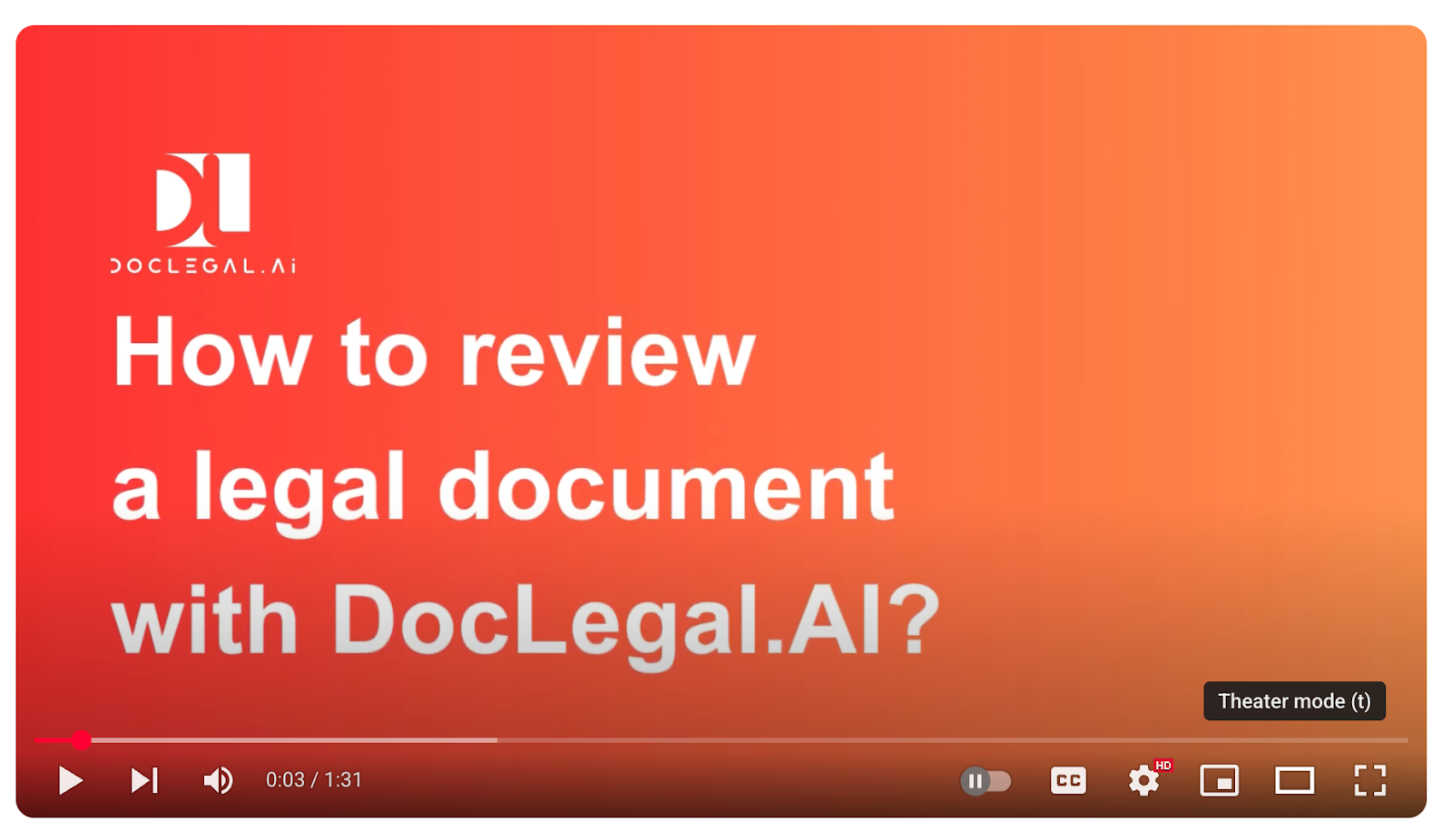
How Does AI Contract Review Work? Watch Demo
The AI Prompt Every Lawyer Needs For Contract Review
Generic AI tools often need long, detailed prompts before you get anything useful.
DocLegal.ai is built differently. It’s trained specifically for contract review, so you can type simple, natural language commands and see instant, accurate results.
With DocLegal.ai, you don’t need to think about “prompt engineering.” Just type what you want, and the contract updates instantly. Here are some examples of AI Prompts for contract review
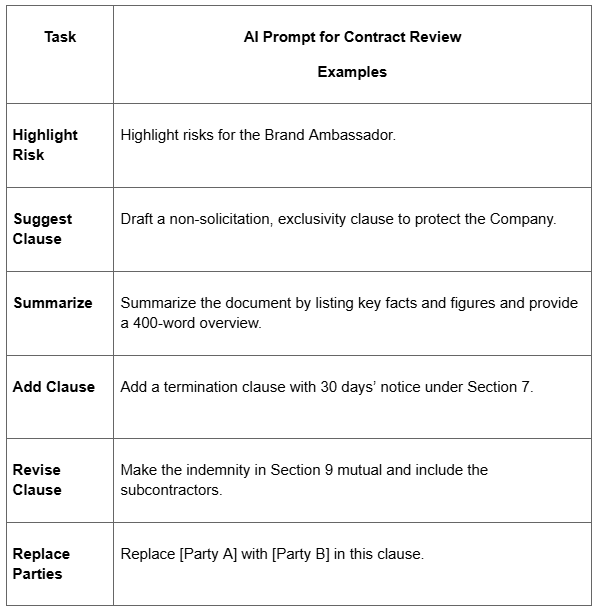
Think of it like this: open your contract on Doclegal.ai, type one of these prompts, and see the update instantly:
- “Highlight the risk for the buyer and seller”
- “Make the indemnity mutual”
- “Add a termination clause with 30 days’ notice”
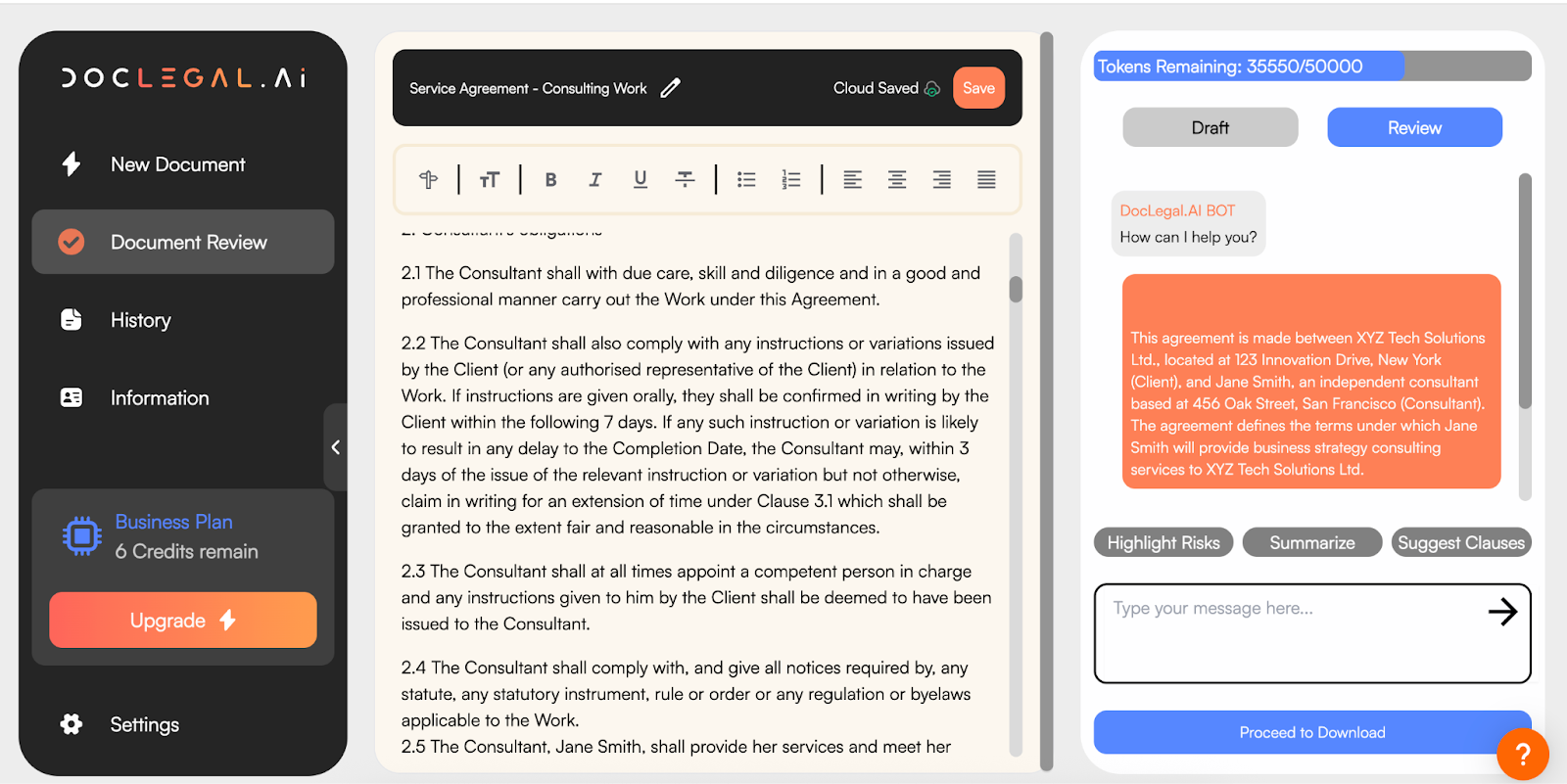
Try DocLegal.ai Contract Review Now
Why Use DocLegal.ai for Contract Review?
- 5X faster turnaround on drafting and reviews
- Work with confidence knowing risks and gaps are flagged
- Affordable compared to external counsel and manual hours
- Confidential — your documents stay private.
The lawyers who adopt AI-powered review will set the new standard for speed, accuracy, and cost-efficiency. The ones who don’t? They’ll be left explaining why they still need two days for something others deliver in one hour.
What DocLegal.ai Users Are Saying?
“algivens74
DocLegal rocks
It took my document and really made it real. It was so fast I am amazed. Thanks guys”
“JuliusSchenck
Safe buy
I bought the program and I’ve kicked the tires on it a bit, and it really is a solid program. At least for quick drawn up deals.”
Your clients expect speed. Your competition is already looking at AI. Don’t let outdated methods hold you back when your peers are already moving faster with AI.
Start today — and see how DocLegal.ai can transform your legal workflow.
Email: [email protected]
Website: www.doclegal.ai

Don’t Neglect Your Customers’ Data! The Importance of a Privacy Policy for Your Business in 2025
Have you ever considered why a privacy policy is essential for your business? In today’s hyper-regulated world, data protection laws are becoming stricter. Global regulations, such as the General Data Protection Regulation (GDPR), mandate compliance for businesses, even those outside the EU, under specific circumstances. With the technological and AI revolution driving a hyper-connected global landscape, a comprehensive and accessible privacy policy for your website is more critical than ever.
Don’t Neglect Your Customers’ Data! The Importance of a Privacy Policy for Your Business in 2025
Have you ever considered why a privacy policy is essential for your business? In today’s hyper-regulated world, data protection laws are becoming stricter. Global regulations, such as the General Data Protection Regulation (GDPR), mandate compliance for businesses, even those outside the EU, under specific circumstances. With the technological and AI revolution driving a hyper-connected global landscape, a comprehensive and accessible privacy policy for your website is more critical than ever.
What is a Privacy Policy?
A privacy policy is a critical component of any organization that collects, stores, or processes personal data. It serves as a transparent agreement between your business and your audience, detailing your commitment to safeguarding their information while complying with global data protection laws. It’s also a strong reflection of your businesses’ values. In 2025, with stricter regulations, a privacy policy is a critical tool for building trust and ensuring global privacy compliance 2025.
At its core, a robust privacy policy should clearly explain the following:
- Who is collecting the information: Include contact information like the company name, address and designated representatives.
- What personal information is collected: This includes personal details like names, email addresses, payment information, device data, or browsing behavior.
- How that data is being collected: Whether through forms, cookies, or third-party tools like Google Analytics.
- Why that data is being collected: For purposes such as improving services, personalizing experiences, or marketing.
- How that data is being managed: Including storage duration, international transfers, security measures, and whether data is shared or sold to third parties.
- Users’ rights: Such as the right to access, correct, or delete their data, as mandated by laws like the GDPR.
What is personal data?
According to the GDPR, “personal data” refers to any information relating to an identified or identifiable natural person, from which it is possible and practical to ascertain their identity. Because such data is often sensitive, it is protected by law.
Personal data can include:
- Names and email addresses
- Financial history
- Biometric data (e.g., fingerprints or facial recognition)
- Health data
- Race or ethnic origin
- Religious beliefs
- IP addresses or browsing history
Given the sensitive nature of personal data, a comprehensive privacy policy is essential to cover all aspects of data collection and use.
5 Reasons why a Rock-Solid Privacy Policy is a Non-Negotiable in 2025
1. It’s the Law
Regulators worldwide are granting consumers greater rights over their personal data. Laws like Australia’s Privacy Act 1988, the EU’s GDPR, and California’s Consumer Privacy Act have far-reaching authority, often requiring businesses outside their jurisdictions to comply, especially for online operations. A clear privacy policy ensures you meet these legal obligations while empowering users.
2. Third-Party Platforms Require It
Many online platforms, such as Shopify, the Apple App Store, Google Play Store, Google Analytics, and Meta, require businesses using their services to maintain a transparent privacy policy. These platforms often mandate including a clause referencing their own privacy practices to ensure compliance with their terms of service.
For example (sample clause): “We use third-party services such as Google Analytics and Shopify to enhance our website’s functionality and user experience. These services may collect data as outlined in their respective privacy policies. Please review Google’s Privacy Policy and Shopify’s Privacy Policy for more information on how your data is handled by these providers.”
3. It Builds Transparency and Trust
A clear, comprehensive privacy policy that outlines how your business collects, uses, and stores data fosters consumer confidence. By demonstrating ethical practices, you empower customers to trust your brand, which can make the difference between a sale and a negative review.
4. It Enhances Trust in AI Usage
AI integration is now commonplace, driving creativity and streamlining workflows. However, many consumers are wary of how businesses use AI and handle their data in these processes. A privacy policy that explicitly addresses AI usage can significantly boost transparency and trust.
For example (sample clause): “We may use artificial intelligence (AI) tools to analyze user data for purposes such as personalizing content, optimizing services, or improving customer support. All of our AI processes comply with applicable data protection laws, and we will ensure your personal data is processed securely with strict safeguards in place to protect your privacy.”
5. It is Your First Line of Defense in a Data Breach
According to IT Governance UK, 2025 has seen a surge in data breaches, with third-party vulnerabilities identified as a leading cause. While a privacy policy cannot prevent breaches, a well-crafted policy can significantly mitigate legal and financial consequences by demonstrating compliance and due diligence.
Create a GDPR Compliant Privacy Policy with DocLegal.AI
With DocLegal.AI, you can create a GDPR-compliant privacy policy template 2025 for your website in minutes. Visit DocLegal.AI today to get started and address privacy requirements with ease.

Navigating Cryptocurrency Tax Laws for Digital Nomads
Master crypto taxes as a digital nomad! Understand US regulations, reporting requirements, and tax-saving strategies for your global earnings.
Navigating Cryptocurrency Tax Laws for Digital Nomads
Imagine this: you’re a digital nomad enjoying your vacation in Bali, and you just found out the niche meme coin you went all in on just went to the moon! You popped open a few bottles of Champagne. While you’re still in disbelief that you are going to be filthy rich, one tiny thing crossed your mind—do you need to pay taxes?
In this blog, we'll break down the essentials of digital nomad tax laws around crypto, with a sharp focus on US rules. We'll cover reporting, strategies to minimise your bill, and even some global considerations. By the end, you'll feel more equipped to handle your taxes, no matter where your passport stamps lead.
The Basics: How the US Taxes Crypto Like Property
First off, if you're a US citizen or resident, the IRS treats crypto as digital assets, not cash. Think of it like stocks or real estate.
For example, say you bought Ethereum for $2,000 last year and traded it for Bitcoin when it hit $4,000. That's a $2,000 capital gain, taxed at your ordinary income rate if you held it less than a year (short-term), or lower long-term rates (0%, 15%, or 20%) if over a year. Staking and mining rewards count as income as well, like earning wages.
However, not all transactions involving crypto are taxable events. Here is a breakdown of taxable and non-taxable events involving crypto.
- Taxable as income: Getting paid in crypto, mining crypto, staking/other rewards, airdrops,
- Taxable as capital gains: Selling crypto for cash, converting one crypto to another, and spending crypto for goods and services.
- Non-taxable: Buying crypto with cash, donating crypto to qualified tax-exempt organisations, receiving and giving (up to certain amounts) gifts with crypto, transferring crypto to yourself
For more on how to calculate your crypto taxes, visit IRS.gov.
Figuring Out Your Tax Residency as a Digital Nomad
For US folks, you're taxed on global earnings no matter where you roam. This is contrary to the source principle adopted in countries like Singapore, where income is only onshore income is taxed. But if you are a US resident and you spent enough time abroad, you might qualify for exclusions or credits that lighten the load.
FEIE:
The big one is the Foreign Earned Income Exclusion (FEIE). In 2025, you can exclude up to $126,500 of foreign-earned income if you pass the physical presence test (330 full days abroad in a 12-month period) or bona fide residence test (living overseas for a full year with intent to stay).
Here's the catch: FEIE applies only to earned income, like freelancing pay in crypto. Pure capital gains from trading? Those don't qualify.
FTC:
Then there's the Foreign Tax Credit (FTC), which lets you offset US taxes with what you've paid to a foreign country. Handy if your host country taxes crypto gains too.
Determining residency abroad? Many countries use the 183-day rule, meaning if you're there half the year or more, you might be a tax resident. But tests vary: some look at your "centre of vital interests" (family, business ties), others at permanent homes. As a nomad, you could accidentally trigger residency in multiple spots, leading to double taxation headaches.
Reporting Requirements
Cryptocurrency tax compliance isn't optional, and the IRS is getting smarter about tracking. Starting in 2025, crypto exchanges and brokers are required to submit an increasing amount of personal information to the IRS. Therefore, the IRS can simply match your on-chain activities with your identity to know whether you have received, sold, exchanged, or otherwise disposed of any crypto. Underreporting or hiding crypto activities can lead to severe legal and financial penalties.
Key forms:
- Schedule D and Form 8949: For capital gains/losses.
- Schedule C and Schedule SE: If you are self-employed and received crypto payments.
- Form 1099-MISC or 1099-NEC: For mining, staking, or other rewards.
Digital nomads, watch out for foreign reporting. If you're using an overseas exchange, convert everything to USD using spot rates from the transaction date. Miss a filing? The IRS can audit back six years if income is underreported by 25% or more.
Example:
Imagine you're a US nomad in Portugal. You trade crypto on Binance, earning $50,000 in gains. Report to the IRS on Schedule D. If Portugal taxes it too, claim FTC to reduce your US bill.
Tax-Efficient Strategies to Keep More of Your Gains
Nobody wants to hand over chunks of their portfolio to Uncle Sam. Luckily, there are legal ways to optimise under digital nomad tax laws. Start with holding periods, long-term gains get preferential rates. Buy and HODL for over a year, and you could pay 0% if your income is low enough.
Tax loss harvesting is a gem: Sell losers to offset winners. Say your $DOGE tanked $5,000; sell it to reduce taxable gains elsewhere. You can even buy back after 30 days without the wash sale rule applying (it doesn't hit crypto yet).
For nomads, residency planning shines. Relocate to a crypto-friendly spot like the UAE (no capital gains tax) or Portugal (exempt after 365 days hold). But remember, as a US citizen, you still file federally, so use FTC for any foreign taxes paid.
Another angle: Structure earnings wisely. If crypto is from freelancing, it might qualify for FEIE. Set up an offshore company in a low-tax jurisdiction for business income, but seek professional help; the IRS scrutinises this.
A Quick Look at International Considerations
While US rules dominate for American nomads, blockchain tax regulations vary wildly abroad. Many countries tax territorially, so short stays might keep you off their radar. Capital gains on crypto? Rates range from 0% in places like Singapore (if not trading as a business) to progressive brackets elsewhere.
Double taxation? Lean on DTAs, the US has them with key nomad hubs like Spain and Germany. They prevent paying twice on the same income.
Crypto havens include El Salvador (Bitcoin legal tender, low taxes) and Germany (tax-free after one year hold for private investors). But beware: moving just for taxes could trigger exit taxes or audits. Always blend lifestyle with strategy.
Wrapping It Up: Stay Smart, Stay Compliant
Navigating crypto tax for nomads doesn't have to derail your adventures. With solid tracking, smart strategies, and a nod to digital nomad tax laws, you can focus on the horizon instead of forms. Remember, cryptocurrency tax compliance evolves. Check IRS updates yearly.
As you build your nomad empire, partnerships matter. If you're collaborating with influencers in the crypto space, secure those deals properly. DocLegal.AI makes it easy with customizable influencer contract templates. Head over, generate a legally sound agreement in minutes, and protect your earnings. It's accessible, affordable, and tailored for folks like us. Don't wait! Try it today and keep your nomadic life drama-free!
FAQs
- Do I have to pay US taxes on crypto if I'm living abroad full-time?
Yes, US citizens owe taxes on worldwide income, including crypto gains. But tools like FEIE or FTC can reduce your bill if you qualify.
- What's the difference between short-term and long-term crypto gains?
Short-term (held under a year) taxes at your ordinary income rate (up to 37%). Long-term gets lower rates (0-20%), encouraging hodling.
- How do I report staking rewards?
As ordinary income at fair market value when received. Then, if you sell the staked coins later, calculate gain/loss from that basis.
- Can I avoid taxes by moving to a crypto tax haven?
Not entirely for US nomads. You'll still file federally but local exemptions plus FTC can minimize double hits.
- What if I forget to report a small crypto transaction?
The IRS requires all, even tiny ones. Penalties add up, so use software to catch everything and stay compliant.
Disclaimer: The above article is intended to provide generalized financial information designed to educate a broad segment of the public; it does not give personalized tax, investment, legal, or other business and professional advice.

Contracts 101: Contract Negotiation Tips: Crafting the Win-Win Agreement
Discover how to negotiate contracts effectively with our guide. Learn key tips to craft win-win agreements that benefit both parties and foster lasting partnerships.
Contract Negotiation Tips: Crafting the Win-Win Agreement
Negotiating contracts is an essential skill in various fields, including business, law, sales, and even in our daily lives. Whether you're working on a vendor agreement, closing a deal with a client, or finalizing employment terms, being able to negotiate well can significantly impact the success of a partnership or lead to misunderstandings.
The most effective negotiations don’t just result in one party winning; they create a win-win situation where both sides feel satisfied with the results and are motivated to work together again in the future. Achieving this requires thorough preparation, strategic thinking, and effective communication.
In this guide, we’ll delve into key tips for successful contract negotiations and how to frame discussions to benefit both parties.
Key Contract Negotiation Tips for Success
Step 1: Prepare, Prepare, Prepare
As the saying goes, knowledge is power. Before entering the negotiation room, it’s crucial to research the following:
- The other party’s needs: What are their priorities? What challenges are they currently facing? These could be financial, operational, or legal issues. Understanding their perspective will help you find creative solutions that work for everyone. For instance, if a vendor is pushing for higher prices, they might be dealing with increased supply costs. Proposing a longer contract in exchange for a discount could be beneficial for both parties.
- Market standards: These refer to the industry benchmarks for pricing, terms, and conditions. While they aren’t strict rules, it’s wise not to stray too far from them without a solid justification. If your negotiating partner knows their value, they will compare your offer to similar ones in the market. For example, when negotiating a sales contract, you can look at competitor rates to bolster your position.
- Your own limits: This involves understanding your own goals, needs, and priorities. Reflect on what you or your company needs to focus on right now and which aspects are less critical.
Step 4: Focus on Interests, Not Just Positions
When you get to the negotiation stage, one common pitfall is that people tend to fixate on rigid demands. They might insist on a certain price, or for certain terms to be incorporated into the contract.
This closes you off to creative compromises that might achieve your goals in alternative ways. Instead, you should be asking:
- Why do they want this? Often, behind every business decision, there is an underlying issue — cost savings, budget constraints, or needing to comply with certain statutory requirements.
- How can we achieve the same goal differently? This is where your communication skills kick in. Listen attentively, and try to think of creative compromises. For example, if the purchaser company is having cash flow issues, they might be willing to accept extended payment terms instead of a discount.
Step 5: Build Rapport and Communicate Clearly
At the beginning of the negotiation stage, you should actively listen and show genuine interest in their concerns. You can accomplish this by asking open-ended questions, such as, “What would make this deal for you?” or “What is important to your company?”
Requests should always be framed collaboratively, and you should avoid using aggressive language. Always remember to consider how the two parties can help each other.
Step 6: Decide on the Key Terms of the Contract
Not all contract terms are created equal. Make sure you get agreement on the most high-impact areas:
- Pricing and Payment Terms: Not only is price a key element of every contract. The way that the parties send payment is also important. See whether there are volume discounts, and whether payment schedules can be adjusted in a more convenient way for you.
- Duration and Renewal: For your first contract with another company, it’s best to avoid automatic renewal, just in case you’re not satisfied with their services. Instead, it’s best to keep the option open and to monitor performance later on. At this stage, what you can do to safeguard your rights is to negotiate termination clauses, i.e.: how each party can back out of the contract. Both parties should agree on the duration of notice, and whether any damages need to be paid by the terminating party.
- Liability and Indemnification: This refers to the allocation of responsibilities in case the unexpected happens. Under common law, any exemption clauses (also called “exclusion clauses”) must be fair and reasonable. You can insert terms to ensure mutual protection of both parties, such as capping the amount of damages paid in any single instance, or limiting the types of cases for which the parties can be held liable.
- Confidentiality: In the process of a business relationship, a lot of private information will get shared. This may include trade secrets, business strategies and plants, client and supplier information, and other sensitive details. Both parties should come to a consensus about what info needs to be kept confidential, for how long, and how the information should be handled during and after the process.
- Dispute Resolution: Litigation can often be costly. One option is to add a term, stating that the parties will use good faith attempts to resolve conflicts, and that whenever one arises, mediation or arbitration will be the first step.
Step 7: Use the “If-Then” Strategy for Compromises
Now that you have an understanding of both your own needs and your business partner’s needs, you can use them to negotiate your contract. Always make sure to offer trades and exchanges, such as:
“If you agree to the full price, we’re willing to modify the payment terms to accommodate your needs.”
“If you extend the contract to two years, we can offer a 5% discount.”
Step 8: Be Willing to Compromise (But Also Know When to Walk Away)
Make sure to keep the objectives that you wrote down earlier in mind. Don’t agree to unfavorable terms just to close the deal. Knowing your worth is something that will come naturally with experience, but in case you are a new business owner, make sure to always trust your gut feeling on whether the terms are fair.
If needed, you can always refer to your BATNA, and weigh the options against each other. Of course, you can always check with a competitor company to see if they are more willing to suit your needs.
Step 9: Write Out the Contract
Everything should be put in writing. You should draft time sheets or letters of intent to clarify key points before finalising the contract. It is also helpful to write notes during each negotiation talk, and to share them with the other party.
This will prevent misunderstandings, and give you a clear record of what has already been agreed, and what still needs to be done.
When it is time to fully draft the contract, you can always refer back to your notes during the negotiation process.
Related Article: How To Draft a Contract?
Step 10: Finalise the Agreement
Review the contract carefully, and ensure that all the negotiated points have been included. Then, send it to your business partner, and allow them to double-check before signing.
If needed, you can consult a lawyer for help in this process. This is especially recommended for high-stakes deals, or agreements that involve large sums of money.
Now, all there’s left to do is to enjoy the fruits of your labour, and open the door to future arrangements!
Closing Thoughts
Contract negotiation isn’t about "beating" the other side or getting more advantageous terms than them — it’s about crafting a deal where both parties thrive. By preparing thoroughly, communicating effectively, and seeking creative compromises, you can secure agreements that foster long-term success.
Key Takeaways:
- Research both sides’ needs and market standards.
- Start from smaller pieces so the contract terms can be discussed separately.
- Listen attentively and trade concessions strategically.
- Focus on mutual gains, not just demands.
- Document agreements clearly to avoid disputes.
If you master these skills, you’ll become a negotiation pro — closing better deals while building strong business relationships.
Want more guidance on drafting your contract? You can always start working from a template, and modify it as you go. DocLegal.AI creates customized legal documents in just a few clicks. This includes tailor-made business agreements, general employment contracts, sales contracts, non-disclosure agreements, and more! Sign up now to enjoy 50% off your first subscription, and learn how you can simplify your day-to-day bureaucratic and legal tasks.

Contracts 101: What Makes A Contract Enforceable?
Master enforceable contracts: Learn key elements, examples, and benefits to safeguard your legal rights.
What Makes A Contract Enforceable? (With Examples)
What is an Enforceable contract?
An enforceable contract is a legally binding agreement that the court will uphold if a party fails to meet their obligations. It allows the non-breaching party to seek legal remedies such as damages, specific performance etc.
Key Elements of An Enforceable Contract
For a contract to be enforceable, it must meet certain legal requirements:
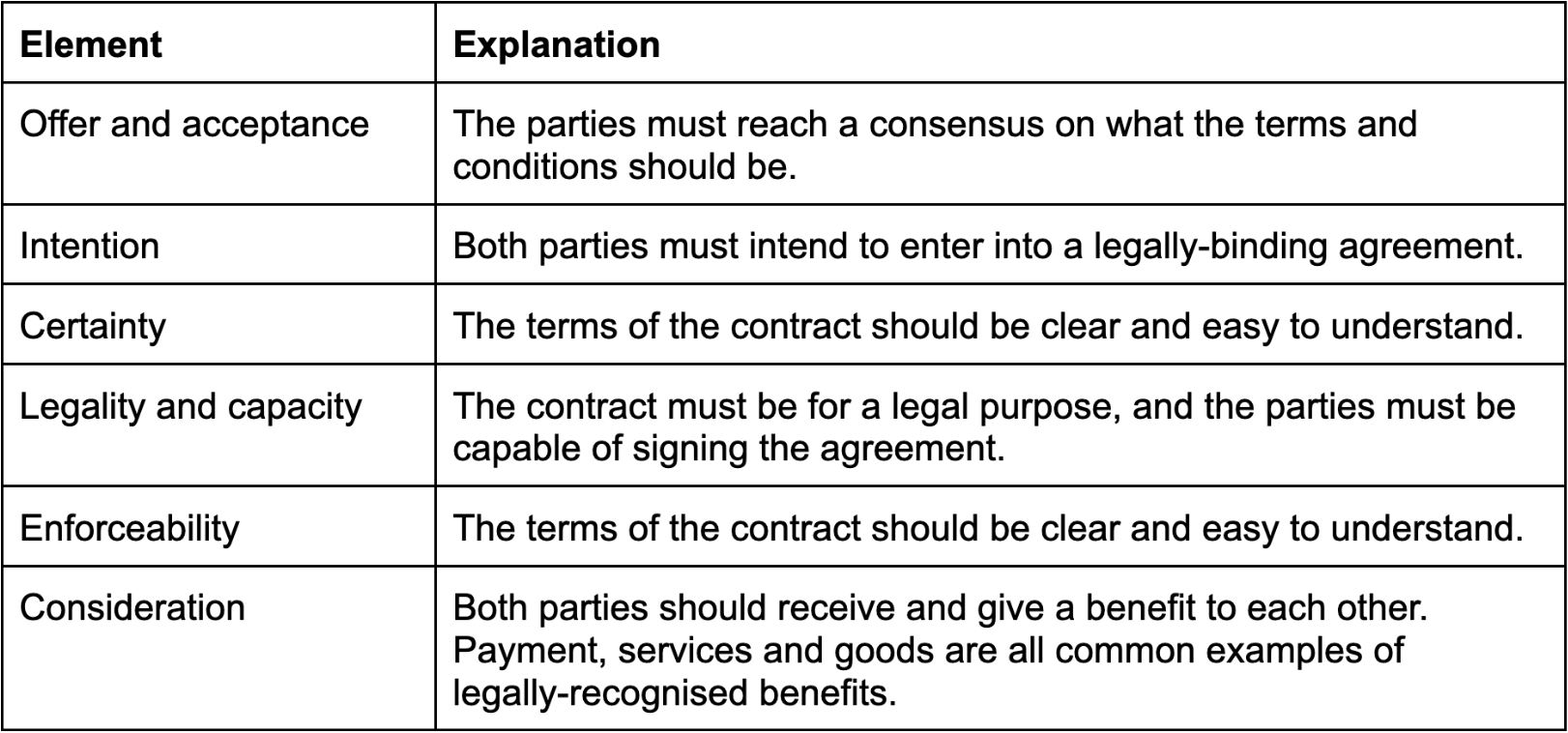
Example of a valid and enforceable contract
Polly hires Tom to work at her school, promising to pay him $10,000 a month. Three months have passed since the beginning of this work contract, and yet Tom has yet to receive a cent, so he files a case against Polly for breaching their contract.
Why Is this Contract enforceable?
- Offer and Acceptance: Polly offered the job and Tom accepted the terms and conditions
- Intention: Both intended to create a legally binding contract
- Legality and Capacity: The contract is for a legal purpose and the parties are legally capable of entering into the contract
- Consideration: Tom provides work and Polly promises payment of $10,000 per month
- Certainty: The terms and conditions are clear and certain
Tom performed his obligations while Polly failed to pay for the services. Hence, Tom can legally enforce the contract and seek remedies for breach of contract.
Example of an Unenforceable Agreement
Alex agrees to sell his paintings to Benjamin, and they both agree to come up with the purchase price and date of delivery later. Later, Alex changes his mind. “But we had an agreement!” Benjamin protests, and similarly brings the case to the court.
Why is this Agreement Unenforceable?
This contract is unenforceable because the essential terms like price and delivery were never agreed by the parties. The contract lacks certainty and will not be enforceable.
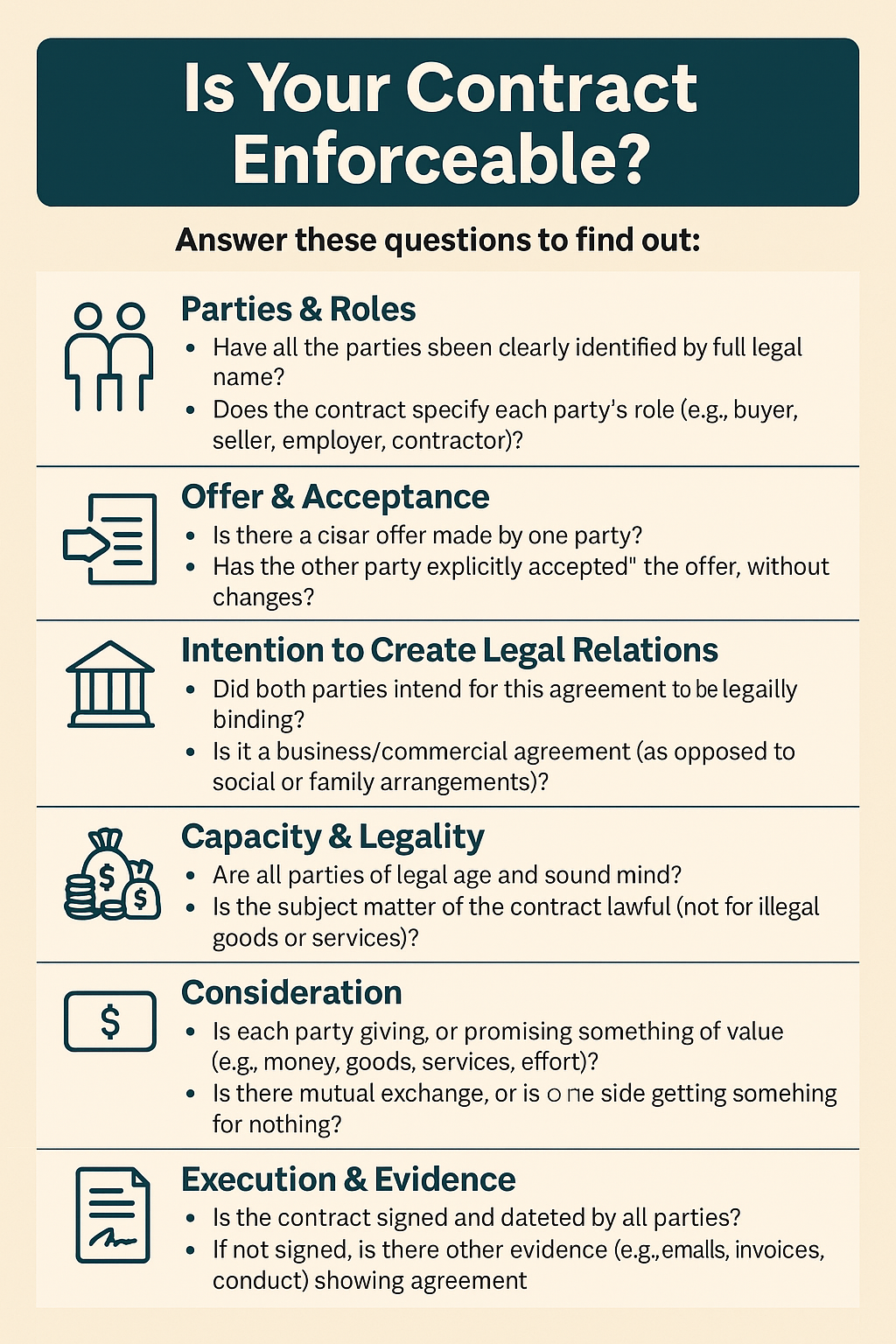
Benefits of an Enforceable Contract
There are multiple benefits to having your contract be enforceable in court.
- Safeguards your legal rights. You will only be able to sue in a court of law, or get compensation for a breached contract, if the contract itself is enforceable.
- it provides a useful set of guidelines for both parties’ decisions and actions. After all, a contract is a list of requirements and obligations. By having everything spelled out clearly, you minimise the chance for misunderstandings, so that everyone can work within their assigned role more efficiently.
Contract Review Checklist: Ask these Questions before You Sign A Contract:
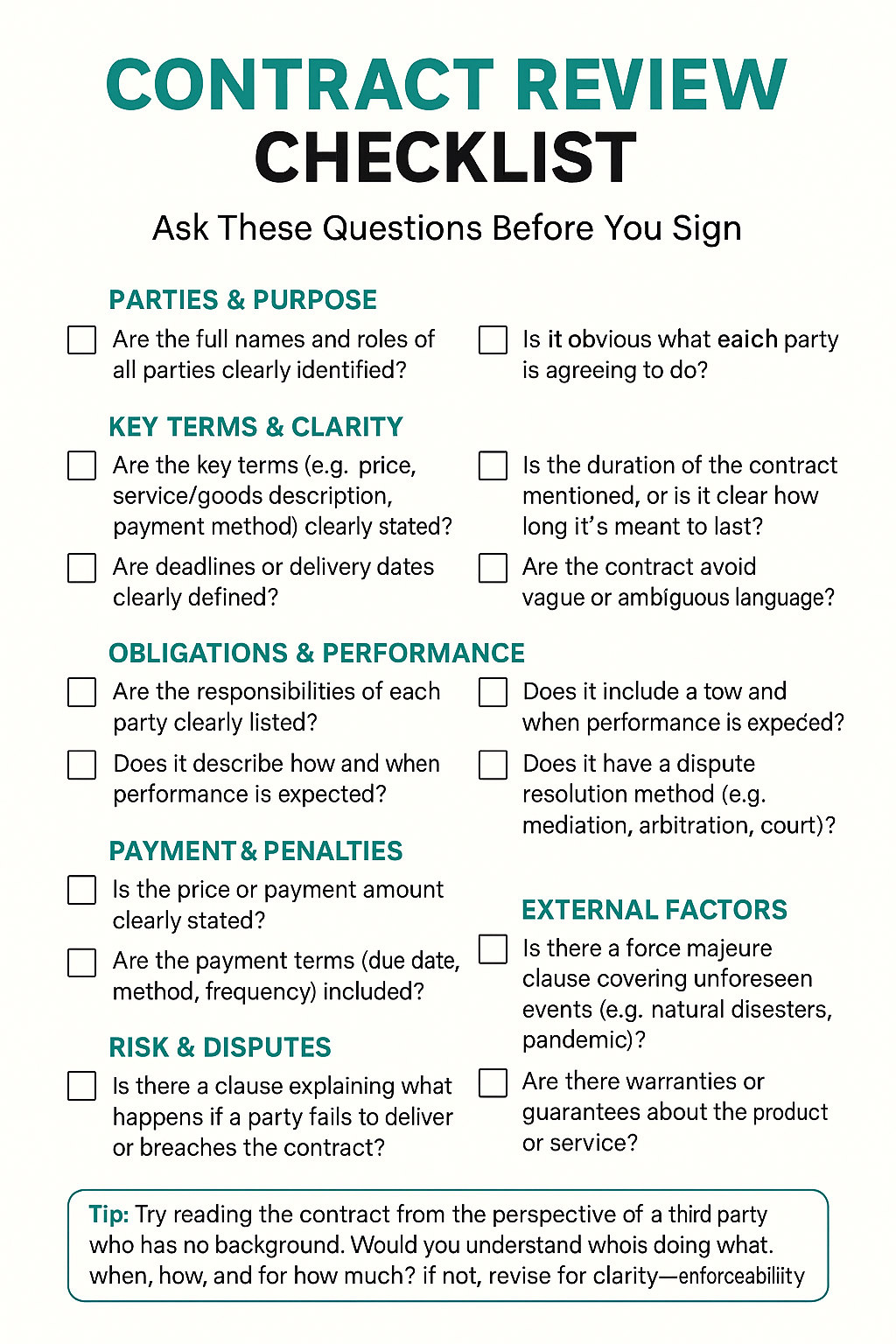
- Duration: Clearly state the term of the contract
This is the length of your contract. Some contracts (e.g.: sale of goods) will be a one-off exchange on a specific date. If your contract lasts for a stipulated duration, you should clearly write down the period, as well as the start and end dates.
- Example: If you’re writing an employment contract, you should clearly state the start and end times. If there are breaks, including a lunch break, you should state their lengths.
- Price: The price amount, or the mechanism for determining the price (e.g.: based on market conditions at a specified later time, which is common for contracts between manufacturers) should be listed out.
- Payment Terms: You should write out the specified payment date or deadline, whichever is applicable. You can also add requirements for how it should be paid (e.g.: bank transfer, cash, cheque). If the payment is in installments, you will need to specify how frequent the payments are.
- Penalties for Late Payment: To ensure the parties comply, you may impose penalties. I.e.: if A fails to make payments to B on time, B might have the right to withhold services. Or, they might be able to impose a late fee, increase the interest rate, or withdraw from the contract entirely. In contracts involving large transactions, B might be able to rely on A’s mortgage, if they fail to pay their dues. Adding such a clause is completely up to the parties, as long as they agree on the penalties and what situations would incur them.
- Obligations of the parties: These are the essential terms of the contract. You should describe the actions or services that are being rendered, or the goods that are being exchanged. Clearly describe what each party will be doing with enough detail (e.g.: the Vendor agrees to develop a custom software programme for the Company’s accounting activities, which shall contain the following features …)
- Detailed Timeframes: To better guide the process, there should be clear deadlines for performance, delivery, and completion. There could also be a hardship clause where party A can seek an extension of the deadline, after giving a set number of days’ notice.
- Warranties and Representations: These are promises about the condition of the goods or services. A seller might warrant that the goods are of merchantable quality, or suited for the purpose that the buyer wants them for. The same buyer might also represent (i.e.: declare) that the goods were made according to certain specifications, or handcrafted, or manufactured in a certain year.
- Force Majeure Clause: This is a clause detailing what will happen in the case of an unexpected event that majorly affects the performance of the contract. Imagine, for example, that company A purchases one million machinery parts from B, and immediately afterwards, the global price of iron unexpectedly surges. This might require significant changes to the contract, such as a complete recalibration of the purchase price, and modifying the performance deadline. As such, a force majeure clause will protect the rights of the parties in the case of a legitimate unforeseeable event, and prevent them from incurring penalties.
Final Thoughts
Still unsure about the contract drafting process? You can always start working from a template, and modify it as you go. DocLegal.AI creates customized legal documents in just a few clicks.
This includes tailor-made business agreements, general employment contracts, sales contracts, non-disclosure agreements, and more! Sign up now to enjoy 50% off your first subscription, and learn how you can simplify your day-to-day commercial and legal tasks.

Top 3 Most Common AI Contract Customizations: ChatGPT vs. DocLegal.ai
Compare AI contract tools: ChatGPT needs legal know-how; DocLegal.ai offers lawyer-trained, customizable templates for $1.

Top 3 Most Common AI Contract Customizations: ChatGPT vs. DocLegal.ai (We Tested Both)
As a legal professional, I use ChatGPT every day for brainstorming. But using it to generate binding contracts is a different story.
So, I ran an experiment.
First, I asked ChatGPT: "What are the top 3 most common contract customizations requested by users?"
It gave me this list:
- Payment Terms
- Termination Clause
- Limitation of Liability Clause
Then, I put both AIs to the test. I asked ChatGPT to write these clauses for a standard Consulting Agreement, and compared the results against a $1 DocLegal.ai template.
Here is exactly what happened.
The Verdict : General AI vs. Legal AI
If you are asking 'Is ChatGPT safe for contracts?', here is the summary of our findings:
| Contract Feature | ChatGPT (General AI) | DocLegal.ai (Legal AI) |
|---|---|---|
| Payment Terms | High Risk. Vague interest clauses; no protection for collection costs. | Secure. Includes specific interest rates, expense reimbursement, and debt recovery costs. |
| 2. Termination | Basic. Lets you quit, but doesn't protect your IP or payment upon exit. | Comprehensive. Covers insolvency, "for cause" firing, and immediate IP return. |
| 3. Limitation of Liability | Aggressive 3-month cap that clients will reject. Limits liability for data breaches | Uses market-standard caps that get signed faster while protecting secrets. |
Test 1 - Payment Terms
We asked for a monthly payment clause for a $100/hr consultant
| ChatGPT Result | DocLegal.ai Result |
|---|---|
| "Invoices shall be issued monthly. Payment is due within 14 days. Late payments may incur interest of 1.5%." | “1. Monthly Payment Clause for Consultant at $100/hr**In consideration of the services provided by the Consultant, Jane Smith, under this Agreement, the Client, XYZ Tech Solutions Ltd., agrees to compensate the Consultant at a rate of $100 per hour. The Consultant shall submit detailed monthly invoices to the Client, specifying the hours worked and a description of the services rendered during the billing period. The Client agrees to remit payment for the invoiced amount within thirty (30) days of receipt of the invoice.The Consultant must maintain accurate and detailed records of the hours worked and services performed, which shall be made available to the Client upon request. Any expenses incurred by the Consultant exceeding $500 must receive prior written approval from the Client to qualify for reimbursement. Payment shall be made via [specify payment method, e.g., bank transfer, check, etc.], and any disputes regarding invoiced amounts must be raised by the Client within ten (10) business days of receipt of the invoice.Failure to remit payment within the specified timeframe may result in the accrual of interest at a rate of [specify interest rate, if applicable] per month on the outstanding balance, beginning from the due date until payment is received in full.” |
Analysis for the Payment Terms:
| ChatGPT | DocLegal.ai |
|---|---|
| "May incur" is a weak language. A client can argue they don't have to pay interest because it wasn't mandatory. Lacks details on invoicing structure, doesn’t include provisions for handling of expenses, commissions, caps. | Includes an Expense Reimbursement Policy. Strict Dispute Resolution — enforces a 10-day objection window; if the client doesn't complain in 10 days, they must pay. Mandates Timesheet Compliance — legally requires "detailed records" and timesheets, preventing payment arguments before they happen. |
Key takeaway of Test 1:
ChatGPT gives you a starting point for the payment provisions, however, you will need to provide further details to ensure it protects your interest as a client or consultant.
Test 2 - Termination Clause
We asked for a mutual termination clause between the client and consultant
| ChatGPT Result | DocLegal.ai Result |
|---|---|
|
Either party may terminate this Agreement with [e.g., 14] days' written notice. Upon termination: Consultant shall stop work immediately. Client shall pay Consultant for all services performed up to the termination date. |
The Client, XYZ Tech Solutions Ltd., and the Consultant, Jane Smith, may mutually agree to terminate this Agreement at any time by providing written notice to the other party. Upon mutual termination, the Consultant shall cease all work immediately, vacate the work site, and return all materials, documents, and property belonging to the Client. The Client shall compensate the Consultant for all work completed up to the date of termination, as agreed upon by both parties. Both parties agree to release each other from any further obligations under this Agreement, except for those provisions that expressly survive termination, including but not limited to confidentiality, intellectual property, and indemnification obligations. |
Analysis for Termination Clause:
| Key Issue | ChatGPT (General AI) | DocLegal (Legal AI) |
|---|---|---|
| Company Property | Silent on returning assets. The clause ends the work but does not legally require the consultant to return your documents, data, or equipment upon departure. | Mandates return of materials. Explicitly requires the consultant to vacate the premises and return all materials, documents, and property immediately. |
| Post-Contract Protection | Protection ends with the contract. Once the agreement is terminated, the specific rules regarding confidentiality and IP often expire because there is no "Survival Clause." | Continues protection indefinitely. Includes a "Survival Clause," ensuring that confidentiality, IP rights, and indemnification remain legally binding even after the work stops. |
| Finality of the Deal | Leaves loose ends. It addresses final payment but does not prevent future claims. The consultant could potentially return later with further demands. | Ensures a clean break. Includes a "release of obligations," meaning both parties agree that the relationship is fully concluded, preventing future disputes or lingering liabilities. |
Key Takeaway for Test 2:
ChatGPTmisses critical post-termination safeguards like the return of company property and ongoing confidentiality rules leaving you to manually close these loopholes to protect your business assets.
Test 3: Limitation of Liability Clause
We asked both platforms to protect the Consultant from lawsuits.
| ChatGPT Result | DocLegal.ai Result |
|---|---|
|
“Limitation of Liability: 1. Limitation of Damages. To the fullest extent permitted by applicable law, the Consultant shall not be liable to the Client for any indirect, incidental, consequential, special, exemplary, or punitive damages, including but not limited to lost profits, loss of business, loss of data, or business interruption, arising out of or related to this Agreement, even if advised of the possibility of such damages. 2. Cap on Liability. The Consultant’s total aggregate liability for any and all claims, losses, or damages arising out of or relating to this Agreement—whether in contract, tort, negligence, strict liability, or otherwise—shall be limited to the total fees actually paid by the Client to the Consultant under this Agreement during the three (3) months preceding the event giving rise to the claim. 3. Reliance on Client Information. The Consultant shall not be liable for any damages, losses, or claims resulting from the Consultant’s reliance on information, data, materials, or instructions provided by the Client or any third party on the Client’s behalf. 4. No Liability for Third-Party Actions. The Consultant shall have no liability for any acts, omissions, or performance failures of third parties, including subcontractors, vendors, or service providers not under the Consultant’s direct control. 5. Exceptions. Nothing in this Agreement shall limit the Consultant’s liability for fraud, willful misconduct, or any liability that cannot legally be limited or excluded under applicable law. |
1A. Limitation of Liability Clause** The Consultant, Jane Smith, shall not be liable to the Client, XYZ Tech Solutions Ltd., or any third party for any indirect, incidental, consequential, special, or punitive damages, including but not limited to loss of profits, revenue, data, or business opportunities, arising out of or related to this Service Agreement, even if the Consultant has been advised of the possibility of such damages. The Consultant’s total aggregate liability for any claims, damages, or losses arising out of or related to this Agreement, whether in contract, tort (including negligence), or otherwise, shall not exceed the total compensation paid to the Consultant under this Agreement. This limitation of liability shall not apply to damages resulting from the Consultant’s gross negligence, willful misconduct, or breach of confidentiality obligations as outlined in this Agreement. |
Analysis for Liability Clause
| Feature | ChatGPT (General AI) | DocLegal (Legal AI) |
|---|---|---|
| Negotiation Risk | Less Likely to close the deal. The "3-month cap" is so aggressive that clients will likely redline the contract or walk away. | Likely to close the deal. Uses "Market Standard" terms (Total Fee cap) that clients are used to signing without argument. |
| Data Security | Unrealistic. Caps your liability if you leak their data. Clients rarely agree to this risk. | Professional. Accepts responsibility for Breach of Confidentiality, which is essential for winning trust with high-value clients. |
| The Strategy | Protect at all costs. Good for a fight, bad for a partnership. | Commercial Balance. Protects you from bankruptcy but keeps the contract fair enough to sign immediately. |
Key Takeaway for Liability Clause
ChatGPT is acting like a robotic lawyer that tries to win every single point. Doclegal.ai ensure the contract gets signed as the clause language is the industry standard balance.It shows you understand professional norms, making you look like a serious partner, not a risky freelancer.
Conclusion: Is "General AI" Worth the Risk?
I use ChatGPT every day to outline ideas. But for legal documents, "free" comes with a hidden cost: Risk.
- ChatGPT: Fast to generate text, but misses critical protections like debt recovery costs. You save $1 but risk losing the client or your IP.
- DocLegal.ai: Takes 2 minutes. You select the template, the AI pulls your profile, and the legal logic is balanced to get your contract signed today.
Free Consulting Agreement on Doclegal.ai
Free NDA Negotiation Playbook

How DocLegal.AI Keeps Your Data Secure
Advanced encryption, secure cloud storage, and strict access controls keep your data safe with zero retention by third-party LLMs.

How DocLegal.AI Keeps Your Data Secure
At DocLegal.AI, we understand that the security of your data is paramount. As such, we employ industry-standard measures to protect your data. Here’s an overview of our data security practices, including how we handle data retention, storage, and ongoing monitoring.
GenAI Use and Commitment to Data Privacy and Security
- Separation of Data: We keep our documents and customer database separate from third-party LLMs used, ensuring that customer data is protected.
- User Privacy: Your data is stored in a secure cloud database, segregated by user accounts. This guarantees that private and confidential information remains exclusive to you.
- No Data Usage for Training: We do not use private and confidential information including user conversations to train third-party LLMs.
- Transparency: We encourage users to review our Privacy Policy and Terms of Service to understand how your information is collected, used, and stored.
Data Retention by Third-Party LLMs
Third-party LLMs used at DocLegal.AI adopt a zero data retention policy, where personal data from API requests are not retained.
Data Storage and Processing
Your data is securely stored in a cloud-based SQL database designed for high security and reliability. Additionally, we use a specialized vector database for efficient document searching. This dual-layer approach ensures that your data remains both accessible and secure.
Trusted Collaborations
We partner with highly secure and certified service providers who meet rigorous industry standards, ensuring your data is handled with the utmost care.
Database Security Measures
We implement several safeguards to protect our databases from unauthorized access, including:
- IP Blocking: Restricting access to recognized IP addresses.
- Access Controls: Utilizing a Relational Database Management System (RDBMS) for managing permissions.
- Secure Credential Storage: Keeping sensitive information encrypted and secure.
Proactive Vulnerability Monitoring
We actively monitor our systems for vulnerabilities using advanced tools to identify and mitigate risks, ensuring continuous operational integrity.
Encryption Standards
To protect your data, we implement strict encryption standards:
- Data in Transit: All communications are secured using HTTPS protocols.
- Password Security: Customer account passwords are encrypted, making them inaccessible to unauthorized users.
Third-Party Integration Compliance
We strive to ensure that third-party integrations comply with our security protocols for data transfer. Compliance largely depends on the policies of the third-party services we utilize.
Authentication
For your protection, our policy regarding account lockouts is straightforward: after three failed login attempts, you will be prompted to "try again later." This measure helps prevent unauthorized access.

What If Your Next Contract Cost Only $1?
Learn how DocLegal.ai’s AI legal tools generate startup contracts for $1, saving thousands on NDAs, shareholder agreements, and more with lawyer-approved templates.
What If Your Next Contract Cost Only $1?
Starting a new business or scaling your existing one, contracts are the bread and butter of your operations. But this essential foundation requires a considerable budget.
What Legal Documents Does A Startup Need?
With 10 years of experience in drafting contracts for startups and growing companies, I know the drill . My clients when starting a business often request bundles comprising of:
- Non-Disclosure Agreement
- Licensing Agreement
- Shareholder Agreement,
- Employment contracts, and
- HR Policy Manual
The cost for such a starter pack for legal templates can exceed $1000 - $2500+depending on the complexity in customization and negotiation support requested. With the advent of AI, clients are now using AI legal generators for these templates
How Much Can You Save with an AI Legal Generator?
Legal AI Tools can now generate this starter pack and customize based on your requirements at 1$ per document only!
Let me show you how this stacks up in numbers:

That’s less than the cost of your weekly coffee budget, and this takes 5 minutes and no back and forth exchange of emails with a lawyer.
Which is the Best AI Legal Generator?
While there are many legal AI tools in the market, I highly recommend DocLegal.ai as this platform is trained on templates approved by lawyers and is not just another generic AI tool.
What is Doclegal.ai? How does it work?
Doclegal.ai is the only AI Legal Tool For Small Business.
No Legal experience needed
AI Legal Tools are revolutionizing access to legal templates without compromising on quality.
But here’s the catch: Most of the AI legal tools online target legal professionals, not business owners.
Doclegal.ai is changing this. Doclegal.ai is an AI legal tool for small business. This AI Legal generator is designed for entrepreneurs, small business owners and no legal background is required. With plain language prompts, anyone can generate legal templates AI within minutes for less than the price of coffee! Watch out tutorial on how to generate documents within the DocLegal.AI.
Here’s what you get with DocLegal.ai:
- Access to Contract library of 2800+ legal templates.
Doclegal.ai, AI legal generator, gives you instant access to an extensive library of contract templates. Type the name of the contract you need and it will generate a lawyer approved template for you

- AI Customization
AI customizes these templates based on your plain language prompt.
Example: Just ask AI to:
- include a late payment penalty clause,
- add early termination fees payable by party A, and
- make the one-sided indemnity clause mutual”
Doclegal.ai Chatbot will insert the language automatically in the template and your template will be ready for your client’s review and signature within minutes.
- Instant Download in Word/PDF Form
Download and Ready to send or sign
- AI Contract Review
Upload your contracts for AI Contract Review. It will do an instant risk analysis, replace party names where needed, provide clause languages based on your prompt, and let you edit the document - all in one place. This is your 24/7 paralegal on demand
DocLegal.ai is your 24/7 assistant on demand!
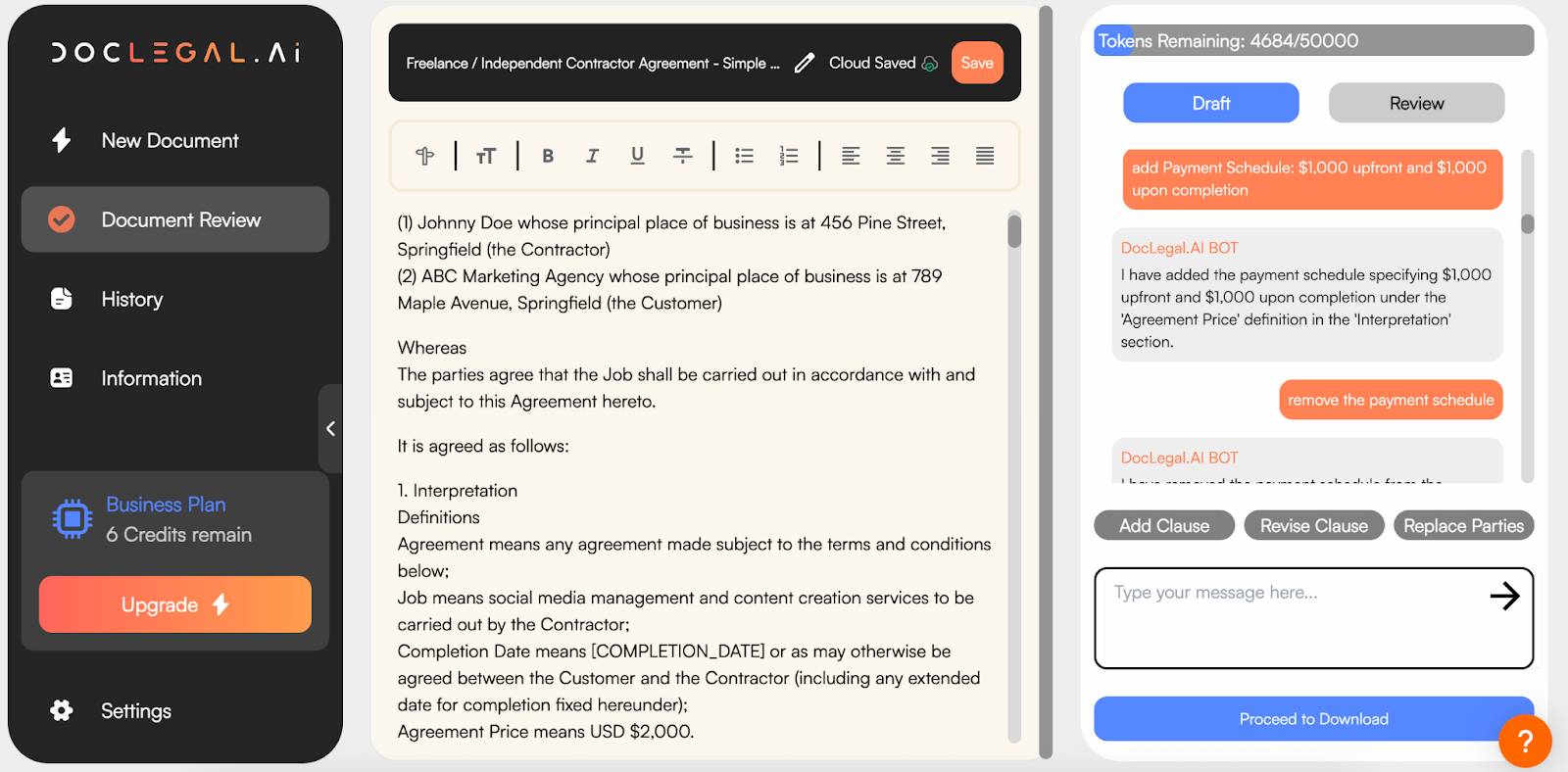
Are AI Generated Legal Templates Reliable?
Yes, when created by trusted platforms like DocLegal.ai, AI-generated legal templates can be highly reliable. DocLegal.ai's chatbot is trained using templates developed and reviewed by legal professionals, ensuring accuracy and practical usability.
ChatGPT is Free, are AI Generated Legal Templates by ChatGPT reliable?
ChatGPT can help speed up your daily tasks and provide a basic contract template. However, these templates are not contract-ready and require significant legal edits before use.
While ChatGPT can give lawyers a useful starting point, the drafts are not suitable for immediate use or signing by business owners.
We have compared DocLegal.ai with other AI tools. Doclegal.ai is AI for legal documents and the templates are ready for immediate use. It is easy to use and does not require any legal expertise from the user.
What do customers say about DocLegal.ai?
DocLegal rocks.
“It took my document and really made it real. It was so fast I am amazed. Thanks guys.”
— JuliusSchenck
“Safe buy.”
“I bought the program and I’ve kicked the tires on it a bit, and it really is a solid program. At least for quick drawn up deals.”
— algivens74
Ready to Save on Your Next Contract?
Try DocLegal.ai today and experience affordable, fast, and reliable legal document generation.

NDAs for Freelancers: Protecting Your Ideas in the Gig Economy
Master NDAs to protect your freelance ideas in the gig economy. Learn essential components and use DocLegal.AI for affordable, tailored agreements.
NDAs for Freelancers: Protecting Your Ideas in the Gig Economy
As a freelancer, your creativity is your currency. Whether you're a consultant pitching a campaign, a designer crafting a brand’s identity, or a writer shaping a startup’s narrative, your ideas deserve protection. A Non-Disclosure Agreement (NDA) safeguards your intellectual property and ensures clients respect your ideas. This guide explains why NDAs are vital for freelancers, their key components, and how to create one yourself.
What Is an NDA and Why Do Freelancers Need One?
An NDA is a legal contract that prevents a client from sharing your confidential information without permission. In the gig economy, where freelancers collaborate with startups, brands, or other creatives, NDAs are essential to protect shared ideas. For example, an online influencer pitching a unique social media campaign risks idea theft without an NDA. By securing one, they can pitch confidently, knowing their concept is protected. DocLegal.AI’s AI legal document generator simplifies the process, letting you create tailored NDAs without needing a law degree or a big budget.
Which Freelancers Might Want an NDA
Freelancers in various fields should consider using an NDA to protect their creative and intellectual work. Here are key fields where an NDA is particularly valuable:
- Design: Graphic designers, UX/UI designers, or product designers often share original mockups, prototypes, or branding concepts that need protection from unauthorised use or sharing.
- Content Creation: Writers and videographers writing scripts, creating social media campaigns or blog strategies risk clients repurposing their ideas without credit or payment.
- Marketing and Advertising: Freelancers pitching unique campaign ideas, marketing strategies, or advertisement ideas need NDAs to prevent clients from implementing these without payment.
- Technology and Development: Software developers, app creators, or IT consultants pitching tech solutions require NDAs to safeguard proprietary work.
- Consulting: Business strategists, financial consultants, or startup advisors sharing innovative plans or trade secrets need NDAs to ensure confidentiality.
- Creative Arts: Photographers, illustrators, or musicians sharing unreleased work, such as photoshoot concepts or original compositions, benefit from NDAs to maintain creative control.
Key Components of a Freelancer NDA
A well-crafted NDA protects your work while maintaining a professional client relationship. Here are the essential elements every freelancer NDA should include.
1. Definition of Confidential Information
Clearly define what qualifies as “confidential” to ensure both parties understand what’s protected.
- What to include: Specify information types, such as campaign concepts, design mockups, or business strategies. Be clear but broad to cover all important material.
2. Duration of Confidentiality
Specify how long the confidentiality obligation lasts, tailored to your project and industry norms.
- What to include: Common durations are one to five years post-project, though sometimes trade secrets may require indefinite protection. For example, a photographer’s NDA might require his client to keep a photoshoot concept confidential for two years, so that he may reuse the idea for other projects without competition.
3. Exceptions to Confidentiality
Some information isn’t protected, such as publicly available data or previously shared ideas.
- What to include: List exceptions, e.g., information already known to the client, publicly available, or legally required to be shared.
4. Remedies for Breach
Stipulate consequences for NDA violations, including breaches by the client’s affiliates, to ensure accountability.
- What to include: Specify that breaches, including those by affiliates (e.g., subcontractors or employees), may lead to damages for lost opportunities or an injunction to stop misuse. Holding clients liable for affiliates’ breaches strengthens protection.
Why NDAs Are Critical for Young Creatives
For millennials and Gen Z freelancers, the gig economy offers opportunities but also risks. Every pitch you make is built on trust. An NDA helps make that trust mutual, not just assumed. Without an NDA, you’re vulnerable to idea theft, which can harm your reputation and income. An NDA levels the playing field, letting you collaborate confidently while protecting your creative work.
Practical Tips for Using NDAs Effectively
- Discuss NDAs early: Raise the topic before sharing your proprietary ideas to set clear expectations and demonstrate professionalism.
- Customise for each project: Tailor your NDA to specific clients or gigs for relevance. The same information might be sensitive for one project, not the other.
- Keep records: Store signed NDAs securely and track shared information.
- Combine with contracts: Pair your NDA with a broader freelance agreement covering payment, scope, and other terms.
Real-World Example: Protecting Your Pitch
Imagine Alex, a 28-year-old influencer, pitching a video series to a tech startup with unique hashtags and content ideas. Without an NDA, the startup could use Alex’s concept internally or share it with another influencer. By using an NDA, Alex defines the pitch as confidential and restricts its use to the agreed project. If the startup shares it with a competitor, Alex can sue for damages, protecting his work and reputation.
FAQ: NDAs for Freelancers
1. Are there different types of NDAs?
Yes, NDAs can vary based on purpose and scope. Common types include unilateral NDAs (one party shares confidential information), bilateral NDAs (both parties share sensitive information), and multilateral NDAs (multiple parties are involved). Freelancers typically use unilateral NDAs to protect their ideas when pitching or collaborating with clients.
2. When should I ask a client to sign an NDA?
You should discuss and have an NDA signed before sharing sensitive information, such as during the pitching phase or at the start of a project. This sets clear expectations and protects your ideas from being misused.
3. Can I use the same NDA for every freelance project?
While a template is a good starting point, it’s best to customise your NDA for each project or client to address specific needs, such as the type of confidential information or project duration, to ensure maximum protection.
4. What happens if a client breaches an NDA?
If a client violates an NDA, you may seek remedies like financial damages for lost opportunities or an injunction to stop further misuse. The NDA should outline these consequences, including liability for breaches by the client’s affiliates.
5. How can DocLegal.AI help me create an NDA?
DocLegal.AI offers an AI-powered tool to generate tailored NDAs quickly and affordably, without requiring legal expertise. It helps freelancers create professional contracts to protect their ideas and focus on their work.
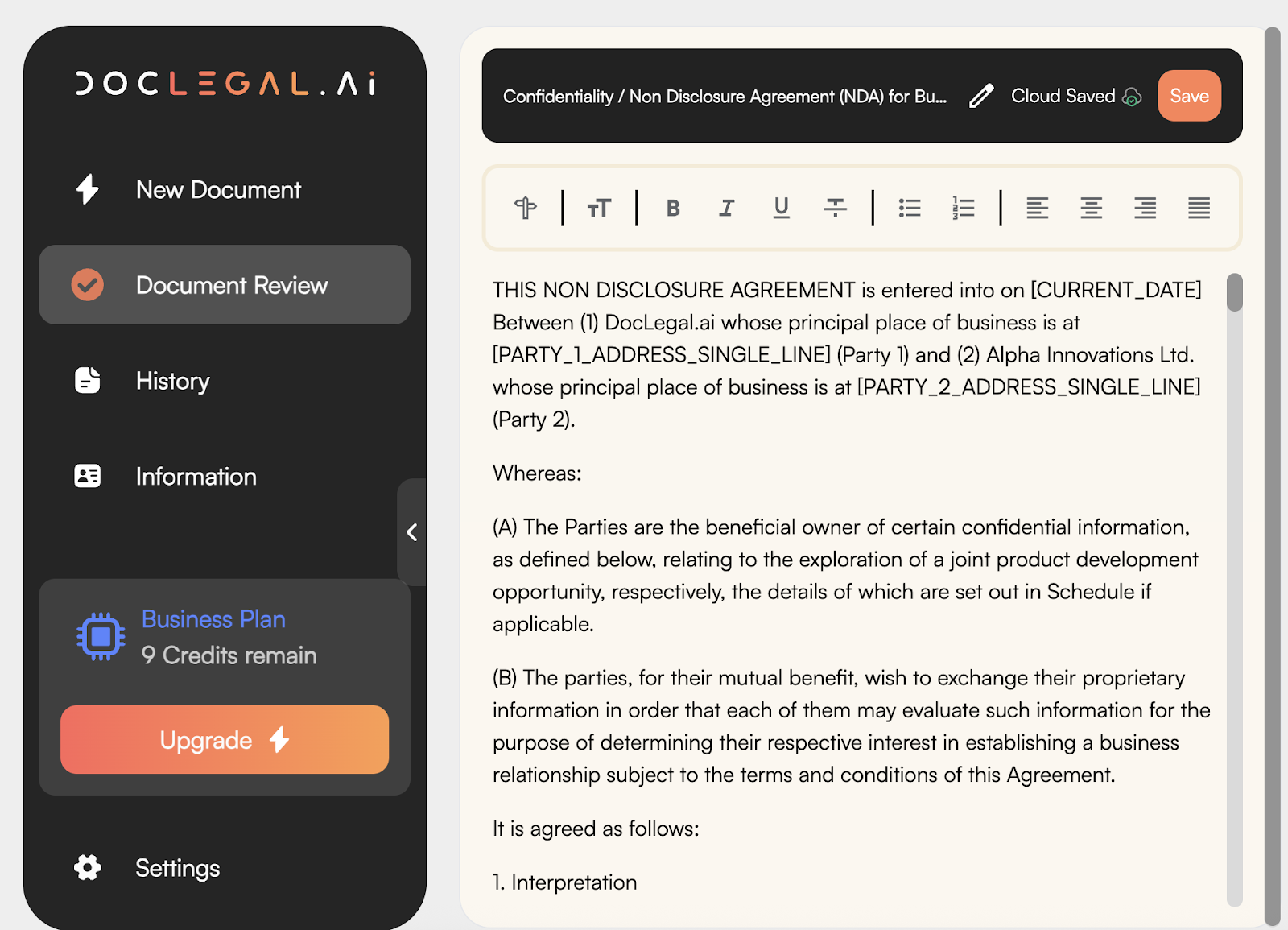
Get Started with DocLegal.AI Today
In the fast-paced gig economy, your ideas are your greatest asset. An NDA ensures they remain yours, empowering you to collaborate with confidence. DocLegal.AI makes creating professional, tailored NDAs affordable, helping young creatives protect their work and focus on building their brand. Visit us now to generate your first contract and start protecting your freelance business with confidence!

How to Draft Freelancer Contracts for Gig Economy Workers
Master drafting freelancer contracts for gig economy workers with AI tools. Protect your work, secure payments, and avoid disputes with clear, legally sound agreements.
How to Draft Freelancer Contracts for Gig Economy Workers
The gig economy is booming, but with freedom comes the risks. Whether you are designing social media content, writing copy, or developing websites. As a one-man band you are designing social media content, writing copy, or developing websites. All these tasks are being done without a full legal team’s support. Hence, a well-crafted freelancer contract can be your safety net. A lawyer approved freelancer contract will offer you legal protection without the scary lawyer fees. In this guide, we’ll walk you through how to prepare a comprehensive freelancer contract.
Why Freelancers Need Freelancer Contracts
Imagine this: You just landed a gig creating logos for a startup on some forum. After countless hours of hard work, you send over your work, but then the client ghosts you when it’s time to pay. Or worse, they start using your designs in ways you never agreed to. These gig economy legal issues are all too common, but a solid contract can definitely prevent them.
A freelancer contract isn’t just a formality, it’s a legal tool that sets clear expectations for both you and your client. It outlines what you’ll do, when they’ll pay, and who owns the work. If you are a young entrepreneur or someone who has just started their side hustle, creating contracts with AI tools like DocLegal.AI ensures your contracts are professional, legally enforceable, and tailored to your needs, without the hefty price tag of a lawyer.
What contracts do you need?
Here are the most commonly used freelancer contracts on our platform:
- For writing-related roles, e.g., copywriting, blog & article writing, email marketing, social media content, academic writing, etc, our Freelance Writer Agreement is tailored to meet your needs.
- For creative and technical professionals, such as web designers or software developers, we recommend the Web Designing Agreement or the Software Development Agreement to define project scope and deliverables.
- After you have delivered your work, use our Freelance Invoice to bill clients clearly and professionally.
- Want to be more flexible? Try our Independent Contractor Agreement and customise it with just a few prompts to suit any freelance arrangement.
Key Elements of a Freelancer Contract
Let’s dive into the essential components of a freelancer contract. These elements protect your work, define responsibilities, and prevent disputes. DocLegal.AI includes all these at the click of a button, making well-drafted contracts accessible to everyone without prior experience in legal drafting.
1. Scope of Work: Define What You’re Providing
The scope of work is the crux of your contract. It spells out exactly what you’ll provide, so there’s no room for confusion. Be as specific as you can, vague terms often lead to misunderstandings and are a breeding ground for disputes.
- What to include: List deliverables (e.g., “three one-minute Instagram Reels” or “a 1,000-word blog post”), deadlines, and any specific requirements (e.g., file formats or revisions).
- Example: “The contractor shall complete the Job by the Completion Date, delivering three (3) original blog posts of more than 1,000 words each. Topics, keywords, and tone will be determined and approved by the Customer prior to commencement. Each post must be delivered in Word format, include relevant headings and metadata, and be optimised for SEO as per the Customer's content guidelines. The Contractor shall provide up to three rounds of revisions per article within five business days of each draft submission, addressing specific feedback provided by the Customer.”
2. Payment Terms: Get Paid Fully and On Time
Money is a top concern for freelancers, and clear payment terms are non-negotiable. A payment clause should outline how much you’ll be paid, when, and how.
- What to include:
- Total fee or hourly rate.
- Payment schedule (e.g., 50% upfront, 50% upon completion).
- Payment method (e.g., PayPal, bank transfer).
- Late payment penalties (e.g., 5% fee for payments over 30 days late).
- Example: “The Customer shall pay the Agreement Price of USD 200 to the Contractor in two instalments: 50% (USD 100) upon signing this agreement, and 50% (USD 100) upon completion of the Job. Payment shall be made by bank transfer to the account details provided by the Contractor.
The Contractor will invoice the Customer for each instalment. The invoice will include all services performed under this Agreement as well as any expenses, if applicable.
Payment will be due upon receipt of the invoice. A late charge of 5% per month on the outstanding amount will be added to any invoice not paid within 30 days of the invoice date.”
3. Intellectual Property (IP) Rights: Protect Your Creations
As a freelancer, your work is your brand. Intellectual property clauses define ownership rights of your work and how it can be used. This is particularly important for creatives and artists.
- What to include:
- Specify whether you’re transferring ownership of your work or granting a license (e.g., the client can use your work for marketing but can’t resell it).
- Clarify usage rights (e.g., purpose, duration, or specific platforms).
- Optional: include a clause protecting your right to showcase the work in your portfolio.
- Example: “The Designer shall retain all Intellectual Property Rights, including copyright, in any and all works, materials, designs, concepts, and deliverables created in the course of providing the Services under this Agreement.
The Designer hereby grants to the Customer a non-exclusive, non-transferable licence to use the deliverables solely for the purposes expressly set out in this Agreement. The Customer shall not reproduce, modify, adapt, or exploit the deliverables for any other purpose without the prior written consent of the Designer.”
4. Termination Clause: Prepare for the Worst
Sometimes, gigs don’t work out. A termination clause outlines how either party can end the contract and what happens afterwards.
- What to include:
- Conditions for termination (e.g., failure to pay, breach of contract).
- Notice period (e.g., 7 days’ written notice).
- Payment for work completed before termination.
- Example: “Either party may terminate this Agreement by giving the other party not less than seven (7) days' written notice in the event of a material breach of this Agreement by the other party, provided that the breach is not remedied within such notice period.”
5. Confidentiality and Non-Disclosure: Safeguard Sensitive Information
If you’re working with sensitive client information or sharing proprietary ideas, a confidentiality clause is essential for safeguarding both you and your client.
- What to include:
- Define what information is confidential (e.g., client’s marketing plans).
- Specify how long confidentiality lasts (e.g., one year after the project ends).
- Example: “Each party undertakes that it shall not at any time during this Agreement, and for a period of one (1) year after termination or expiry of this Agreement, disclose to any person any confidential information concerning the business, affairs, customers, clients or suppliers of the other party, except as permitted by this clause.”
6. Dispute Resolution: Handle Conflicts Professionally
Disputes happen, but a contract can outline how to resolve them without escalating to costly legal battles.
- What to include:
- Specify a process, like mediation or arbitration, before legal action.
- Indicate which state’s laws apply (if necessary).
- Example: “Any dispute or difference, whether contractual or non-contractual, arising out of or in connection with this contract, including any question regarding its existence, validity or termination, shall be referred to and finally resolved by arbitration under the [Arbitration Rules] in force when the notice of arbitration is received by the other party or parties, which rules are deemed to be incorporated by reference in this clause.”
How DocLegal.AI Simplifies the Process
Drafting a contract from scratch can feel overwhelming, especially if you’re new to the gig economy. That’s where we come in. Our freelance agreement AI takes the guesswork out of creating contracts by:
- Guiding you through customisation: Answer a few guided questions about your project, and the platform generates a tailored contract.
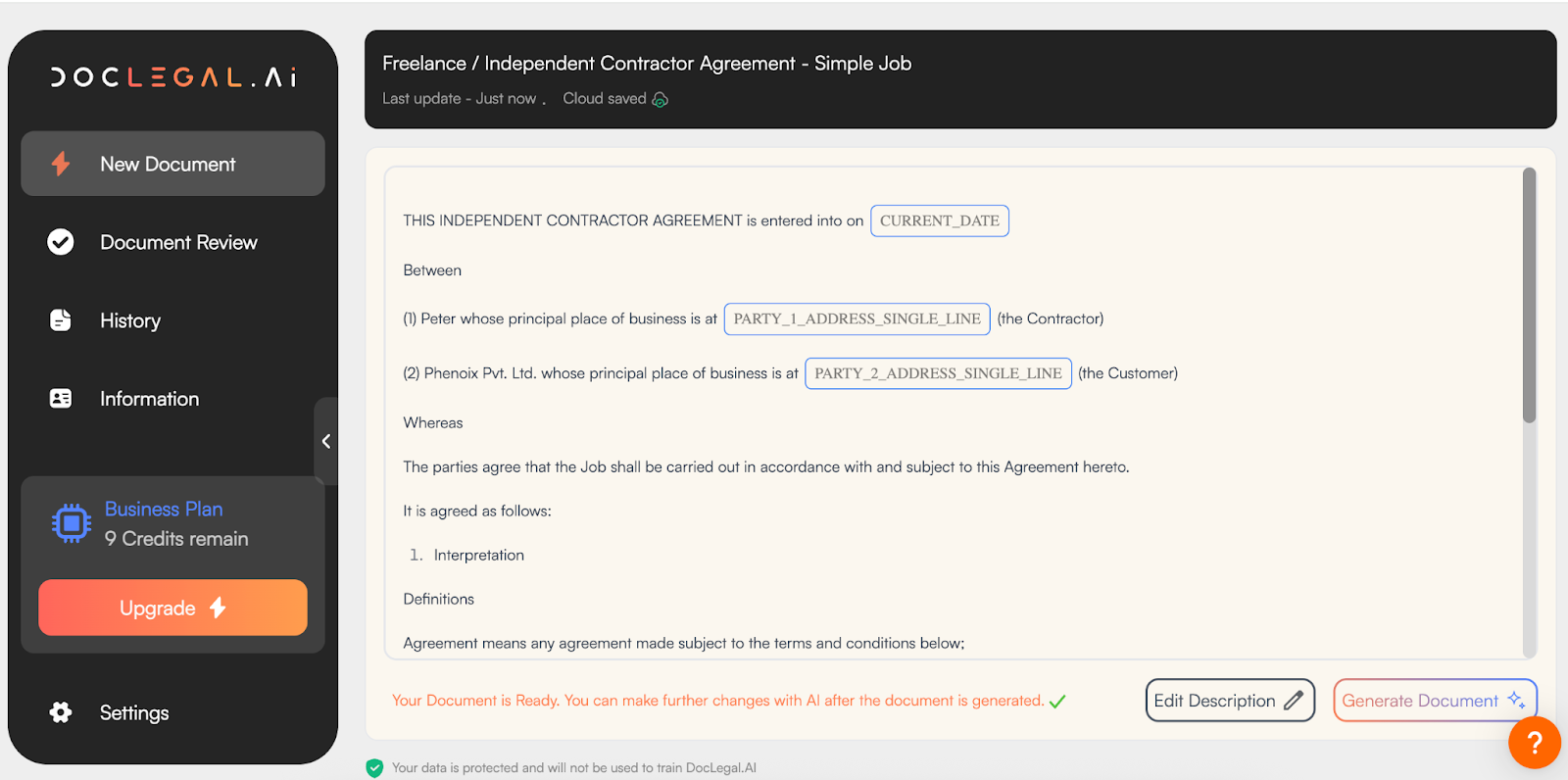
- Avoiding legal traps: Both freelancer-favouring and client-favouring contracts are available. Pick based on your position.
- Review Client Contracts with Doclegal.ai: You can upload the Client Contract on DocLegal.ai and get it AI reviewed, customized and downloaded.
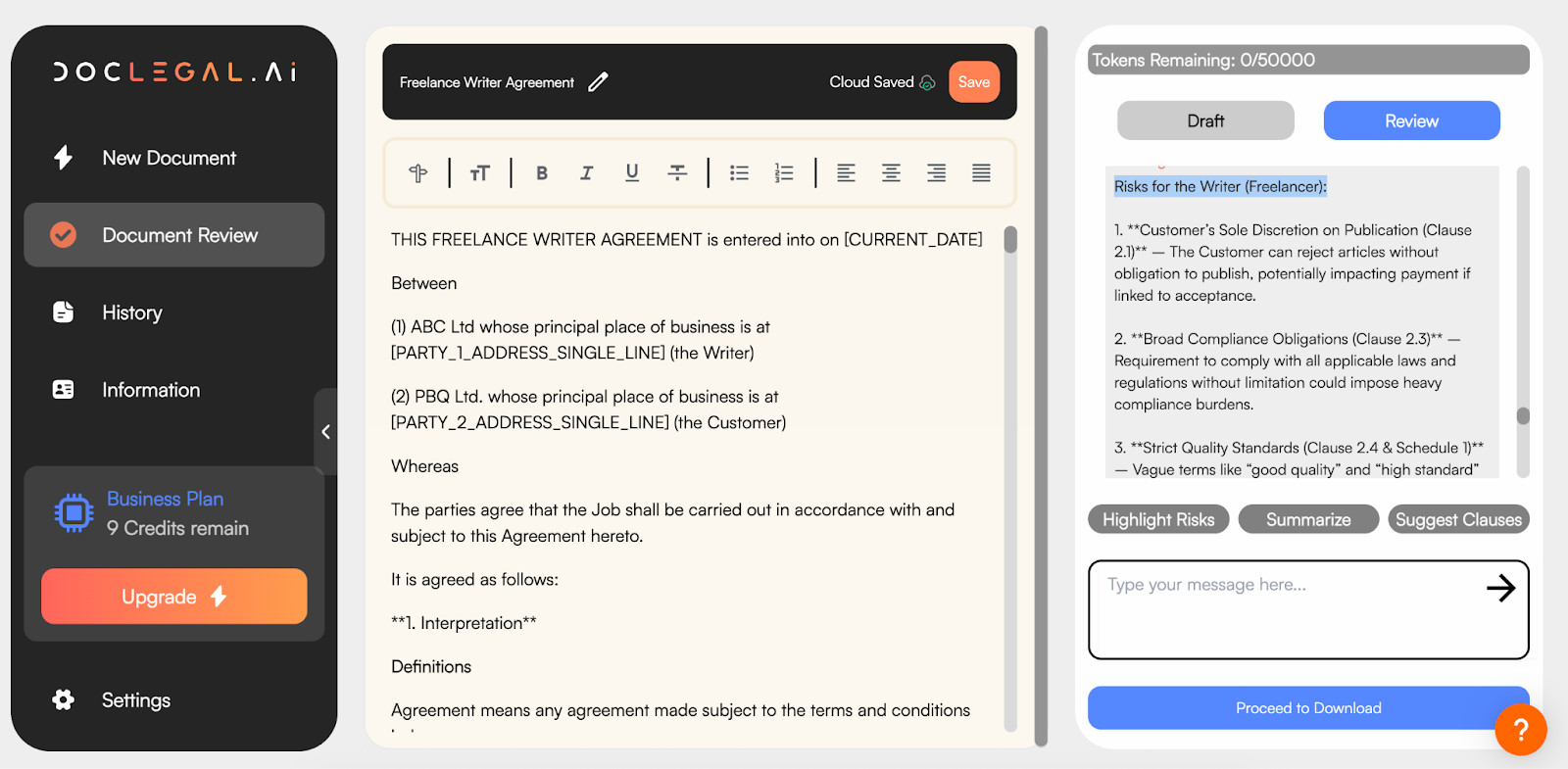
- Saving time and money: Say goodbye to substantial lawyer fees or countless hours researching legal terms.
Tips for Using Contracts Effectively
- Review before signing: Always read the contract carefully to ensure it reflects your true intention. A dispute over a single word is all it takes to start a million-dollar litigation.
- Communicate clearly with clients: Discuss contract terms upfront to avoid surprises.
- Keep records: Store signed contracts securely for reference in case of disputes.
- Update as needed: If your services or rates change, use DocLegal.AI to update your freelancer contract template accordingly.
Get Started with DocLegal.AI Today
Ready to take control of your freelance career? Our freelancer contract template makes it easy to create legally sound agreements in minutes. Whether you’re drafting side hustle contracts for influencer partnerships, design projects, or consulting gigs, we’ve got you covered. Visit us now to generate your first contract and start protecting your freelance business with confidence!

How to Avoid Legal Pitfalls in Influencer Marketing Campaigns
Learn to avoid legal risks in influencer marketing with our 2025 guide. Ensure FTC compliance, clear deliverables, and more with DocLegal.AI’s contract templates!
How to Avoid Legal Pitfalls in Influencer Marketing Campaigns
Influencer marketing is a powerful way to connect with audiences, but it comes with legal complexities. For influencers new to brand partnerships and small-to-medium businesses diving into influencer campaigns, understanding influencer marketing legal risks is essential to avoid costly mistakes.
From FTC influencer compliance to copyright infringement prevention, a well-crafted influencer contract can protect both parties. This guide covers common legal pitfalls, practical compliance tips, and how DocLegal.AI’s influencer contract templates can help you create secure agreements.
Why Influencer Contracts Are Essential
A solid influencer marketing contract clarifies expectations, protects rights, and ensures compliance with laws like paid promotion regulations. Without one, influencers and brands risk disputes over payments, content ownership, or regulatory violations. Verbal agreements or vague terms often lead to misunderstandings, leaving both parties vulnerable. Let’s explore five common legal mistakes and how to avoid influencer legal issues.
Five Common Legal Mistakes in Influencer Campaigns
1. Failing to Disclose Paid Partnerships
The Federal Trade Commission (FTC) mandates clear disclosures for any material connection between influencers and brands, such as payments or free products. Per the FTC’s Endorsement Guides, a “material connection” to the brand includes a personal, family, or employment relationship or a financial relationship.
Non-compliance with FTC influencer compliance rules risks fines up to $51,744 per violation (as of 2025) or reputational damage. Disclosures must be clear, conspicuous, and placed where followers will see them. Vague terms like “#partner” or disclosures buried in hashtags or links are not enough.
Lack of transparency can erode audience trust, harming both influencers and brands. A strong influencer marketing contract ensures compliance and accountability.
How to Comply with Disclosure Requirements:
- Use clear terms like “#ad,” “#sponsored,” or “Paid partnership with [Brand Name]” at the post’s start.
- Place disclosures prominently, avoiding “bio links” or comments sections.
- In videos or stories, include verbal and written disclosures, like text overlays and spoken statements.
- Leverage platform tools, such as Instagram’s “Paid Partnership” tag or YouTube’s disclosure settings.
- Add an FTC compliance clause to your brand partnership agreement to enforce accountability.
2. Ambiguous Content Ownership Rights
Disputes over who owns influencer-created content are common. Without clear terms, brands may reuse content without permission, leading to copyright infringement prevention issues.
Consider this: Alex, a travel influencer, creates a video for a hotel chain. The brand uses it in a global ad campaign without his consent, prompting a copyright dispute.
How to Draft a Solid IP Clause:
- Specify in the contract who owns the content and usage rights (e.g., social media use for one year).
- Clarify if influencers can repurpose content for their portfolio.
- Define credit requirements for repurposed content.
3. Unclear Deliverables
Vague expectations about deliverables like the number of posts, platforms, or deadlines can cause conflicts. Without specifics, either party may feel shortchanged.
How to Prevent This:
- List exact deliverables (e.g., “Three TikTok videos, posted by [date]”).
- Include deadlines and platforms in the contract.
- Outline the consequences for incomplete work, like reduced payment.
4. Unclear Payment Terms
Unclear payment terms, such as timing or conditions for additional compensation, often lead to disputes. Influencers may face delayed payments, while brands may deal with unexpected costs.
What to Include:
- Define payment amount, method (e.g., PayPal), and due date.
- Specify terms for extra work, like additional posts.
- Include penalties for late payments.
5. Ignoring Exclusivity Clauses
Brands may require influencers to avoid promoting competitors, but without clear exclusivity terms, misunderstandings arise. This can lead to breached agreements or lost opportunities.
Exclusivity/Non-Compete Best Practices:
- State exclusivity terms, like “No promotion of rival brands for 90 days.”
- Clarify the scope (e.g., specific product categories or platforms).
- Negotiate fair compensation for exclusivity restrictions.
International Considerations for Influencer Contracts
While U.S. laws, like FTC influencer compliance, are the focus, global campaigns require extra care. For instance:
- The UK’s Advertising Standards Authority (ASA) enforces similar disclosure rules.
- The EU’s GDPR may apply if collecting audience data.
- Australia’s Consumer Law requires clear sponsorship disclosures.
Include a clause in your contract specifying which country’s laws govern the agreement. For international campaigns, DocLegal.AI’s templates can be customized to address these nuances.
Practical Tips for a Strong Influencer Contract
To create a robust sponsored content agreement:
- Detail Deliverables: Specify post count, format, and platforms (e.g., “Two Instagram posts, one story”).
- Clarify Payment: Outline amount, timing, and method, plus terms for additional work.
- Address Ownership: Define content ownership and usage rights clearly.
- Include Termination Terms: Specify conditions for ending the agreement, like missed deadlines.
- Plan for Disputes: Add a mediation or arbitration clause for resolving conflicts.
These elements ensure clarity and reduce influencer marketing legal risks.
Protect Your Partnerships with DocLegal.AI
Don’t let legal oversights derail your influencer campaign. DocLegal.AI’s influencer contract templates simplify the process, offering customizable, legally sound influencer marketing contracts that cover FTC compliance, content ownership, deliverables, and more. Create professional agreements in minutes and focus on building impactful partnerships. Visit DocLegal.AI today to get started and avoid influencer legal issues with confidence.

Navigating Copyright Laws for Influencer Content Creation
Navigate copyright laws for influencer content in 2025. Learn fair use, licensed content, and how DocLegal.AI’s templates prevent legal pitfalls in partnerships
Navigating Copyright Laws for Influencer Content Creation
As an influencer or a brand utilising influencer marketing, creating captivating content is your bread and butter. But amidst the filters, hashtags, and aesthetic grids are legal traps and risks. Understanding how copyright works ensures your content is legally sound, protects your creative work, and keeps your partnerships smooth. This guide breaks down the essentials of content creation copyright, fair use, and licensed content, with practical tips to prevent legal trouble.
What Is Copyright, and Why Should Influencers Care?
Copyright is a legal protection for original works like photos, videos, music, or blog posts. It gives the creator exclusive rights to use, share, or reproduce their work. For influencers, this means the content you create is likely protected by copyright as soon as you create it. But it also means you need to respect the copyright of others, like photographers, musicians, or brands.
Ignoring influencer copyright laws can lead to costly consequences: takedown notices, fines, or even lawsuits. For brands, failing to clarify copyright ownership in influencer contracts can spark disputes over who owns sponsored content. Small-to-medium brands and new influencers are especially vulnerable, as they may lack the legal expertise to navigate these waters.
A Quick Example - Using Copyrighted Photos in Content
Say you’re an Instagram Influencer creating a sponsored post for a skincare brand. You use a popular song in your Reel and include a stock photo from a Google search. The post goes viral, but soon you receive a copyright infringement notice because you didn’t have permission to use the song or photo. This could have been avoided with proper licensing or a clear contract outlining content rights.
Key Copyright Considerations for Influencers
To create content safely, influencers and brands need to understand a few core principles. Here’s what to keep in mind:
- Ownership of Your Content: When you create a post, video, or photo, you own the copyright by default unless you’ve licensed it away in a contract. However, brands often want rights to repurpose your content for ads or their website. Always clarify ownership in writing.
- Using Others’ Content: You can’t use someone else’s music, images, or videos without permission. This includes background music in your videos or stock images in your posts.
- Sponsored Content: Brands may expect exclusive rights to the content you create for them. Without a clear agreement, disputes can arise over who can use the content and how.
- International Differences: Copyright laws vary by country. In the U.S., copyright protection is automatic upon creation, but in some countries, you may need to register your work. If you’re collaborating with international brands, check local laws or consult a legal expert.
Fair Use for Influencers
Fair use for influencers is a legal doctrine that allows limited use of copyrighted material without permission, but it’s not that simple. Fair use applies only in specific cases, like commentary, criticism, or parody, and courts consider four factors:
- Purpose and Character: Is your use transformative (e.g., adding new meaning, like a parody) or commercial? Non-commercial uses are more likely to qualify as fair use.
- Nature of the Work: Factual works (like news clips) are more likely to qualify for fair use than creative works (like songs or art).
- Amount Used: Using a small portion of a work (e.g., a 10-second clip of a song) is more likely to be fair use than using the entire thing.
- Market Impact: If your use harms the original creator’s ability to profit from their work, it’s less likely to be considered fair use.
Example - Fair Use on YouTube
Assume you want to create a YouTube video reviewing a new makeup product. You included a short clip from a TV commercial to critique its claims. This might qualify as fair use for influencers because it’s transformative (adding commentary) and uses only a small portion of the original ad. However, if she uses the entire commercial or profits heavily from the video, the brand could argue it’s not fair use.
Fair use is tricky and often decided case-by-case. When in doubt, seek permission or use licensed content for creators to avoid risks.
Licensing Music and Images for Safe Content Creation
Using music or images without permission is a common pitfall for influencers. Here’s how to stay compliant:
- Music Licensing: Popular songs on TikTok or Instagram often require a license for commercial use. Platforms like Epidemic Sound or Artlist offer royalty-free music libraries for creators. Always check the license terms; some allow social media use, while others require additional fees for sponsored posts.
- Image Licensing: Stock photo sites like Shutterstock provide licensed images. Free platforms like Unsplash often allow commercial use, but read the fine print. Avoid grabbing images from Google or Pinterest, as they’re often copyrighted.
- Clearance for Brand Content: If a brand provides assets (e.g., logos or product photos), ensure their contract allows you to use them. Similarly, brands should confirm influencers have rights to any music or images in sponsored posts.
Suppose a small clothing brand hires an influencer, Jake, to promote their new sustainable clothing line. Jake uses a trendy song in his Instagram Story and a stock photo from a random website. EcoWear reposts the Story on their page, but the music’s copyright owner issues a takedown notice, and the stock photo’s creator demands payment. A clear influencer contract from DocLegal.AI could have outlined who’s responsible for securing licensed content for creators, saving both parties from legal headaches.
What to Do When Someone Steals Your Content
Discovering that someone is using your content without permission can be frustrating, but there are steps you can take to protect your rights under influencer copyright laws. Here’s a practical guide to addressing content infringement:
- Document the Infringement: Take screenshots or save evidence of the unauthorised use, including where and when it appeared (e.g., a brand reposting your Instagram Reel without credit or permission).
- Contact the Infringer: Generate a cease and desist letter using DocLegal.AI, requesting that they remove the content or seek permission. Simply choose ‘Cease and Desist Letter - Copyright’ and enter the key details, and your letter will be generated in seconds.
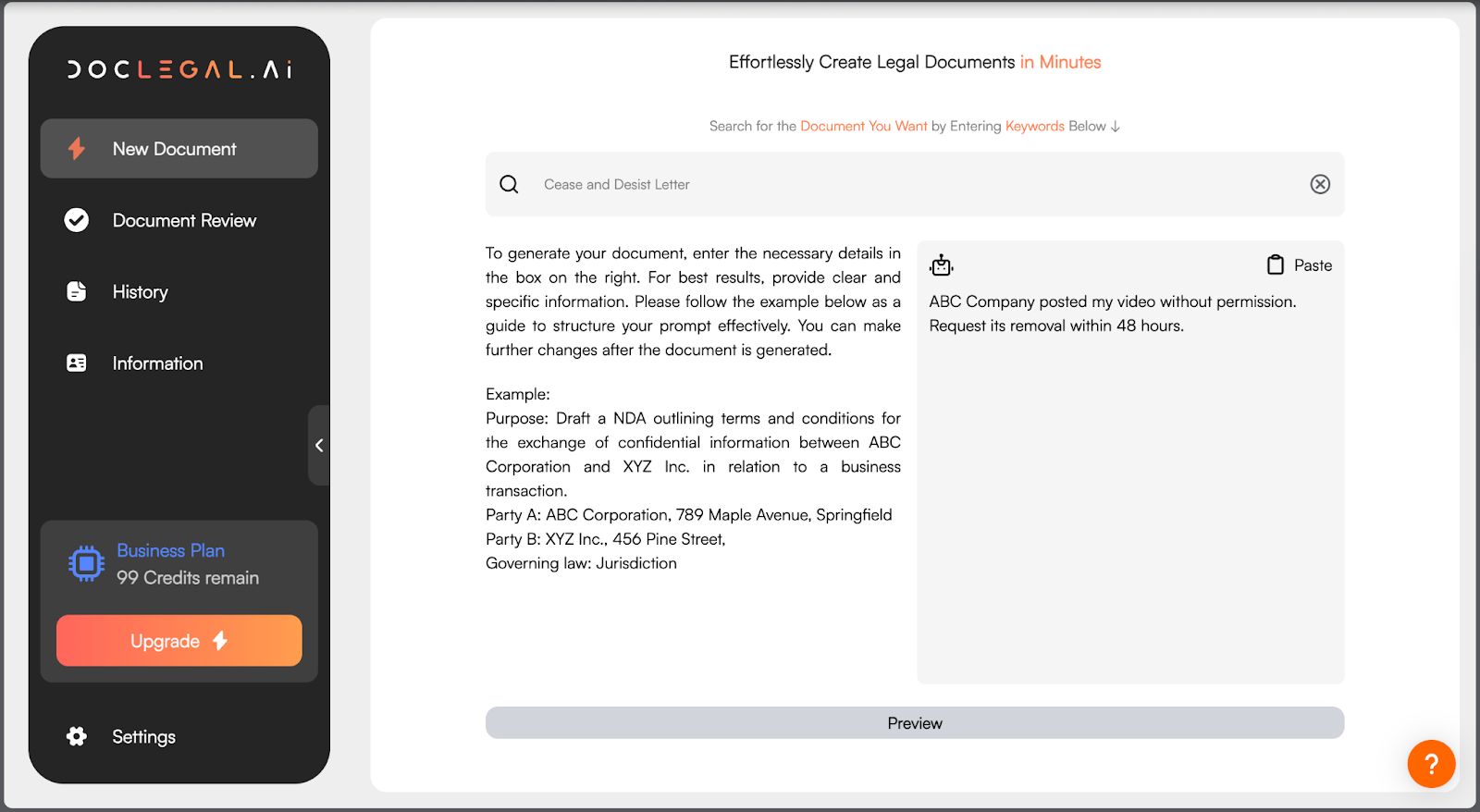
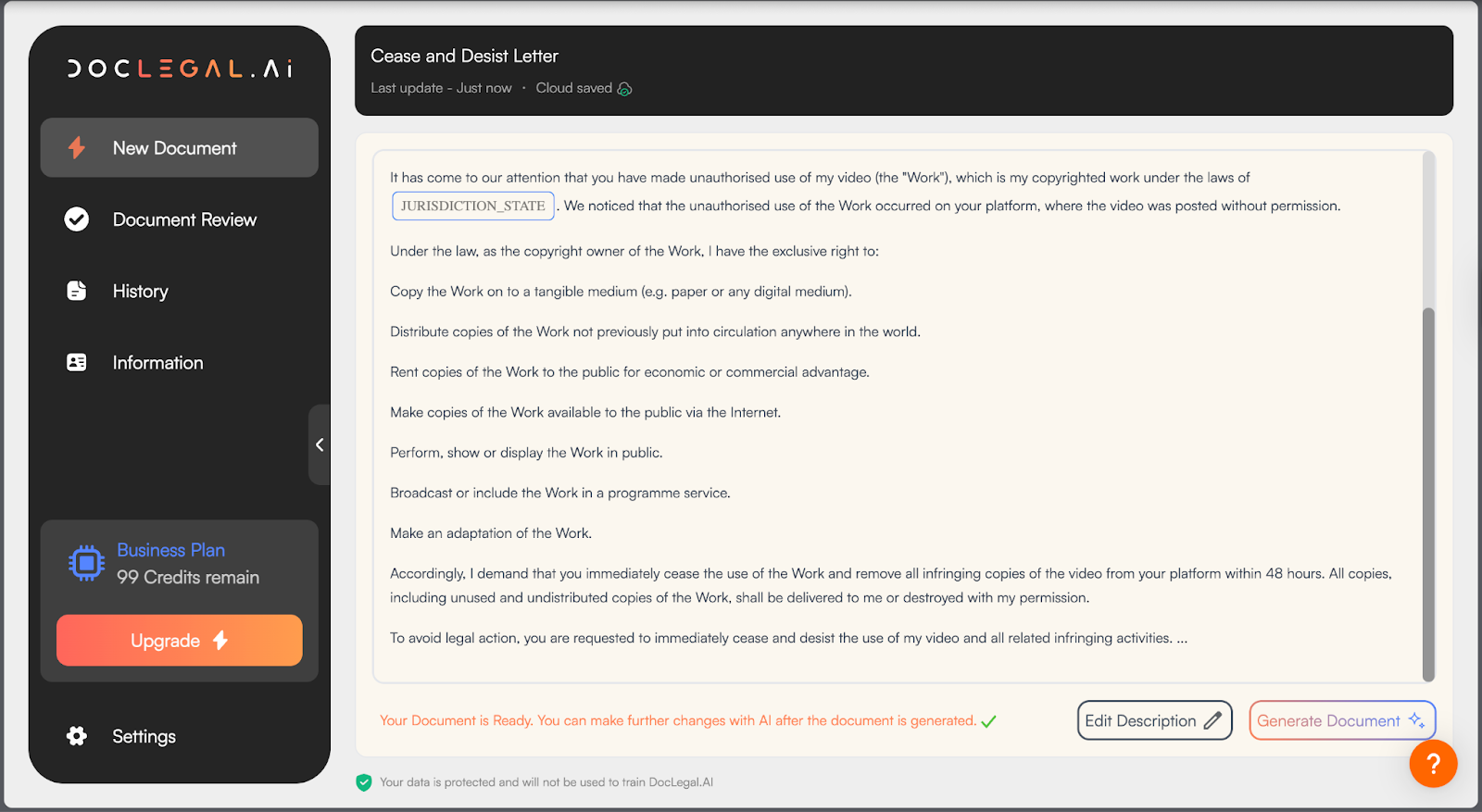
- File a DMCA Takedown Notice: In the U.S., if the infringer doesn’t comply, you can file a Digital Millennium Copyright Act (DMCA) notice with the platform hosting the content (e.g., Instagram, YouTube). Most platforms have a straightforward process for submitting these notices, requiring details like your contact information, the infringed content, and the unauthorised use.
- Consider Legal Action: If the infringement causes significant financial harm (e.g., a brand profiting from your content), consult a lawyer. In the U.S., you may be eligible for damages, especially if your work is registered with the U.S. Copyright Office.
- Prevent Future Issues: Use DocLegal.AI’s influencer contract templates to establish clear ownership and usage rights upfront. For instance, include clauses specifying that brands need written permission to repurpose your content beyond the agreed scope.
Tips to Protect Your Content and Avoid Legal Issues
Here are practical steps to ensure your content creation is legally sound:
- Use Licensed Content: Invest in subscriptions to royalty-free music and image platforms. They’re cost-effective compared to legal disputes.
- Read Contracts Carefully: Before signing a brand deal, review who owns the content and whether you retain any rights. DocLegal.AI’s influencer contract templates can help clarify these terms.
- Watermark Your Work: Adding a subtle watermark to your photos or videos can deter unauthorised use.
- Document Permissions: Keep records of any licenses or permissions for music, images, or brand assets you use.
Why a Solid Influencer Contract Matters
A well-crafted influencer contract is your safety net. It spells out who owns the content, how it can be used, and who’s responsible for legal compliance. Without one, you risk disputes over content ownership, payment issues, or liability for copyright violations. DocLegal.AI makes this easy with customizable influencer contract templates designed for both influencers and brands. These templates cover:
- Content ownership and usage rights

- Payment terms and deliverables

- Licensing responsibilities for music, images, or other assets

- Dispute resolution and termination clauses
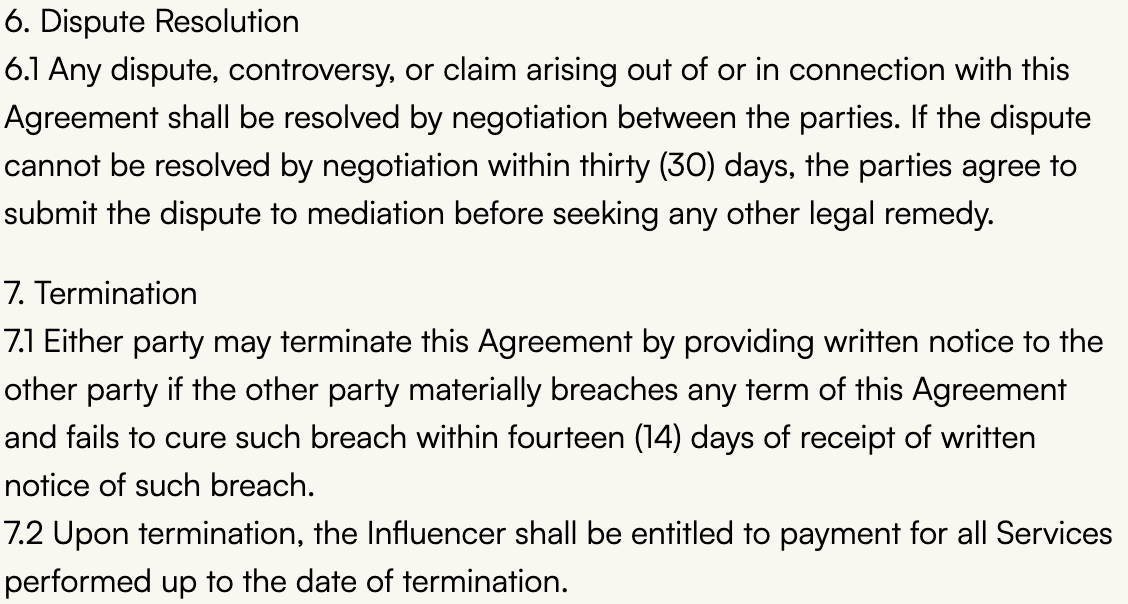
By using a clear contract, you protect your creative work and ensure smooth, professional partnerships.
Frequently Asked Questions (FAQs)
1. What should I do if I accidentally use copyrighted material in my content?
If you realise you’ve used copyrighted material without permission, remove it from your content immediately. Replace it with licensed content for creators. If the content is already live, contact the copyright owner to seek permission or negotiate a license. Using a clear contract from DocLegal.AI can help clarify responsibilities for future collaborations.
2. Can I use a song in my TikTok video if it’s trending on the platform?
Not always. Trending songs on TikTok or Instagram may still require a license for commercial use, especially in sponsored posts. Check the platform’s music library for pre-cleared tracks or use royalty-free music from services like Artlist to comply with influencer copyright laws.
3. How can I tell if my use of someone else’s content qualifies as fair use?
Fair use for influencers depends on factors like whether your use is transformative, non-commercial, and doesn’t harm the original creator’s market. For example, using a short clip for commentary might qualify, but using an entire song likely won’t. When unsure, seek permission or consult a legal expert to avoid risks.
4. What happens if a brand uses my content without permission?
If a brand uses your content without permission, generate a cease and desist letter with Doclegal.AI and contact them to request removal. If they don’t comply, file a DMCA takedown notice with the platform.
5. Do I need to register my content with the U.S. Copyright Office?
In the U.S., copyright protection is automatic when you create content. However, registering with the U.S. Copyright Office strengthens your legal position if you need to pursue damages for infringement. It’s especially useful for high-value content or frequent brand collaborations.
Take Control of Your Content with DocLegal.AI
Navigating influencer copyright laws doesn’t have to be daunting. By understanding fair use, securing licensed content for creators, and using clear contracts, you can focus on creating amazing content. Whether you’re an influencer building your brand or a small business collaborating with creators, DocLegal.AI’s influencer contract templates make it easy to protect your work and avoid legal pitfalls.
Ready to create legally sound agreements? Visit DocLegal.AI today to explore our customizable influencer contract templates. Start crafting professional partnerships with confidence and keep your content creation stress-free!

Contracts 101: How to Draft A Contract?
Learn how to draft a legally sound contract in 2025 with our step-by-step guide. Use DocLegal.ai’s 2800+ templates to save time and ensure compliance!
How to Draft A Contract?
What is a contract?
A contract is a legally-binding agreement between two or more people or companies.
Think of it as a list of promises: the parties will state what their rights and obligations are, what terms need to be followed, what deadlines need to be met, and what their expectations of each other are. The fundamental elements of a contract are as follows:
When do you need a written contract?
You should use a written contract whenever you’re entering into an agreement that involves money, services, or responsibilities — especially if the deal is important or ongoing. Examples include:
- Hiring a freelancer or employee
- Selling goods or services
- Lending or borrowing money
- Starting a business partnership
- Licensing intellectual property
While some verbal agreements can be legally binding, written contracts provide clear proof of what was agreed and help avoid “he said, she said” arguments later.
- 6 essential elements of a contract
Element
Explanation
Offer and acceptance
One party makes an offer, and the other accepts it. The parties must reach a consensus on the terms and conditions of the contract
Intention to create legal relations
Both parties must intend to enter into a legally-binding agreement.
Certainty
The terms of the contract should be clear and easy to understand.
Legal Capacity
Both parties must be capable of entering into a contract (i.e.: over the age of 18, not influenced by drugs or alcohol, etc.)
Consideration
Each party must provide something of value (e.g.: money, goods, services) in exchange
Let’s understand these essential elements of a contract:
- Offer and Acceptance
Offer and acceptance are fundamental concepts in contract law that determine when a legally binding agreement is formed.
Usually, one party will propose an offer. For example, a company might send a job offer to an applicant, with a copy of the employment contract included. Or, a business might contact another business, offering to sell its wares or provide some other form of service. In order for the offer to be recognised by the court, it needs to be specific and definite.
Contrast this: “I’m interested in buying your products. Let’s talk more later.” vs “I’d like to place an order for 1,000 boxes of 9-row cherries. We’ll pay you Z thousand dollars via bank transfer upon arrival. Please ensure it’s delivered to this address by 10th January, 20XX.” The latter would be viewed as a proper offer, while the latter is not meant to be legally binding.
Acceptance is the complement to an offer. The party who received the offer must express that they are agreeing to all of the terms that have been laid out. This can be done orally, through text / email, or via conduct (e.g.: handing over money to a cashier usually implies you are agreeing to the sale).
What happens if you aren’t satisfied with the terms? Suppose the orchard owner can’t deliver by 10th January and believes the price is too low. If he replies, saying he’s willing to sign the contract only if delivery is delayed and the price increased, this is not acceptance. It is a counter-offer, which legally terminates the original offer. The original party (in this case, the restaurant owner) must then accept the new offer for a contract to be formed
- Intent to Create Legal Relations
For a contract to be valid and enforceable, both parties must intend for their agreement to be legally binding and enforceable in law. What does this mean?
Contrary to what it sounds like, the courts are not looking at the parties’ mindset and thoughts. Rather, they will use conduct and circumstances to determine if the parties objectively intended to enter into the contract.
Usually, if a deal is struck in a commercial context, it will be treated as if the parties intended to be legally bound by their promises.
- Consideration
In a contract, both parties must provide consideration. This means that if A and B enter into a contract, each of them must either give something beneficial to the other, or face some sort of inconvenience or detriment.
The most common example is a sales contract. The cherry-seller provides the restaurant with produce (goods), whereas the restaurant owner provides payment. Both sides are giving up something valuable, and receiving something valuable in return.
Will a contract still be valid if A gives a benefit to B, but rather than a direct exchange, B gives the benefit to C? Certainly! Sometimes, contracts are set up for the benefit of a third party: for example, if a man hires a lawyer to write him a will, the benefits (e.g.: receiving an inheritance, less hassle) are enjoyed by his children. As long as each party has given consideration, it doesn’t matter who receives those benefits.
- Certainty
For a contract to be legally enforceable, it must also be sufficiently certain. In other words, its terms must be clear enough that the parties — and, if necessary, a court — can understand what has been agreed.
Certainty is important because it helps the parties understand their contractual rights and obligations. It minimises the chance for confusion or costly legal disputes. Courts are generally reluctant to “fill in the gaps” for a contract that is missing vital information, because there is a risk of holding parties to terms that they did not agree to. As such, it is more likely that they will declare the entire contract void for uncertainty.
Example: Alex and Jamie agree that Alex will sell “some stuff” to Jamie “sometime soon” for “a fair price.” But what is “some stuff”? How much will it cost? When will the sale happen? Since these details are too vague and uncertain, the court may decide there’s no valid contract.
- Legality
The subject matter of a contract must be legal.
Imagine, for example, you engage an advertising agency to put up a neon sign for your shop. Weeks later, the government passes a law to ban neon advertising at night. As such, the original contract will have to be modified to comply with regulations.
Hence, before you undertake any land or renovation projects, it’s always important to check with your local authorities on what the legal requirements are.
- Capacity
Capacity to contract refers to a person's legal ability to enter into a binding contract.
Generally, anyone 18 or older is considered to have full capacity. Minors often require their parents’ consent in order to enter into contracts. This, however, can vary depending on jurisdiction, so make sure to check with your local authorities.
People suffering from mental illness or extreme drunkenness at the time of contracting may not have capacity if they cannot even understand the nature of the transaction.
Need help checking for these elements? DocLegal.ai templates are legally reviewed and structured to include all key components automatically.
Can I draft my own contract?
Yes, you can draft your own contracts. No special qualifications are required, and you only need to ensure the contract fulfills the elements of a contract for it to be enforceable.
That said, writing contracts from scratch can be time-consuming and risky. That’s where DocLegal.ai comes in.
- It generates lawyer-reviewed templates in minutes
- You can customize terms easily based on your needs
- It's affordable — around the price of a cup of coffee
With DocLegal.ai, drafting your own contract is easy, fast, and legally smart.
How long does it take to draft a contract?
It can be time consuming and risky to create your draft contract from scratch! That’s where tools like DocLegal.ai come in.
DocLegal.ai offers an AI legal document generator that is trained to generate 2800+ lawyer-approved templates. This AI legal tool makes contract drafting and customization fast, simple, and affordable (about the price of a coffee!). Whether it’s a freelance agreement, loan contract, or NDA, DocLegal.ai can create professional documents in minutes with confidence.
How to Draft a Contract: Step-by-Step Guide
Step 1: Start with a Legal Template
Use a professional legal template as your foundation.
Use DocLegal.ai to generate lawyer-approved, customized templates for 2800+ use cases.
Step 2: Define Purpose and Scope
Clarify what the contract is for (employment, sale, service, etc.), and for how long it applies.
Step 3: Identify the Parties
Name individuals or businesses clearly, with legal names and identifiers (e.g. company number, ID).
Step 4: Outline the terms and conditions
Make sure the contract includes essential terms and conditions such as:
- Responsibilities: Each party’s obligations must be clearly described — whether it's making a payment, providing goods, or delivering a service. Be specific to avoid confusion or future disputes.
- Key Deliverables: List exactly what will be delivered, including quantity, quality, and timing. This ensures both parties have the same expectations.
- Payment Terms: State how much will be paid, when, and how (e.g. lump sum or installments). If interest is charged, include the rate and how it's calculated.
- Penalties for Late Payment / Performance: Include consequences if deadlines or payments are missed, such as late fees or interest increases. These terms encourage accountability and timely performance.
- Limitation of Liability: This clause limits how much one party has to pay if something goes wrong. It can cap financial liability or exclude certain types of losses.
- Termination and Force Majeure: Explain how the contract can be ended early, such as by giving notice or for breach. Include a force majeure clause to cover unexpected events like natural disasters or pandemics
- Boilerplate Provisions: These are clauses that can be used in multiple documents.
DocLegal.ai includes all of these clauses in its templates, so you don’t have to start from scratch.
Step 5: Review Your Draft Contract
- Eliminate ambiguity and jargon
- Use headings, numbering, and plain English
- Check for consistency, spelling, and grammar
- Make sure everything reflects what was agreed
Use DocLegal.ai's smart editing tools to make revisions quickly and clearly.
Step 6: Finalize and Sign
- Include signature blocks for all parties
- Consider notarization or witness signatures
- Date the agreement and store copies securely
DocLegal.ai allows you to generate, edit, and store contracts all in one place.
Related Article: How to Draft a NDA with DocLegal.ai
Final Contract Checklist:
- Are the parties clearly named? Double-check that there is no ambiguity about the identity of the parties.
- Can the parties legally enter into the contract? All people entering into the contract should be over the age of majority, which is typically 18 years old. In case you are contracting with a minor, you would need the parent or legal guardian’s consent. Additionally, the parties should be mentally competent and able to understand the terms of the contract. If they are influenced by, for example, drugs or alcohol, the contract would not be legally binding.
- Do the parties agree on the contractual terms? Before drafting the contract, it is best to sit down with the other party, and to discuss the terms that you would like to put into the contract. For example, for an employment contract, you would need to reach a consensus on:
- Period of employment and working hours (whether fixed/flexible)
- Wages (whether calculated daily, weekly or as a commission)
- Meal breaks
- Meal and transport allowance
- Holidays and rest days (whether paid or unpaid)
- Job duties
Need to double-check your contract? DocLegal.ai’s templates and smart features help prevent costly mistakes.
How DocLegal.ai Can Help You
Save Time
No need to start from scratch. Just answer a few questions, and DocLegal.ai generates your contract in minutes.
Save Money
Why pay $200–$1,500 for a lawyer when you can draft legally-sound contracts for the price of a coffee?
Reduce Risk
DocLegal.ai templates are vetted and updated based on legal best practices.
Customize Easily
Create NDAs, freelance agreements, sales contracts, or anything else from our 2800+ template library.
Get Started Today
Sign up for 50% off your first subscription and simplify your legal drafting process.

Understanding Influencer Contract Law for Brand Partnerships
Master influencer contract law for brand partnerships in 2025. Learn key terms, disclosure rules, and legal protections for sponsorship deals.
Understanding Influencer Contract Law for Brand Partnerships
In today’s digital age, influencer marketing has become a cornerstone of brand promotion, with influencers serving as the bridge between brands and target audiences. However, navigating the legal landscape of influencer partnerships is critical to ensuring that parties are protected and aligned. This article dives into the key terms of influencer contract law, such as payment structures, content ownership, and compliance with the Federal Trade Commission (FTC) disclosure rules. Whether you’re an influencer or a brand, understanding these elements can safeguard your interests and foster smooth collaborations.
Why Influencer Contracts Matter
Influencers might excel at communicating with fans, but aligning expectations with brands is a completely different form of communication. Brand partnership agreements establish expectations and ensure compliance with regulations. Without a well-drafted contract, misunderstandings over deliverables or payment disputes can arise, potentially damaging both parties’ reputations and finances. A solid contract acts as a roadmap, guiding the partnership from start to finish.
At DocLegal.AI, we simplify the process of creating tailored legal documents, including influencer contracts, to ensure your partnerships are legally sound. Let’s explore the critical components of these agreements and take a look at some sponsorship contract tips.
Key Contract Terms for Influencer Partnerships
1. Payment Terms
To influencers, the most critical aspect of an influencer contract is getting paid for their work. Clear payment terms prevent disputes and ensure both parties are on the same page. Here are some elements to include:
- Compensation Structure: Specify whether the influencer will be paid a flat fee, a commission based on sales, or through product exchanges. For example, a flat fee might be $1,000 for three Instagram posts, while a commission could be 10% of sales driven by a unique promo code.
- Payment Schedule: Outline when payments will be made, e.g., upon completion of deliverables, in instalments, or after a campaign’s conclusion. For instance, 50% might be paid upfront, with the remainder due after content is posted.
- Late Payment Penalties: Include clauses for late payments to incentivise timely compensation. A common approach is a 5% penalty for payments overdue by 30 days.
- Reimbursement for Expenses: If the influencer incurs costs (e.g., travel or production expenses), the contract should clarify whether these are reimbursable and how.
2. Content Ownership and Usage Rights
Content ownership is a pivotal issue in influencer contract law. Influencers create original content, such as graphics, videos, or blog posts, that brands might want to repurpose. Without clear terms, disputes over who owns or can use this content can arise.
- Ownership: By default, influencers retain ownership of their content unless explicitly transferred to the brand. Contracts should state whether the brand is licensing the content or purchasing full ownership.
- Usage Rights: Specify how the brand can use the content. For example, can they repost it on their social media or use it in advertisements? Define the scope (e.g., platforms, duration, and geographic regions).
- Exclusivity: Some contracts include exclusivity clauses, preventing influencers from working with competitors for a set period. For instance, a beauty influencer might be restricted from promoting rival skincare brands for six months.
- Content Approval: Outline whether the brand has the right to approve or request edits to content before posting. This ensures the content aligns with the brand’s image and campaign goals.
3. FTC Disclosure Compliance Clauses
The Federal Trade Commission (FTC) in the United States enforces strict guidelines to ensure transparency in influencer marketing. Non-compliance can put both influencers and brands in trouble. Incorporating FTC compliance into contracts protects both parties from legal risks and strengthens accountability.
- Disclosure Requirements: Influencers must disclose any “material connection” to a brand, such as payment, free products, or affiliate relationships. Disclosures should be clear and conspicuous, using phrases like #ad, #sponsored, or “Paid partnership with [Brand].”
- Placement of Disclosures: Disclosures should appear at the beginning of posts or videos, not buried in a group of hashtags or captions. For example, in an Instagram post, include #sponsored in the first line of the caption.
- Platform Disclosure Tools: Different platforms have their built-in disclosure tools. Do not assume that they are good enough, influencers should always include manual disclosures in addition to using their disclosure tools.
- Brand Responsibility: Contracts should specify that the influencer is responsible for FTC compliance, but brands may also include training or guidelines to ensure adherence.
4. Deliverables and Performance Metrics
A well-drafted contract outlines specific deliverables to avoid ambiguity. These might include:
- Content Type and Quantity: Specify the number of posts, stories, or videos required. For example, “Three Instagram feed posts and five Stories.”
- Posting Schedule: Include deadlines for content creation and posting, such as “One post per week for four weeks.”
- Performance Metrics: If the campaign is performance-based, define metrics like impressions, clicks, or sales. For instance, “The influencer will provide analytics showing at least 10,000 impressions per post.”
- Content Guidelines: Detail brand requirements, such as hashtags, brand mentions, or specific messaging (e.g., “Highlight the product’s eco-friendly features”).
5. Termination and Dispute Resolution
Contracts should include provisions for ending the partnership and handling disputes:
- Termination Clauses: Specify conditions under which either party can terminate the agreement, such as failure to deliver content or breach of contract. For example, “The brand may terminate the agreement if the influencer fails to post by the agreed deadline.”
- Dispute Resolution: Outline how disputes will be resolved, whether through mediation, arbitration, or legal action. This protects both parties in case of disagreements.
- Kill Fees: If a campaign is cancelled, consider including a kill fee to compensate the influencer for work completed.
Sponsorship Contract Tips for Success
To maximise the effectiveness of brand partnership agreements, consider these sponsorship contract tips:
- Work with a Legal Professional: Platforms like DocLegal.AI can generate tailored contracts, but consulting a lawyer ensures compliance with local laws.
- Be Specific: Vague terms lead to misunderstandings. Define every aspect of the partnership, from content style to payment deadlines.
- Negotiate Fairly: Both parties should feel the terms are equitable. Influencers should advocate for fair compensation, while brands should ensure realistic deliverables.
- Review Regularly: As influencer marketing evolves, update contracts to reflect new platforms, regulations, or industry trends.
Influencer Legal Protections: Safeguarding Your Interests
For influencers, influencer legal protections are vital to maintaining control over their brand and income. Key protections include:
- Right to Refuse Edits: Contracts should allow influencers to push back on excessive content revisions that conflict with their creative vision.
- Payment Guarantees: Include clauses ensuring payment even if the brand’s campaign underperforms (e.g., low sales or engagement).
- Liability Limits: Protect influencers from liability for brand-related issues, such as product defects or false advertising claims.
- Content Modification Limits: Contracts should include clauses that limit excessive or unreasonable content edits by brands, preserving the influencer’s creative control and brand authenticity (e.g., maximum three revisions).
- Non-Compete Clause Boundaries: Ensure non-compete clauses are reasonable in scope and duration (e.g., limited to specific industries or timeframes) to avoid restricting future work opportunities.
- Indemnity Provisions: Include terms that protect influencers from legal liability for brand-related issues, such as misleading product claims or intellectual property disputes, unless caused by the influencer’s negligence.
- Payment Dispute Mechanisms: Specify clear processes for resolving payment disputes, such as mediation or arbitration, to ensure influencers are compensated promptly and fairly.
By prioritising these protections, influencers can confidently enter partnerships without compromising their rights.
Conclusion
Navigating influencer contract law is essential for creating successful, legally sound brand partnerships. By addressing payment terms, content ownership, FTC compliance, deliverables, and termination clauses, both influencers and brands can foster transparent and mutually beneficial collaborations. Platforms like DocLegal.AI make it easy to generate customised brand partnership agreements that protect your interests and comply with regulations.
Ready to draft your next influencer contract? Visit DocLegal.AI to create professional, legally binding documents tailored to your needs. With clear contracts in place, you can focus on building impactful partnerships that drive results.

How SMEs Can Use AI to Draft Sponsorship Contracts
Draft SME sponsorship contracts with AI tools. Simplify payment and branding terms with DocLegal.ai’s templates for cost-effective deals. Learn more today!
Maybe you’re a small business owner, looking to drive engagement and boost your own business. Or maybe you’re a marketing specialist who’s looking to secure a sponsorship. Regardless of your position, securing a sponsorship can be a game-changer for small and medium-sized enterprises (SMEs). Whether you’re launching a new product, hosting an event, or building brand awareness, sponsorships provide crucial financial support and marketing exposure.
However, navigating sponsorship contracts can be daunting—especially for young entrepreneurs. What is the difference between exclusive and non-exclusive rights? How should you tackle payment schedules and branding rights?
The good news? You don’t need to hire expensive lawyers or waste hours drafting agreements from scratch. With AI-powered tools like DocLegal.ai, creating airtight sponsorship contracts is faster, cheaper, and hassle-free. This guide breaks down the key elements of sponsorship agreements and explains how technology can simplify the process—so that you can focus on growing your business.
Why Sponsorship Contracts Matter for SMEs
Sponsorships are partnerships where a company (the sponsor) provides financial support to another business (the party being sponsored) in exchange for promotional benefits. These kinds of mutually-beneficial agreements are common in sports, entertainment, startups, and community events. However, without a well-structured contract, misunderstandings can lead to disputes over payments, branding misuse, or unmet expectations.
A solid sponsorship agreement protects both parties by clearly outlining obligations, deliverables, and legal safeguards. For SMEs, this is especially critical—you want to ensure you’re getting fair value out of your contract, and at the same time, you want to avoid legal disputes, which could be costly.
This is why it’s important to cover all your bases, and to ensure that you’re familiar with the key terms of a sponsorship contract, before signing and finalising one.
Key Elements of a Sponsorship Contract
- Payment Schedules
One of the most common pitfalls in sponsorship deals is vague payment terms. Will the sponsorship fee be paid upfront, in installments, or after certain milestones have been met?
So to minimize conflicts, your contract should specify:
- Sponsorship fee amounts and due dates (e.g.: 50% upfront, 50% upon event completion)
- Late payment penalties to discourage delays.
- Refund policies if the agreement is terminated early.
Example: You’re organizing a startup conference, and a sponsor has agreed to fund $10,000. The contract should clearly state whether payments are tied to attendee numbers, social media promotions, or other KPIs. Clear terms can prevent awkward follow-ups, and ensure that you aren’t left sourcing funding last minute when the payment you’ve been relying upon doesn’t arrive.
- Branding Rights
In exchange for financial support, sponsors receive visibility. Hence, the sponsorship contract must define how and where their brand will appear. Key considerations include:
- Logo placement (event banners, websites, merchandise).
- Exclusivity clauses (e.g., no competing brands at your event).
- Approval rights (sponsors may want to review marketing materials before publication).
If you’re a small fitness brand partnering with a supplement company, you’ll need to agree on whether their logo appears on your apparel, social media, or YouTube videos. Ambiguity here can lead to disputes — imagine, for example, if your sponsor is not satisfied with your event backdrop and threatens to pull out at the last minute.
Therefore, always make sure to put down your sponsor’s display and approval rights, and to clarify whether these are exclusive or non-exclusive.
- Deliverables
Deliverables are what each party must provide. Sponsorships are a mutually beneficial exchange; both sides must fulfil their promises. From the sponsor’s side, their deliverables include the sponsorship fee (cash), and also any free products or services that will be provided. Whereas, the sponsored party has the obligation to promote the sponsor, through measures such as providing ad space, shoutouts, and VIP access.
Furthermore, some sponsorship agreements may hinge on performance metrics, such as minimum social media impressions (based on likes, views, and such), or the amount of foot traffic. The exact sponsorship amount may also be contingent upon certain KPIs being reached,
Example: A beverage company has agreed to sponsor your pop-up shop. However, they might have expectations that a certain number of product samples will be distributed. Without clear written terms,
Without written terms, you risk underdelivering, or being asked for more than you are capable of giving.
- Termination Clauses
Not all sponsorships go as planned. Common reasons for sponsorship contracts to end early can include disagreements, unmet expectations, or even something as simple as cash flow issues. To avoid such ugly breakups, a sponsorship contract should outline:
- Conditions for termination: These are the conditions where, once met, either party would be able to gracefully withdraw from the contract. This can include breaches of contract (e.g.: failure to pay before certain deadlines, or failure to perform what has been written down in the contract). Allowing parties to terminate because of low attendance can be undesirable for the sponsored party, especially since this is something they have no control over. However, this is a standard term incorporated into sponsorship agreements, and your sponsor may insist on this term being in place. See if you can address this issue during negotiations, and come to a consensus.
- Notice periods: Termination often does not take place immediately. It is common to require several working days or weeks’ notice before ending the agreement, so that the parties would have time to adjust.
- Consequences of early termination: If one party goes ahead with the termination, they often have to pay partial compensation to the other party, in order to bridge the gap during which the other party needs to make different arrangements.
Imagine a tech startup sponsoring a podcast, only to realise that they have completely different target audiences. A clearly-defined termination clause would allow either party to exit gracefully, without spending time and money on legal battles.
- Exemption Clauses
An exemption clause (sometimes also called an “exclusion clause” or “limitation clause”) is a clause that limits how much one party has to pay if things don’t go as planned. It can cap or ‘limit’ financial liability, and exclude certain types of losses altogether.
Most jurisdictions have enacted statutes about exemption clauses. One example is that you cannot exclude liability for your own criminal or negligent acts. (You can, however, shift the liability towards another party in certain agreed-upon circumstances, which will be discussed below.) It is recommended to check the exact legislations that are applied to your area, but as a rule of thumb, an exemption clause that is fair and reasonable will generally be accepted by the courts.
Your sponsorship contract should address:
- Indemnification: To “indemnify” someone means to compensate them for harm or losses. In other words, an indemnity is the parties’ arrangement on how liabilities should be distributed. The courts will generally give effect to the parties’ wishes, so it is especially important to discuss this with your contracting partner, and come to a consensus.
- Example: the sponsor, AA Electronics Company, has agreed to indemnify their sponsored podcaster, Bob, “against the payment of any liabilities or expenses which he incurs as a result of third party claims, in connection with promoting AA Electronics Company”. Bob uses misleading promotion tactics, and is sued by multiple customers. Due to the terms and broad nature of the indemnity, AA Electronics Company is obliged to compensate Bob for his legal costs, even though Bob is completely at fault.
From this example, we can see the importance of having an iron-clad indemnity clause, which is capable of covering all unforeseen events.
- Force Majeure: This is a French term, which translates to “superior force”. It is legal terminology for unforeseen circumstances which prevent the parties from fulfilling the contract. An example would be if a company from Country A decided to sponsor another one in Country B, and later, the Country B government criminalised receiving any form of financial assistance from Country A. In such cases, a force majeure clause sets out the arrangements, in case either party is unable to perform.
- Example: CC Snacks Company has agreed to sponsor Danielle’s promotion event, and has contributed towards the costs of advertising and booking a room. However, on the day of the event, a freak typhoon forces the event to be cancelled. Luckily, the parties can refer back to their force majeure clause, which states that Danielle will compensate CC Snacks for 70% of the expenses that were already incurred. The contract comes to an end, and the parties part ways on good terms, willing to work together again in the future.
Exemption clauses are critically important to include in your contract, so make sure to discuss what grounds will give rise to liability, and how losses will be allocated. Having clear legal terms will save you from legal headaches later down the road.
How DocLegal.ai Simplifies Sponsorship Contracts
Drafting a sponsorship agreement from scratch is time-consuming, not to mention unnecessary in this time and age. And hiring a lawyer can cost thousands (if not tens of thousands) of dollars. This is where DocLegal.ai comes in, as a game-changer for budget-conscious SMEs.
Here’s how DocLegal.ai can streamline your sponsorship contract drafting process. These steps can be applied to any other type of contract, such as general business agreements, employment contracts, sales contracts, non-disclosure agreements, and more! Whatever your needs, DocLegal.ai will be there to help you.
- Instant, Customizable Templates
DocLegal.ai offers pre-built sponsorship contract templates tailored to different situations. Instead of starting from zero, you input your deal specifics (party names, payment terms, branding rights, duration), and the AI generates a legally sound draft in minutes.
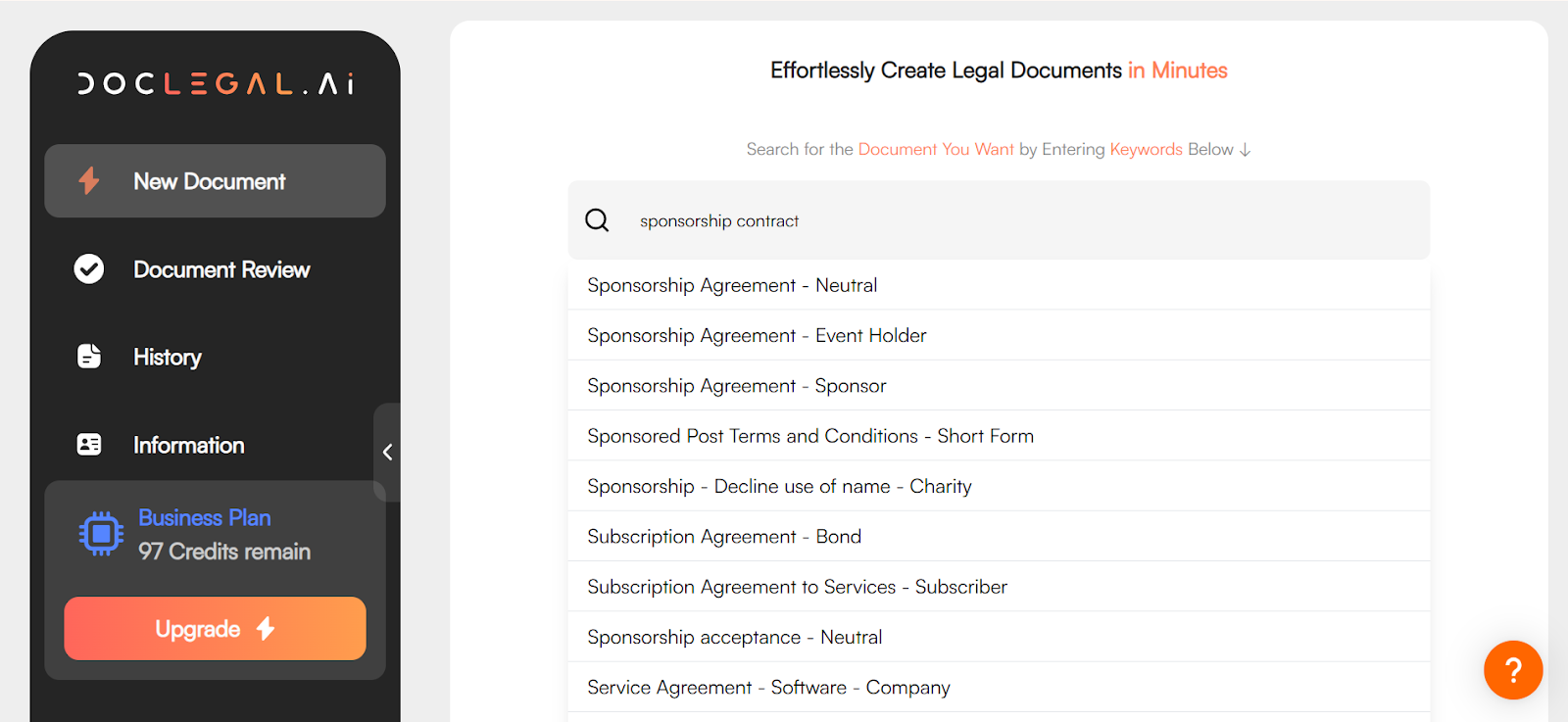
- Smart Legal Guidance
The Doc.Legal AI editor explains complex clauses in plain English, helping you understand the terms as you draft. For instance, if you’re unsure about exemption clauses, the AI can both give you a definition, and suggest standard language to protect both parties.
- Automated Risk-Highlights and Review
What risks are there, and what are your potential liabilities? Worry no more! At the review stage, the Doc.Legal AI editor can go through each of the most common scenarios (indemnity, refund, cancellation, etc.) and summarise each party’s liabilities. It can also check your contract against standard industry practice. You can even ask further questions to the AI, and seek its advice in negotiating more equitable terms.
- Effortless Negotiation & Edits
Need to adjust payment terms or branding rights? Instead of emailing back-and-forth with lawyers, you can edit clauses in real-time and share a revised version with your sponsorship partners instantly.
- Cost Savings
Traditional legal fees for drafting contracts can rapidly drain an SME’s budget. DocLegal.ai provides professional-quality agreements at a fraction of the cost — perfect for startups and small businesses.
Final Thoughts
Sponsorships are powerful tools for SMEs, but poorly structured contracts can turn them into nightmares. By understanding payment schedules, branding rights, deliverables, and legal safeguards, you will be able to negotiate fair deals with confidence.
Tools like DocLegal.ai democratize access to legal expertise, allowing SMEs to create professional contracts quickly and affordably. Instead of fearing fine print, you’ll have a tool at your side to rapidly highlight the business risks; and instead of stressing over equitable terms, you can focus on what really matters, which is building partnerships that grow your business.
Next time you pitch to a sponsor, remember: a solid sponsorship contract isn’t just paperwork — it’s the foundation of a successful, stress-free collaboration. And with DocLegal.ai streamlining the process, you’ll be able to revise clauses, ensure compliance with legislation, and protect your business interests.
Sign up now to enjoy 50% off your first subscription, and learn how you can simplify your day-to-day bureaucratic and legal tasks.

A Founder's Guide with AI Templates
Master the process of forming a company with key documents like Articles of Association and Shareholders’ Agreements. Ensure legal clarity, protect assets, and boost investor confidence.
What is incorporation?
Let’s start with a brief overview of what a company is. Basically defined, a company is a corporate vehicle with which your business is conducted through. Companies are a separate legal personality: you are your own personality (even if you are the founder), and the company is its own personality. Thus, this corporate vehicle separates yourself from your business and its liabilities, such as debts and lawsuits. This is important because if your company “fails” and goes into debt, the creditors can only make legal claims against your company and cannot chase after you yourself (with very few exceptions). For this reason, a vast majority of companies—whether private or public—are “limited liability” companies.
A company needs to go through the process of incorporation in order for it to be formed and recognised by law. The incorporation process will vary from jurisdiction to jurisdiction, but it broadly involves filing various documents to the relevant register of companies, preparing documents regarding how the company is to be run, as well as ensuring that the startup complies with relevant laws and regulations.
Below is a simplified timeline of incorporation. Some of these documents will be explained later on in this blog post:
- Founding members (founders) sign the articles of association
- Delivery of the following documents to the companies registry:
- Incorporation form, which has been completed and signed by the founders (each jurisdiction has its own specific incorporation form)
- Copy of the articles of association
- Payment of incorporation fee to the companies registry
- Issuance of certificate of incorporation by the companies registry
DocLegal.ai is an AI legal document generator which simplifies the incorporation process. Read on to find out more about how DocLegal.ai can generate startup incorporation document templates to get your startup off the ground.
Essential startup incorporation documents
This section discusses two key essential documents for new business legal setup: the articles of association and the shareholders’ agreement.
1. Articles of association
The articles of association prescribe the company’s regulations, akin to a mini ”constitution” laying out how the company is to be run. It is also a contract between the company and its shareholders (also known as “members”), thus the shareholders may sue the company to enforce the articles if they believe it was breached.
Some jurisdictions may also require certain details to be stipulated in the Articles. In Hong Kong these are known as “mandatory articles” and include:
- The name of the company
- Whether shareholders’ liability is limited or not
- How shareholders’ liability is limited (by shares or by guarantee)
- Capital and initial shareholdings at incorporation
In addition, some jurisdictions may also have a “default” set of articles in case the company does not come up with its own. In Hong Kong, these are called the Model Articles and can be found in the Companies (Model Articles) Notice (Cap. 622H) (“the Notice”). For illustrative purposes, below are a few of the Hong Kong Model Articles prescribed for private companies limited by shares, found in Schedule 2 of the Notice:
- Size of quorum for directors’ meetings: “The quorum for directors’ meetings may be fixed from time to time by a decision of the directors and unless otherwise fixed it is 2.” (Model Article 11(2))
- How directors are to be appointed: “A person who is willing to act as a director, and is permitted by law to do so, may be appointed to be a director—(a) by ordinary resolution; or (b) by a decision of the directors.” (Model Article 22(1))
- How dividends are made to shareholders: “The directors may from time to time pay the members interim dividends that appear to the directors to be justified by the profits of the company.” (Model Article 73(2))
Keep in mind that the Model Articles are not mandatory to adopt, but it will apply if your company does not write its own articles. Your startup is free to write your own articles as desired so long as it complies with the law. In Hong Kong, the main governing legislation is the Companies Ordinance (Cap. 622). For example, a director can only be removed by ordinary resolution at a general meeting per Companies Ordinance section 462(1), so any articles of association stating otherwise will not be effective.
For companies in England and Wales, the model articles of association can be found at https://www.gov.uk/guidance/model-articles-of-association-for-limited-companies.
In Australia, the Corporations Act 2001 has a set of “replaceable rules” which apply where a company does not adopt its own company constitution (i.e. a single document replacing the memorandum of association and articles of association). The replaceable rules can be found at https://www5.austlii.edu.au/au/legis/cth/num_act/ca2001172/s141.html.
In India, Schedule I of the Companies Act 2013 includes model articles in Tables F, G, H, I and J. It can be found at https://www.indiacode.nic.in/bitstream/123456789/2114/5/A2013-18.pdf.
Case study: articles of association
Rita and Taylor are shareholders of a startup company with shareholdings of 55% and 45% respectively. Rita wants the company to enter into a transaction which would cost the company $100,000 but Taylor disagrees. In the company’s articles of association which Ai-powered legal document generator DocLegal.ai helped draft, Rita and Taylor added a clause providing that transactions less than $110,000 only require an ordinary resolution (>50% of the shareholding) to pass. Taylor is in despair because he thinks that Rita can pass the resolution on her own (because she already has 55% of the shareholding). However, upon closer examination of the articles, he notices that article 37(1) states that two members must be present in order to constitute a quorum for a general meeting, and 37(2) states that “No business [...] is to be transacted at a general meeting if the persons attending it do not constitute a quorum”. This makes Taylor happy because he can simply decide not to show up to the general meeting where the $100,000 transaction is to be voted on, so that Rita on her own cannot meet the quorum requirement and no resolution can be passed at all.
2. Shareholders’ agreement
A shareholders’ agreement is an agreement between some or all shareholders to regulate their rights and obligations in the company.
Does your company need a shareholder agreement?
In most jurisdictions, a shareholder agreement is not legally required for every company—but it is often highly recommended, especially in companies with multiple shareholders. A shareholder agreement allows you to set out additional, customized arrangements regarding:
- Management and decision-making processes
- Transfer of shares and exit strategies
- Dividend policies
- Dispute resolution mechanisms
- Protection of minority shareholders
Without a shareholder agreement, disputes among shareholders may be more difficult to resolve, and you will be limited to the default rules under the Companies Ordinance and your company’s articles of association. A well-drafted shareholder agreement can help prevent misunderstandings and provide clarity on important issues.
Difference between shareholders' agreement and articles of association
A shareholders’ agreement provides for the manner of operating the company either not provided for under relevant company laws or in the articles of association. Usually, the shareholders’ agreement is more detailed than the articles.
Why provide for something in the shareholders’ agreement but not the articles of association?
- The articles of association must be registered with the relevant registry of companies, so they are open to inspection by the public.
- On the other hand, shareholders’ agreements are private agreements that need not be registered. This makes non-registered shareholders’ agreements ideal for privacy, because its terms can be kept confidential from the public.
Another difference between a shareholders’ agreement and the articles of association is that while both are agreements on how to run the company, the company is automatically a party to the articles of association—so it is always bound by the articles (meaning that it can always be sued for breaching the articles). Meanwhile, the company may be taken out of the shareholders’ agreement, making the company not bound by it. In that case, the shareholders’ agreement only creates personal obligations enforceable between the shareholders. Furthermore, shareholders’ agreements are not automatically binding. Thus, shareholders are only bound by the shareholders’ agreement if they consent to it, which is different from how the articles of association are automatically binding.
What to include in a shareholders' agreement?
Below are some key provisions in shareholders’ agreements:
- Scope of business
- Share capital (shareholders and their respective shareholdings)
- Board composition, quorum and decision-making process
- Who gets to appoint the directors
- Special quorum requirements to ensure representation
- Reporting of information to the shareholders
- Future financing obligations
- Dividend policy, i.e. a minimum percentage of profits to be declared as dividends
- Pre-emption rights, which grant a first right of refusal to existing shareholders for buying out the shares of another shareholder who wishes to sell to an outsider
Shareholders’ agreement: case study
Alice and Hayley are 50-50 shareholders in a pharmaceutical company that was founded to manufacture medical drugs. Hayley actively manages the day-to-day runnings of the company, while Alice is more of a passive investor and does not take much of a role in running the company. One day, Hayley comes across an “exciting” piece of news about cryptocurrency trends and decides she wants to turn the company into a crypto mining company. Hayley makes this change without passing a vote involving all shareholders. When Alice finds out, she is furious because she believes crypto is an incredibly unstable industry to enter. Fortunately, article 6.2 of the shareholders’ agreement generated by DocLegal.ai (signed by both Alice and Hayley) states that a “change in the nature of Business” is a “Reserved Matter” requiring all parties to the shareholders’ agreement to vote in favour before it can take place. Hayley has thus most likely breached the shareholders’ agreement because the nature of a crypto mining business is very different from that of a pharmaceutical company, thus Alice could take legal action against Hayley for this change—such as seeking a court injunction for Hayley to restore the company to its original business.
Do you need a Memorandum of Association?
A Memorandum of Association was historically a key constitutional document required for incorporating a company in Hong Kong. However, under the current Companies Ordinance (Cap. 622), the memorandum of association is no longer required for company incorporation. Instead, the articles of association serve as the sole constitutional document for companies formed under the current law.
For companies incorporated before the commencement of Cap. 622, the conditions in their memoranda are now deemed part of their articles of association. The memorandum typically set out the company's name, its objects (purpose), and the liability of its members, among other foundational matters. Now, these matters are addressed within the articles of association.
How to draft startup incorporation documents with DocLegal.ai
DocLegal.ai enables users to generate legal documents from lawyer-made templates, summarize complex contracts, highlight absent clauses, suggest improvements, and automatically update documents all through an intuitive AI chatbot, making legal workflows more reliable and efficient.
1. Start a new session on DocLegal.ai in “New Document”
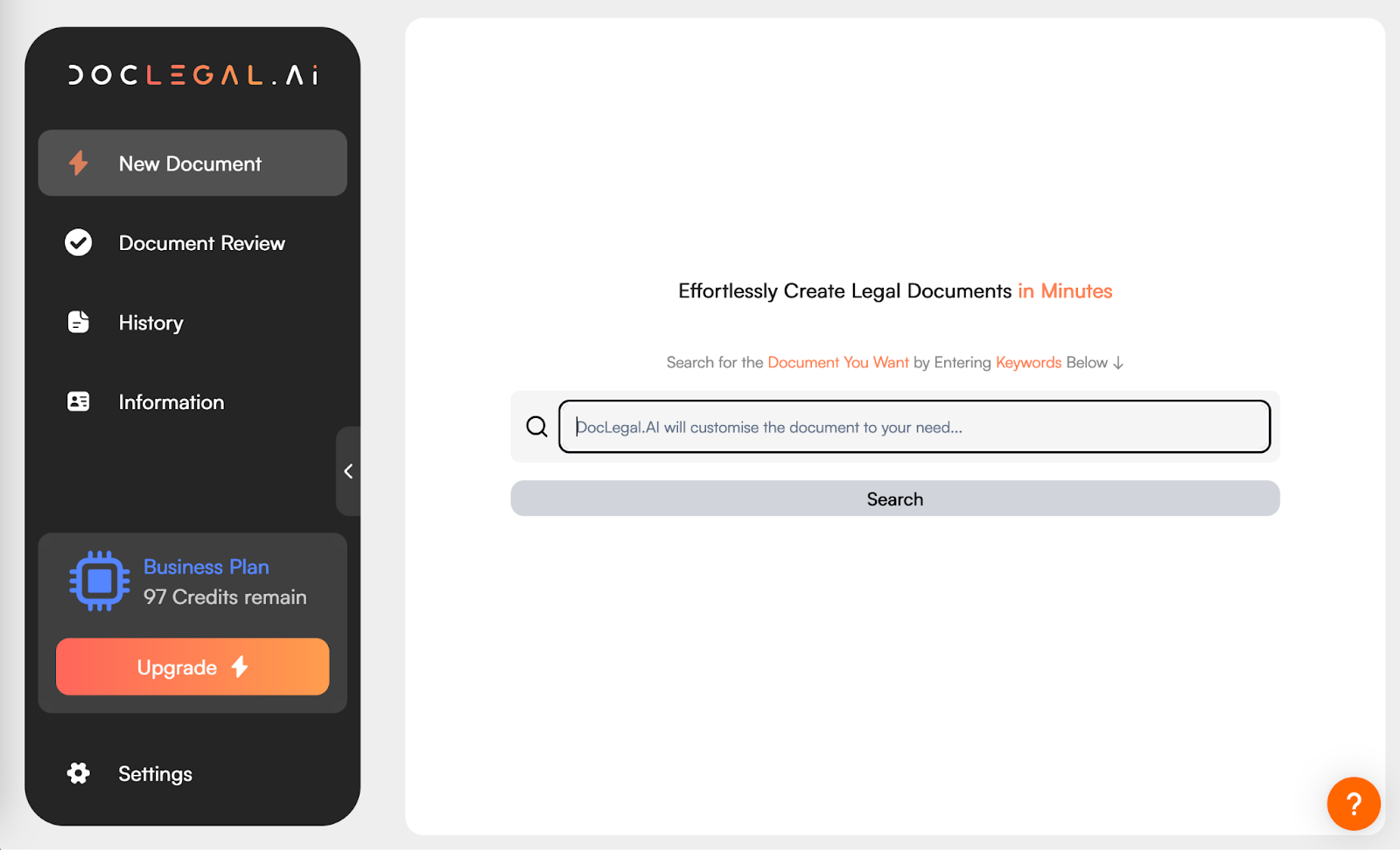
2. Search for and select the document which best suits your needs. For demonstration, let’s generate a document providing for the articles of association of a new company.
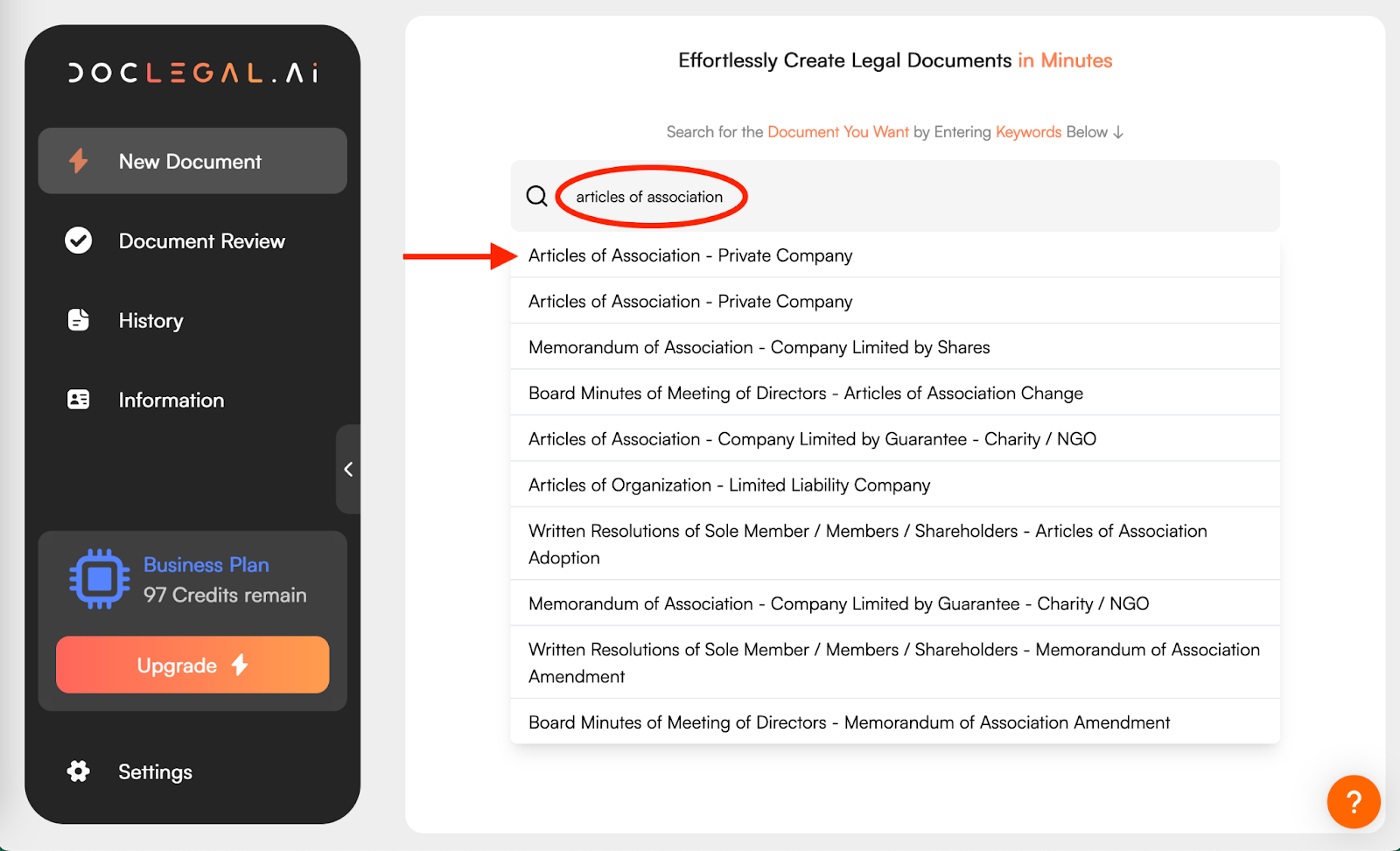
3. Describe the basic requirements of the document. You can edit the full document later on after seeing the draft agreement if you are unsure what to write at this stage.
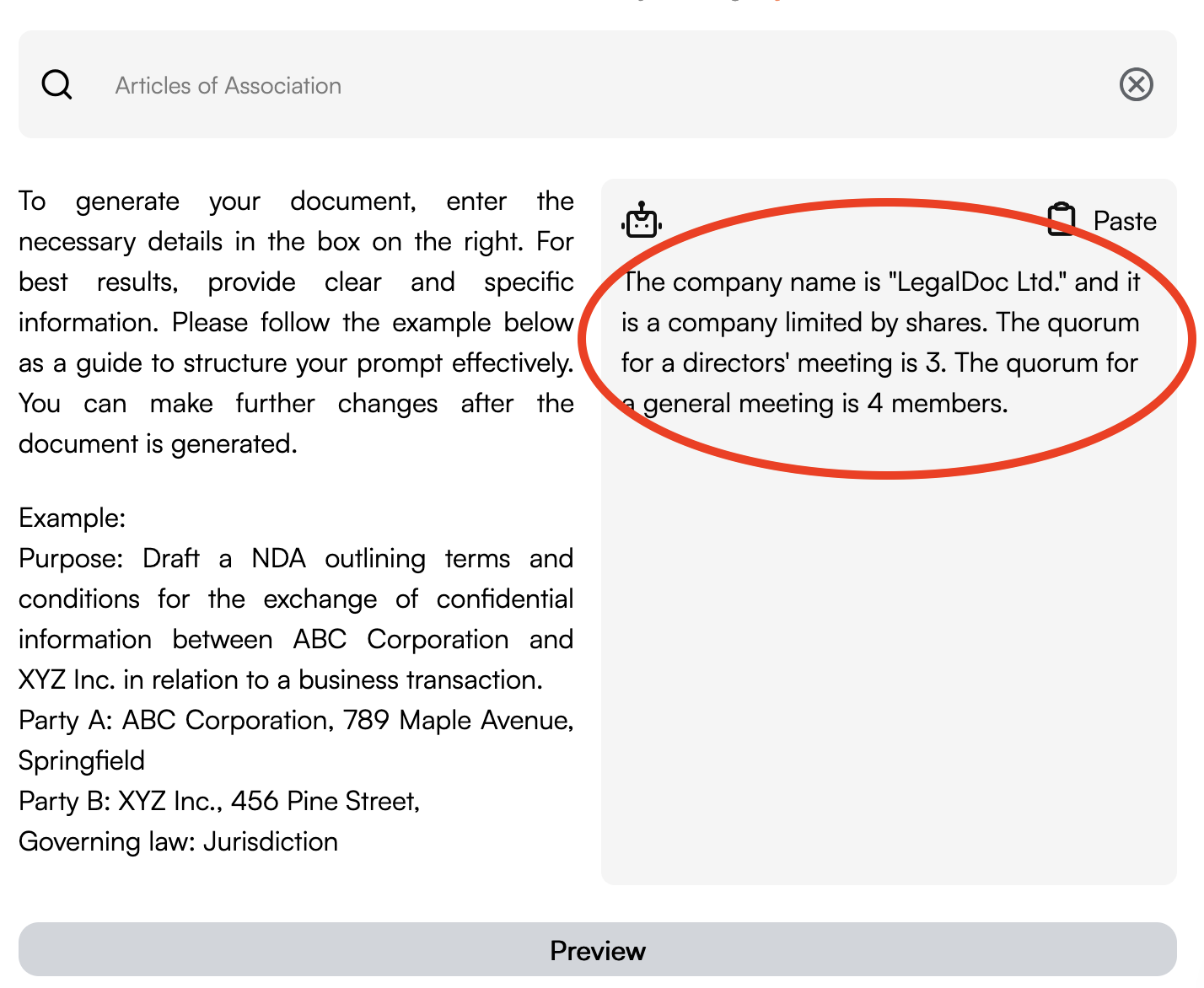
4. Click “Generate document” to generate the document draft, make further edits, and add more clauses.
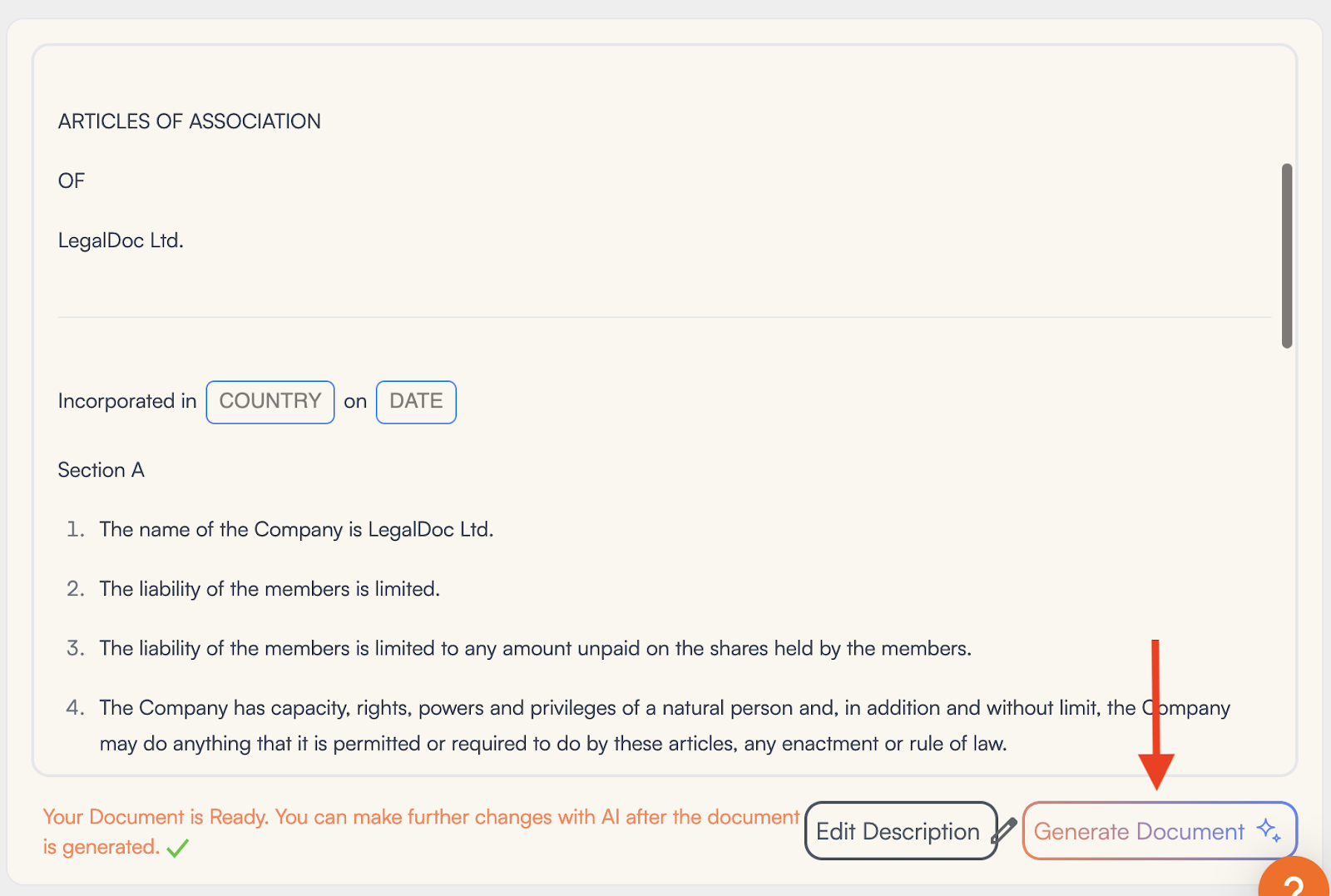
5. Use the “Document Review” chatbot to make further customisations to the document. When you are satisfied with the results, select “Proceed to Download” at the bottom right corner.
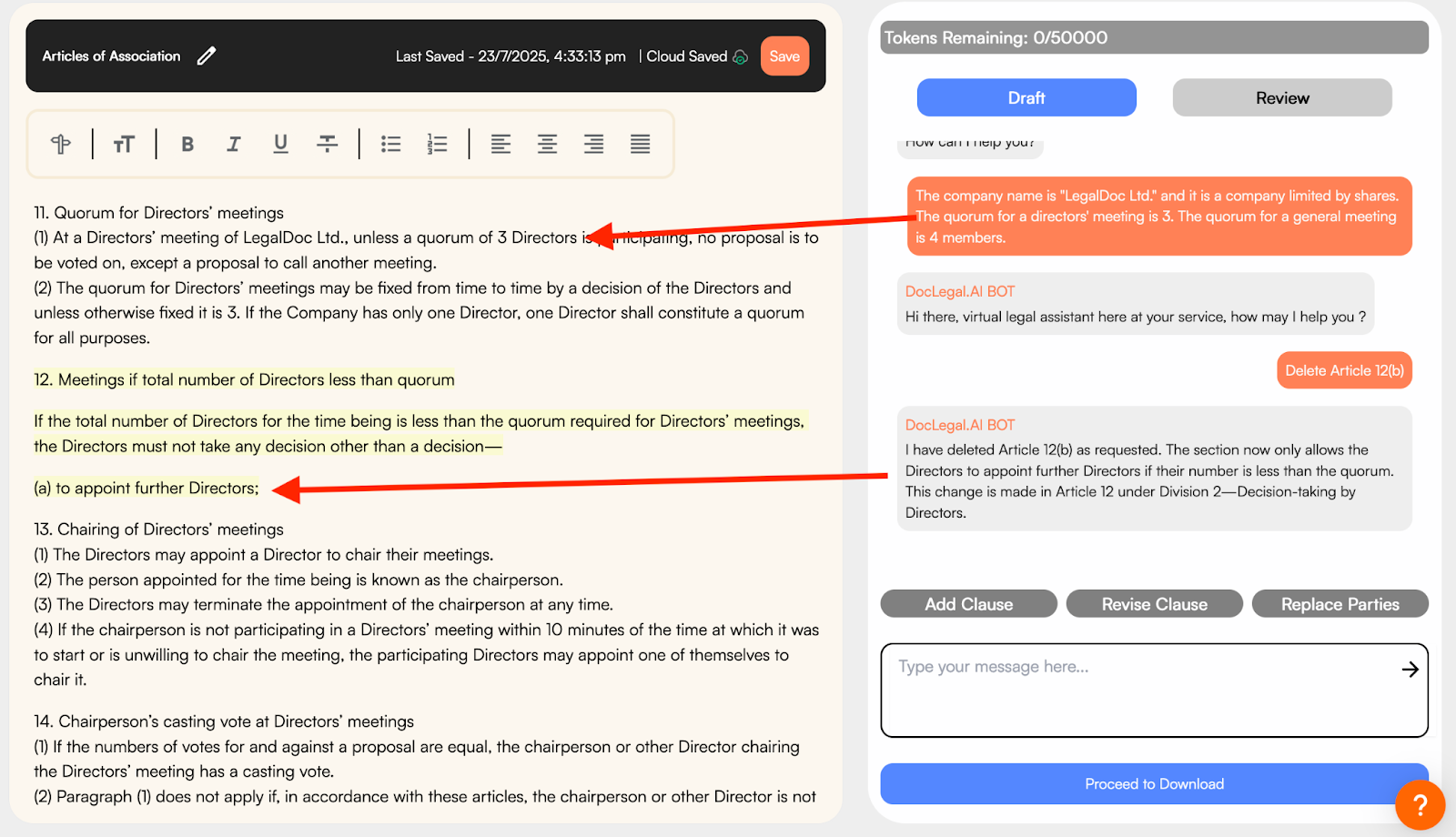
6. Select your preferred document format and download the finalised document! Tip: Downloading the document in Word or TXT file will allow further manual edits later on. Alternatively, download it as a PDF if you are satisfied with the document and do not wish to make any further manual changes.
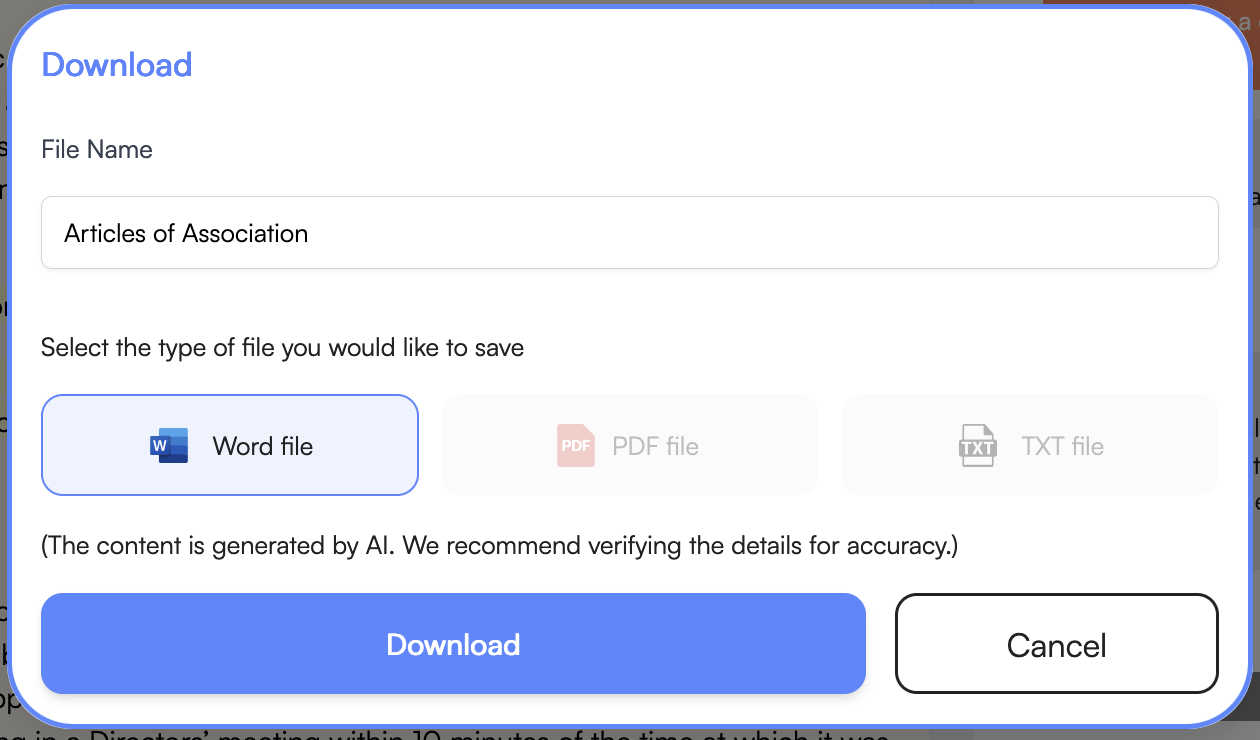
Types of startup incorporation documents on Doclegal.ai
Here are some examples of documents relevant to the incorporation process available on DocLegal.ai:
- Company Incorporation Checklist – Step-by-step guidance to ensure you complete all necessary steps.
- Articles of Association - The foundational rules governing your company’s operations and management.
- Operating agreement - Agreement detailing the management and operational structure (especially for LLCs or similar entities).
- Shareholders agreement - Contract outlining the rights and obligations of shareholders and how the company will be governed.
Frequently asked questions
“Can I upload my company's Articles of Association and use DocLegal.ai to customize it?”
Yes, you can! DocLegal.ai allows you to upload your company’s Articles of Association or other legal documents. Once uploaded, our AI-powered platform can help you analyze, summarize, and suggest customizations based on your requirements. This makes it easier to review and update your documents efficiently.
1. Can I change the articles of association after my company has been incorporated?
Yes. However, you must do this in compliance with the relevant laws in your jurisdiction concerning altering the company’s articles.
For example, under section 87(1) and sections 88(1)-(2) of the Companies Ordinance in Hong Kong, the alteration of articles requires a special resolution. This means that ≥75% of the company’s shareholding must vote to alter the articles.
There is also a template for ‘Written Resolutions of Sole Member / Members / Shareholders’ used to formally approve changes to the company’s Articles of Association and is available on DocLegal.ai.
2. Can I change the shareholders’ agreement after my company has been incorporated?
Like the answer above, you may change the agreement subject to compliance with the relevant laws in your jurisdiction concerning altering the company’s shareholders’ agreement.
3. DocLegal.ai has incorporation documents for companies limited by shares and companies limited by guarantee. What is the difference between these types of companies?”
A shareholder’s liability to the company (i.e. in case the company “fails” and creditors are chasing up on its debt) can be limited by shares or by guarantee.
Company limited by shares: a shareholder's liability for the company's debts is limited to any amounts unpaid on their shares
- For example, you bought five shares in the company which cost $100 in total. You already paid the full $100 to purchase those five shares, so your liability ends here. If the company goes under, creditors cannot chase you for any more money as a shareholder.
- What if you agreed to buy five shares for the same price, but instead paid in installments and only paid $80 so far? If so, you are still liable to pay the $20 unpaid on the shares. After this, the extent of your liability towards the company’s debts ends here.
Company limited by guarantee: a shareholder’s liability is limited to the specific amount the member undertakes (agrees) to contribute in the event of a winding-up (i.e. goes insolvent and creditors demand the company’s dissolution so that its assets can be used to satisfy debts). Companies limited by guarantee are often NGOs and charities, and thus are rarer than companies limited by shares.
4. What should founders watch out for when drafting shareholders’ agreements?
When founders draft shareholders’ agreements, there are several critical considerations to ensure the agreement is robust, fair, and minimizes future disputes. Here are some key points to consider:
- Clear Definition of Rights and Obligations
- Decision-Making and Deadlocks
- Transfer of Shares
- Management and Board Structure
- Exit Strategies
- Dispute Resolution
- Implied Terms and Fiduciary Duties
- Unfair Prejudice and Minority Protection
- Consistency with Company’s Articles
- Governing Law and Jurisdiction
5. Can a shareholders' agreement override articles of association?
A shareholders' agreement cannot override the articles of association in matters of the company's internal governance or in relation to third parties. The articles of association prevail in such circumstances. However, a shareholders' agreement may regulate the relationship between its parties and provide for remedies if breached, meaning that shareholders still owe personal obligations to one another based on the shareholders’ agreement which can be enforced by the shareholders between or among themselves. Still, a shareholders’ agreement cannot bind the company to act contrary to its articles.
6. Is the operating agreement the same as the articles of association?
No, an operating agreement is not the same as the articles of association.
In Hong Kong, the articles of association are the company’s primary constitutional document and registered with the Companies Registry. They govern the company's internal management, rights and obligations of members, and the relationship between the company, its shareholders, and directors.
An operating agreement (as it is called in some jurisdictions) is a private arrangement between shareholders, similarly to shareholders’ agreements. These are private contracts between shareholders that set out rules on management, voting, transfer of shares, etc., but do not replace or override the articles of association.

Integrating GenAI-Powered Legal Technology into Your Startup’s Business Model
Unlock efficiency with DocLegal.AI’s GenAI-powered legal tech. Automate document creation and review to save time and costs for your startup.
FOR STARTUPS
Integrating GenAI-Powered Legal Technology into Your Business Model
Non-contentious legal paperwork is a pain point for startups and small to medium-sized enterprises (SMEs). It’s all too often that traditional legal services are time-consuming and expensive. However, with the advent of generative artificial intelligence (GenAI), companies are now turning to tech-based solutions for document automation and management, reducing costs and saving time.
Let’s explore the benefits of integrating GenAI-powered legal technology into your business model.
The Business Model: Key Activities and Revenue Streams
At the crux of the business model is the value proposition and the key activities fundamental to its execution. Some commonly shared key activities across startups and SMEs include:
- Marketing
- Sales
- Production of Goods/Supply of Service
- Research and Development
Legal paperwork facilitates and regulates these key activities. It defines obligations and duties in B2B and B2C relationships, protects ownership rights, safeguards intellectual property arising from R&D, and more. Given its centrality to commercial practices, legal paperwork in this sphere is largely standardized, varied and edited depending on the needs of the business—needs you know best.
If you can streamline the process of legal paperwork, then you can expedite and optimize your key activities. Here’s how you can do this with DocLegal.AI:
Document Generation
DocLegal.AI can generate tailored, high-quality legal documents necessary for key activities. Examples include:
- Founder Advisor Agreement
- Non-Disclosure Agreement (NDA)
- Employment Contracts
- Service Agreements
- Partnership Agreements
- Terms and Conditions
- Privacy Policy
Document Review
DocLegal.AI enhances compliance and risk management of legal documentation with the following features:
- Highlight Risks: Uncover legal and other technical risks arising from your paperwork and their implications on your key activities.
- Summarize: Generate a summary of your legal paperwork to see whether it aligns with the goals and objectives of your key activities.
- Missing Clauses: Receive suggestions of additional clauses to ensure watertight contracts.
By supporting internal operations, DocLegal.AI can indirectly boost revenue streams through decreased legal expenses. This allows for resource reallocation towards strategic growth initiatives and reduces time-to-market for offerings.
Integrating GenAI-Powered Legal Technology is Easy
To optimize your business's key activities with GenAI-powered legal technology, consider these integration steps:
- Review and Assess Data Security
- Conduct thorough risk assessments
- Test the robustness of the technology's security
- Evaluate encryption methods and access controls
- Ensure compliance with relevant data protection regulations
- Thorough Employee Onboarding
- Develop a structured training program
- Cover both document generation and review features of DocLegal.AI
- Leverage the platform's user-friendly design for quick onboarding
3. Encourage Creativity and Innovation
- Promote exploration and experimentation with the platform
- Encourage employees to share innovative applications
- Establish a system for collecting and implementing valuable suggestions
4. Establish Clear Usage Guidelines
- Develop policies on when and how to use GenAI-powered legal tools
- Provide guidance on suitable documents for AI generation
- Clarify when human review is necessary
5. Monitor and Evaluate Performance
- Implement a system to track effectiveness
- Regularly assess metrics (time saved, error reduction, user satisfaction)
- Identify areas for improvement
Conclusion
Successfully integrating GenAI-powered legal technology into your business model will empower your team to autonomously generate and review legal documents with increased efficiency. This integration will also provide more time and resources for strategic growth and innovation.

AI vs. Human Lawyer Accuracy: How Does DocLegal.AI Work?
Unlock legal precision with DocLegal.AI! Effortlessly streamline contract drafting and review. Harness AI to boost accuracy and reduce errors. Transform your legal workflow today!
AI vs human lawyer accuracy: How does DocLegal.AI work?
The legal industry is undergoing a rapid transformation as artificial intelligence (AI) becomes an increasingly vital tool for drafting, reviewing, and managing legal documents. However, when reviewing legal documents, how does AI compare to human lawyers in terms of accuracy? Furthermore, what sets Doclegal.AI apart in this evolving landscape?
Key Steps Lawyers Take to Ensure Legal Accuracy
Ensuring the accuracy of legal documents is a meticulous process that demands both expertise and systematic attention to detail. Even minor errors can lead to misunderstandings, disputes, or legal liabilities. To safeguard accuracy, lawyers typically follow these critical steps:
- Conduct thorough legal research
- Verify all facts, citations, and references
- Use precise and unambiguous language
- Carefully review names, dates, clauses, and details
- Maintain comprehensive and organized documentation
- Collaborate with peers for review and incorporate client feedback
- Revise and proofread drafts multiple times
- Finalize and approve the document for use
How AI improves legal accuracy
AI-powered legal assistants are transforming traditional legal workflows. By utilising advanced algorithms and natural language processing, these tools can rapidly analyse vast amounts of legal data, identify relevant precedents, detect inconsistencies, and flag potential risks that may be overlooked during manual reviews. AI legal document solutions can help reduce human error, speed up research processes, and ensure that documents are accurate and compliant with current laws.
For instance, Doclegal.AI enables users to summarize complex contracts, highlight absent clauses, suggest improvements, and automatically update documents, which all through an intuitive AI chatbot, making legal workflows more reliable and efficient.
How DocLegal.AI works?
DocLegal.AI is tailored specifically for the legal industry, distinguishing itself from generic AI tools by prioritizing precision and reliability in the generation of legal documents. Each document is based on a comprehensive and up-to-date legal database, significantly reducing the risk of errors and inaccuracies often encountered in standard AI models.
With DocLegal.AI, users can easily generate contracts, agreements, and other legal documents by describing their needs in simple, plain language. The platform offers over 2,800 lawyer-reviewed templates and features advanced risk analysis, clause suggestions, and document summarization to provide accurate and tailored outputs for each situation. Additionally, the AI chatbot can identify potential risks or missing clauses, ensuring that every document meets high standards of legal accuracy and reliability.
How to Customize a Contract with DocLegal.AI?
- Start a New Document
- Describe Your Requirements
- Preview and Edit
- Further Customization
How to Use the Review Feature to Add Complex Clauses Quickly and Accurately?
- Access the Document Review Feature
- Add Complex Clauses
- Refine and Revise
- Review and Finalize
Will AI Replace Lawyers?
Despite AI’s impressive capabilities, the consensus among legal professionals is clear: AI will never replace human lawyers, but it will fundamentally change their roles. AI excels at automating repetitive, data-heavy tasks, like document drafting and review, allowing lawyers to focus on complex analysis, negotiation, and strategic decision-making that require human judgement and empathy. The future is a hybrid model, where AI handles the heavy lifting and lawyers provide oversight, context, and client-facing expertise.
Rather than making lawyers obsolete, AI legal solutions like DocLegal.AI free up professionals to deliver higher-value services.

Contracts 101: 6 Essential Elements of a Valid Contract
Dive into the six vital elements of a valid contract in this exciting 2025 guide! Uncover the power of offer, acceptance, consideration, and beyond, with insights on privity and unilateral contracts. A thrilling case study reveals the offer vs. invitation to treat showdown in action!
6 Essential Elements of a Valid Contract
Contracts form the backbone of society by establishing trust and minimising risks between parties. A contract involves an exchange of promises or actions where one party offers value in return for something from the other. Contracts are not always monetary; they can involve specific performance of obligations or agreements to refrain from certain actions, such as non-compete clauses. A valid contract creates legally binding obligations, allowing a party to pursue a civil claim for a breach. This article explores:
(A) the six essential elements of a valid contract,
(B) privity of contract,
(C) the significance of unilateral contracts, and
(D) additional considerations in contract law, followed by a case study.
A. 6 Essential Elements of a Valid Contract
Many assume a contract is formed once an offer is made and accepted, but more is required for legal enforceability. Contracts can be formal or informal, written or oral, yet must include specific elements to be binding.
What are the 6 essential elements of a valid contract?
A contract is valid and legally binding if the following six elements are present:
- Offer
- Acceptance
- Consideration
- Intention to create legal relations
- Legality and capacity
- Certainty
1. Offer
An offer is a clear, definite proposal with specific terms from one party to another, forming the foundation of a contract. The offer and acceptance framework identifies a "meeting of the minds," where parties agree on terms.
What is the difference between an 'Offer' and an 'Invitation to Treat'?
An offer can be accepted to form a binding contract, while an invitation to treat is an indication of willingness to negotiate and is not binding.
For example, a store displaying products with prices is an invitation to treat, inviting negotiation rather than committing to terms.
An invitation to treat becomes an offer only when its terms are clear, definite, and leave no room for further negotiation.
Examples of an 'Offer' and an 'Invitation to Treat'
An invitation to tender is typically an invitation to treat unless it explicitly states that the most competitive bid will be accepted, making it an offer. Advertisements are generally invitations to treat, but specific promises with clear terms can constitute offers, as seen in unilateral contracts.
2. Acceptance
Acceptance is an unqualified agreement to an offer’s terms, expressed through words or conduct. A counteroffer, altering the original terms, does not constitute acceptance.
Acceptance must typically be communicated to the offeror, and silence is generally not acceptance, except in rare cases where prior dealings imply consent through conduct.
3. Intention to Create Legal Relations
Both parties must intend the agreement to be legally binding. Agreements labelled "subject to contract" or lacking clarity on essential terms may not be enforceable.
Domestic or social agreements are often presumed not to be legally binding, and agreements to agree in the future may be void due to a lack of intention.
4. Consideration
Consideration is essential for a contract’s enforceability, involving something of value given by the promisee (a benefit to the promisor or detriment to the promisee).
Consideration need not be of equal value, but must exist. If absent, the agreement must be formalised as a deed, which requires specific execution, such as being under seal.
5. Legality and Capacity
What renders a contract illegal?
A contract is illegal and unenforceable if it involves an unlawful purpose, such as fraud or illegal activities. A severability clause can ensure that if one provision is illegal, the rest of the contract remains valid.
Who has the capacity to contract?
The law presumes capacity to contract, but minors (typically under 18) and mentally disordered individuals may lack full capacity. Minors can contract for "necessaries" (essential goods or services), and failure to pay can lead to a breach claim. Contracts with mentally incapable individuals are generally void unless they grant power of attorney to another party.
6. Certainty
A contract requires reasonably certain essential terms, such as price or consideration, to be enforceable. If these terms are unclear, the contract may be void. Courts may fill gaps in commercial contracts using mechanisms like prior dealings or implied terms, provided there is intent to be legally bound.
B. Who Can Enforce The Terms Of A Contract?
Privity of contract is a principle stating that only parties to a contract can enforce its terms or be subject to its obligations. Third parties cannot sue or be sued, even if the contract benefits them. For example, if Party A promises Party B to give a gift to Party C, Party C cannot enforce the promise.
However, in some regions, third parties may have statutory rights to enforce contract terms if the contract expressly allows it or confers a benefit on them. Parties can opt out by including a clause excluding third-party rights.
C. Types of Contracts - Unilateral Vs. Bilateral Contracts
- Unilateral Contracts
Unilateral contracts involve a promise in exchange for performance, where only one party makes a commitment until the other performs the requested act. A typical example of a unilateral contract is a reward poster for finding a lost dog. The owner of the dog promises to pay, but only if another person is able to find his/her lost dog.
Key Features of Unilateral Contracts
- Offer Open to the Public: Unilateral offers can be made to the general public, not a specific individual.
- Acceptance by Performance: The offeree accepts by completing the requested act, not by promising to do so.
- Revocation Limitations: In some jurisdictions, once the performance begins, the offeror may not revoke the offer if the offeree is reasonably acting in reliance on it.
- Bilateral Contracts
Bilateral contracts are agreements where both parties exchange mutual promises, each committing to fulfil specific obligations. Unlike unilateral contracts, which are binding only upon performance, bilateral contracts create obligations for both parties from the moment the agreement is formed. These contracts are the most common type in business and personal transactions, as they involve a mutual exchange of commitments, such as in sales agreements, leases, or employment contracts.
Key Features of Bilateral Contracts
- Mutual Obligations: Both parties are bound by their promises to perform specific actions, creating reciprocal duties.
- Acceptance by Promise: The contract is formed when both parties exchange promises, not when an act is performed.
- Revocability Before Performance: Either party may revoke the offer before acceptance, but once promises are exchanged, the contract is binding unless mutually agreed otherwise or specific legal conditions allow termination.
Comparison of Unilateral and Bilateral Contracts
Aspect
Unilateral Contract
Bilateral Contract
Nature of Commitment
One party makes a promise; the other performs an act.
Both parties exchange mutual promises.
Acceptance
Through performance of the requested act.
Through a promise to perform.
Obligation
Only the offeror is bound until performance occurs.
Both parties are bound upon exchanging promises.
Common Examples
Reward offers, contests, or promotional deals.
Sales agreements, leases, employment contracts.
Revocation
Cannot be revoked once performance begins.
Revocable before acceptance; binding after.
Parties Involved
Can be open to the public or a specific person.
Typically involves specific parties.
D. Additional Considerations in Contract Law
1. Misrepresentation
A contract may be voidable if one party makes a false statement of fact that induces the other to enter the contract. Misrepresentation must be material and relied upon by the other party.
2. Estoppel
Promissory estoppel may prevent a party from retracting a promise if the other party has relied on it to their detriment, even if no formal contract exists.
3. Unjust Enrichment
If one party benefits at another’s expense without a valid contract, courts may require restitution to prevent unjust enrichment, though this is not a contract law remedy.
4. Breach and Remedies
A breach occurs when a party fails to perform contractual obligations. Remedies include damages, specific performance, or injunctions, depending on the breach’s nature.
Frequently Asked Questions (FAQs)
- Can a contract without consideration be enforced?
No, a contract lacking consideration is unenforceable unless formalised as a deed, which requires specific execution. - What is valid acceptance of a contract?
Valid acceptance is unconditional, clearly communicated, and aligns with the offer’s terms, expressed through words or conduct. - How can ambiguity in a contract be avoided?
Use clear language, include essential terms, and reflect both parties’ intentions. A checklist of clauses can help. - Is a contract signed by an intoxicated person valid?
If intoxication impairs understanding, the contract may be voidable, requiring the intoxicated party to revoke it. - Can a minor enter a valid contract?
Minors can contract for necessaries. Other contracts may be voidable at their discretion. - What happens if a contract term is illegal?
An illegal term may void the contract unless a severability clause preserves other provisions. - Does silence constitute acceptance?
Generally, silence is not acceptance unless prior dealings or conduct imply consent. - Can third parties enforce a contract?
In some regions, third parties can enforce terms if the contract allows or benefits them, unless excluded. - What is the difference between a deed and a contract?
A deed is a formal document under seal, not requiring consideration, while a contract requires consideration and mutual agreement.
Case Illustration - Offer vs Invitation to Treat
Background
Imagine Company X, a renowned music event organiser, launches a vibrant campaign to promote an exclusive concert featuring a world-famous artist. Eye-catching posters are displayed across city billboards, proclaiming: “Ultimate Concert Experience! Limited VIP Passes at $600 each, including backstage access. Only 100 passes available—grab yours now!”. To emphasise its commitment, Company X posts on its social media that it has reserved $60,000 in a dedicated account to ensure pass availability.
Individual Y, a passionate music fan, sees the poster and rushes to Company X’s online ticketing platform to purchase two VIP passes. The website indicates that the passes are sold out due to overwhelming demand. Disheartened, Individual Y submits their contact information through a waitlist form, hoping for additional passes. Later that day, Company X sends Individual Y a direct message: “Great news! We’ve released two extra VIP passes for the concert at $600 each. Reply by 10 PM tonight to secure them.” Excited, Individual Y responds within an hour, stating, “I’m in! I’ll take both passes and pay via your website tomorrow morning.”
When Individual Y attempts to complete the payment the next day, Company X informs them that the passes were mistakenly offered and have already been sold to another buyer, claiming the message was only an invitation to treat.
Analysis
This scenario highlights the critical distinction between an invitation to treat and an offer, evaluated through the six essential elements of a contract:
- Offer: The billboard posters are an invitation to treat, designed to attract interest without guaranteeing availability to all. They invite potential buyers to make offers, which Company X can accept or reject. However, the direct message to Individual Y is a clear and definite offer, specifying two VIP passes at $600 each with a 10 PM deadline for acceptance. The $60,000 reserve announced on social media reinforces Company X’s intent to be bound, distinguishing the message from a mere invitation to treat.
- Acceptance: Individual Y’s response, “I’m in! I’ll take both passes and pay via your website tomorrow morning,” is an unambiguous acceptance of the offer’s terms, communicated within the specified deadline. The offer did not require immediate payment as a condition of acceptance, so Individual Y’s commitment to pay the next day is sufficient.
- Consideration: Consideration exists in Individual Y’s promise to pay $1,200 for the two VIP passes (a benefit to Company X) in exchange for the passes, including backstage access (a benefit to Individual Y). The agreement to pay upon collection satisfies the requirement for consideration.
- Intention to Create Legal Relations: The direct message’s formal tone and the public announcement of the $60,000 reserve demonstrate Company X’s intent to create a legally binding agreement, countering their claim that it was merely promotional.
- Legality and Capacity: The purpose of th contract—selling concert passes—is lawful, and Individual Y, as a competent adult, has the capacity to contract.
- Certainty: The offer’s terms are clear: two VIP passes at $600 each, with a specific deadline for acceptance. No essential terms are ambiguous, ensuring the contract’s enforceability.
In this case, Company X’s argument that the direct message was an invitation to treat is weak, as the message’s specific terms and deadline indicate a clear offer. Similarly, their claim that immediate payment was required for acceptance lacks merit, as the offer did not stipulate this condition. In a bilateral contract like this, acceptance is completed through clear communication of agreement, not performance (such as payment). Therefore, Individual Y’s timely response formed a binding contract, and Company X’s refusal to provide the passes after allocating them to another buyer constitutes a potential breach. Individual Y could seek remedies, such as damages for the cost of comparable passes or, if the passes are unique, specific performance to compel delivery.
This scenario illustrates the importance of distinguishing between broad promotional invitations and specific offers in commercial transactions. Businesses must craft communications carefully to avoid unintended contractual obligations, particularly in direct interactions with consumers.
Need Help Drafting Your Contract?
If you’re ready to create a contract that’s legally sound, clear, and customised to your unique needs, DocLegal.AI has you covered. Our AI-powered platform makes it simple to generate professional contracts and other legal documents, ensuring you stay protected and compliant without the hassle. Get started with DocLegal.AI today and take the stress out of crafting agreements for your business ventures!

What is an IP Assignment Agreement?
Intellectual Property (IP) is a valuable asset for individuals and businesses alike, and securing its ownership through legal means is crucial. One of the most common ways of transferring ownership of intellectual property is through an IP Assignment Agreement.
What is an IP Assignment Agreement? Meaning & Templates
Intellectual Property (IP) is a valuable asset for both individuals and businesses, and securing its ownership through legal means is crucial in protecting IP rights. Among all of the methods of transferring ownership of IP, one of the most common ways is through an IP Assignment Agreement. Whether you’re in the US or any other region, understanding the IP Assignment Agreement meaning is essential for safeguarding your intellectual assets.
In this article, we will explore the meaning of an IP Assignment Agreement, provide you with an IP Assignment Agreement template, and discuss its role in business transactions.
What is IP Assignment?
IP Assignment refers to the complete and permanent transfer of ownership rights from the original holder (the "Assignor") to a new owner (the "Assignee"). This process is typically used when the creator of the intellectual property wishes to assign the rights to another individual, business, or organization. It could involve patents, copyrights, trademarks, or trade secrets. In the US, this process is a fundamental step in ensuring the intellectual property is legally protected and transferred according to the legal frameworks of the region.
Through a valid IP Assignment, the assignee gains full rights over the IP, which can be used for commercial purposes, license it to third parties, sue for infringement, and development. It’s an essential document for protecting the interests of both parties involved in the transfer.
What is an IP Assignment Agreement?
An IP Assignment Agreement is a legal contract that transfers the rights of IP from one party to another party ; or in other words, assign the IP from assignor to assignee. The IP assignment agreement meaning is to create a clear, written record of this transfer of ownership. The agreement outlines the details of the IP being transferred, including its nature, rights, and any compensation involved. This is particularly important in the US, where intellectual property laws play a crucial role in business operations.
Key Elements of an IP Assignment Agreement
When creating an IP Assignment Agreement, certain elements must be included to ensure clarity, legality, and enforceability. Here are the key elements typically found in an IP Assignment Agreement template:
- Description of the Intellectual Property: Clearly specify what IP is being transferred. This could include patents, trademarks, designs, or other IP assets.
- Identification of the Parties: The agreement must clearly state the full legal names and addresses of both the Assignor (the current owner) and the Assignee (the new owner).
- Consideration: The agreement should outline any compensation or consideration for the IP transfer.
- Transfer of Rights: A clear statement that the rights to the IP are being assigned fully and without reservation.
- Warranties and Representations: The Assignor should typically warrant that they are the sole owner of the IP, that they have the full right and authority to assign it, and that the IP is free from any liens, encumbrances, or third-party claims.
- Duration and Termination: Any timeframes for the assignment, and terms for termination if necessary.
These elements are necessary to ensure that both the assignor and assignee are clear about the terms of the agreement and can proceed with confidence. In the US, having a well-drafted IP Assignment Agreement is crucial for compliance with intellectual property laws.
Benefits of Using an IP Assignment Agreement
Using an IP Assignment Agreement provides several benefits, both legal and financial. Here’s why creating or using an IP Assignment Agreement template is crucial:
- Legal Clarity: An IP Assignment Agreement offers legal clarity and prevents any future disputes regarding ownership. In the US, having legal clarity ensures your intellectual property rights are respected.
- Protection of Intellectual Property: By clearly stating who owns the IP and under what conditions, the assignment protects both parties involved.
- Facilitates Business Transactions: In the case of mergers, acquisitions, or business partnerships, IP assignments are essential to ensure that intellectual property is properly transferred to the new owners.
- Compliance with Legal Standards: A properly drafted IP Assignment Agreement ensures compliance with intellectual property laws, offering legal protection if disputes arise, particularly in the US where IP laws are strictly enforced.
IP Assignment Agreement Template
Below is an IP Assignment Agreement template that can be used for transferring intellectual property rights. It is important to customize the template according to the specifics of your situation, including the nature of the intellectual property and the details of the agreement.
This IP Assignment Agreement ("Agreement") is entered into on [Date], by and between:
Assignor:
Name: [Full Name]
Address: [Address]
Phone: [Phone Number]
Email: [Email Address]
Assignee:
Name: [Full Name or Company Name]
Address: [Address]
Phone: [Phone Number]
Email: [Email Address]
Recitals
WHEREAS, the Assignor is the sole and exclusive owner of certain intellectual property (the "Intellectual Property") as described below:
[Description of IP: Patents, trademarks, copyrights, etc.]
WHEREAS, the Assignor wishes to assign, transfer, and convey all rights, title, and interest in and to the Intellectual Property to the Assignee;
NOW, THEREFORE, in consideration of the mutual covenants and promises herein, the parties agree as follows:
1. Assignment of Intellectual Property
1.1 The Assignor hereby assigns, transfers, and conveys to the Assignee all rights, title, and interest in and to the Intellectual Property described above, including all associated rights to use, license, or assign the Intellectual Property.
1.2 The assignment includes all rights to the Intellectual Property, including but not limited to:
The right to reproduce, distribute, and display the intellectual property.
The right to license and sublicense the intellectual property.
The right to sue for infringement of the intellectual property.
2. Consideration
2.1 In consideration for this assignment, the Assignee agrees to pay the Assignor the sum of [Amount].
2.2 The payment shall be made on [Payment Date] via [Payment Method].
3. Warranties and Representations
3.1 The Assignor warrants that they are the sole and exclusive owner of the Intellectual Property and that the Intellectual Property is free from any liens, encumbrances, or claims by any third party.
3.2 The Assignor warrants that they have the full right and authority to assign the Intellectual Property under this Agreement.
3.3 The Assignee acknowledges that they are acquiring the Intellectual Property "as is" and that no further warranties are provided by the Assignor.
4. Confidentiality
4.1 Both parties agree to keep confidential all proprietary information exchanged under this Agreement, including the terms of the Agreement and any information regarding the Intellectual Property.
5. Governing Law
5.1 This Agreement shall be governed by and construed in accordance with the laws of [Jurisdiction]. In the US, this typically refers to the applicable federal and state laws.
6. Execution
6.1 This Agreement is executed as of the date first written above and shall be binding upon the Assignor and Assignee and their respective successors, legal representatives, and assigns.
Assignor:
Signature: _______________________________
Name: [Full Name]
Date: _________________________________
Assignee:
Signature: _______________________________
Name: [Full Name or Company Name]
Date: _________________________________
Why You Should Use DocLegal.AI for IP Assignment Agreements
DocLegal.AI offers an easy-to-use online platform to generate customized IP Assignment Agreements. With DocLegal.AI’s legal agreement generator, you can quickly create an IP Assignment Agreement tailored to your specific needs. Whether you're based in the US or elsewhere, our platform can help you streamline the process of transferring intellectual property rights.
Ready to create your IP Assignment Agreement? Visit DocLegal.AI now to start customizing your agreement with our online tool.
Common Scenarios Where an IP Assignment Agreement is Used
An IP Assignment Agreement is commonly used in business contexts. Below are some examples of scenarios in which you might need to use this agreement:
1. Employee Inventions:
Often, companies require employees to assign any IP created during the course of employment to the company. This ensures the business retains ownership of intellectual property. In the US, this practice is widely accepted and common.
2. Freelancer Agreements:
Freelancers or contractors who create intellectual property for clients may need to transfer ownership of their creations through an IP Assignment Agreement.
3. Mergers & Acquisitions:
When one business acquires another, an IP Assignment Agreement is used to transfer the acquired company’s intellectual property to the new owner. This is especially critical in the US during corporate transactions.
4. Licensing and Patents:
In some cases, businesses may assign ownership of certain patents or trademarks in exchange for licensing agreements or other business arrangements.
Why an IP Assignment Agreement Matters for Your Business
Understanding what an IP Assignment Agreement is and its meaning is critical for any business dealing with intellectual property. Whether you are an entrepreneur, a freelancer, or a corporation in the US, transferring IP ownership correctly through an IP Assignment Agreement template helps avoid future disputes and protects your legal rights.
Draft your own IP Assignment Agreement with DocLegal.AI
Ready to draft your own IP Assignment Agreement? Start with DocLegal.AI, your trusted legal document generator tool. Quickly customize your agreement with the ease and reliability of AI-powered technology. Get in touch with us today to ensure your IP is securely assigned with the right legal backing.
Start creating your IP Assignment Agreement today with DocLegal.AI! Click here to learn more about our services and pricing.

SaaS Agreements Simplified: Meaning, Legal Issues, Examples & Template
In today’s fast-paced digital world, Software as a Service (SaaS) has become a go-to solution for many businesses in the United States and globally. SaaS refers to software applications hosted in the cloud and offered to customers on a subscription basis. This cloud-based model allows businesses to access software without having to maintain expensive infrastructure. From customer relationship management tools like Salesforce to accounting solutions, SaaS products are integrated into everyday business operations across all industries.

SaaS Agreements Simplified: Meaning, Legal Issues, Examples & Template
Software as a Service (SaaS) refers to software applications hosted in the cloud and offered to customers on a subscription basis. From customer relationship management tools like Salesforce to accounting solutions, SaaS products are integrated into everyday business operations across all industries. It has become a go-to solution for many business in the United States and globally, due to its convenience and low-cost, as it allows businesses to access software without having to maintain expensive infrastructure.
This article will introduce SaaS agreements by explaining their meaning, highlighting key legal issues involved, providing SaaS agreements examples, and offering a template to guide businesses and users.
What is a SaaS Agreement?
A SaaS agreement is a legally binding contract between a SaaS provider and the customer. The agreement establish the relationship between the two parties by laying out the ground rules for how the customer can log in and use the service. More importantly, the agreement define rights, obligations, and expectations regarding the software.
What is the meaning of a SaaS Agreement and why it is important
As mentioned above, the SaaS agreement refers to how the software will be delivered, how it will be maintained, and how both the provider and the customer can fulfill their responsibilities.
SaaS agreements are crucial in preventing potential legal issues, setting clear service expectations, and providing a framework for dispute resolution:
For SaaS vendors, these agreements help ensure that their software is used within the agreed terms. This can effectively protect their intellectual property, and more importantly reduce liability risks. On the other hand, for customers, a SaaS agreement ensures clear expectations around service access, privacy, and data security, safeguarding both parties from possible disputes.
Key Differences Between SaaS Agreements and Traditional Software Licenses
While traditional software licenses allow customers to install and run software on their own systems, SaaS agreements operate on the premise that the software is hosted on the provider’s servers and accessed remotely. This difference introduces several unique factors:
- (1) Subscription Model: SaaS agreements usually operate on a subscription model, whereas traditional software licenses often involve a one-time payment.
- (2) Access vs. Ownership: In a traditional license, the customer owns the software and has the right to use it indefinitely. In SaaS agreements, however, the customer merely receives access to the service but does not own the software.
- (3) Updates and Maintenance: In SaaS agreements, the provider is responsible for updates and maintenance, which occur automatically and without customer intervention, unlike traditional software that requires manual updates.
Typical SaaS Agreement Structure
A typical SaaS agreement spells out all the essentials up front, so there are no surprises down the road. These sections help prevent legal disputes and clarify the operational aspects of the service. Having a solid SaaS agreement template can ensure that all necessary details are included to avoid misunderstandings between both parties.
1. Software Usage Rights
Software usage rights layouts what the customer can and cannot do with the software. Typically, it includes limitations on how the software can be used and whether the customer has the right to sublicense or modify the software.
2. Subscription Models
As mentioned, a SaaS agreement usually operates on a subscription model. It is therefore important to figure out how one shall pay for the subscription; whether it’s month-to-month, yearly, or pay-as-you-go. This section also cover pricing details, payment schedules, and any discounts or trial periods offered.
3. Access and Licensing Terms
Here, the terms regarding the customer’s access to the software are defined, including whether it’s hosted in the cloud or delivered as a service. It also specifies the license granted to the customer, including any restrictions on use.
Legal Issues in SaaS Agreements
While SaaS agreements help protect both parties, they must also address various legal issues to ensure compliance with local and international laws. Here are some of the most important legal issues in SaaS agreements:
Data Privacy and Protection Requirements
SaaS agreements legal issues often involve how customer data is handled, especially considering the growing importance of data protection laws like GDPR (General Data Protection Regulation) and CCPA (California Consumer Privacy Act). Compliance with these regulations is crucial, and the agreement should specify how data will be collected, processed, stored, and protected, outlining the steps the provider will take to ensure compliance with data protection laws.
Cross-Border Data Transfer and Storage
As SaaS products are often used globally, data frequently crosses borders. The SaaS agreement must specify how these cross-border data transfers are handled, ensuring compliance with international data protection laws, especially for customers in countries with stringent data privacy regulations.
Vendor and Customer Obligations
The SaaS agreement must clearly outline the obligations of both the vendor and the customer. This includes uptime guarantees, customer support expectations, and data protection responsibilities. It should also specify the customer’s obligations in terms of payment, data accuracy, and compliance with usage restrictions.
Managing Cybersecurity Risks and Breach Notification
Cybersecurity is a key concern in SaaS agreements legal issues. The agreement should define the provider’s obligations to maintain a secure environment and outline what happens if a data breach occurs. It should also detail how the provider will notify the customer in case of a breach and what remedial actions will be taken.
Intellectual Property and Ownership Disputes
SaaS agreements need to clearly define the ownership of the software, data, and any customizations made to the service. Intellectual property rights should be explicitly stated to avoid confusion or disputes over who owns the software or any data generated by its use.
Risks of Non-Compliance and Potential Penalties
Non-compliance with regulations like GDPR can lead to substantial fines. The SaaS agreement should specify how both parties will manage compliance obligations and what penalties may arise in case of a breach, particularly with respect to data privacy and intellectual property.
SaaS Agreements Examples
Different types of SaaS agreements exist depending on the scale of the business and the nature of the service. Here are some examples of common SaaS agreements:
(1) Basic SaaS Agreement for Small Businesses tend to be simpler, with terms that cover basic service access, pricing, and support. Small businesses may not require extensive service level agreements (SLAs) or complex data management provisions, making these agreements more straightforward.
(2) Enterprise SaaS Agreements are more complex, often involving multiple departments or global operations. These agreements typically include detailed SLAs, more robust data management clauses, and specific custom features tailored to the needs of large organizations.
(3) Free Trial Agreements govern the terms under which a customer can try the software before committing to a paid subscription. The agreement usually defines the duration of the trial, access limitations, and what happens when the trial ends, including how the customer can transition to a paid plan.
(4) Reseller SaaS Agreement allow third parties to resell the SaaS service to end users. These agreements typically include terms about pricing, support, and the reseller’s responsibilities in terms of marketing and customer service. It’s a win-win: SaaS vendors expand their reach, and resellers get to offer more solutions to their customers.
How to use DocLegal.ai when you encounter SaaS Agreements
Imagine: A mid-sized logistics company (ABC) recently received a SaaS vendor’s contract for access to their contract management platform. Understanding the meaning of a SaaS agreement and the potential risks hidden in standard vendor templates, ABC turned to DocLegal.ai to ensure the terms were fair and didn’t expose them to unnecessary risk.
(1) With DocLegal.ai's contract review feature, the company easily uploaded the vendor’s SaaS contract to the system. The AI chatbot reviewed the contract and within minutes it highlighted the high risk provisions in the contract.
For instance:
- Limitation of Liability: The SAAS vendor limited their liability to a maximum of $5,000 regardless of damages even if a platform failure caused significant business disruption or data loss.
- One-sided Indemnity Clause: The contract had a unilateral indemnity provision requiring the customer to indemnify the vendor only.
(2) DocLegal.ai also offered smart recommendations to revise the language. By using it's ‘revise clause’ feature, ABC was able to:
- Increase the liability cap
- Add specific protections for data loss and business interruption.
- Make the indemnity clause mutual rather than one-sided.
All of this was done within minutes. Using Doclegal.ai, ABC company avoided signing a one-sided contract without hiring expensive outside counsel or spending weeks negotiating.
To learn more about how DocLegal.ai simplifies the review and negotiation of SaaS agreements, visit DocLegal.ai.
How can you create SaaS Agreement using our Template?
Creating a SaaS agreement template from scratch can be time-consuming and challenging. Using a template can ensure consistency and legal protection, helping businesses quickly draft agreements that cover all essential legal aspects. A SaaS agreement template serves as a starting point for drafting contracts quickly and efficiently. It ensures that all critical terms are included and helps businesses avoid legal issues that could arise from overlooking essential clauses.
What should be included in a typical SaaS Agreement?
1. Parties and Purpose: Identifying the provider and the customer and outlining the purpose of the agreement (providing cloud-based software) is crucial.
2. Scope of Service: You are advised to define the software provided, including specific features, support levels, and availability.
3. Subscription and Payment Terms: The agreement should specify the pricing model, payment terms, renewal schedules, and any applicable trial periods or discounts.
4. Data Privacy and Security: The agreement shall layout details of how data will be handled, protected, and stored, as well as its compliance with relevant privacy laws.
5. Limitation of Liability: An SaaS agreement shall layout the extent of liability for both parties in case of service failure or other issues.
6. Termination: Specifies the conditions under which the agreement can be terminated and the obligations that survive termination, such as data retrieval.
7. Miscellaneous: Includes legal clauses such as governing law, dispute resolution procedures, and force majeure clauses.
Example: A General SaaS Agreement Template
(With Doclegal.ai, you can generate a more comprehensive SAAS agreement that is approved by lawyers.)
Last Updated: [Date]
This Software as a Service (SaaS) Agreement (“Agreement”) is entered into on [Effective Date] by and between:
[Vendor Name], a [State/Country] corporation with its principal office at [Address] (“Vendor”); and [Customer Name], a [State/Country] corporation with its principal office at [Address] (“Customer”).
1. Purpose
The purpose of this Agreement is to outline the terms and conditions under which the Provider will offer access to the software product described below to the Customer.
2. Definitions
For the purposes of this Agreement:
“Software” refers to the software application provided by the Provider and hosted on the Provider’s servers, which the Customer may access via the internet.
“Subscription” refers to the Customer’s right to access and use the Software for a specified period, typically [monthly/annually], as outlined in the Payment Terms below.
3. Scope of Service
The Provider agrees to provide the Customer with access to the following Software: [Software Name].
The Software will be made available to the Customer via the internet on a cloud-based platform hosted by the Provider.
The Provider will ensure that the Software is accessible [99.9%] of the time, excluding scheduled maintenance or downtime due to unforeseen technical issues.
4. Subscription and Payment Terms
Subscription Fee: The Customer agrees to pay a subscription fee of [Subscription Fee Amount] per [month/year] for access to the Software.
Payment Method: Payments will be made via [Payment Method, e.g., credit card, bank transfer].
Billing Cycle: Payments will be invoiced [monthly/annually] in advance and are due by [due date].
Late Payment: Any payments not received by the due date will incur a [Late Fee Percentage] late fee.
Renewal: This Agreement will automatically renew for subsequent [monthly/annual] periods unless either party provides written notice of termination at least [Notice Period] days before the renewal date.
5. Data Privacy and Security
The Provider agrees to comply with applicable data protection laws, including [Data Protection Law, e.g., GDPR, CCPA].
The Provider will take reasonable measures to protect the Customer’s data and prevent unauthorized access.
The Customer acknowledges that they own their data, and the Provider will only use it for the purposes described in this Agreement.
6. Intellectual Property
The Provider retains ownership of all intellectual property rights related to the Software.
The Customer is granted a limited, non-transferable, non-exclusive license to use the Software during the term of this Agreement.
The Customer may not modify, reverse engineer, or sublicense the Software.
7. Support and Maintenance
The Provider will provide technical support during normal business hours via [Support Method, e.g., email, phone, live chat].
The Provider will also perform necessary updates and maintenance to ensure the Software functions correctly. Scheduled downtime will be communicated to the Customer in advance.
8. Limitation of Liability
The Provider’s liability under this Agreement will be limited to the total amount paid by the Customer for the Software in the [12-month] period preceding the event causing the claim.
The Provider will not be liable for any indirect, incidental, or consequential damages, including loss of profit, arising from the use of the Software.
9. Termination
Either party may terminate this Agreement by providing [Notice Period] days’ written notice to the other party.
Upon termination, the Customer’s access to the Software will be revoked, and the Customer agrees to remove any copies of the Software from their systems.
The Customer may request the return of their data, which the Provider will provide in a standard format within [Data Return Period] days of termination.
10. Miscellaneous
Governing Law: This Agreement will be governed by and construed in accordance with the laws of [Jurisdiction].
Dispute Resolution: Any disputes under this Agreement will be resolved through [arbitration/mediation] in [Location].
Force Majeure: Neither party will be held liable for failure to perform due to circumstances beyond their control, such as natural disasters or governmental actions.
IN WITNESS WHEREOF, the parties have executed this SaaS Agreement as of the Effective Date.
[Provider Name]
By: ___________________________
Name: [Your Name]
Title: [Your Job Title]
Date: _________________________
[Customer Name]
By: ___________________________
Name: [Customer Representative Name]
Title: [Customer Representative Job Title]
Date: _________________________
Conclusion
At the end of the day, a well-drafted SaaS agreement is your best defense against legal issues and business misunderstandings. A well-structured SaaS agreement protects both parties from any potential legal issues and also helps ensures that they understand their rights and obligations. No matter which location or jurisdiction you are from, reviewing the terms is crucial in avoiding disputes and ensuring a smooth business relationship. A SaaS agreement that clearly outlines these terms is important in setting clear expectations and protecting both the provider’s and customer’s interests.
Therefore, through understanding the meaning of a SaaS agreement, familiarizing yourself with common SaaS agreement examples and legal issues, and using a solid template, you can ensure that all the critical aspects of the service, including subscription models, access rights, and data protection, are covered. SaaS agreements serve as the foundation for a successful, legally compliant relationship between providers and customers.
Need Help Drafting Your SaaS Agreement?
If you want to ensure your SaaS agreement is legally binding, effective, and tailored to your specific business needs, DocLegal.AI is here to help. As an AI-powered generation tool, DocLegal.AI allows you to create customized SaaS agreements and other legal documents with ease, ensuring that you’re always compliant and protected.
Get started with DocLegal.AI today and streamline your legal document creation process!

AI Powered Legal Document Generator Explained: Faster, Smarter Contracts
Costly Legal services often become a major burden for startups even though an essential expense for the growth of business. Research shows that individuals and small businesses avoid seeking legal assistance due to the high cost of legal services. These high legal costs prevent startups from getting legal contracts from lawyers. That’s where the AI Legal Document Generator is changing the game.

Costly Legal services often become a major burden for startups even though an essential expense for the growth of business. Research shows that individuals and small businesses avoid seeking legal assistance due to the high cost of legal services. These high legal costs prevent startups from getting legal contracts from lawyers. That’s where the AI Legal Document Generator is changing the game.
1. What is an AI legal document generator?
AI legal document generator provides essential startup legal services by automating contract drafting, contract review and secure contract management.
Here’s how DocLegal.ai simplifies document drafting and review:
- Document Templates AI - The user gets instant access to a vast library of all startup legal document templates approved by lawyers for all types of businesses.
- AI Legal Document Drafting: AI Contract drafting feature enables the user to create and customize essential legal contracts for startups effortlessly. This empowers the business owner to provide simple instructions or prompts which AI incorporates into the contracts within minutes.
- AI Legal Document Review: AI legal document review automates the time consuming process of manual contract review. It can review a third party contract based on user instructions 10 times faster than a manual contract review.
- Advanced Risk Assessment: Risk Assessment involves detailed analysis of the contracts, summarising key takeaways and highlighting the risk for the parties involved. The risk assessment provides an edge in contract negotiations and minimizing risk in the contracts
- Tailored Clauses - It can generate clause language tailored to user requirements. The extensive clause library has all the clauses that are essential for all businesses.
- Secure Document Management: It provides access to a secure dashboard for all business contracts. It makes managing and retrieval of contract documents effortless, secure and affordable.
2. How does an AI Legal Document Generator Work?
AI legal document generators are trained on large data sets by legal professionals and ensure high quality results. It automates the contract drafting and review process by making it 10 times faster.
AI Legal Document Generator like Doclegal.ai has a simple user interface. Here’s how platform like Doclegal.ai provides your legal document in 3 simple steps:
- Select Your Document Template AI: Choose your document from a vast library of 2800+ document templates.
Example: Consultancy Agreement
- Customize with AI: Describe your requirements and AI will incorporate them into the contract
Example: I want to hire a consultant on hourly basis to provide marketing consulting services for a period of 2 months
- Review and Finalize - Upload your document and the AI legal assistant will review the contract for risk, summarize the key takeaways and suggest additional clauses to minimize risk in the contract.
3. What are the benefits of AI Legal Document Generators?
- Instant access to a vast library of lawyer approved startup legal document templates.
- Create and customize contracts without drafting from scratch;
- streamline the legal document workflow;
- generate customized document templates ai within minutes and reduce turnaround time
- minimize the risk in all business contracts and ensure consistency across all contracts; and
- close deals much faster with document templates by AI
- make informed decisions during contract creation and negotiating process.
4. Which is the Best AI Powered Legal Document Generator For Your Business?
Doclegal.ai is the best and most affordable way to generate legal contracts for your business. It offers:
- +2,800 plus legal documents
- Legal documents are approved by legal professionals
- Ai powered customization of legal documents
- Smart document review features
- Advanced risk management in contracts
5. Which Essential Business Templates You Can Generate From DocLegal.ai?
These are the 5 essential business legal documents you can generate using DocLegal.ai:
(1) Partnership Agreement
Partnership Agreement outlines the terms of the partnership between two or more partners. The essential terms and conditions include terms for contributions, profit-sharing and responsibilities in the business, procedures for adding new partners, handling partner departures and dissolution etc.
(2)Shareholder Agreement
Shareholder Agreement outlines the arrangement between the shareholders of a company, the shareholders rights, responsibilities, obligations for transferring shares and how the company will be operated.
(3)Non-Disclosure Agreement (NDA)
NDA’s protect the confidential information exchanged between parties during a business transaction. With Doclegal.ai, startups can quickly generate customized NDAs by specifying the type of information that needs to be protected by the parties.
(4)Employment Agreement
An Employment Agreement governs the legal relationship between the employer and employee, and outlines the conditions of employment such as the roles, responsibilities and compensation. With Doclegal.ai, various forms of employment agreements can be generated such as employment contracts for a junior employee, senior employee and many more.
(5)Operating Agreement
The Operating Agreement governs the internal operations of a limited liability company and establishes the ownership structure, operational procedures and member rights within the LLC.
Doclegal.ai has a complete repository of essential startup legal documents that a business will need to launch and grow their business.
AI Legal Document Generators Are the Future of Contract Generation
AI legal document generator is the future of contract generation for businesses of all sizes. These tools are especially valuable for startups looking to launch and scale while keeping costs down. Hence, integrating AI into legal workflows has become essential, helping businesses reduce risk and increase efficiency.

AI-Powered Contract Management for Growing Businesses
AI contract management software transforms contracts from static documents into dynamic, revenue-driving assets, and thereby gives businesses a competitive edge.
AI-Powered Contract Management for Growing Businesses
Contracts are the foundation of every business. They govern risks, liabilities, payment obligations, and revenue streams. As businesses scale, they execute thousands of contracts, each requiring careful negotiation, execution, and management. Managing these thousands of contracts through spreadsheets and emails is inefficient and prone to error. Hence, contract management AI software is a great solution for businesses that are growing and dealing with hundreds of contracts.
Contract management software automates the entire contract lifecycle. It ensures accuracy, minimizes legal risks, and reduces administrative workload. However, AI contract management software transforms contracts from static documents into dynamic, revenue-driving assets, and thereby gives businesses a competitive edge.
Understanding Contract Life Cycle Management
Contract life cycle management is the systematic oversight of agreements from start to finish. Its lifecycle includes:
· Creation: Drafting contracts with precise terms.
· Negotiation: identify high-risk provisions and establish mutually agreeable terms.
· Execution: Making the contracts legally binding.
· Compliance: Ensuring all obligations are met.
· Records Maintenance: Maintaining records of existing and past contracts
· Renewal or Termination: Deciding whether to extend, modify, or end agreements.
Where Traditional Contract Management systems fall short
Traditional contract management relies on highly manual handling of contracts during the process, including writing, checking, approving, and storing contracts. Due to the large proportion of manual work, it comes with challenges in the current digital world.
· Poor Visibility of Contracts: It is hard to track contract status or access them quickly due to the lack of a centralized platform and manually storing and categorizing them in different locations.
· Siloed Data: Related data or information is isolated in different departments or systems, which hinders collaboration and visibility to the team.
· Inflexible Processes: Traditional contract management workflows are slow and prone to errors, and they often lack real-time collaboration.
· Non-Compliance Risks: When manually tracking obligations, which increases the risk of legal and financial issues due to missed deadlines or overlooked clauses.
· Inefficient Search and Analysis: Extracting insights from contracts is labour-intensive and may result in inaccurate outcomes.
· Limited Scalability: Traditional management systems struggle with growing contract volumes and complex collaborations.
· Difficulty in Retrieval and Archiving: Contracts are hard to retrieve and archive, which ends up delaying decision-making.
· Challenges in Monitoring Contract Risk: Because of the lack of automated tools, makes it difficult to identify and mitigate risks.
· Integration Gaps with Business Operations: in most manual processes, contracts are disconnected from key business processes, leading to inefficiencies in resource allocation.
A smooth handover process in contract management can be achieved by using a centralized database to store all contract history. For instance, if a lawyer is transitioning ongoing contract negotiations, they can use a centralized database to document all agreed terms, pending discussions, client expectations, and relevant legal precedents. This ensures that the incoming lawyer can pick up where the previous one left off without missing critical details or deadlines, thereby minimizing the risk of legal and financial issues. By centralizing contract history and using AI contract management tools, organizations can overcome traditional inefficiencies, enhance collaboration, and improve compliance.
Why Your Business Needs AI for Contract Management?
Contract Management AI powered softwares is a powerful tool for enhancing the efficiency of contract management processes by automating, streamlining, and enhancing various stages of the contract lifestyle, including drafting, reviewing, negotiating, approving, executing, and managing contracts.
There are lots of transformative benefits that Ai powered Contract Management can bring to your business:
· Automation of Repetitive Tasks: AI Contract Management can easily handle routine tasks like contract drafting, data entry, and approval routing, freeing up legal and procurement teams for strategic work, which can significantly reduce time on spending on manual processes, allowing teams to focus on higher-value tasks.
· Improved Contract Accuracy and Reduce Errors: AI tools can identify discrepancies, missing clauses, or inaccurate terms by comparing contracts to company standards and regulations, which could ensure contracts are consistent, minimizing the risk of non-compliance.
· Enhanced Compliance and Risk Management: AI tools can extract obligations, identify compliance issues, and help predict potential breaches based on historical patterns and risk factors, allowing proactive measures to mitigate risks.
· Data-Driven Insights: AI Contract Management tools can provide real-time visibility into contract processes, enabling businesses to track status, monitor key metrics, and identify potential risks, which helps organizations make informed decisions and optimize contract performance.
· Central Repository and Seamless Collaboration: Using an AI-powered centralized digital storage system to access contract templates and related documents, also provides a platform for working across departments. It helps enhance operational efficiency and reduce silos in contract management.
· Time Tracking: Monitoring how long each team takes to complete tasks such as contract review, negotiation and approval by AI tools, can provide actionable insights into the efficiency of the contract lifecycle and help identify bottlenecks.
How to Choose the Right Contract Management Software For Your Business?
When selecting an AI-powered Contract Management solution, consider the following factors:
· Integration Capabilities: Choose software that integrates easily with current systems, such as CRM and ERP platforms. Also, the software should have features like data analytics, centralised contract repositories, automated workflows, and compliance monitoring.
· Security and Data Protection: Choose solutions with strong security features, such as encryption, role-based access controls, and compliance with regulations like GDPR. Secure data hosting and automated backups are also essential.
· User Experience and Support: An intuitive user interface can reduce training requirements and enhance adoption. When choosing the AI Contract Management software should ensure the platform provides comprehensive support and training resources.
· Customization and Scalability: Select a solution that allows workflow customization to fit specific business needs. The software should be scalable to accommodate business growth and evolving requirements.
3 Top Contract Management AI Tools:
Doclegal.ai

Doclegal.Ai is an AI-powered Contract Management tool specialising in the legal sector. It leverages advanced technologies and machine learning to simplify complex legal processes for businesses, startups, and individuals.
Agiloft

Agiloft CLM streamlines contract management by automating workflows with AI, integrating seamlessly with CRM/ERP systems and cloud storage, enabling e-signatures, and providing actionable analytics to reduce errors, accelerate approvals, ensure compliance, and drive data-driven decisions.
Juro

Besides advanced AI capabilities for contract creation, review, and negotiation, Juro is also known for its modern, intuitive interface which is easy to set up and use. Also, Juro offers a flexible, integrated well with various business applications, supporting scalability and ease of use across different teams.
Use Case Example: Legal Counsel Handover
Contract Management AI tools can greatly improve the legal counsel transition process. The incoming lawyer can have full visibility into the life cycle of all the contracts that have been closed or are work in progress through AI powered contract management software. This is a more efficient way to handle legal contracts for a business compared to tracking emails and managing disjointed notes.
Conclusion
As growing contract volumes and more complex business operations, traditional manual processes are no longer sustainable. Utilizing the power of AI, AI Contact Management systems significantly improve compliance, simplify processes, and offer deep insights. By transforming turn static agreements into actionable insights, businesses can have another level of efficiency, reduce legal and financial risks, and stay competitive in a fast-paced digital world. Investing in the right AI contract management solution isn't just a tech upgrade—it's a strategic move toward smarter, scalable, and more secure operations.
Raye Chen

AI Legal Document Review: A New Era in Law
Discover how AI-powered legal document review enhances efficiency and accuracy in reviewing contracts, helping businesses manage legal risks effectively.
AI Legal Document Review: A New Era in Law
In the bustling world of legal work, where every minute counts, AI legal document review is making waves as a powerful tool for business owners, lawyers and legal teams. It’s all about helping legal professionals work smarter, not harder, by streamlining their workflows and improving the quality of their outputs. Let’s dive into:
- What is AI legal document review?
- Why Use AI for Legal Document Review?
- Can AI Really Analyze Legal Documents?
- Best AI Tool for Legal Document Review
- How to Use DocLegal.AI for Your Document Review
What is AI Legal Document Review?
At its core, AI legal document review uses artificial intelligence to review legal documents. By employing advanced algorithms and machine learning, these tools can quickly sort through tons of information, picking out important clauses, potential issues, and anything that might need tweaking. This means legal professionals can spend less time on the nitty-gritty and more time on strategic advice.
AI Legal Document Review enables:
- Quick and accurate analysis of legal documents
- Highlighting high-risk provisions
- Structured responses with reasoning for quick further action
A Real-World Example
Imagine you’re in the middle of a merger. Legal teams can be flooded with hundreds, if not thousands, of contracts to review. An AI tool can jump in and scan these documents rapidly, highlighting key issues and summarizing what’s important. This speeds up the due diligence process and makes life a lot easier for everyone involved.
Why Use AI for Legal Document Review?
There are some fantastic benefits to using AI for reviewing and analysing legal documents:
- Speed and Efficiency:
- AI can analyze documents way faster than a human ever could. While it might take a team days to comb through a lengthy contract, AI can finish the job in just a few hours. This helps teams hit tight deadlines and manage bigger workloads without breaking a sweat.
- Accuracy:
- Since AI systems are designed to catch inconsistencies and mistakes, they can identify errors that might slip past human reviewers. By dissecting documents closely, AI highlights missing clauses or potential compliance issues, significantly lowering the risk of costly legal errors.
- Cost Savings:
- With AI handling the heavy lifting, law firms can save on time and resources, enabling them to offer more competitive pricing to their clients.
- Better Teamwork:
- Many AI platforms support real-time collaboration, allowing team members to access, edit, and comment on documents simultaneously. This fosters better communication and teamwork, which is crucial in complex cases.
- Scalability:
- AI tools are incredibly versatile. Whether you’re looking at a small contract or managing a huge litigation case, these tools can adjust to your needs without compromising quality.
A Quick Case Study
Let’s say a well-known law firm decided to use an AI document review system for a complicated litigation case. The AI helped identify relevant legal precedents and pointed out discrepancies in the opposing party’s documents, allowing the firm to build a stronger case much faster than they could have done manually.
Can AI Really Analyze Legal Documents?
Absolutely! AI is capable of effectively analyzing legal documents. With its advanced algorithms, AI tools can spot relevant information, assess compliance with legal standards, and flag potential issues. This makes AI an invaluable resource for legal professionals, especially when dealing with large volumes of paperwork and enhances legal services
Best AI Tool for Legal Document Review
DocLegal.ai is the most reliable platform for legal document review, drafting, and management—all in one place. It allows you to upload third-party documents and receive a structured analysis highlighting high-risk clauses with reasoning for quick action.
Worried about data security? Rest assured, DocLegal.ai does not use your data for training. Your information remains secure, with only you having access to it.
How to Use DocLegal.AI for Your Document Review
Using DocLegal.AI is straightforward and user-friendly. Here’s how to get started:
- Upload Your Legal Document:
- Begin by uploading the legal document you want to review. DocLegal.AI supports various file formats, so you can easily work with different types of documents.
- AI Legal Document Review:
- After you upload your document, the platform will kick off an AI analysis, scanning it for important clauses and potential issues.
- AI Document Review Recommendations:
- You’ll receive actionable insights and recommendations to help refine your document and ensure it meets legal standards.
- Edit the Legal Document:
- You can edit the legal contract within the platform based on the AI legal review analysis.
- Download:
- Once you’ve made all the edits, finalize your document and download it securely, confident that it has been thoroughly reviewed.
Refer to our complete guide on how to use Doclegal.Ai for document review.
Features of DocLegal.AI
DocLegal.AI offers a range of features designed to enhance the legal document process:
- AI-Powered Document Creation: Easily generate high-quality legal documents tailored to your specific needs, saving time and ensuring compliance with legal standards.
- Smart Review Tools: Leverage advanced AI to pinpoint potential issues and streamline the review process, making it faster and more efficient.
- User-Friendly Interface: The platform is designed with ease of use in mind, allowing legal professionals to navigate and utilize the tools effectively without extensive training.
AI legal document review isn’t just a passing trend; it’s a revolutionary force in the legal industry. By embracing tools like DocLegal.AI, law firms can boost efficiency, improve accuracy, and foster collaboration while keeping client information secure. As the legal landscape evolves, harnessing the power of AI will be essential for staying ahead of the curve and meeting client needs.
For more info on AI document review and to dive deeper into what DocLegal.Ai can do, visit our website! Your journey toward more efficient legal document review starts now.

Employee Termination Letter: Best Practices & Templates
Get a step-by-step guide on employee termination letters, including essential components, best practices, and examples to protect your business.
Employee Termination Letter: A Complete Guide with Templates & Samples
What is an employee termination letter?
An employee termination letter is an official document an employer issues to formally notify an employee that their employment is ending. It is the final, essential piece of written communication, creating a clear record of the separation. Using a well-structured employee termination letter template is crucial for maintaining professionalism, ensuring clarity, and protecting your organization from potential legal disputes.
Why Do You Need to Give an Employee Termination Letter?
Termination letters serve several vital purposes:
- Legal Protection: It serves as official documentation of the termination, outlining the who, what, when, and why of the decision. This record is invaluable in the event of a wrongful termination claim or lawsuit.
- Clarity and Closure: It eliminates ambiguity about the employee's status, final day, and next steps, preventing misunderstandings that can lead to conflict.
- Professional Offboarding: It ensures every termination is handled consistently and professionally, preserving the company's reputation and treating the departing employee with dignity.
- Legal Compliance: It demonstrates adherence to company policy and legal requirements, ensuring all necessary information regarding final pay, benefits, and continuing obligations is clearly communicated.
What to include in an Employee Termination Letter?
1. Employee Information
- employee’s full name,
- address,
- current position,
- department; and
- employee ID (if applicable).
2. Termination Details
- Date of Last Day of Employment: The official termination date that represents the official last day of employment must be clearly stated.
- Notice Period: Further, whether the termination is effective immediately or includes a notice period. If there is a notice period in the employment contract, indicate its duration.
3. Reason for Termination
- The employee letter of termination template must provide a specific reason for termination, whether it is performance- or conduct-based, policy violation or organizational restructuring resulting in redundancy
- For Performance/Misconduct: If providing a reason, you may reference prior warnings or a performance improvement plan (PIP) without going into excessive detail.
4. Final Paycheck and Compensation
- Details of the final paycheck, including payment for all hours worked up to the termination date.
- Severance pay, if applicable - compensation payable to the employee who has been terminated. It is advisable to have a severance agreement executed with the employee to record the terms and conditions of the severance.
- Details of any severance pay being offered, often conditional upon signing a severance agreement.
5. Return of Company Property
- List all company assets the employee must return (e.g., laptop, phone, keys, ID badge).
- Specify the deadline and procedure for returning these items.
6. Post-Employment Obligations
- Remind employees of any continuing obligations from prior non-disclosure agreements, non-compete clauses, confidentiality requirements and intellectual property rights.
7. Contact Information
- Provide a specific point of contact in HR for any questions regarding final pay, benefits, or logistics.
What to Avoid in a Termination Letter
- Emotional or Subjective Language: Stick to objective facts. Avoid words like "disappointed," "unfortunately," or personal opinions.
- Vague or Ambiguous Statements: Be direct. Instead of "things aren't working out," state the decision clearly.
- Excessive Detail: Do not provide a long, defensive narrative of every performance issue. This can introduce inaccuracies and increase legal risk.
- False or Misleading Information: Never include anything that is not 100% accurate and documented.
- Comparing the Employee to Others: Never mention other employees' performance.
- Making a Promise of a Good Reference: Unless it is company policy, do not promise a positive reference in the letter.
6 Employee Termination Letter Templates
In this guide, we provide six employee letter of termination template to help navigate the termination process for various common scenarios.
Each template is tailored to address a specific reason for ending employment, facilitating clear, professional communication between the employer and employee.
The reasons for termination covered include:
- Termination due to performance issues
- Termination due to misconduct
- Termination due to company layoffs
- Termination due to contract expiration
- Termination due to probationary period performance
- Termination due to redundancy
1. Termination due to performance issues
What is termination for performance Issues? Termination for performance issues occurs when an employee's ongoing performance issues have failed to meet the company’s expectations and led to termination, despite previous intervention efforts.
When do we use an employee termination letter template for performance issues? This is for cases where there is documented evidence of performance concerns, attempted remediation through performance improvement plans, and formal discussions about expectations.
Template for Termination of Employment Due To Performance Issues
[Date]
[Employee Name / Address]
Subject: Termination of Employment
Dear [Employee Name],
This letter serves as formal notification that your employment with [Company Name] will be terminated effective [Date of Termination] due to ongoing performance issues.
Over the course of your employment, we have made several efforts to address your performance as [Job Title]. Despite multiple discussions and performance improvement plans, your performance has not met the standards expected for your role as [Job Title]
The key performance issues noted include:
· [List specific performance issues]
We provided opportunities for improvement and set clear expectations for the necessary changes. Regrettably, the performance expectations were not met, and as a result, we have made the difficult decision to end your employment.
Please ensure that all company property, including [list company property like keys, equipment, laptop, ID badge], is returned to the HR department on [Date]. Any failure to return company property may result in deductions in accordance with the company policy.
Please note your obligations under the [non-compete / non-solicitation / non-disclosure agreement] dated [Date] which shall continue to survive in accordance with the terms as set out in the agreement]. Your access to company systems, building entry will be deactivated on [Date].
Your final pay check will include all outstanding payments (for example unused vacation days) and will be issued on [Final Pay Date]. Please also note that your benefits will end on [Benefit End Date]. If you have questions regarding your benefits, please contact [HR Contact Information].
We appreciate your contributions during your tenure at [Company Name] and wish you the best of luck in your future endeavours. Please contact [HR representative name] for any further information or questions.
Sincerely,
[Your Name]
[Your Job Title]
2. Termination due to misconduct
What is termination of employment due to misconduct? Termination of employment due to misconduct happens when employment is terminated due to verified violations of company policies, ethical standards, or code of conduct.
When do we use an employee termination letter template due to misconduct? This is for cases involving documented misconduct such as harassment, theft, insubordination, or other serious policy violations that warrant immediate termination post-investigation.
Template for Termination of Employment Due To Misconduct
[Date]
[Employee Name / Address]
Subject: Termination of Employment
Dear [Employee Name],
This letter serves as formal notification that your employment with [Company Name] will be terminated effective [Date of Termination], due to serious misconduct.
After a thorough investigation into incidents of misconduct, we have determined that your actions on [specific date(s)] are in breach of the [Company Name]’s [Code of Conduct] Policy.
Your actions have shown a disregard for company policies and have created an unacceptable situation for the workplace. Specifically, the following actions were found to be in violation of the Company’s policy:
- [Briefly describe the specific misconduct, e.g. unauthorized disclosure of confidential information, insubordination, harassment].
All violations of this nature are taken very seriously, and we have concluded that your continued employment at [Company Name] is not viable upon careful consideration.
Please ensure that all company property, including [list company property like keys, equipment, laptop, ID badge], is returned to the HR department on [Date]. Any failure to return company property may result [further legal action / in deductions from your final pay check in accordance with the terms of the company policy.]
Your final pay check will be issued on [Final Pay Date]. It will include all outstanding payments, accrued benefits, unused leave as per company policy.
While we regret that it has come to this point, we believe it is in the best interest of the company and its employees. For any questions, please contact [HR representative name].
We appreciate your contributions during your tenure at [Company Name] and wish you the best of luck in your future endeavours.
Sincerely,
[Your Name]
[Your Job Title]
3. Termination due to company layoffs
This employee termination letter sample template is designed for large-scale company layoffs affecting multiple employees.
Suitable for situations where multiple positions are being eliminated as part of a larger organizational restructuring or downsizing initiative.
Sample termination letter:
Template for Termination of Employment Due To Company Layoffs
[Date]
[Employee Name / Address]
Subject: Termination of Employment
Dear [Employee Name],
We regret to inform you that, due to unforeseen business circumstances, [Company Name] is implementing a reduction in workforce. As a result, your position as [Job Title] will be terminated, effective [Date of Termination].
Unfortunately, due to [specific reasons for layoff, e.g., restructuring, financial challenges, market changes, etc.], we are no longer able to maintain your role at this time. This decision has been made following careful consideration of the company's current operational needs and financial outlook. Please understand that this decision is not a reflection of your performance or contributions during your time with us.
Your final pay check, which will include payment for any unused vacation days, will be issued on [Final Pay Date].
Please ensure that all company property, including [list company property like keys, equipment, laptop, ID badge], is returned to the HR department by your final working day on [Date]. Any failure to return company property may result in further legal action.
We truly appreciate your dedication and hard work you have contributed during your tenure at [Company Name] and are grateful for your time with us. We wish you the best of luck in your future endeavours, and if you need any assistance during this process, please feel free to contact [HR representative name] for further support or clarification.
Sincerely,
[Your Name]
[Your Job Title]
4. Termination due to contract expiration
What is termination for contract by expiry? This is when an employee’s fixed-term contract ends and the employer decides not to renew the contract.
This employee termination letter template is suitable for contract positions, temporary assignments, or project-based roles where the employment relationship has a predetermined end date.
Template for Termination of Employment Letter Due To Contract Expiration
[Date]
[Employee Name / Address]
Subject: End of Employment Contract
Dear [Employee Name],
This letter serves as formal notification regarding the completion of your employment contract with [Company Name]. As per the terms of the said contract dated [Original Contract Date], your employment will conclude on [Contract End Date].
As we approach the end of your contract period, we want to ensure a smooth transition. Please note the following important details:
Your final pay check, which includes payment for any unused vacation days, will be issued on [Final Pay Date]. Please return all company property, including [list items, e.g., “access cards, equipment, and documents”], by [Date].
If you need any documentation or references for your future employment opportunities, please don't hesitate to contact [HR representative name]. We would be happy to provide appropriate verification of your employment with us. Should you have any questions or require clarification about any aspect of your contract completion, please feel free to reach out to [HR Contact Information].
Thank you once again for your dedication and efforts. We wish you success in your future endeavors.
Sincerely,
[Your Name]
[Your Job Title]
5. Termination due to probationary period performance
What is termination due to probationary period performance? A probation period enables the employer to assess an employee's suitability for the role. If an employee's performance during the probation period has not been satisfactory then the employment can be terminated at the discretion of the employer.
This employee termination letter sample is suitable for new hires or recently promoted employees with probation periods in their employment contract and have not met the required performance standards during their initial evaluation / probation period.
Template for Termination of Employment Letter Due To Probationary Period Performance
[Date]
[Employee Name]
[Address]
Subject: Termination of Employment
Dear [Employee Name],
This letter serves as formal notification that your employment with [Company Name] will be terminated effective [Date of Termination], as your performance during the probationary period has not met the required standards for this role.
During the probationary period, we conducted regular assessments of your performance and suitability for the position. Unfortunately, despite the feedback and support provided, we have determined that you have not demonstrated the level of performance necessary to continue in this role.
As outlined in your employment contract, your probationary period allows either party to terminate the agreement with [notice period, if applicable]. Your final pay check, including payment for any accrued entitlements, will be issued on [Final Pay Date].
Please ensure that all company property, including [list company property like keys, equipment, laptop, ID badge], is returned to the HR department by your final working day on [Date]. Any failure to return company property may result in [further legal action / deductions from your final pay check].
We appreciate the effort you have put into your role during your time with [Company Name]. We wish you the best of luck in your future endeavors and encourage you to contact [HR representative name or contact] if you require any further assistance.
Sincerely,
[Your Name]
[Your Job Title]
6. Termination due to redundancy
What is termination due to redundancy? Termination for reason of redundancy occurs when the employer decides that the employee’s job is no longer needed i.e. the job has become redundant. This may happen when the employer has become insolvent, is closing the business or due to operational changes such as restructuring.
This employee termination letter sample is suitable for situations where specific positions are being phased out due to operational changes, even when the overall company size remains stable.
Template for Termination of Employment Due To Redundancy
[Date]
[Employee Name]
[Address]
Subject: Termination of Employment
Dear [Employee Name],
This letter serves as formal notification that your employment with [Company Name] will be terminated effective [Date of Termination], due to redundancy.
After careful consideration and a thorough review of our business operations, we have concluded that your position is no longer required [as part of the company’s restructuring process]. This decision was made in response to [reason for redundancy, e.g., financial challenges, operational realignment, or market conditions], and it is not a reflection of your performance, conduct, or capabilities.
Your final pay check, including payment for any unused vacation days and any other entitlements, will be issued on [Final Pay Date]. Please ensure that all company property, including [list company property like keys, equipment, laptop, ID badge], is returned to the HR department by your final working day on [Date]. Any failure to return company property may result in deductions from your final pay check.
While we regret having to take this step, it has become necessary to adapt to the company’s changing circumstances. We deeply value your contributions during your time at [Company Name], and we appreciate the professionalism and dedication you have shown throughout your employment.
If you require assistance during this transition, such as a reference or guidance on job placement, please do not hesitate to reach out to [HR representative name or contact].
We wish you every success in your future endeavors.
Sincerely,
[Your Name]
[Your Job Title]
Additional Tips for Delivering an Employee Termination Letter
The way an employee termination letter is delivered can significantly impact how the message is received and the overall termination process. Following best practices ensures that the situation is handled professionally and respectfully:
- Prepare for the Meeting: Gather all necessary documents: the termination letter, final paycheck details, benefit information, and a list of company property to be returned.
- Schedule a Private Meeting: Arrange a confidential meeting to deliver the termination notice in person if possible. This approach demonstrates respect and provides an opportunity for clear communication.
- Have a Witness Present: An HR representative or another manager should be in the meeting to serve as a witness and ensure procedures are followed correctly.
- Be Direct and Respectful: State the purpose of the meeting immediately. Hand the employee the letter and briefly explain its key points.
- Listen, but Don't Debate: Allow the employee to react, but do not get drawn into an argument about the decision. Keep the focus on the logistics of the separation.
- Discuss Next Steps: Clearly explain the process for returning company property and how they will receive their final pay and benefits information.
- Document Everything: After the meeting, make a note of the date, time, attendees, and what was discussed.
Conclusion
A well-crafted employee termination letter is more than just a formality – it is a tool for effective communication, legal protection and professional offboarding. By including all necessary components and maintaining a professional tone, businesses and organizations can manage terminations effectively while minimizing legal risks and maintaining professional relationships.
Every termination situation is unique. Laws and regulations vary by jurisdiction, so it is always advisable to use an employee termination letter sample template and have your legal department or HR professionals review the document, especially in complex cases involving potential legal risks.
Frequently Asked Questions
In an at-will state, do I have to give a reason for termination?
Generally, no. You are not legally obligated to provide a reason. Many legal experts advise keeping the letter brief and stating that the termination is not for an illegal cause, without providing a specific reason, to minimize risk. However, company policy or specific situations may vary.
Can the employee refuse to sign the termination letter?
An employee termination letter is a notification, not a contract. It does not typically require a signature. If you are offering a severance package, that will be part of a separate "Severance Agreement and Release," which the employee would need to sign to receive the severance pay.

Sole Proprietorship vs Partnership: Key Differences
Discover the pros and cons of sole proprietorship vs partnership to choose the right business structure.

This article explains the definition of sole proprietorship and partnership business structure and the key differences between them.
Definition of Partnership
Partnership is a business owned, operated and managed by two or more parties agreeing to share the profits and losses from the business.
Features of Partnership
- Partnership is an unincorporated business structure i.e. partnership is not a separate legal entity from its partners
- Partners can be individuals, company i.e. partnership can exist between two companies
- Partners contribute to the business in many ways such as capital, labor, skill, property etc.
- Partnership profit and losses are shared among the partners depending on the percentage of sharing as agreed by the partners.
- Partners pay the taxes on the basis of their share in the profit and losses
- Types of Partnership are general partnerships; limited partnerships; and limited liability partnerships.
- Partners’ liability depends on the type of the partnership.
How to Form a Partnership?
To form a partnership:
- Sign a Partnership Agreement
- Register your partnership and open business account, as required by the local state laws.
- Start Your Business
Key terms to include in a partnership agreement:
- Partnership capital contribution
- Profits and losses allocation percentages
- Partnership Board Establishment, Powers and Responsibilities
- Partnership Property Management Provisions
- Partner Undertakings
- Accounts and expenses management
- Termination provisions
- Dispute Resolution provisions
Business Owners can use Doclegal.ai to generate Partnership Agreement and customize to their unique requirements. Try Now!
Types of Partnership
a) General Partnership
Description: Partners share equal responsibility for the manage of business and liabilities (e.g. debt)
Partner’s Liability: Unlimited personal liability
b) Limited Partnership
Description: Comprises one or more general partners and the others are limited partners.
Liability:
- General Partners have unlimited liability and generally manage the business operations
- Limited Partners liability is limited the their funding/investment in the business. They generally do not manage the business operations
Example: Business has a general partner who manages the project and a limited partner providing the funds/ capital.
c) Limited Liability Partnership
Description: All partners share equal responsibility but have limited liability protection. They are more popularly known as LLP’s
Liability: Liability is limited i.e. partners are not personally liable for negligence of other partners
Key Fact about LLPS: Limited liability partnerships are special partnerships that are permitted for certain professions only such as lawyers and accountants.
Definition of Sole Proprietorship
Business is owned and managed by one individual in sole proprietorship. However, the proprietor of the business can engage more employees.
This is an unincorporated business and the decisions are taken by one individual who is personally liable for the liabilities.
Features of Sole Proprietorship
- Owned and operated by one individual
- Owner is personally liable for all liabilities and it is not a separate legal entity
- Owners also get all profits from the business operation
- Simplest way to start a business
- Less administrative paperwork than other business structures
- Owner has complete control over the business operation
- Sole proprietor has an unlimited liability i.e. the sole proprietor could lose the income generated from the business, business assets as well as the personal assets to pay off the business debt
- In case of bankruptcy, creditors can sue the proprietor and claim can be made against the personal assets of the proprietor
- Business cannot continue in the event of illness, incapacitation or even death of the owner) unless transferred to heirs or sold.
- Freelancers, small businesses and consultants prefer this structure over other types of business structures because of low start-up costs
How to Form A Sole Proprietorship?
Sole Proprietorship is the simplest way to start a business. To form a sole proprietorship:
- Check business registration requirements under the applicable state laws
- Open Business bank account, if required under local laws
- Start your Business
Sole Proprietorship Vs. Partnership: A Comparison
| Feature | Sole Proprietorship | Partnership |
| Definition | Business owned and operated by a single individual | Business owned and operated by two or more individuals |
| Owner Is Called As | Sole Proprietor | Partner |
| Minimum Member | 1 | 2 |
| Ownership and Control | Full ownership and control by the single owner | Shared Ownership and decision making amongst the partners as per agreement |
| Business Name | Can operate under owner’s name or can have another name like PB Consulting | Can operate under owner’s name or can have another name |
| Liability | No Legal Protection Unlimited Personal Liability |
Varies depending on the type: General Partnership: Unlimited Liability Limited Liability Partnership: Limited Liability |
| Profit Sharing | Owner receives all the profit | Partners shared based on the percentage agreed in the partnership agreement |
| Tax | Owner reports business income on personal tax return | Filed under partnership Each partner reports their share of income in their respective personal tax returns |
| Continuity | Ends with owner’s death or decision to close | Can continue depending on the terms of partnership |
| Set-Up | Easy and minimal paperwork required | Partnership Agreement is needed, and business registration may be required under local laws. |
What are the advantages and disadvantages of a Sole Proprietorship?
Advantages of a Sole Proprietorship
The advantages of a Sole Proprietorship include:
- Complete Control: Owner has complete control over all business operations and decision making
- No Profit sharing: Owner gets all the profits from the business
- Easy to Establish: Simplest way to establish a business as minimal paperwork and costs
- Tax: Income is taxed as personal income
Disadvantages of a Sole Proprietorship
The disadvantages of a Sole Proprietorship include:
- Personal Liability: Unlimited liability for sole proprietors means that the proprietor is not a separate legal entity and can be personally liable for all debts and liabilities.
- Limited Resources: Limited financial resources and raising capital will not be easy
- Continuity: Business ceases with the owner’s death, retirement or the owner becomes incapacitated
- Limited Expertise: Limited expertise and knowledge
What are the advantages and disadvantages of a Partnership?
Advantages of a Partnership
The advantages of a Partnership include:
- Tax: Partners are taxed individually depending on their tax rate and share and not like separate entities
- Decision Making: Shared decision making amongst the partners which also implies that responsibility is also equally shared.
- Easy to Establish: It only requires a partnership agreement to establish a partnership
- More resources and skills: Partners bring different skills and expertise to business
- Dissolution: Partnerships can be dissolved depending on the terms agreed
- Continuity: Business can continue to operate despite the death or incapacity of a partner depending on the terms of partnership
Disadvantages of Partnership
- Profit Sharing: Profits from the business are shared between the partners regardless of contribution
- Taxation: Can lead to higher tax bracket for the partners individually depending on income bracket
- Unlimited liability: General partners liability is unlimited i.e. personally liable for debts etc.
- Less Autonomy: Partners must collaborate over day to day operations. Individually they lack less control over the business.
- Disagreement and Disputes: Disagreements between partners can lead to dispute and adversely affect the business growth.
- Unreliable Partner: Unreliable partner can put the business at risk
How to choose between Sole Proprietorship and Partnership
Sole Proprietorship suits for:
- Freelancers or Independent Contractors
- Small Businesses with low risk
- Individually owned business
- Business with Low- startup capital
Sole Proprietorship is the right choice if the following key factors are applicable to your business:
- You want to take all the decisions independently
- You want to keep all the profits
- You are running a business with low risk
Partnership suits for:
- Restaurants, Consulting Firm, Law Firm, Private Tutoring Centre etc.
- Businesses that need more capital and expertise for growth and expansion
Partnership is the right choice if the following key factors are applicable to your business:
- You are willing to collaborate and share responsibilities with other individuals
- You are willing to share the profits and losses with other individuals
- You want to share the decision making process
- You need additional capital and expertise from other individuals
- You need expertise and varied skills for your business growth
Please note that this is a guide on the general position of different types of legal entities under common law. This does not constitute legal advice. As each jurisdiction may be different, you may want to speak to your local lawyer.

How to Use DocLegal.AI's Document Review Feature?
DocLegal.AI is transforming legal document review and negotiation. Follow our step-by-step guide to using DocLegal.AI’s review feature and minimize risk.
The AI Document Review Feature on DocLegal.ai simplifies your contract review process.
Here's how it works:
Step 1: Select the Document Review Feature
Click on Document Review to start working on your document.
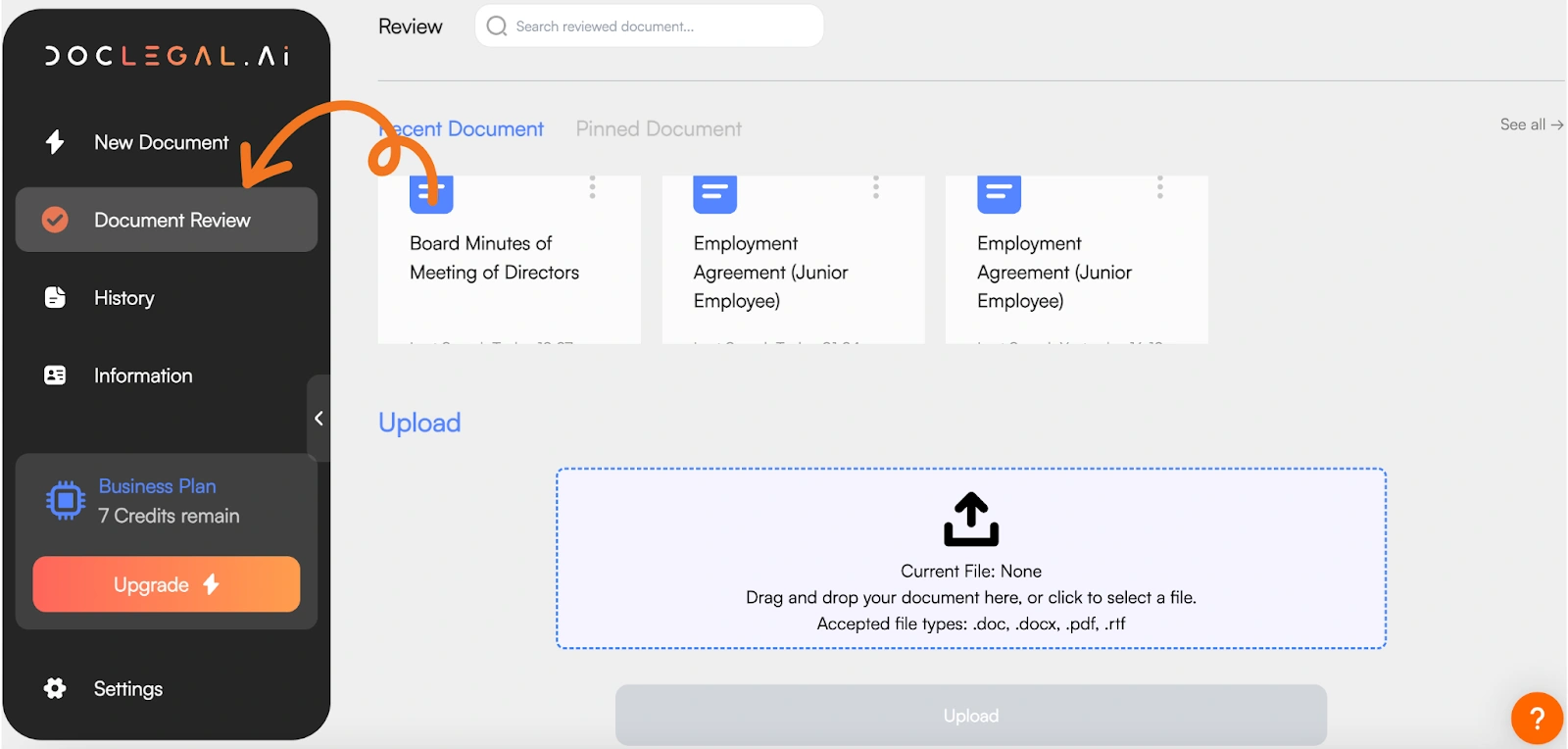
Step 2: Upload your Document or select from ‘Recent Document’ List
Upload the contract or agreement you want to review.
You can drag and drop your document or click to browse your computer and select your document. DocLegal.AI currently accepts the following document types:
- doc
- docx
- rtf
All documents generated with DocLegal.AI will appear under “Recent Document”. After choosing a document, you will be automatically directed to the document review chatbot.

Step 3: Choose Your Document Review Mode: Draft or Review
The Document Review Feature offers two modes: Draft Mode and Review Mode
Draft Mode:
Perfect for editing contract content. This mode includes:
- Add Clause: Insert a new clause tailored to your requirements.
- Revise Clause: Modify existing clauses for clarity or precision.
- Replace Parties: Quickly update the names of the parties in the document.
Review Mode:
Ideal for analyzing your document. This mode includes:
- Highlight Risks: Identify potential risks and red flags in the contract.
- Summarize: Generate a concise summary and outline the essential clauses in the document
- Suggest Clauses: Name the clause you need and Doclegal.Ai chatbot will draft it for you.

Step 4: How Draft Mode Works
Set your chatbot at “Draft” mode
The chatbot is by default set to “Review” mode. To use the “Draft' feature, you must change the mode of the chatbot to “Draft”.

a. Add Clause
Use the 'Add Clause' feature to add new clauses to your contract.
Describe clause you need in the contract and the chatbot will generate a clause accordingly- its output will appear on the left-hand side, embedded in your document and highlighted in yellow.
Alternatively, you may simply state “add clause” without typing further specification into the text box. Here, the chatbot will generate a clause so as to make the document more comprehensive.

b. Revise Clause
AI amends the clauses based on your requirements. Specify the target clause that needs to be updated and describe the necessary changes. For example, change salary to US$5000 in Clause 4.1
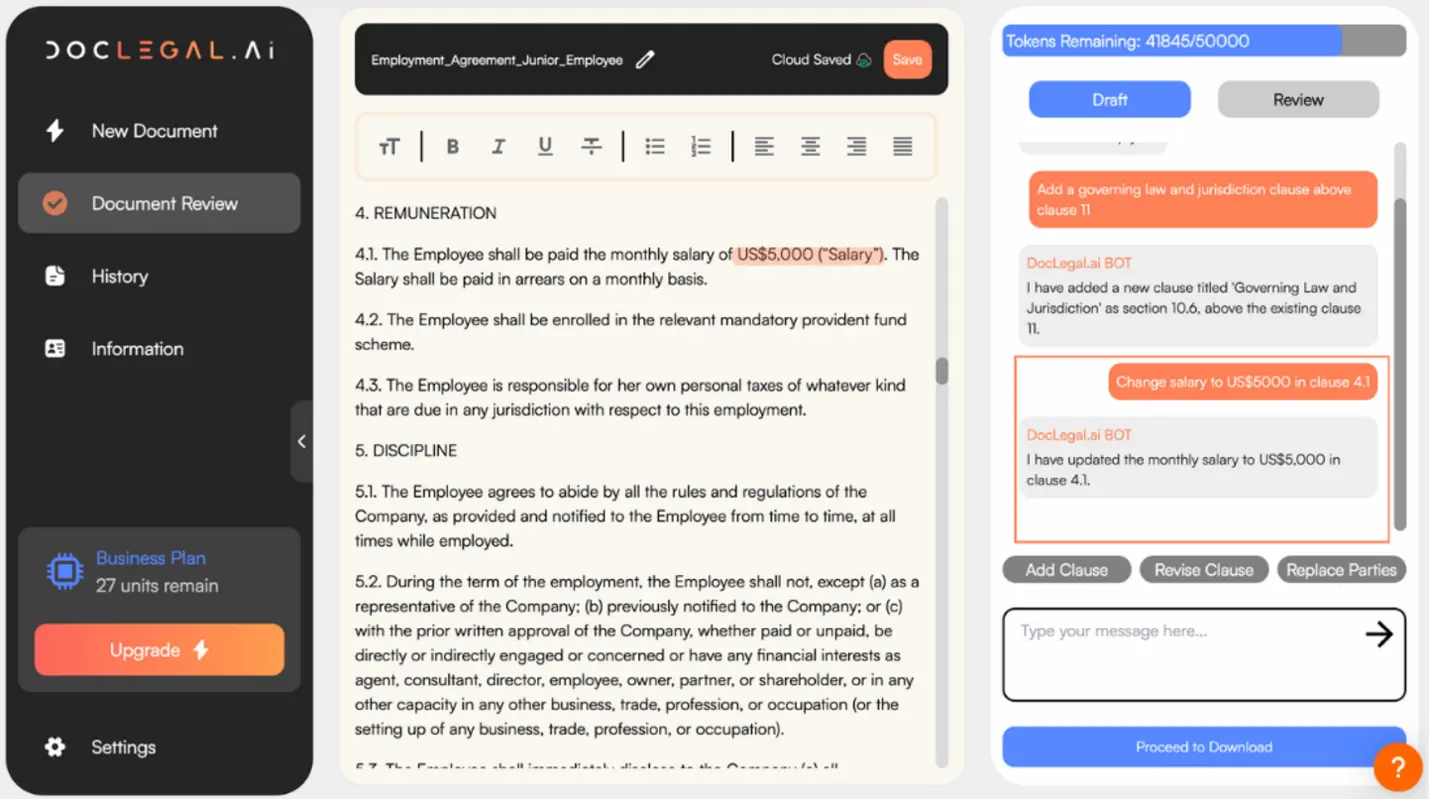
c. Replace Parties
This feature enables you to quickly update party names throughout the document. Please indicate if the party name should be replaced in one section of the document only or throughout the document. For e.g. Replace “Emily Johnson” with “Alice Smith” in the agreement.
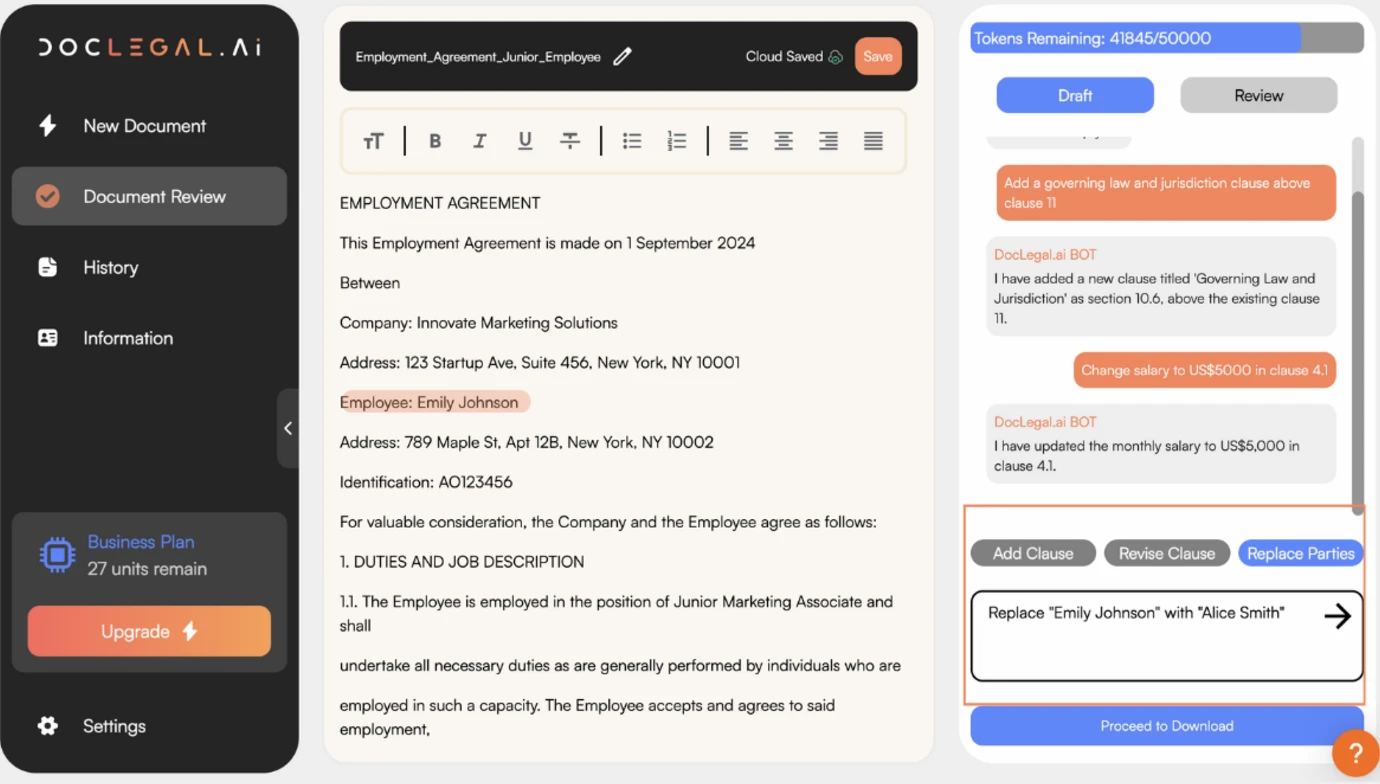
Step 5: How Review Mode Works
Click on the “Document Review” button and upload your document

You can drag and drop your document or click to browse your computer and select your document. DocLegal.AI currently accepts the following document types:
- .doc
- .docx
- .rtf
Set to “Review” mode

a. Highlight Risks
Use the 'Highlight Risks' feature to identify and assess potential legal risks in a document. E.g. If you want to know about the potential risks for the employer, type “Highlight risks for the employer”.
What it does:
- Scans the document for clauses that may expose the selected party to legal or financial risk.
- Flags risky terms, imbalances, or missing protections.
- Provides a summary of concerns for consideration
Tip: Use this tool during contract reviews to ensure your party’s interests are protected and to negotiate more effectively.

(b) Summarize
The 'Summarize' feature will generate a concise summary and outline the key points of the clauses in the document. Sometimes we may just want the summary of certain clause(s), we can type the required clause(s) after clicking the “Summarize” button.
For e.g. Summarize the Employment Agreement by listing key facts and provide a brief description of the agreement’s purpose and key elements in 300 words.
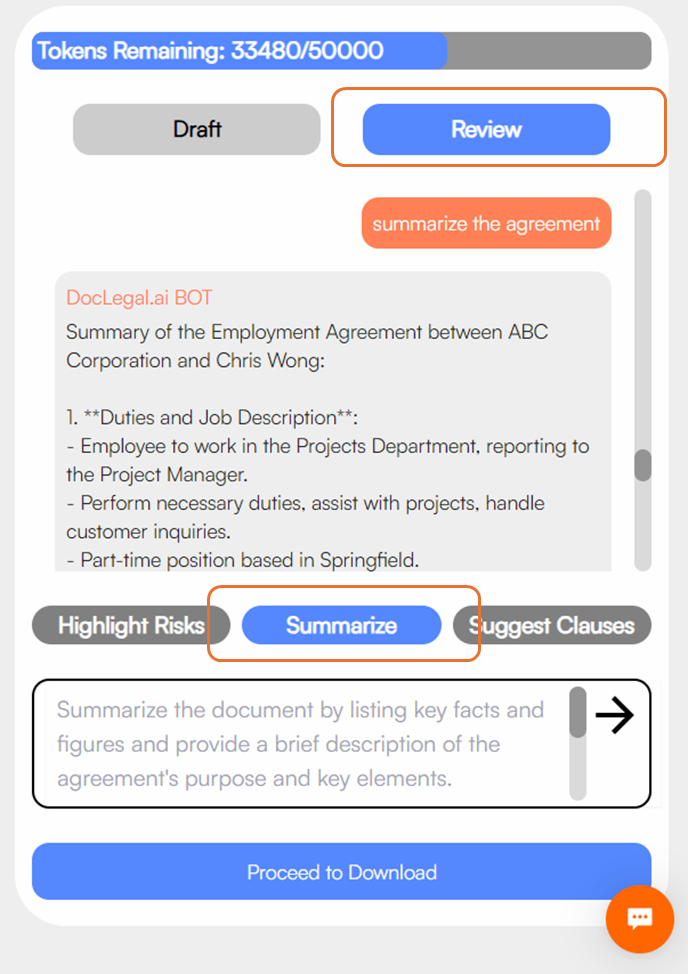
c. Suggest Clauses:
There are two ways you can use this feature
First, you may ask the AI to list missing clauses for your contract.
E.g. Type “list missing clauses”.
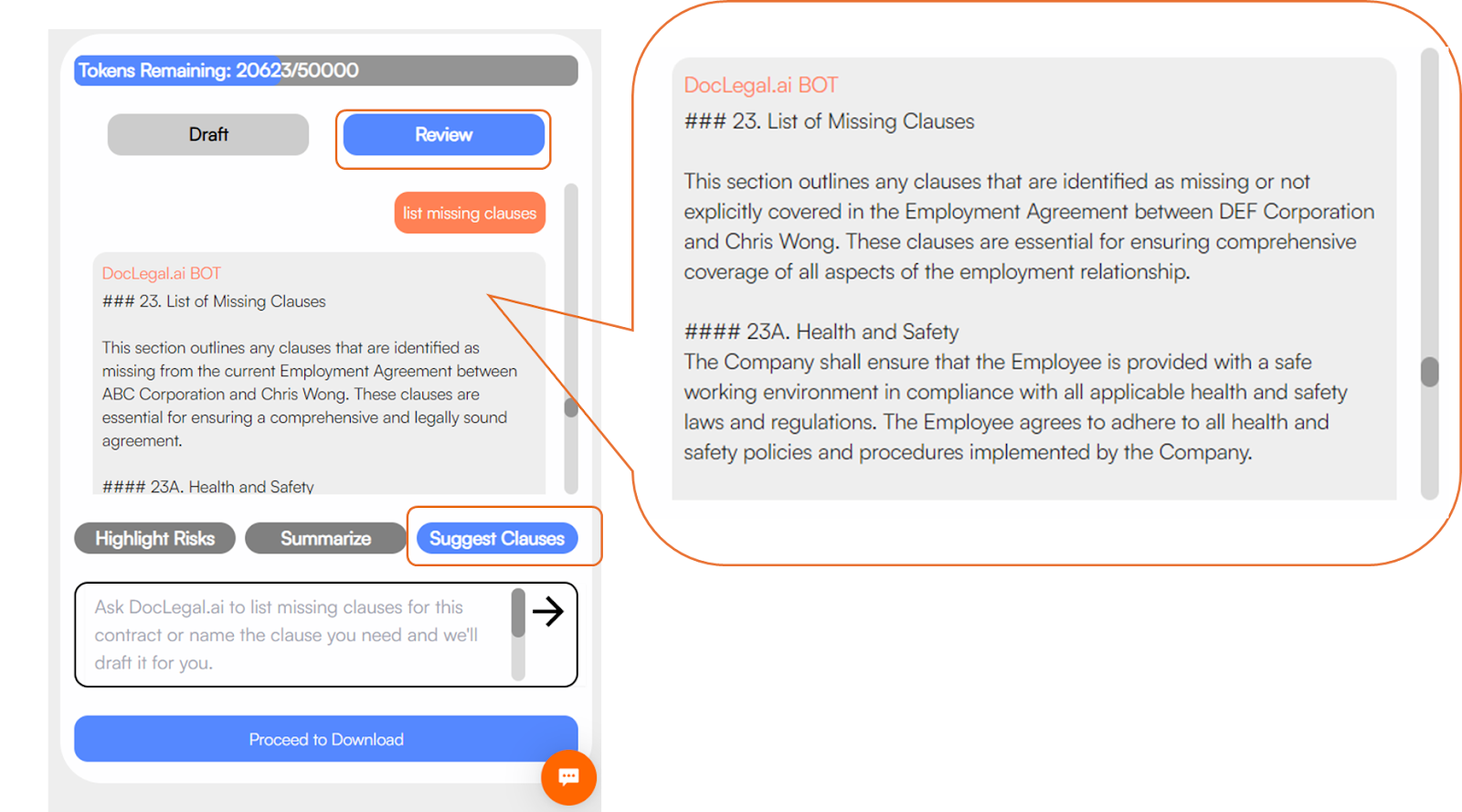
Second, another way to use this function is that you may ask the AI to name a specific clause you need and it will draft it for you.
E.g. Type “Draft an entire agreement clause for this employment contract”

The output generated in the review mode will be embedded in your document. The support team at DocLegal.ai is always here to offer guidance and address any concerns whenever you face queries.
Step 6: Download your Document
After reviewing all AI-suggested changes and fine-tuning the document according to your needs, you can click ‘Proceed’ to finalise the document. Select your preferred file format and click ‘Download’ to save your revised legal document.
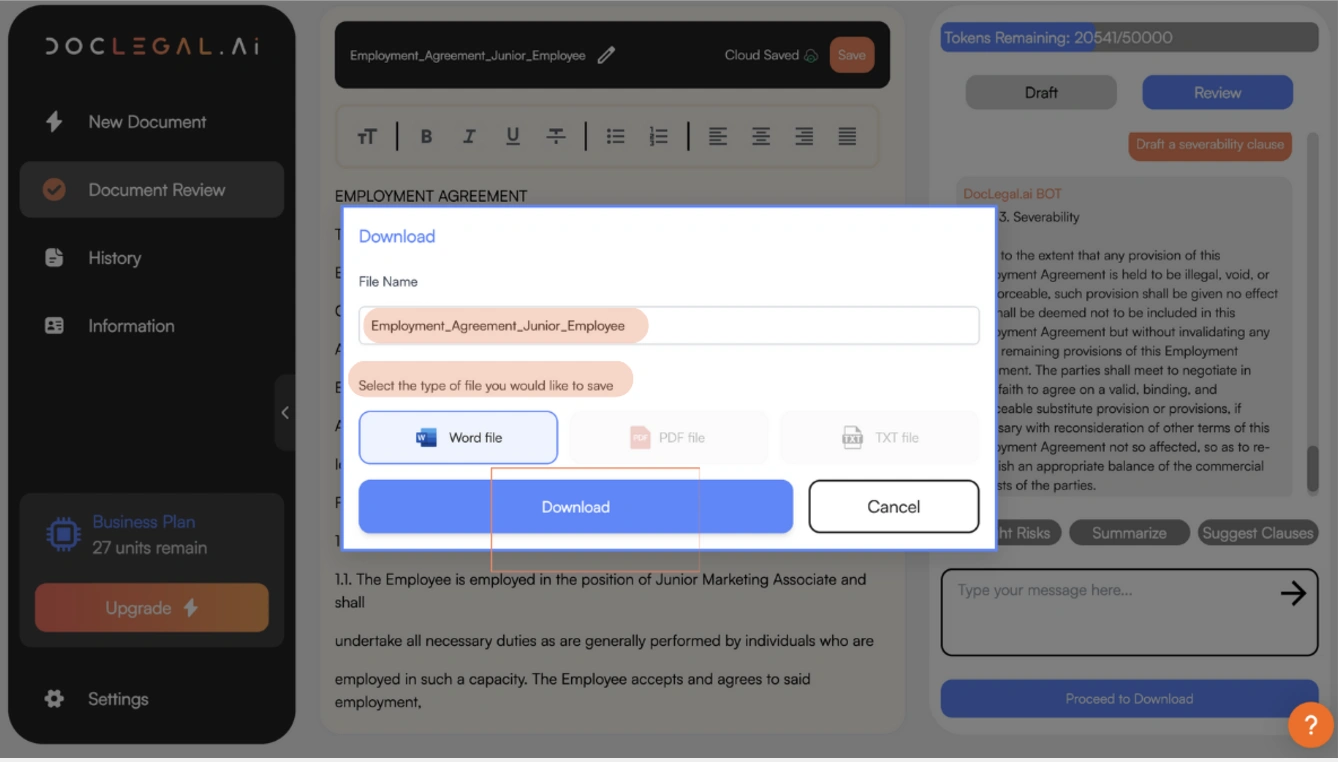
DocLegal.AI transforms document revision from a time-consuming task into a streamlined, intelligent process. By combining advanced AI capabilities with user-friendly interfaces, the platform empowers legal professionals to work more efficiently and accurately.
What to do if running out of tokens?
While drafting legal documents with DocLegal.ai and interacting with the chatbot, it will show the token usage in real-time for each document. For each time you use the functions in the draft/review mode and type your message in the chat box, the number of tokens will be deducted.
So what to do if the tokens have been used up?
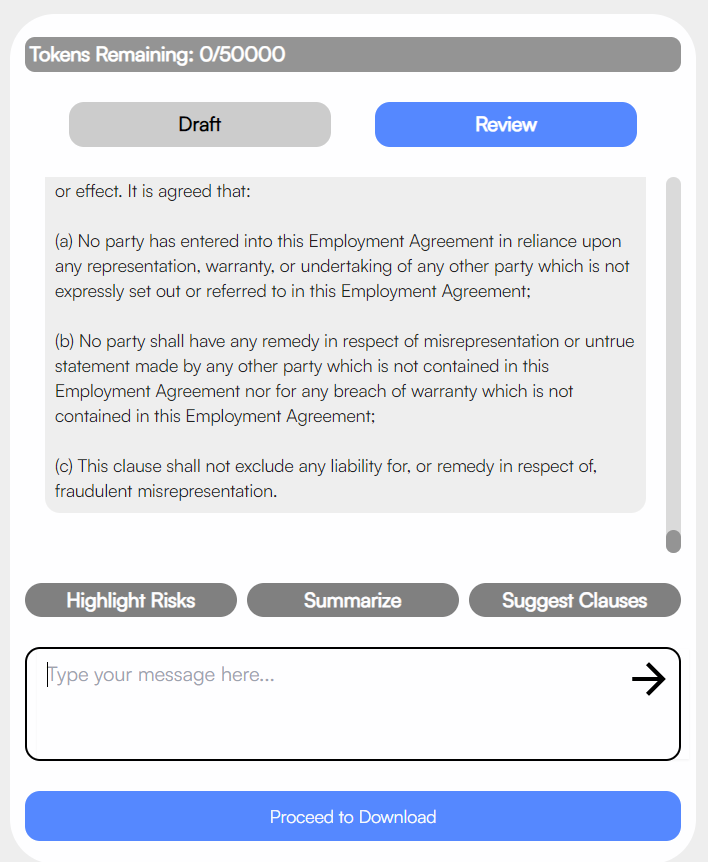
If you still have document credits remaining, you will see this message. Click “Confirm and Generate”.

If you have already subscribed to a plan and do not have enough credits:
- Go to “Settings” and choose “Subscription”. You will see a bar stating the number of units used.

- When you are running out of units in your plan, click the “Manage Subscription” button. There are 3 options including topping up credits, upgrading the plan and cancelling the subscription.

.jpeg)
Hiring Independent Contractors: Legal Guide for Business
The Complete Guide to Hiring Independent Contractors: Legal Tips, Key Clauses & Common Pitfalls Every Business Owner Must Know and Avoid.
Legal Considerations When Hiring Independent Contractors: A Complete Guide for Businesses
Hiring independent contractors has become an increasingly popular strategy for organizations looking for specialized talent and flexible workforce solutions. However, navigating the complexities of independent contractor relationships requires careful consideration, planning, and a thorough understanding of legal and operational implications. This blog will walk you through some legal considerations when hiring independent contractors in common law jurisdictions.
What defines an Independent Contractor?
Independent contractors are professionals who offer services to clients or companies under specific terms, maintaining their autonomy and independence.
Unlike traditional employees, contractors generally:
- Work in projects or temporary based roles
- Provide their own equipment and tools
- Control their own work schedule
- Responsible for their own taxes and benefits
- Work for multiple clients simultaneously
- Not entitled to benefits as employees (e.g. health insurance, retirement contributions)
- Retain the ownership of the work product depending on the terms of the agreement
What is an Independent contractor agreement?
An independent contractor agreement is a legally binding document that sets out the terms of the business relationship between a company and an independent contractor. This formalises the parties’ arrangement into a written agreement, providing a clear understanding of both parties' roles, responsibilities and expectations and minimising the risk of future disputes. To ensure the agreement is as effective as possible, it should cover all scenarios and provide comprehensive protection for both parties. It must outline clear expectations to ensure both sides are aligned and fully understand their obligations.
Do you need a lawyer to draft an independent contractor agreement? It is not always necessary to hire a lawyer to draft an independent contractor agreement, it depends on the size and complexity of the project. For smaller or simpler projects, using a template and tailoring it to include all essential terms is typically sufficient to ensure the agreement is legally enforceable. However, for larger or more intricate tasks, involving a lawyer helps ensure that all nuanced details are properly addressed and that the agreement aligns with the specific needs of the arrangement.
Independent Contractor Engagement Checklist
This checklist provides guidance in preparing your independent contractor agreement.
Before drafting an agreement, check the contractor’s qualification verification.
- Request and verify previous work history
- Seek professional references from their past clients
- Review portfolio of completed projects
- Confirm professional certifications or credentials
In the Independent Contractor Agreement:
- Define the scope of work and what the project entails. The scope of work provides the foundation of the agreement, detailing what the independent contractor is expected to accomplish.
- Clearly outline specific services to be provided: Describe the services or tasks the contractor will perform, eliminating ambiguities.
- Define exact deliverables with clear specifications: List all expected deliverables with detailed descriptions.
- Include specific performance expectations: Goals and standards should be measurable.
- Specify quality standards and acceptance criteria: Provide benchmarks that deliverables must meet for acceptance. This may include technical requirements, design standards, or adherence to a provided style guide, ensuring both parties agree on what constitutes a completed or satisfactory result.
- Define the temporal and project parameters. Setting clear project timelines ensures the work stays on track and both parties have aligned expectations:
- Specify exact start and end dates
- Define project phases and critical deadlines: For longer projects, break down the project into manageable phases, each with its deadlines.
- Develop a flexible approach for adjusting timelines: Include provisions for adjusting deadlines due to unforeseeable circumstances, like delays in client approvals or external disruptions, and clarify how these adjustments will be managed.
- Include provisions for potential project extensions: Outline the terms under which the contract can be extended, including additional fees or renegotiation clauses.
- Set up a process for handling changes in project scope: Define how scope changes will be addressed, such as requiring written consent from both parties before proceeding with additional work or modifying agreed-upon deliverables.
- Communication and Contact Management. It is recommended to establish communication methods to streamline interactions, ensuring accountability and effective problem resolution:
- Assign primary points of contact for both parties: Identify individuals who are responsible for communication, decision-making, and problem-solving. This prevents miscommunication or delays caused by unclear responsibilities.
- Set communication channels and frequencies: Determine how often the contractor and client will communicate and through which methods.
- Establish preferred communication methods: Decide on the platforms to be utilised for communication, such as email, Slack, or project management software like Asana or Trello.
- Develop escalation procedures for issue resolution: Outline a clear procedure for addressing challenges, including steps to escalate unresolved issues to senior management or a designated arbitrator.
- Specify reporting requirements and formats: Clarify how often progress reports will be reports will be provided and their structure.
- Confirm the status of the independent contractor. To avoid potential misclassification and legal disputes, the contract should explicitly define the contractor's independent status:
- Explicitly state contractor’s independent status in the contract
- Confirm the contractor’s responsibilities for:
- Personal tax obligation: Indicate that the contractor is solely responsible for filing and paying their own taxes, including income tax and self-employment tax.
- Own insurance coverage: Specify that the contractor must maintain their own liability, health, or other necessary insurance.
- Personal equipment and resources: Ensure it clear that the contractor will supply their own equipment and materials required to perform the work.
- Clarify lack of employee benefits: Clearly state that the contractor is not entitled to employee benefits such as health insurance or paid leave.
- Outline autonomy in work execution: Reaffirm that the contractor retains full control over how and when the work is performed, as long as it aligns with the agreed deliverables and deadlines.
- Payment Structure and Logistics. Clearly defined payment terms ensure transparency and avoid financial disputes:
- Define precise compensation methodology: Specify whether payment is based on hourly rates, a fixed project fee, or milestone-based payments.
- Specify payment amounts and schedules: Include the total project fee, breakdown by phases or milestones (if applicable), and the payment schedule (e.g. weekly, monthly, upon project completion).
- Detail invoicing requirements: Provide guidelines on invoice submission, such as formatting, required details (e.g. invoice number, breakdown of work), and submission timelines.
- Outline payment submission process: Define how payments will be made (e.g. bank transfer, cheque) and include account details.
- Establish late payment consequences: Include penalties for late payments, such as interest fees or suspension of services.
- Clarify reimbursement policies (if applicable): State whether the contractor will be reimbursed for approved expenses, such as travel or material costs, and outline the process for approval and reimbursement.
- Intellectual property management. To protect the client's rights and clarify the ownership of work, the agreement should address intellectual property:
- Clearly state the client’s ownership of deliverables: Specify that the client owns all deliverables upon payment or completion of the project.
- Define intellectual property transfer conditions: Include terms for the transfer of intellectual property rights, such as requiring a written confirmation of the transfer upon delivery of work.
- Specify usage rights and limitations: Clearly outline how the client can use the deliverables (e.g., for commercial use, sublicensing, modification) and any limitations on usage.
- Address potential pre-existing intellectual property: Confirm that the contractor retains rights to any pre-existing intellectual property they bring to the project, and specify how this property may be used in the client’s deliverables.
- Outline licensing arrangements if relevant: Define whether the contractor retains any rights to license the deliverables to other parties or if the work is exclusively owned by the client.
- Confidentiality and Information Protection. To safeguard sensitive information, confidentiality clauses are critical:
- Define the scope of confidential information: Clearly state what constitutes confidential information, such as client data or project plans.
- Establish non-disclosure obligations: Require the contractor to maintain strict confidentiality and not disclose any information without prior written consent.
- Outline permitted and restricted information uses: Specify how the contractor can use confidential information (e.g., only for project purposes) and prohibit unauthorized uses.
- Create mechanisms for information security: Require the contractor to implement appropriate measures to safeguard confidential information, such as encryption and restricted access, and outline procedures for reporting breaches or losses.
- Insurance and Indemnification. Insurance and indemnification provisions must be outlined in the agreement to maximize protection to the business:
- Require appropriate professional insurance: Specify that the contractor must carry sufficient insurance coverage, such as general liability, professional liability (errors and omissions), or workers’ compensation, depending on the nature of the work.
- Define indemnification expectations: Include an indemnity clause requiring the contractor to indemnify and hold the client harmless from any claims, damages, or liabilities arising from the contractor’s work or actions. This ensures that the independent contractor will be held liable for any damage or injury resulting from the contractor’s work under the contractor.
- Specify liability limitations: Outline the maximum extent of liability for both parties, such as capping damages at the contract value, to protect against excessive financial exposure.
- Termination and Liquidation clauses
Termination clause provides a framework for ending the agreement when necessary and outlines the conditions under which termination is permissible. Crucial to protect both parties’ interests and reduce the likelihood of disputes, employers should consider:
- Grounds for termination: Clearly define the reasons or circumstances that justify termination, such as non-payment, failure to meet deadlines, or breach of contract terms.
- Termination rights: Specify which party has the authority to initiate the termination and under what conditions.
- Notice period requirements: Outline the amount of notice that must be given prior to termination and the consequences for failure to adhere to these requirements.
- Format of notice: Define the medium and format when providing termination notice (e.g. written notice via email).
- Payment upon termination: Detail how payments will be handled in the event of early termination, for example whether the contractor will be paid pro-rata for completed work or not compensated at all for unfinished deliverables.
Liquidation Clause serves as a safeguard in case of a breach of contract, allowing the non-breaching party to be compensated for damages. As the clause establishes a predetermined amount of compensation for breach of contract, the parties have to determine:
- Amount of liquidated damages: Parties must negotiate and agree on a reasonable estimate of the potential damages at the time of signing the contract, ensuring the amount reflects a fair assessment of the risks involved.
- Trigger conditions: Clearly state the circumstances that activate the liquidation clause, such as a failure to deliver work, intellectual property misuse, or breach of confidentiality.
- Administrative Compliance. For lengthy projects, administrative compliance ensures proper documentation and adherence to legal requirements throughout the engagement:
- Require systematic record maintenance: Specify that both parties must maintain comprehensive records related to the contract, including invoices, communications, and deliverables.
- Define record retention periods: Set timelines for how long records must be retained, such as "records must be maintained for a minimum of three years after contract termination."
- Establish audit trail mechanisms: Require a clear and transparent system to track activities, payments, and deliverables, enabling either party to verify compliance and resolve discrepancies efficiently.
- Ensure compliance with relevant regulations: Mandate that both parties comply with relevant laws and regulations, such as tax obligations and labor standards, depending on the nature and jurisdiction of the work.
Amendment and Modification Protocols
Amendment and modification protocols are essential for ensuring for managing changes to the independent contractor agreement in a structured and transparent manner. The agreement should stipulate that all modifications be documented in writing to avoid misunderstandings or disputes. A formal amendment procedure should be established, outlining the necessary steps to propose, review, and implement changes. This includes defining an approval process for modifications to ensure both parties consent before they take effect.
Signatory and Legal Representation
Proper execution of the agreement necessitates careful attention to the details of signatory and legal representation. The contract should include the full legal names of the involved entities and identify the authorized signatories who have the authority to bind their respective organizations. The inclusion of signatory titles helps confirm their official roles and organizational representation, which ensures these formalities are properly followed to execute the contract.
What to avoid when hiring independent contractor(s)
The following lists the potential pitfalls in hiring independent contractors which hindered the ability to establish successful contractor relationships:
1. Organizational Risks
Poorly designed agreements can expose your organization to unnecessary risks. Avoid:
- Engaging senior management such as the Managing Director as an independent contractor as they have significant decision making responsibilities and treating them as independent contractors may confuse their roles and responsibilities.
- Unlimited expense reimbursement: Failing to set limits may result in unmanageable costs, hence employers should always cap reimbursement amounts.
- Exclusive service requirements: Requiring the contractor to work solely with your organization can limit their flexibility and potentially deter skilled professionals.
- Potential reputation risks: Ensure the contractor’s work and conduct align with your organizational values to avoid damaging your public image.
2. Contractual Limitations
Restrictive or one-sided terms can make the agreement unattractive or impractical. Employers should be mindful of:
- Restricting the client’s work product usage: Avoid limiting how the client can use the deliverables—this may discourage innovation or adaptability.
- Prohibiting future hiring of the contractor’s employees: While protecting your business is important, overly strict hiring restrictions can alienate contractors.
- Automatic contract renewal: This can lead to unintended obligations, explicit agreement should be included for contract renewals.
- Overly restrictive termination conditions: Flexibility in termination ensures both parties can exit the agreement if necessary without excessive penalties.
3. Legal Considerations
Legal pitfalls can result in costly disputes or unintended liabilities. Avoid:
- Litigation outside the primary jurisdiction: Specify a mutually convenient jurisdiction to simplify legal proceedings if issues arise.
- Mandatory arbitration: While arbitration can be efficient, parties should not limit other resolution options.
- Limiting the client’s contract assignment capabilities: Restricting the client’s ability to assign the contract could limit their operational flexibility.
- Excessive liability limitations for the contractor: While protecting contractors is reasonable, overly limiting their liability may leave your organization vulnerable.
Conclusion
Hiring independent contractors is a strategic approach to accessing specialized talent while maintaining organizational flexibility. By implementing a comprehensive, well-structured approach that balances legal protection with professional respect, organizations can cultivate productive, mutually beneficial contractor relationships.
Disclaimer: This guide provides general insights and should not be considered legal advice. Always consult with legal professionals to ensure compliance with current regulations and your specific organizational needs.
%2520copy.jpeg)
How to Use DocLegal.AI for Legal Document Generation?
Step-by-step guide for creating legal documents using DocLegal.AI
How to Use DocLegal.Ai for Legal Document Generation?
Hiring a Part-Time Employee? Instantly Generate Employment Contracts on DocLegal.Ai.
Step 1: Log in to DocLegal.Ai
- Log in using your email address.

Step 2: Start a New Document
- Click “New Document” to create legal documents

- Search legal documents by name / keywords in the search box.
- E.g. Input “Part Time Employment Agreement”. Click Search

- Select the most relevant document from the list of documents

Step 3: Describe Your Document
- Provide key details like full names, addresses, and contract description.
- Example: “Draft a part-time employment contract between ABC Ltd. and John Doe, starting on April 1, 2025, for the position of Marketing Assistant with a salary of £1,500 per month.”
- Click "Preview" to view your document.

Step 4: Your Document is Ready. You can make further changes with AI after the document is generated
- You can Generate the Document or edit the Description (if not satisfied with the the Preview)
- Follow Step 5 to Edit Description or Jump to Step 6 to Generate Your Document

Step 5: Edit Description (Optional)
- Update the Description and the AI assistant will make further changes to the document

Step 6: Confirm and Generate Document
- Click Generate if you’re satisfied with the Preview. You can make further changes with AI after the document is generated.
- A pop-up will display the number of credits required for document generation.

- If you are on Free Plan: you’ll be prompted to subscribe before proceeding.

- If you have run out of credits: you’ll be prompted to Top Up Credits or Upgrade Your Plan

Step 7: Edit Your Document
- Make additional modifications by filling in placeholders with specific information.
- You can also utilize the AI powered document review features to identify missing clauses, replace party names, conduct a risk analysis, and generate a concise summary for easy understanding. Check out the Document Review Guide to explore these features.

Step 8: Download Your Document
- Choose your preferred file format (Word, PDF, or TXT) and save your document.

Additional DocLegal.Ai Features
- Document Review: upload your document for an AI review (See Document Review Guide).
- History: Find your recent documents.
- Information: Update your personal and business details.
- Settings: Manage email and security preferences.
With DocLegal.Ai, creating legal documents is effortless, efficient, and affordable. Get started today!

10 Essential Sales Legal Documents for Small Businesses
10 must have legal templates for your sales team to run the business smoothly.

10 Essential Sales Legal Documents for Small Businesses
Sales drive the revenue for a business and you need to secure this revenue by having the right legal documents that are tailored to your business requirements.
DocLegal.Ai will list the 10 legal templates that your sales team will need to run the business smoothly.
- Sales Outreach Letter
- Sale Agreement
- Quote Template
- Terms and Conditions for Sale of Goods
- Sale Representative Commission Agreement
- Purchase Order
- Proforma Invoice for the Purchase of Goods
- Distribution Agreement
- Sale Receipt
- Sales Communication Template
1. Sales Outreach Letter
A Sales communication letter is used to promote your product and drive sales for your business instantly.
Generate this letter using DocLegal.Ai to seamlessly convey:
- Your company’s experience and the geographic coverage of your market
- Assures about quality and quick delivery of your product
- Price Details
- Instructions on how to place an order
2. Sale Agreement
- Sale of Customized Product Agreement and Sale of Regular Product Agreement
If you are a business owner then you are already aware of the importance of a Sale Agreement.
There are two types of Sales Agreement that you may need for your business:
- Sale of Customized Products Agreement provides that the Buyer and Seller agree to develop and supply a Product to meet the Buyer's specific requirements.
- A Sale of Regular Product Agreement provides for a one-off purchase of goods/products. The Buyer will use the goods for its own use or resell them under its own brand. The Seller shall sell and the Buyer shall purchase the agreed quantities of the Products subject to the terms and conditions of this Agreement.
But how to identify if the sales agreement is right for your business? The important provisions in a Sales Agreement are:
- Delivery terms
- Transfer of Risk: when does the risk pass to the buyer?
- Supply Shortage: what happens in case of shortage in supply:
- Delay in Delivery: Is delay in delivery a breach of contract?
Sample clause:
“Risk to the Products shall pass to the Buyer upon delivery to the carrier. Shipping information from the Seller will be sent to the Buyer no later than 5 business days after the shipment leaves the Seller's facility. The shipping information will include the model number and quantities, method of shipment (air-land), date of shipment, shipment number, and any other information allowing easy identification of a delayed or lost shipment.”
- Payment terms
- Payment Schedule and penalty for late payment

- The popular ‘As Is’ language
- As common as this is, it is important to have incorporated a comprehensive ‘As IS’ clause i.e. the products are sold on an ‘As Is’ basis and the seller is not responsible for the defects after sale of the Product.
Sample Clause:
“The Buyer understands that the Products are being sold on an AS IS basis. No term, condition or warranty (whether express or implied) as to the nature, quality or fitness of the Products for any purpose or their conformity with any sample shall be part of any contract between the Seller and the Buyer. The Buyer acknowledges that the Seller has not given any warranty that the Products are fit for a particular purpose or will achieve any particular performance criteria.”
- Termination
- Events of Default: what events will constitute an event of default?
Sample Clause:
“If either party should default in the performance of any material obligation assumed under this Agreement (an Event of Default), then the non-defaulting party may give written notice to the defaulting party which notice shall specify the Event of Default.”
- Limitation of Liability for buyer and seller
- Limit the liability incase of any indirect, special, incidental or consequential damages (including loss of profit) .
Use DocLegal.Ai to add a Limitation of Liability Clause for your Agreement
- Force majeure
- Considering the impact of Covid, we have understood the importance of a force majeure clause and it is part of the list for essential clauses for an agreement now!
3. Quote Template
Can I get a Quote? This is one of the first questions each department of your business will receive when transacting with customers.
Hence, it is important to have a ready template for providing Quotes to your customer that is comprehensively applicable to different business transactions and effectively protects your business operations.
Useful Tip: Maintain a central repository for all your legal templates, and provide access to the relevant teams to ensure the uniformity in the documents used by different teams across the business.
What does a Quote Template include? It sets out the requirements of the customers and how the requirements would be met:
- customer's name, quote number, date, and the validity of the quote
- business name, email, phone, and address
- summary of the customer's requirements including detailed information about products or services
- outlines the pricing, terms, and conditions of a proposed transaction.

This effectively communicates the value proposition of the business and convinces the customer to make a purchase.
4. Terms and Conditions for Sale of Goods
Do you need Terms and Conditions for Sale of Goods considering you have the Sale Agreement already in place?
Yes, you need Terms and Conditions for Sale of Goods and the Sale Agreement.
Sales Agreement will outline the terms and conditions of a specific sale and include price, delivery, payment terms specific to a sale transaction between the buyer and seller. The terms of a Sales Agreement would often be negotiated between the parties.
While, the Term and Conditions for Sale of Goods outline the terms and conditions that generally apply to all sales. For example, clauses like warranties, refund and replacement that are not particularly listed in a Sales Agreement.
This ensures uniformity in terms of the t&cs that will apply to each and every sale. This document can often be attached to a purchase order, especially where it is not open for negotiation with other parties.
5. Sale Representative Commission Agreement
Are your employees driving all the sales of your company or you’re hiring contractors, agents to promote your products and generate business for your company?
If you are engaging agents and contractors to generate business then you should use a Sale Representative Commission Agreement.
The question we mostly get is, Can’t I just use the standard Independent Contractor Agreement for this? Well, just like one size doesn’t fit all in life, the Independent Contractor Agreement will not cover the specifics of a Sale Representative Commission Agreement.
While Independent Contractor agreement has the essence of the independent contractor relationship, using a Sales Representative Commission agreement will provide added benefit as it will be tailored for a sales - commission based transaction.
However, if you ask can I customize an existing Independent Contractor Agreement and use it for this purpose? Probably yes, however, you’ll need to be a lawyer to customize it effectively. This multiples your cost and reduces your revenue.
6. Purchase Order
A Purchase Order is, ideally, the step after the Sales Agreement.
However, we all know sale agreements are heavily negotiated and the back and forth between the legal teams of two parties is a time consuming affair.
Hence, mostly I have seen that parties try to secure the transaction and the price by executing a purchase order while the sale agreement is being reviewed by the legal teams.
You need a robust Purchase Order that ensures all the vital commercials are locked in to ensure business continuity.
Use DocLegal.Ai to generate a Purchase Order you can trust for your business.
7. Proforma Invoice for the purchase of Goods.
Proforma invoices are commonly a key part of international transactions to declare the value of the goods to customs for determination of duties and taxes.
So, what is the purpose of Proforma Invoice?
For the purpose of Buyer: Proforma Invoice enables buyer to evaluate the cost, arrange financing and arranging of import permits
For the purpose of Seller: sets expectation as regard the cost and delivery before moving ahead with the transaction.
Who will issue the Proforma Invoice?
Seller issues the Proforma Invoice providing an estimate of the transaction to the buyer
Here’s what you need to know about Proforma Invoice:
- It is issued by the seller before the final sale and delivery of the goods
- It sets expectation of the customer regarding cost and delivery i.e. the intent to purchase
- It is not legally binding
- This can be used to secure a letter of credit or to arrange financing
- It is used to provide a detailed breakdown of the items or services being sold, along with their corresponding prices and quantities.
Example of when you need a Proforma Invoice:
If you want to import certain goods from a foreign supplier then ask for a proforma Invoice to get an estimate of the transaction before agreeing to the purchase. DocLegal.ai can be also used as Invoice AI Generator.
8. Distribution Agreement
The Distribution Agreement (with Sub-Distribution Rights) is a legal document that establishes a contractual relationship between two parties: the Company and the Distributor.
The agreement is entered into with the aim of extending the area in which sales are made to a specific territory. The Company wishes to appoint the Distributor as its exclusive distributor of products for certain applications in the territory, and the Distributor has agreed to accept such appointment subject to the terms and conditions of the agreement.
Generate Distributor Agreement Template for your Business with DocLegal.Ai
9. Sale Receipt
A sales receipt typically immediately follows the sale of a good and is provided by the seller.
The Sale Receipt document is an important document that serves as proof of purchase for a transaction. It is used to provide a detailed record of the items purchased, their quantities, unit prices, line totals, and the total amount paid.
After the customer successfully purchased one or more items from a shop or a company, a receipt should be issued to them to prove that the sale has been received and the purchasing procedure has been completed. The receipt also acts as a reference for the customer to realise the details such as the price, and quantity, of his/ her purchase.
10. Sales Communication Template
Automating operations is essential to streamline business operations. Your team shouldn;t spend their time drafting emails or letters communicating discounts, handling discount refusal and such other routine communication.
With DocLegal.Ai, you can automate your business operations by generating sales communication templates.
Common FAQs regarding Sales Documentation:
1. Sales Order vs. Invoice - What is the difference between Sales Order and Invoice?
The main difference between a sales order and invoice is that a sales order is created by a vendor to confirm they can provide the goods or services requested. On the other hand, an invoice is normally created to request payment for goods or services that have already been provided to the buyer. Online invoice generator can be used in this case just by using DocLegal.AI
These sales orders are typically provided by the seller. As the transaction is likely to be online and thus done through mail, fax, e-mail or other instantaneous communication methods, you should ensure that all the required information is provided to the customer, including;
- name of product/service,
- product/service code or number,
- unit price, sales tax and discount/ payment terms (if any),
- quantity ordered,
- pick up or delivery address,
- required date of delivery/service, and
- payment method (enclosing cheque, transfer or by installment).
2. Receipt vs. Invoice - What is the difference between a receipt and an invoice?
It is important to note that receipts are not the same thing as invoices, although they may seem similar. While receipts are given to the customer after a sale, invoices are provided before any money is sent by the customer. DocLegal.AI will help you as Ai invoice template generator.
Therefore, you should ensure that your invoice contains a due date for the payment, as well as the date that the invoice was sent to the customer. This ensures that any late payments from the customer can be followed up efficiently and in a transparent manner.
Conclusion
In conclusion, these documents for your sales department form the foundation of every successful business and are sure to help you increase efficiency and profitability.

What is the best AI tool for contract writing?
A lawyer explores whether an AI legal document creation tool can be trusted to generate reliable legal documents for business.
As a lawyer, I’ve always approached AI with caution especially in legal matters. Yet DocLegal.ai, an AI tool for AI contract drafting, has changed the way I view technology in legal workflows. This AI tool helps generate contracts i.e. from employment agreements to service contracts quickly and efficiently, without compromising on accuracy or compliance.
What makes DocLegal.ai stand out is its AI contract drafting and AI Contract Analysis capability. Each contract is crafted using pre-approved templates and clause libraries, ensuring consistency and adherence to industry standards. By leveraging this AI tool for contract drafting, legal teams can reduce human error, speed up drafting, and focus on higher-value tasks such as negotiation and risk management.
Businesses wondering whether AI can truly be trusted for legal needs will find reassurance in DocLegal.ai. This AI contract drafting solution proves that AI tools can support reliable, efficient, and scalable contract workflows. Experiencing the AI legal platform firsthand shows that AI is not just a concept—it’s a practical, trustworthy partner for modern legal teams.
Why Choose DocLegal.AI for Your Legal Documents?
1. Advanced Legal Document Generation
Trained on vast repositories of legal documents, DocLegal.ai delivers unmatched precision and relevance in AI-generated legal documents. Move beyond generic templates and embrace tailored, contextually enriched legal documents.
2. AI Document Review / AI Contract Analysis
The chatbot can review your documents i.e. highlight risks, add clauses, provide document summary and replace party.
3. Trained by Legal Experts
The platform integrates the expertise of professional lawyers into the contract generation process. This ensures that the contracts generated can easily be tailored to meet the specific needs of businesses.
4. Business Confidentiality
We understand the importance of confidentiality when it comes to your business information. Rest assured that your data is secure when using Doclegal.Ai!. The AI chatbot is not trained based on the data you provide. Your privacy and confidentiality are our top priorities.
5. No Hallucinations with DocLegal.Ai:
To prevent hallucinations, Doclegal.Ai is trained on diverse, balanced, and well-structured data. This approach helps the technology to better understand its tasks and yield more effective outputs.
Experience the DocLegal.Ai Difference
Our platform is not just about technology; it's about empowering businesses and legal professionals. Here's how DocLegal.Ai stands out:
- User-Friendly Interface: Our intuitive platform makes it easy for anyone to generate and review contracts without requiring extensive legal or technical knowledge.
- Secure and Confidential: We prioritize your privacy and the confidentiality of your documents, employing robust security measures to protect your information.
- Support and Expertise: Our team of legal and tech experts is always available to assist you, ensuring that your experience with DocLegal.Ai is seamless and productive.
DocLegal.Ai offers a unique and reliable solution for contract generation and review. With professional expertise, continuous improvement, strict confidentiality measures, and precision in contract generation, we empower businesses to streamline their legal processes with confidence.
Interested in learning more about AI in legal services? Visit Doclegal.ai blog for the latest insights and developments.

Launch Your Business with DocLegal.Ai in 2025
Starting a business? Here are the must-have legal documents to protect your business. Doclegal.AI, your startup legal document generator.

Top # Must Have Legal Agreements for a small business
Starting a business is an exhilarating venture, especially when you leverage AI to innovate and disrupt the market. However, to ensure your startup's success and legal compliance, you need to have the right legal documents in place. These documents not only provide protection but also help in establishing a clear operational framework. Let’s dive into the essential legal documents every AI startup needs to launch successfully.
DocLegal.Ai can generate legal documents tailored to your business needs. Whether you're a seasoned entrepreneur or just starting, DocLegal.Ai is the legal Ai tool that can help you navigate the complexities of business documents with ease.
In this blog post, we will explore the top 10 must-have legal agreements for small businesses and how DocLegal.Ai can assist you in creating them.
1. Partnership Agreement
If you’re starting your business with one or more partners, a Partnership Agreement is essential.
This document outlines the roles, responsibilities, profit-sharing arrangements between partners, processes for resolving disputes, making business decisions, and handling the exit or death of a partner.
Why is it important?
A well-drafted Partnership Agreement prevents:
- misunderstandings and conflicts by clearly defining each partner’s expectations and contributions;
- provides a legal framework that protects all parties involved and ensures smooth business operations.
How does DocLegal.Ai help?
With DocLegal.Ai, you can customize your partnership agreement to suit your specific needs, ensuring that all crucial aspects are covered comprehensively.
2. Shareholder Agreement
If you have registered your business as a company then shareholder agreement is the most essential legal document. A shareholder agreement describes how a company should be operated, outlines shareholders rights, voting rights, dividend policy, exit policy etc.
Why is it important?
- Prevents disputes and aligns the interests of all parties involved, ensuring that everyone works towards the common goal of growing the business.
- Regulates the relationship between the shareholders; and
- Governs the management of the company.
How does DocLegal.Ai help?
With DocLegal.Ai, you can generate a comprehensive shareholder agreement to protect the interests of all shareholders and safeguard the future of the company.
3. Non-Disclosure Agreement (NDA)
A Non-Disclosure Agreement is vital for protecting your business's confidential information.
Whether you're discussing your business idea with potential investors or hiring new employees, an NDA ensures that sensitive information remains protected.
Why is it important?
- Prevents employees, contractors, and business partners from disclosing or misusing your confidential information.
- Safeguards intellectual property and trade secrets
- Provides a legal recourse in case of breach by either party.
How does DocLegal.Ai help?
DocLegal.Ai can generate tailored NDAs for your business that are easy to understand and ensure your confidential information remains secure.
4. Employment Agreement and Job offer Letter
An Employment Agreement outlines the terms of employment between the employer and employee. The terms include job responsibilities, compensation, benefits, and termination conditions. .
Why is it important?
- Clearly defines employee roles and expectations
- Protects your business from potential disputes
- Ensures compliance with labor laws
How does DocLegal.Ai help?
DocLegal.Ai offers customizable templates for employment agreements, job offer letters tailored to various roles, whether for junior employees, senior employees, or employees with share options etc. Understanding the diverse requirements when hiring, DocLegal.Ai creates agreements that perfectly suit your business's specific needs.
5. Independent Contractor Agreement
If you plan to hire freelancers or contractors, an Independent Contractor Agreement is crucial. This agreement specifies the scope of work, payment terms, and the relationship between the contractor and your business.
Why is it important?
- Clarifies the nature of the relationship (independent contractor vs. employee)
- Defines project scope and deliverables
- Ensures transfer of intellectual property ownership in the work from the contractor to your business
How does DocLegal.Ai help?
Whether you're engaging a graphic designer for a one-time project or a consultant for ongoing services, DocLegal.Ai provides comprehensive and customizable templates. These agreements include detailed sections on scope of work, payment schedules, confidentiality, and intellectual property rights, ensuring clear communication and protecting your business interests from the outset.
6. Sales or Service Agreement
If your business involves selling products or providing services, this agreement details the terms of the transaction. It includes pricing, delivery, warranties, and dispute resolution mechanisms. A well-drafted agreement can prevent misunderstandings and protect both parties’ interests.
Why It's Important:
- Reduces the risk of disputes with the other party
- Clearly defines the terms of sale and delivery / service delivery
- Protects your business from potential liabilities
- Outlines payment terms and termination terms
How does DocLegal.Ai help?
DocLegal.Ai offers customizable service agreements and sale agreements tailored to your business needs, ensuring clarity and protection for both parties.
7. Terms of Service
Terms and Conditions set the rules for using your website or service. This document governs the user conduct, intellectual property, and dispute resolution.
Why Is It Important?
- Protects your business from potential liabilities
- Sets clear rules for users
- Provides a framework for resolving disputes
How does DocLegal.Ai help?
DocLegal.Ai offers comprehensive terms and conditions templates that you can customize to fit your specific business model and legal requirements.
8. Privacy Policy
A Privacy Policy is a critical document for any business, especially those with a website and collecting personal data of the users. This document outlines how your business collects, uses, stores, and protects customer data.
Why is it important:
- It is crucial for building trust with your users and complying with data protection laws such as GDPR in Europe and CCPA in California.
- Without a clear Privacy Policy, you risk legal action from users and regulatory bodies, which can lead to hefty fines and damage to your reputation.
- This document ensures transparency and helps you manage user expectations regarding their personal information.
How does DocLegal.Ai help?
DocLegal.Ai provides up-to-date privacy policy templates ensuring your business maintains transparency with the users as regard the collection and use of personal data;
9. Operating Agreement
An Operating Agreement is a must for Limited Liability Companies (LLCs). This document outlines the LLC's management structure, member roles, and operational guidelines.
Why Is It Important?
Provides a clear management framework
- Protects members' personal assets
- Defines profit distribution and decision-making processes
How does DocLegal.Ai help?
DocLegal.Ai offers detailed and customizable operating agreement, ensuring that your LLC operates smoothly and you can focus on growing your business.
10. Investment Agreement
An investment agreement outlines the terms and conditions of an investment made in a business by investors.
It serves as a legal contract between the company seeking investment and the investors providing the funds.
Why Is It Important?
- aligns the interests of the company and its investors by outlining mutual objectives and mechanisms for decision-making and control.
- clarity on the terms and conditions of the business
- Outlines the exit strategy in case of any investment disputes.
How does DocLegal.Ai help?
DocLegal.Ai can generate different types of investor agreements such for single investor, Letter of Intent for Investment etc. which you can customize based on your requirements.
Launching business in 2025? Subscribe to DocLegal.Ai and create legal templates for these top 10 must-have legal agreements for any business, and experience the peace of mind that comes with knowing your business is legally sound and protected.

A Guide to Setting Up Joint Ventures
The only comprehensive guide you need for setting up a joint venture (JV) and on how to draft one using DocLegal.AI.
What is a joint venture? Why might a business enter into one? How can a business set up a joint venture?
This article will introduce you to the fundamentals of a joint venture: its definition, common rationale, comparisons between other business arrangements, the planning process and how to draft a joint venture agreement (JVA).
Key Takeaways
- Joint ventures are business arrangements between two or more parties where they combine their assets and resources for a new business activity.
- Joint ventures are strategic and resilient compared to mergers and acquisitions in light of recent geopolitical developments,
- A holistic approach to business is crucial for the success of a joint venture; it involves due diligence, analysis of business partners competencies, resources and limitations, and a business plan tailored to the common business activities and level of integration between the parties.
- There are three common legal structures of a joint venture: equity joint ventures, partnership-based joint ventures (including limited partnerships and limited liability partnerships), and contractual joint ventures.
- JVAs govern the structure and the activities of the joint venture; it must reflect the thorough risk assessments, due diligence, business plans, and planned exit strategy conducted prior to its draft.
Table of Contents
1. Joint Venture (JV): Definition, Common Rationales, and Growing Trends
2. Planning the Joint Venture
- Factors of a Successful Joint Venture
- Purpose and Objectives of the Joint Venture
- Scope of the Joint Venture
- Due Diligence: Background of Your Business Partner(s)
- Structures of Joint Ventures
3. Joint Venture Agreements (JVA)
- Terms of a Joint Venture Agreement
- Draft Your Joint Venture Agreement with DocLegal.AI
- Negotiating Joint Venture Arrangements: Checklist
4. Joint Venture Exit Strategies
5. Conclusion
6. Frequently Asked Questions (FAQ)
Joint Venture (JV): Definition, Common Rationales, and Growing Trends
Definition. A joint venture is a business arrangement where two or more parties agree to combine their assets and resources with the aim of working towards or beginning a particular business activity.
Common reasons for choosing a joint venture.
- Access to international/foreign/challenging local markets
- Access to technology, shared resources and responsibilities
- Access to new capital and assets
- Drive a staged exit and buyout
- Satisfy regulatory requirements
- Synergy benefits
- Potential economies of scale
- Risk Mitigation
- Political Sensitivity
Growing trends. With recent geopolitical paradigms, joint ventures are perceived as a more resilient and effective method for capability sharing, risk management, and operational efficacy than mergers and acquisitions. The following sectors, as Forbes writers Bhargava and Bamford note, are receptive to joint ventures:
- Automotive
- Industrial
- Aerospace and defence
- Chemicals
- Oil and gas
- Mining
Planning the Joint Venture
Factors of a Successful Joint Venture
Joint ventures are prone to poor governance and can be tricky to manage. Here are some tips on making sure your joint venture is set up for success:
- Consider entering traditionally closed markets
- Take advantage of the diverse capabilities of all the business partners involved
- Set clear objectives for parent company governance, dispute resolution, and exit strategy
- Orient the operations of the joint venture based on a shared business strategy
- Proactively decided the culture of the joint venture
It is typical for joint ventures to be used as a mechanism to enter a foreign market. Here are some specific tips for cross-border joint ventures:
- Explore all possible geographies, and choose the most geo-politically appropriate option
- Develop robust governance, including legal and non-legal protection mechanisms
- Develop clear exit strategies for both parties involved
Non-legal Protection Mechanisms for Joint Ventures
With rising geopolitical tensions, non-legal protection mechanisms for joint ventures have become more important than ever. Following the Boston Consulting Group Joint Venture Survey in 2023, here are some of the most popular modes non-legal protection amongst joint venture partners:
- Restriction of IP access
- Parent customer/supplier agreements
- Government relationships
- Restriction of material access
- Escrow accounts
Adopting the above methods of protection in connection with robust legal documents and business strategies will set your joint venture up for success.
Purpose and Objective of the Joint Venture
What do you want to achieve?
First, you should decide on what you want to accomplish through the joint venture.
You will have to determine (with your business partner(s)) the specifics of the business venture:
- Where will you be doing the business?
- How will you be doing it?
- What are the main business goals?
Aim to be as specific and detailed as possible so that all the parties in the joint venture are informed.
Do you need a Joint Venture?
Above all, at this stage, you should consider if a joint venture is the most strategic/value-creating option for your business. Is a joint venture the right type of arrangement considering the purpose or relationship? Would other alternatives suffice?
For example:
- Co-operation agreement
- Research and development agreement
- Licence or franchise agreement
- Distribution or agency agreement
- Supply of goods or services contract
- Merger or acquisition
Scope of the Joint Venture
Another important item to consider is the scope of the joint venture. If you have an existing business, it is important to ensure that the joint venture does not compete with or encroach on it.
Consider implications of its scope in connection with:
- Any activities the joint venture expressly intends to do or refrain from doing
- Corporate opportunity and potential conflicts with each party’s other businesses
- Any core technology or other intellectual property to be transferred or granted
- Other intercorporate arrangements that will be required for the joint venture to operate
Due Diligence: Background of Your Business Partner
The Importance of Due Diligence
If you do decide to proceed with a joint venture, you ought to do your due diligence by researching the partner/company you plan to work with to ensure their trustworthiness and capabilities. Here are some areas to carry out due diligence for as a starting point:
- Financials and credit status
- Technological and operational capabilities
- Previous performance in other JVs
- Values and visions
- ESG commitments
- Potential risks associated with their business (e.g. pre existing obligations, large amounts of outstanding litigation)
Foreign Business Partners
If your partner is from a foreign country, remember to take the time to learn the culture and business etiquette of their country. Keep an open mind and learn about the differences between you and your partner’s cultural values and perspectives to avoid unexpected disagreements that stem from cultural differences between you and your partner.
You should also aim to identify any jurisdictional differences in requirements regarding operative legal documents and overall governance of joint ventures.
Structure: Equity Joint Venture, Partnership or Contractual Joint Venture
Joint ventures exist in various structures designed for different purposes (e.g. capability-sharing, operational efficacy, and risk-sharing). The most common legal structures are:
- Equity Joint Venture/ Joint Venture Companies (JVC);
- Partnerships;
- Limited partnerships (LP);
- Limited liability partnerships (LLP); and
- Contractual Joint Venture
It is important to be clear on the structure of the joint venture as each structure will require a different form of drafting, following the relevant legal agreements and procedures that apply. You may refer to the table below to quickly identify which joint venture structure would best suit your business needs.
Equity Joint Venture / Joint Venture Company (JVC)
- Liabilities of the parties are limited to their equity contributions
- Separate legal entity(a JVC) provides more formality and structure
- More complex and costly to set up and maintain
- Parties have to agree on respective equity contributions and ownership
Partnership
- Tax-efficient structure
- Simpler to set up and maintain than a JVC
- Partners bear unlimited liabilities
- Partnership is not a separate legal entity
Limited Partnership (LP)
- Limited partners have limited liability
- LPs are a popular option amongst investment vehicles (for passive investors)
- At least one partner (general partner) must bear unlimited liability
- Limited partners are not part of the management
- Partnership is not a separate legal entity
Limited Liability Partnership (LLP)
- All partners can participated in the management of the partnership
- Partners bear limited liabilities (ie. partners will not be held liable for the acts of other partners)
- LLPs that are built amongst a group of professionals build economies of scale
- Partners can be brought in and let out of the LLP, allowing for governance and operational flexibility
- Roles and responsibilities of partners and other members of the LLP are not as clearly defined as those in a LP
Contractual Joint Venture
- Suitable for one-off single-purpose projects (e.g. R&D cooperation)
- No need to set up a separate legal entity: contractual joint ventures are unincorporated and based on cooperation agreements.
- Lacks the formality and structure of a separate legal entity
- Parties have to rely on the contract to govern their relationship
Deciding which joint venture structure to adopt for the joint venture will also depend on the following factors:
- Tax
- Regulatory issues
- Jurisdictional matters
- Governance of joint venture
- Formalities (publicity and administration) etc.
Joint Venture Agreements (JVA)
The JVA dictates the structure and governance of the joint venture. However, the JVA can also protect your business during the operations of the joint venture, namely, it can:
- Minimise/prevent risks associated with your partner(s)’ business
- Minimising the effect of pre existing obligations of your partners business on your own business
Additionally, you may consider utilising the JVA as an instrument to hold your business accountable to its ESG commitments.
Terms of a Joint Venture Agreement
As a starting point, here are some key matters that need to be in the agreement:
Objectives and Business Plan. The agreement should clarify the objectives and business plan of the joint venture.
Joint Venture Structure. It should address issues such as the ownership structure, voting rights, governing body, the legal system, etc. The question of 'what are the duties of each party and what are their rights?' needs to be addressed.
Composition of the Team: Management, Operations and Accounting. It should also establish the composition of the business’ management team and the key players. This includes the company secretary, board members, executive team members, etc. It is also important to state the operations and accounting responsibilities of each partner. For instance, who will be running the day-to-day operations and who does the bookkeeping and record-keeping?
Financial Contributions. In addition to the financial contributions of each party, the joint venture agreement should also specify how the liabilities under the guarantee/bond/indemnities will be shared by the parties.
Intellectual property contributions. The plan should also indicate the intellectual property contributions of each partner for the joint venture and how these intellectual property rights are to be shared/owned by respective partners.
Profits and Losses. It is also important to clearly allocate the profits and losses of the joint venture. What/how much will each partner get from the joint venture? What percentage of the losses will each partner be liable for? Is it all equally shared or does it depend on the value that each partner is bringing to the table?
Liabilities. The plan should also mark out the liabilities of each partner and their relevant indemnities. Parties need to decide upfront whether any of them will be indemnified against all potential liabilities arising out of the joint venture agreement.
If a dispute does arise, parties to the joint venture are usually required by contract to provide information/evidence to defend third-party claims against other parties regardless of whether they are indemnified.
Dispute Resolution. The plan should also detail the dispute resolution procedure to be adopted when disputes do arise. Apart from court litigation, there are various other more efficient and less costly alternative dispute resolutions including arbitrations, mediations, negotiations, etc that you might want to consider.
It is important to be clear about which dispute resolution procedure should be prioritised so that even if disputes do arise, parties are able to settle their differences in a calm and agreed manner.
Insurance. Insurance is an important element to consider and include in the agreement, as after all, joint ventures are short-term business partnerships. It is crucial that parties are insured under an insurance plan that covers worker’s compensation, property insurance, risk insurance etc.
Parties should be clear on how the business project is to be insured and what type of insurance will be used and maintained throughout the business venture. It is also important to specify the buyer and maintainer of the various insurances involved in the project for clear record-keeping.
Termination. The plan should include details of the termination of the agreement. As mentioned, joint ventures are not long-term agreements, but short-termed business ventures with a specific and defined goal, meaning that termination is something both parties should anticipate and be well prepared for.
To end the business partnership on a good note, it is important to spell out the details of the end of the contractual relationship in the agreement.
Draft Your Joint Venture Agreement with DocLegal.Ai
There are various elements to look at when drafting joint venture agreements. Some considerations include the number of parties concerned with the joint venture, the separation of shares, and the goals of the joint venture. DocLegal.Ai can help expedite the process of drafting the joint venture agreement, providing you with support tailored to your business’s needs.
Here's how to use DocLegal.Ai:
Step 1: Describe your situation to our chatbot, providing all necessary details to create an accurate document.
Step 2: Customise your document.
Step 3: Download. Rest assured, your data will be securely stored, ensuring efficient data input, and AI will generate results more swiftly with minimal queries.
More about DocLegal.Ai
DocLegal.Ai is a legal document generation and review platform that combines generative AI technology and legal tech expertise, and generates legal documents that can be customized easily.
Please visit our general FAQ section for more information on DocLegal.Ai.
Negotiating Joint Venture Arrangements: Checklist
The following are preliminary questions you must consider when negotiating with potential partner(s) of the joint venture:
Intellectual Property
- What will be the name of the joint venture?
- Are there any restrictions on the use of the name?
- How will any existing brands be valued/protected?
- How will any new IP be dealt with?
Due Diligence
- Is any due diligence to be completed before the joint venture is effective?
- Is it a new business or would existing businesses be transferred to the joint venture?
- Are there any restrictions in existing agreements?
- Who will need to consent/provide their approval?
- Check the existing companies' constitutions for any transfer.
Location and Facilities
- Where will the joint venture carry on business?
- Whose premises?
- New premises?
- Who will own the premises?
- Will landlord consent be required?
- Will it be necessary for the joint venture to continue to use any facilities of the existing entities?
- Any contractual arrangements in place?
Confidentiality
- Will confidential information be disclosed during negotiations?
- Has a confidentiality agreement or information exchange agreement been put in place?
Exclusivity
- Do the parties want to have a period of exclusive negotiation?
- Is each party still free, pending its signature, to negotiate with third parties?
Duration
- How long will the joint venture be?
Risks
- Will indemnities/warranties be given?
- Should they be capped?
Feasibility
- Has a feasibility study or business plan been prepared?
- MOU / LOI Is a letter of intent or memorandum of understanding appropriate to establish points of principle?
Authorisation / Consent
- What material authorisations, consents, licenses or other conditions precedent will be required for the joint venture to commence?
Law and Jurisdiction
- In which jurisdictions will the joint venture operate?
- What governing law should apply?
Joint Ventures Exit Strategies
Dissolution of Joint Ventures
Parties may exit a joint venture under the following conditions:
- The duration of the joint venture as set out in the JVA has come to an end and the parties have accrued the maximum amount of benefits from that business arrangement.
- The business objectives of at least one party deviates from the objectives of the joint venture.
- It would be impossible to continue the joint venture due to legal, financial or operational issues affecting one or all parties involved.
- The anticipated benefits from the joint venture have not come into fruition and the partnership has lost its strategic value for at least one party.
- Economic or political developments which adversely affect the profitability of the joint venture for at least one party.
Duality and Importance of Exit Strategies
Discussing exit strategies is a proactive measure you and your partner(s) can take for your joint venture. Exit strategies can facilitate the completion of the joint venture, marking the attainment and collective commercial success of all parties involved. They can also mitigate events harmful to the joint venture. To that end, parties should always discuss the exit strategy before starting the operational phase of their joint venture.
Here are some examples of changes that may warrant the dissolution of your joint venture:
- New competition
- Loss of key clients
- New regulatory changes
- Labour, resources, and equipment shortages
- Sensitive geopolitical developments
Generally, clauses relating to the exit strategy in the JVA should cover termination protocols, the rights for each party in the exit process and valuation considerations. Parties should also consider the following situations when drafting the exit strategy into the JVA:
- Sale to a third party
- Sale to one of the participants
- Separation of the organisation with sharing of assets to participants
Conclusion
Having a joint venture is an important decision that should not be considered lightly. Before making such an important business decision, remember to think carefully about the purpose, plan, and details of the joint venture, choose your partner carefully and draft a detailed and comprehensive joint venture agreement such that you and your partner’s interests are protected as well as possible.
Frequently Asked Questions (FAQ)
What are the stages in the JV life cycle?
There are four stages in the JV life cycle:
- Planning: Decide the purpose, scope and objectives of the joint venture.
- Formation: Design the business and legal structure of the joint venture, including drafting the JVA.
- Operation: Commercial activities of the JV and its management commence.
- Dissolution: The end of the JV.
What is the difference between a shareholders agreement and an articles of association?
The Shareholders Agreement is a legally binding document that outlines the terms and conditions governing the relationship between the shareholders of a company. The purpose of this agreement is to set out the rights, obligations, and responsibilities of the shareholders in the company.
Conversely, Articles of Association is a comprehensive legal document that establishes the structure, responsibilities, and guidelines for a joint venture. This agreement serves as a critical framework, shaping the internal workings of the joint venture and outlining the rights and obligations of each member.
Does a shareholders agreement override articles of association?
It depends. A shareholders agreement may override articles of association if it includes a supremacy clause. In the alternative, certain jurisdictions may have regulations that make shareholders agreements more powerful than articles of association. Accordingly, it is good practice to do the following:
- Research your jurisdictions’s requirements and regulations about shareholders agreements and articles of association. What statutory provisions, if any, regulate shareholders agreement and articles of association? Any mentions/procedures for conflicts between the shareholders agreement and articles of association?
- Ensure consistency between the shareholders agreement and articles of association during the drafting process. Ideally, both documents should be read and administered in tandem because they collectively govern the operations, rights and obligations relating to the joint venture. As such, make sure that both documents are drafted so that they complement each other.
What are the limitations of articles of association?
These are the following limitations of articles of association:
- They cannot be altered to increase the liability of any party to the joint venture.
- Any amendments to an article of association cannot have a retrospective effect.
- All amendments must benefit the joint venture and be made in good faith.
- Articles of association must comply with the governing laws of the joint venture including public policy.
Authoritative Links
__________________________
[1]https://www.investopedia.com/terms/j/jointventure.asp
[3]https://kpmg.com/kpmg-us/content/dam/kpmg/pdf/2023/success-joint-ventures.pdf
[5]https://hbr.org/2021/04/research-joint-ventures-that-keep-evolving-perform-better
[6]https://corporatefinanceinstitute.com/resources/valuation/what-is-joint-venture-jv/
[8]https://www.weforum.org/agenda/2024/05/global-joint-ventures-can-thrive-times-turmoil/
[9]https://www.investopedia.com/articles/investing/090214/limited-liability-partnership-llp-basics.asp

The Ultimate Guide to Asset and Business Acquisitions
Complete guide to asset vs. business acquisitions. Use our AI contract generator to draft agreements fast with your all-in-one AI legal assistant online.
Growth by acquisition is a powerful strategy that can help your company expand at a quick pace. While this sounds attractive for your company, succeeding at it requires careful planning and strategic logic. Acquisition refers to the process of a business acquiring a target company to build on the strengths of the company. There are a wide variety of acquisitions, meaning that there is no ‘correct’ strategy. As such, you need to consider all factors and weigh the pros and cons before deciding on how to proceed.
We will be covering everything you need to know about acquisitions to make an informed decision on the best and most value-creating acquisition strategy for your company.
Key Takeaways
Acquisitions occur when one corporation acquires partial or full shares in another company.
Common reasons for entering acquisitions are to accelerate the growth and competitive edge of the acquiring party.
Asset acquisitions are useful for acquirers looking to accelerate their corporation’s growth by way of specific assets yet wish to remain a separate legal entity.
Business acquisitions are useful for acquirers looking to achieve an increased production capacity and obtain opportunities to explore new sectors.
Table of Contents
- Introduction
- Key Takeaways
- Acquisition: Definition and Common Rationale
- Differences between Acquisitions, Mergers, and Amalgamations
- Acquisition Strategies: Asset Acquisition and Business Acquisition
- Asset Acquisitions
- Structure and Common Applications
- Factors for Success
- Asset Acquisition Agreements
- Key Terms
- Business Acquisitions
- Structure and Common Applications
- Factors for Success
- Asset Acquisition Agreements
- Key Terms
- Draft Your Asset/Business Acquisition with DocLegal.AI
- Future of Acquisitions
- Frequently Asked Questions (FAQ)
Acquisitions: Definition and Common Rationale
Definition. Acquisition means buying or obtaining an asset or object. In business terms, an acquisition refers to a corporate transaction to purchase another company partially or in full. An acquisition is also one of the three types of business combinations, the other two being merger and amalgamation.
Common rationales for Acquisitions. Through the acquisition, the acquiring company can benefit and obtain for themselves the strengths of the target company. The most common reasons include:
- Reducing business costs by developing a corporate production line or service line
- Reducing competition from other companies
- Expanding the business by growing through adjacent markets
- Opening up another geographical market
- Improving business performance by combining the perks of both companies, ie. synergy
Differences between Acquisitions, Mergers, Amalgamations
The term “mergers and acquisitions” (M&A) commonly pops up in corporate transactions. However, mergers and acquisitions are two separate processes and should not be conflated.
An Acquisition allows both companies to remain as separate legal entities while one of the companies becomes the parent company of the other company or acquires the assets of the other company.
A Merger combines two legal entities, with the stronger entity surviving and taking the assets and liabilities of the two entities.
An Amalgamation means that the assets and liabilities of the amalgamating entities are transferred or novated to a new entity and none of the original companies survives after the amalgamation.
How to Identify an Acquisition Target
Before choosing an acquisition strategy, you must identify a suitable target for acquisition that is valued at a reasonable price. Here are some guidelines to help you identify an acquisition target:
Price: Is it within your business’ range?
Examine target’s financials: Are their financial statements systematically organized? Will you be able to carry out due diligence?
Potential financial and legal risks of target: What is their debt load? Do they have an unusually large amount of outstanding litigation?
Acquisition Strategies: Asset Acquisition and Business Acquisition
Once you have identified a target, then you can choose an acquisition strategy, which should be based on initial due diligence.
This article focuses on two acquisition strategies: asset acquisition and business acquisition. Below are general overviews of each acquisition strategy, followed by a table detailing their advantages and disadvantages. Use the table as a guide to identify the best acquisition strategy for your business.
General overview of Asset Acquisition and Business Acquisition
In an Asset Acquisition, the buyer purchases all or some of the target company’s assets rather than the company's shares.
In a Business Acquisition (also known as “company” or “shares” acquisition), the buyer purchases a majority of the target company’s shares, which comes with legal obligations. The acquiring company would become the new owner of the target company, while they remain as different legal entities.
Asset vs Business Acquisitions: Advantages and Disadvantages
Asset Acquisition
Advantages
- Buyer can choose specific assets to purchase [1]
- Greater flexibility for buyer’s assumed liability: buyer can choose liabilities to take
- Buyer can avoid undesirable responsibilities and maximise business gains
- Buyer enjoys absolute autonomy over the asset purchased; no need for approval by shareholders from the target company
Disadvantages
- Acquisition process is time-consuming and complex
- Double taxation occurs for asset acquisition, as the buyer would be taxed separately as shareholders and as a corporate entity.
Business Acquisition
Advantages
- Buyer generally pays less tax by acquiring ownership of the target company
- Economies of Scale: Increased capital and production capacity
- Synergies: Growth in customer bases and market reach
- Access to new resources: exploration of new markets, diversify R&D possibilities
Disadvantages
- The use of assets still depends on the shareholder’s decision if protective terms for minority shareholders are in force.
- Liabilities are attached to ownership.
- The acquiring company cannot choose which part of the target company it would like to acquire. The buyer needs to take responsibility for undesirable items such as unprofitable financial status and unfulfilled legal obligations.
- Little protection to the buyer from assuming the seller's liabilities, especially when the liabilities are contingent or unknown.
- Complex integration of employees and higher initial cost
[1] The common assets acquired may include real property such as real estate and office equipment, as well as intellectual property such as copyright, trademarks, and patents. Similarly, the two companies maintain separate legal entities even if the acquiring company purchases all the assets.
Asset Acquisitions
Structure and Common Applications
Structure. An asset acquisition refers to the corporate purchase of another company’s assets, which constitutes real estate or intellectual property instead of its stock. It allows the acquiring company to gain possession of the beneficial or profitable assets selectively. The acquiring company is free from unwanted liabilities by acquiring assets instead of ownership.
Common applications. Two common applications of asset acquisitions are for insolvent companies and rejected buy-offers. For insolvent companies, asset acquisitions are a desirable strategy because the buyer is not interested in acquiring the entire company (due to its financial state) – bearing the debt and obligations only creates more trouble for the acquiring company. Therefore, the buyer would prefer to just acquire the assets, which costs less and brings less trouble.
For rejected buy-offers, asset acquisitions are a strategic solution in that it moves the acquirer towards a position of full ownership of the target company. An asset acquisition strategy is a business strategy used to gain control of a target company by acquiring assets instead of stock, when chances to buy enough shares to take over are slim. The buyer breaks up the target company into smaller pieces and acquires its key assets one at a time. Eventually, the target company becomes dependent on the buyer and would allow him/her to reap and acquire full ownership.
Factors for Success
- Ensure frequent and objective valuations of the target company; perhaps considering outsourcing the task of valuation to external financial advisers.
- Utilise the due diligence process to assess benefits of the target company and to let the due diligence process inform and shape the structure of the asset acquisition.
- Manage and integrate the target company and capture deal value effectively with a detailed integration plan
- Prepare financing plans, which should consider the impact on financial solvency and credit rating, and include scenario analyses for adverse developments
- Make management control to prevent biased decision-making in the acquisition process, particularly for inexperienced acquirers who heavily rely on external advisers
Asset Acquisition Agreements
An asset acquisition is kicked off by a letter of intent in which the buyer expresses their intention to purchase and acquire the addressee’s assets. After negotiation, due diligence will be conducted to confirm the material information and documents.
An asset acquisition agreement is a contract that governs the corporate transaction of the purchase of assets.
Now, we can move on to the key terms of an Asset Acquisition Agreement.
Key Terms
Buyer & seller. Like a business acquisition agreement, it is vital to specify the buyer and seller accurately. Make sure you give a detailed description of the acquiring company and the target company.
Purchased assets & price. In an asset acquisition, providing a clear and exact description of the asset purchase is probably the most important thing to do. Include as many details as you can. Make sure the details match with the descriptions on government records.
Here are the descriptions you should provide for some common assets purchased:
- Real Estate/Land: acreage, buildings, parking space, constructions
- Intellectual Property: copyright registration, patent registration, trademark registration Services: nature of service, equipment, training
Just like other agreements, you should also include the confirmed purchase price after negotiations. The valuation of the asset relies on its market price primarily. Its expected contribution to profits is also considered.
Method of payment. Similarly, in an asset acquisition, it is the buyer who can choose whether they want to pay in instalments or a lump-sum payment. If the transaction involves the seller financing, the buyer may remit a portion of the purchase price at the closing of the deal and simultaneously sign a promissory note for the remainder of the purchase price.
Representations and warranties. As previously mentioned, the warranty is an official legal document, which is someone who likes a disclaimer, ensuring that the information provided by the seller is true. It protects buyers by ensuring the quality of the asset bought. Breaching the warranties may result in termination of the Asset Acquisition Agreement, financial penalty, or even litigation.
In an asset acquisition agreement, it is essential to provide the following representations and warranties:
- Fitness of the asset for a particular purpose
- Condition or quality of the asset purchased
- The legal status of the buyer and seller
- Any other documents that relate to the liability the buyer undertakes
Requirements for closing the deal. The requirements for the acquisition to close should be stated clearly in the asset acquisition agreement. Common requirements include:
- Delivery of the purchase price
- Approval of the sale by third parties such as government agencies
- Completion of changes or repairments to assets prior to sale
- End of price adjustments
Business Acquisitions
Structure and Common Applications
Structure. A business acquisition refers to the corporate purchase of another company’s shares. It allows the acquiring company to gain control of the target company. Holding more than 50% of the target company’s stock (and/or other assets), allows the acquiring company to have an overriding decision-making power without the need for approval by other shareholders.
Common application. After years of business growth, a start-up company may start to generate an overall profit. Initial or early investors may wish to “cash-out” their investment by exiting the company. The two most common ways of exiting a company are:
- Selling it to an international giant company or
- Offering it on the stock market (this is called an initial public offering, as known as IPO).
Factors for Success
Beyond due diligence, the key to successful business acquisitions is effective integration. As noted in a McKinsey & Co report:
“The integration of an acquired business should be explicitly tailored to support the objectives and sources of value that warranted the deal in the first place. It sounds intuitive, but we frequently encounter companies that, in their haste, turn to off-the-shelf plans and generic best practices that tend to overemphasize process and ignore the unique aspects of the deal.”
To that end, here are three critical dimensions of integration to plan for when embarking on a business acquisition:
Culture: What are the values, mottos, and working styles of each party? Are they compatible with each other? Will the culture under the business acquisition be a synthesis of the preexisting cultures of the target and acquiring parties, or something new altogether?
Operations: Which party will be responsible for what? What are the plans of the key employees from the target party?
Communication: What will be the new channels of communication? How will these channels be established? Are they sustainable?
Business Acquisition Agreements
Negotiations are indispensable during business acquisitions. Usually, negotiations kick off with a Letter of Intent in which the buyer expresses an intention to purchase and acquire the addressee’s business.
After rounds of negotiations, due diligence should be conducted to confirm the material information and documents.
Now, let us get into the key terms of a business acquisition agreement.
Key Terms
Buyer & seller. This is perhaps the most vital part of the business acquisition agreement as it determines whether ownership is purchased validly. To ensure that it is valid, a detailed description of the acquiring company and the target company is needed. Most importantly, you should identify the correct buyer and seller as some joint ventures do not exist in one single legal entity. If you want to understand more about business entities and structures, you can check out our dedicated blog post here.
Price. The purchase price must be expressed clearly in writing as the buyer and seller often hold different views during the negotiation. The purchase price includes working capital, which means the amount of money needed for the day-to-day operation of the business during the acquisition.
The working capital may include:
- Inventory
- Accounts receivable
- Pre-paid items such as insurance or subscription services
Payment method. In a business acquisition, it is common for the acquiring company to make payments in instalments. With this payment method, the buyer will have to sign a significant down payment before signing a promissory note which outlines the amount of the payments and how long the buyer will take to pay off the seller. In some rare cases, resourceful buyers will make a lump-sum purchase.
Representations & warranties. Warranty is an official legal document that gives rise to liability when representations made, or information provided by the seller is untrue. It helps offer security to buyers in agreements. Typically, the warranties reflect the items discussed and disclosed during the due diligence process.
In a business acquisition agreement, representations and warranties usually comprise of the following items:
- The legal status of the business
- Authority of the Seller to transact business on behalf of the company
- Business structure
- Financial documents, including tax documents and financial statements
- Legal documents, including some text
- Employee information, including retirement plans and employee profiles
- Whether there are any pending lawsuits against the business
Requirements for closing the deal. A business acquisition agreement should clearly state the timetable the acquisition process will follow. Negotiations should only continue until the closing date, which should also be agreed upon by both the buyer and seller.
The following documents are required to be executed at the closing of the deal:
- Bill of sale
- Directors' agreement(s)
- Shareholders agreement(s)
- Resignations of directors and officers
- Lease information
This section also outlines any agreements that will go beyond the closing date, including:
- Protection of claims for breach of conditions
- Protection of claims for breach of warranties
Draft Your Asset/Business Acquisition Agreements with DocLegal.AI
There are various elements to look at when drafting acquisition agreements. Some considerations include the number of parties concerned with the joint venture, the separation of shares, and the goals of the joint venture. DocLegal.AI can help expedite the process of drafting the joint venture agreement, providing you with support tailored to your business’s needs.
Here are the asset/business acquisition agreements DocLegal.Ai can draft:
Asset Acquisition Agreement (Seller)
An agreement between a buyer and a seller regarding the transfer of existing or used assets (excluding real property). This agreement is drafted in favour of the seller.
Asset Acquisition Agreement (Buyer)
An agreement between a buyer and a seller concerning the transfer of existing or used assets (excluding real property). This agreement is drafted in favour of the buyer.
Business Acquisition Agreement (with Buyer's Guarantor: Seller)
An agreement between a buyer and a seller, where the buyer's parent guarantees the obligations. The warranties of the seller are included in a separate template. This agreement is drafted in favour of the seller.
Business Acquisition Agreement (with Buyer's Guarantor: Buyer)
An agreement between a buyer and a seller, where the buyer's parent guarantees the obligations. The seller's warranties are included in another template. This agreement is drafted in favour of the buyer.
Business Acquisition Agreement (Warranties)
This includes the seller’s warranties related to a business acquisition. It can be inserted as a schedule into the business acquisition agreement and is drafted in a neutral form.
Future of Acquisitions
Despite increasing interest rates, current valuations and unpredictable political landscapes, acquisitions continue to be an attractive option for corporations to accelerate their growth and adaptability. Here are some factors explaining why:
- Private Equity portfolios are ripe for sale.
- Corporations are focused on transactions to accelerate growth and achieve business transformation
- AI could be a catalyst for all sorts of transactions types
- Inorganic growth is required to overcome anaemic organic growth
Frequently Asked Questions (FAQ)
What is the most common acquisition strategy?
Improving the performance of the target company is one of the most value-creating acquisition strategies (McKinsey and Company). Ultimately, the most appropriate strategy will depend on the unique needs and aspirations of your business.
What are the stages in the acquisition process?
1. Assessment and initial review
2. Negotiations and letter of intent
3. Due diligence
4. Final negotiations and closing
5. Post-closure integration/implementation
What are the most common sources of risk in acquisition?
A common source of risk, especially at the negotiations phase of the acquisition process, is parties acting too quickly with limited information. Growth by acquisition is inorganic. It is marked by time pressures, increased complexity of corporate functions, and sometimes conflicting interests. Accordingly, parties are prone to 'tunnel vision' and 'deal fever', which when managed poorly, may lead to potentially risk or fatal deals.
What are the differences between acquisitions and takeovers?
Acquisitions:
- Usually friendly in nature
- Require consent from the target party to the acquisition
- Neither party are forced into the acquisition process
- In shares acquisition, the acquiring party automatically acquires the controlling interest without having to purchase large shares of the target party
- All parties involved have equal amounts of power in the acquisition process
Takeovers:
- Usually hostile in nature
- Do not require consent from the target party
- Target party is forced into the takeover process
- Implication of inequality amongst the parties involved in the takeover process, even for takeovers that are not hostile
__________________________
Authoritative Links
[1]https://kpmg.com/kpmg-us/content/dam/kpmg/frv/pdf/2023/handbook-asset-acquisitions.pdf
[3]https://www.investopedia.com/terms/a/acquisition.asp
[6]https://www.investopedia.com/terms/a/asset-acquisition-strategy.asp
[7]https://corporatefinanceinstitute.com/resources/valuation/asset-acquisition/
[10]https://www.investopedia.com/ask/answers/203.asp
[11]https://www.pwc.nl/nl/assets/documents/pwc-mergers-acquisitions.pdf
[12]https://www.pwc.com/gx/en/services/deals/trends.html
[13]https://www.forbes.com/sites/forbestechcouncil/2019/07/12/what-makes-for-a-successful-acquisition/
[14]https://hbr.org/2024/05/a-better-approach-to-mergers-and-acquisitions

AI Contract Generation: Save Time & Cut Legal Costs
AI legal assistant online are speeding up tasks, cutting costs, and helping small businesses draft, review and negotiate legal documents with ease.

As a seasoned lawyer with over a decade in the field, I've seen the good, the bad, and the ugly of contract generation. Early in my career, I spent countless hours drafting and reviewing contracts, meticulously checking for errors and ensuring compliance with the latest regulations.
Fast forward to today, AI in legal writing has revolutionized the sphere of contract drafting. This technology has made the process significantly easier and more efficient, not only for lawyers but also for businesses of all sizes.
DocLegal.Ai stands at the forefront of this revolution, offering a service that makes document creation and document review easier for every business.
Use AI for Legal Documents and Transform Your Business
Transform Your Business Operations with DocLegal.Ai
Here’s how DocLegal.Ai can transform your business operations:
1. Customized Contract Generation
Businesses often require various contracts simultaneously. Whether you're hiring a candidate, engaging a vendor, or sending a cease and desist letter, traditional methods can lead to days or even weeks of delay. In today's fast-paced world, where speed and efficiency are paramount, this simply won't cut it.
Enter DocLegal.Ai—a game-changer powered by advanced GPT technology strategically trained on a dataset of contracts. With DocLegal.Ai, you can generate new legal templates specific to your business requirements and reduce the turnaround time from weeks to mere minutes.
2. Document Review
Use DocLegal.AI to edit and review your documents as below:
- Document Summary: DocLegal.Ai will provide a concise summary, saving you hours of reading through all the terms and conditions.
- Highlight Risks: Doclegal.Ai identifies the potential risks for the parties to the agreement, enabling you to address them effectively in negotiation.
- Replace Parties: Need to replace the name of the party in your contract? DocLegal.Ai’s review feature makes this quick and effortless with just a few clicks.
- Add a Clause: Want to add a new clause to your contract? Doclegal.Ai has an extensive clause library and will draft and generate customized clause based on your requirements.
3. Slash Your Legal Costs with DocLegal.Ai
Whether you hire a lawyer to draft legal documents or have an in-house counsel, one thing's for certain—cost is involved. But what if there was a way to significantly reduce those costs without compromising on quality?
DocLegal.Ai's transparent pricing model offers a cost-effective alternative to traditional legal services, allowing you to maintain control over your legal budget without compromising on quality.
Drive Down Expenses, Amplify Savings—It's Legal Efficiency Redefined
4. Reliable and Accurate Legal Templates
GPT 4 passed the state bar exam and demonstrated understanding of complex legal tasks!
DocLegal.Ai has a team of experienced legal professionals and technology experts that have collaborated to systematically train GPT 4 to generate reliable and accurate legal templates, ensuring peace of mind for your business needs.
With DocLegal.Ai, you can describe your scenarios and the chatbot generates a draft that matches your requirements.
5. Scale Your Business with DocLegal.AI
Whether it’s a few contracts or hundreds, DocLegal.Ai can manage the increased workload with ease, facilitating seamless scalability.
6. Better Resource Allocation
By automating contract generation and review, businesses can free up their legal teams to focus on more strategic tasks. This better allocation of resources can enhance overall productivity and business growth.
Let Your Team Thrive while DocLegal.Ai Handles the Rest
How DocLegal.AI can benefit your business?
Startups and Small Businesses: For startups and small businesses with limited resources, AI contract generation can be a game-changer. It provides a cost-effective solution to manage legal documentation without compromising on quality.
Large Enterprises: Large organizations can benefit from AI by managing vast amounts of contracts efficiently. It ensures compliance and standardization across different departments and jurisdictions.
Legal Firms: Even legal firms can leverage AI tools to enhance their service offerings. By automating routine tasks, they can focus on providing higher-value advisory services to clients.
Ready to revolutionize your contract generation and review process? Try DocLegal.AI, AI-powered tool, today and experience the benefits for yourself.
Subscribe to our blog for more insights and updates on AI in business.
%2520copy%25203.jpeg)
Free Disclaimer Generator 2025 – Download & Customize
Learn how disclaimers limit business liability. Explore examples and best practices for placing them on your website.

A disclaimer is a simple statement that can limit the liability of your business. It must be prominently placed, for example, either in your website footer or dedicated disclaimer page on your website. Some examples of disclaimer for websites are: Affiliates Disclaimer, General Information Disclaimer, No Responsibility for Third Party Content, Investment and Financial Advice, Medical Disclaimer.
What is a Disclaimer Statement?
In legal terms, 'disclaim' also means to deny responsibility for something.
A disclaimer statement is a warning notice that disclaims liability for any damages arising from use of any product or reliance on any information provided on the website by a user.
What does this mean for your business? This means you can disclaim responsibility for any loss or damage caused to the use from relying on the information or use of products provided on your website.
Example 1: You are a business coach and your client suffered loss due to the use/reliance on the information provided on your website. In such a case, having a disclaimer ensures that you have already warned the potential clients of any repercussions and disclaimed liability for any such loss/damage.
Example 2: Your website offers investment tips and advice then you can disclaim liability for any loss suffered by a website user from acting on the investment information provided on the website.
How do you write a Disclaimer?
Follow these 3 tips and you can write Disclaimer Statement for Your Business:
1. Identify the purpose of the disclaimer
The type of disclaimer will vary depending on the liability you intend to disclaim. So, try to understand what are the risks you want to mitigate depending on the nature of your business.
How do you identify the purpose of the disclaimer? See examples below:
Example 1: Health and Wellness Website
Risk: The website users might take the information on your website as medical advice leading to health issues.
Purpose of the Disclaimer: The purpose is to clarify to the users that the information provided on the website is for general information purpose only and does not constitute a replacement for professional medical advice.
Which Disclaimer do you need: No professional advice disclaimer
Example 2: Affiliate Links on your Website
Risk: The website users might think the linked products are your own brand and not a third party website.
Purpose of the Disclaimer: The purpose is to inform about affiliate relationships i.e. you earn commission at no cost to the user and ensure you maintain transparency and trust.
Which disclaimer do you need: Affiliate Link Disclaimer
Most likely, you will need more than 1 disclaimer for your website. We have provided guidelines in this article to help you identify the types of disclaimer you need for your website.
2. Limit Your Liability
Specify what you are not responsible for clearly. Use simple language that can be understood easily by your audience.
For example:
External Links Disclaimer: Specify you are not responsible for the content on the third party website.
Professional Advice Disclaimer: Specify information provided in not professional advice.
3. Display the Disclaimer Prominently
Ensure the Disclaimer is placed prominently on the website like on the website footer or a dedicated disclaimer page so that it is easily accessible by the users.
These steps will help you draft a comprehensive and effective disclaimer that meets the needs of your business and provides necessary legal protection. Seek legal advice to ensure your disclaimer is in compliance with local laws and regulations.
Which Disclaimer do I need for my business?
As discussed above, identify the need, the risk or responsibility you are trying to mitigate and select the appropriate disclaimer from the various types of disclaimers explained below.
What are the different types of disclaimers?
1. No Responsibility for Third Party Content:
Many websites allow third parties to post content on their website. This can be in the form of advertisements for the sale of products or services, information, advice, etc. This disclaimer is used to state that the website would not be liable for reliance by users on any content posted by third parties.
2. Third-Party Links/ Affiliate Links:
Some Websites contain links to external websites/blogs/apps, which redirect the users to those external platforms for further information. This disclaimer is used to state that the website owner itself is not in control of the content on such external platforms. The disclaimer mentions that the inclusion of such third-party links does not in itself imply a recommendation or endorsement of the views expressed on that platform.
3. Views/Opinions Expressed:
This disclaimer is used to prevent any liability which may arise due to the views of its employees/ advisers which have been posted on the platform. It states that the views expressed are strictly those of the author and that it does not necessarily represent the views of the Platform itself.
4. This Does not Constitute Professional Advice:
This is used by a website that provides legal/financial/medical or other professional information on their platform. This disclaimer states that the information and contents on the website are not a source of financial/ legal/ medical/ professional advice or analysis. The statement is used to clarify that the user uses the information at their own risk. This statement also expressly states that the use of the website by the user does not constitute any contractual relationship between the user and th website. This disclaimer is also used to clarify that the information on the website does not constitute any solicitation, recommendation, or endorsement, which may be contrary to the law of such jurisdiction.
- Investment/financial advice: A platform for investment advice may go on to state that the user should fully understand the risks and merits of an investment before making an investment decision.
- Legal Advice: The disclaimer states that the contents of the platform do not constitute formal legal advice and that the information is not a complete authority on a particular topic and needs to be modified by the user to meet the specific needs of the user. Further, this disclaimer clarifies that reliance on the contents of the platform does not constitute an attorney-client relationship between the user and the platform, and hence their communication is not protected by the attorney-client privilege.
- Medical Advice: The disclaimer in this case specifically mentions that the Platform content is not medical/health advice and that it is not intended to be substituted for professional medical advice or diagnosis or treatment. The disclaimer further clarifies that the information may not be updated, accurate, suitable, reliable, or complete and should be modified as per the specific needs of every individual. This statement advises users to seek professional medical advice from a qualified health care professional prior to starting a new medical regimen.
Where should disclaimer be placed on the Website?
Ensure the Disclaimer is placed prominently on the website like on the website footer or a dedicated disclaimer page so that it is easily accessible by the users.

.jpeg)


